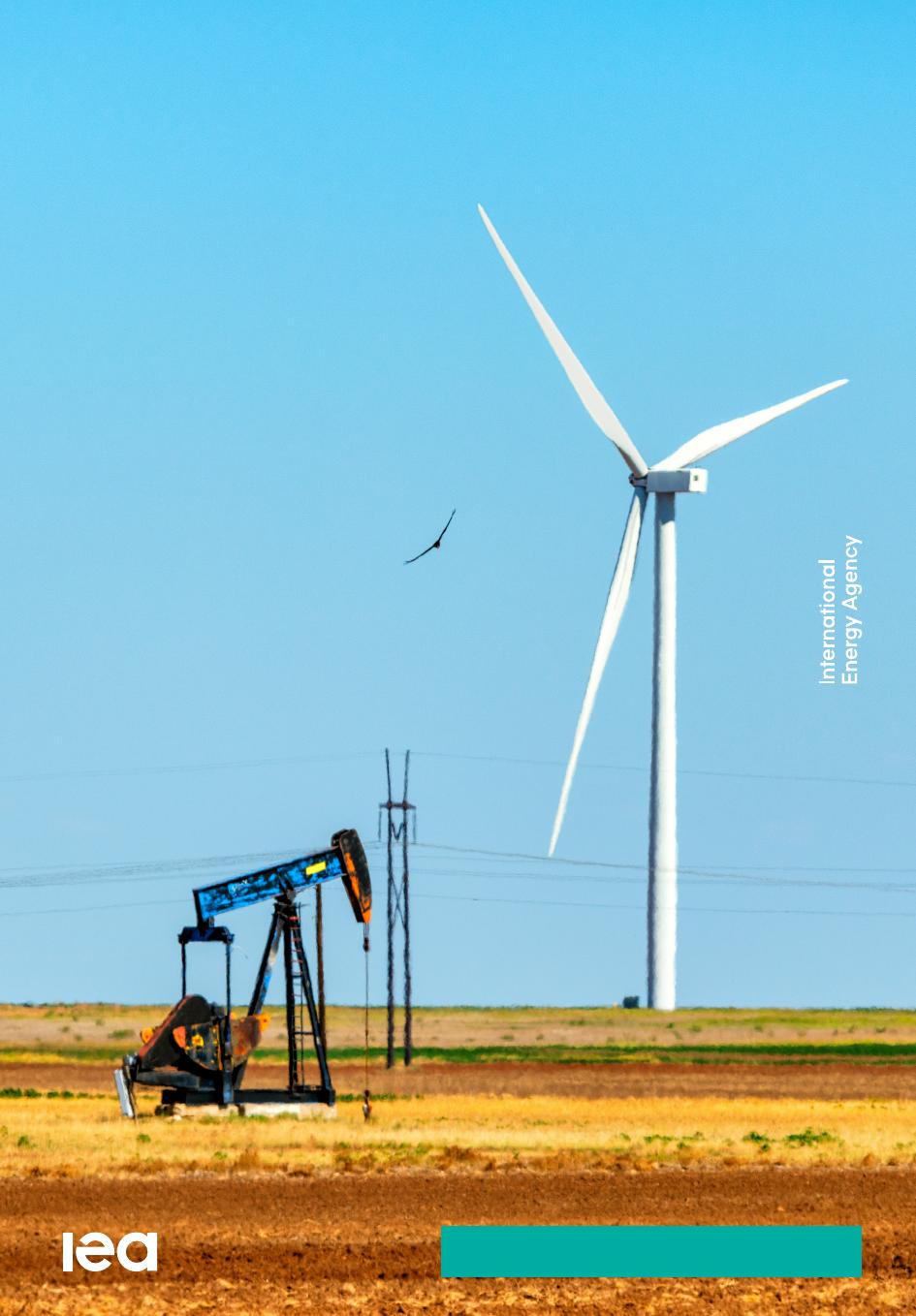TheOilandGasIndustryinNetZeroTransitionsWorldEnergyOutlookSpecialReportINTERNATIONALENERGYAGENCYTheIEAexaminestheIEAmemberIEAassociationfullspectrumcountries:countries:ofenergyissuesincludingoil,gasAustraliaArgentinaandcoalsupplyandAustriaBrazildemand,renewableBelgiumChinaenergytechnologies,CanadaEgyptelectricitymarkets,CzechRepublicIndiaenergyefficiency,DenmarkIndonesiaaccesstoenergy,EstoniaKenyademandsideFinlandMoroccomanagementandFranceSenegalmuchmore.ThroughGermanySingaporeitswork,theIEAGreeceSouthAfricaadvocatespoliciesHungaryThailandthatwillenhancetheIrelandUkrainereliability,affordabilityItalyandsustainabilityofJapanenergyinitsKorea31membercountries,Lithuania13associationLuxembourgcountriesandMexicobeyond.NetherlandsNewZealandPleasenotethatthisNorwaypublicationissubjecttoPolandspecificrestrictionsthatlimitPortugalitsuseanddistribution.TheSlovakRepublictermsandconditionsareSpainavailableonlineatSwedenwww.iea.org/termsSwitzerlandRepublicofTürkiyeThispublicationandanyUnitedKingdommapincludedhereinareUnitedStateswithoutprejudicetothestatusoforsovereigntyTheEuropeanoveranyterritory,totheCommissionalsodelimitationofinternationalparticipatesinthefrontiersandboundariesandworkoftheIEAtothenameofanyterritory,cityorarea.Source:IEA.InternationalEnergyAgencyWebsite:www.iea.orgForewordIntheenergyandclimateworlds,everyonehasanopinionabouttheroleoftheoilandgasindustryinthetransitiontonetzeroemissions.Forsome,theconclusionisunambiguous.Theoilandgasindustryisanobstacletochange,sosuccessfultransitionsrequirerelegatingoilandgascompaniestohistory.Forothers,thecapabilitiesandcapitaltheindustryholdscanbeinstrumentsofchange–potentiallyimportantones.Perspectivesonthisissuearecomplicatedbythesizeanddiversityoftheindustryitself.Therearemanydifferentcompaniesengagedinoilandgas,fromsmallindependentfirmstohugenationaloilcompanies–fromtechnologyproviderstomarkettraders.Andtherearemanydifferentstancesacrosstheindustryonenergytransitions,fromoutrightoppositionthroughtogrudgingacceptanceand,insomecases,activepursuitofnewopportunities.Aproductivediscussiononthiscrucialtopicrequiresasolidevidencebaseanddispassionateanalysis.ThisiswhattheInternationalEnergyAgency(IEA)providesinthisnewspecialreport.Itisbynomeansourfirstsuchin-depthanalysisofthesector:wehavepublishedarangeofusefulstudiesovertheyearsthathavehighlightedtheurgentneedforchange,mostnotablyTheOilandGasIndustryinEnergyTransitions,inJanuary2020.Thisnewspecialreportbringstogether,updatesandexpandsthatanalysisinwaysthatmakethisthemostcomprehensiveandauthoritativeworkonthistopictodate.Since2020,importantchangeshavetakenplaceintheglobalenergysectorastheworldhascontendedwiththeturmoiloftheCovid-19pandemicandtheglobalenergycrisis–andasanincreasingnumberofgovernmentshaveraisedtheirclimateambitionsandlaunchedmajorpolicyinitiativestoacceleratecleanenergytransitions.Asaresult,wehaveseena40%increaseincleanenergyinvestment–andimpressivemomentuminkeytechnologiessuchassolarPV,windandelectricvehicles.Thismeansthatforthefirsttime,weseepeaksindemandforallofthefossilfuelsbefore2030,basedontoday’spolicysettings.Thesesettingsarenotyetstrongenoughtodeliversteepdeclinesindemandontheothersideofthepeaks.However,ifgovernmentsdeliverinfullontheirnationalenergyandclimatepledges,andevenmoresoiftheymanagetoshifttheworldontothenarrowpathwaytolimitingglobalwarmingto1.5°C,theconsequencesfortheoilandgasindustrywillbeprofound.Thisreportshowsthattheindustrycanandmustdomuchmoretorespondtothethreatofclimatechange.Regardlessofwhichpathwaytheworldfollows,climateimpactswillbecomemorevisibleandsevereoverthecomingyears,increasingthepressureonallelementsofsocietytofindsolutions.Theindustrythereforefacesachoice–amomentoftruth–overitsengagementwithcleanenergytransitions.Sofar,itsengagementhasbeenminimal:lessthan1%ofglobalcleanenergyinvestmentcomesfromoilandgascompanies.Butthereisnopartoftheindustrythatwillbeleftunaffectedbythetransitiontonetzero.Everypartoftheindustryneedstorespond.IEA.CCBY4.0Foreword3Theuncomfortabletruththattheindustryneedstocometotermswithisthatsuccessfulcleanenergytransitionsrequiremuchlowerdemandforoilandgas,whichmeansscalingbackoilandgasoperationsovertime–notexpandingthem.Thereisnowayaroundthis.Sowhilealloilandgasproducersneedstoreduceemissionsfromtheirownoperations,includingmethaneleaksandflaring,ourcalltoactionismuchwider.Toescapethenarrowingwallsoftheirbusinessesbasedontraditionalfuels,producersneedtoembracethecleanenergyeconomy.Thisreportexploreswhattheseopportunitieslooklike,bothforcompaniesandforeconomiesthatrelyheavilyonoilandgasrevenues.Andwithalloftheaboveinmind,thereportspellsoutclearlywhatitreallymeansforproducerstoalignwiththeParisAgreementandwiththe1.5°Cgoal.IwouldliketothanktheexcellentteamofIEAcolleagueswhoproducedthisextremelyimportantstudywithallthenuanceandobjectivitythatthesubjectrequires–undertheleadershipofmycolleaguesTimGould,ChiefEnergyEconomist,andChristopheMcGlade,HeadoftheEnergySupplyUnit.ItprovidesimportantinputtothediscussionsattheupcomingCOP28climatechangeconferenceinDubai–butmorethanthat,Iamconvincedthiswillbeareferenceworkformanyyearstocome.DrFatihBirolExecutiveDirectorInternationalEnergyAgencyIEA.CCBY4.04InternationalEnergyAgencySpecialReportAcknowledgementsThisstudywaspreparedbytheWorldEnergyOutlook(WEO)teamintheDirectorateofSustainability,TechnologyandOutlooks(STO)inco-operationwithotherdirectoratesandofficesoftheInternationalEnergyAgency(IEA).ChristopheMcGlade,HeadoftheEnergySupplyUnit,co-ordinatedtheworkandwastheleadauthor;hedesignedanddirectedthereporttogetherwithTimGould,ChiefEnergyEconomist.Theothermainauthorswere:SimonBennett,TomásDeOliveiraBredariol,PaulGrimal,JérômeHilaire,PeterZeniewski.OtherkeycontributorsfromacrosstheIEAwere:NadimAbillama,AbdullahAl-Abri,AnaAlcaldeBáscones,OskarasAlsauskas,CaleighAndrews,ElisaAsmelash,HeymiBahar,EmileBelin-Bourgogne,CharlèneBisch,EricBuisson,VittoriaChen,Franced'Agrain,DavideD'Ambrosio,TanguyDeBienassis,DavidFischer,AlexandraHegarty,PaulHugues,MarcoIarocci,HyejiKim,Tae-YoonKim,YunYoungKim,LucaLoRe,ApostolosPetropoulos,DianaPerez-Sanchez,RyszardPospiech,SiddharthSingh,JunTakashiro,andDanielWetzel.MarinaDosSantos,EleniTsoukalaandRekaKoczkaprovidedessentialsupport.JustinFrench-Brookscarriededitorialresponsibility.ValuablecommentsandfeedbackwereprovidedbyotherseniormanagementandnumerousothercolleagueswithintheInternationalEnergyAgency.InparticularMaryWarlick,TorilBosoni,JoelCouse,LauraCozzi,DanDorner,RebeccaGaghen,TimurGül,IlkkaHannula,DennisHesseling,BrianMotherway,andHiroSakaguchi.ThanksgototheIEACommunicationsandDigitalOfficefortheirhelptoproducethereportandwebsitematerials,particularlytoJethroMullen,PoeliBojorquez,CurtisBrainard,JonCuster,HortenseDeRoffignac,AstridDumond,MerveErdil,GraceGordon,JuliaHorowitz,OliverJoy,IsabelleNonain-Semelin,JuliePuech,RobertStone,SamTarling,ClaraVallois,LucileWall,ThereseWalshandWonjikYang.TheIEAOfficeoftheLegalCounsel,OfficeofManagementandAdministrationandEnergyDataCentreprovidedassistancethroughoutthepreparationofthereport.IEA.CCBY4.0Acknowledgements5PeerreviewersManyseniorgovernmentofficialsandinternationalexpertsprovidedinputandreviewedpreliminarydraftsofthereport.Theircommentsandsuggestionswereofgreatvalue.Theyinclude:AliAissaouiOxfordInstituteforEnergyStudiesAtulAryaS&PGlobalZubinBamjiWorldBankImeneBenRejeb-MzahBNPParibasChrisBessonIndependentconsultantJasonBordoffColumbiaUniversity,UnitedStatesSiânBradleyBeyondOilandGasAlliance(BOGA)MarkBrownsteinEnvironmentalDefenseFundNickButlerKing’sCollegeLondonMichaelCohenBPRussellConklinUSDepartmentofEnergyHelenCurrieConocoPhillipsJonathanElkindColumbiaUniversityRonanHodgeGlasgowFinancialAllianceforNetZeroJan-HeinJesseJOSCOEnergyFinanceandStrategyConsultancyRobertKleinbergColumbiaUniversity,UnitedStatesKenKoyamaInstituteofEnergyEconomics,JapanJimKraneBakerInstituteforPublicPolicyGladaLahnChathamHouseThomas-OlivierLéautierTotalEnergiesGielLinthorstINGYvetteManolasWoodsideEnergyAntonioMerinoGarciaRepsolJulieMulkerinChevronIsabelMurrayDepartmentofNaturalResources,CanadaJulienPerezOilandGasClimateInitiativeStephaniePfeiferInstitutionalInvestorsGrouponClimateChangeAmitPuriStandardCharteredBankAprilRossExxonMobilAdnanShihabEldinIndependentexpertWimThomasIndependentconsultantIEA.CCBY4.06InternationalEnergyAgencySpecialReportNoéVanHulstInternationalPartnershipforHydrogenandFuelCellsintheEconomyDavidVictorUCSanDiegoSchoolofGlobalPolicyandStrategyClaireWangU.S.DepartmentofStatePeterWoodShellFareedYasseenClimateEnvoyoftheRepublicofIraqTheworkreflectstheviewsoftheInternationalEnergyAgencySecretariat,butdoesnotnecessarilyreflectthoseofindividualIEAmembercountriesorofanyparticularfunder,supporterorcollaborator.NoneoftheIEAoranyfunder,supporterorcollaboratorthatcontributedtothisworkmakesanyrepresentationorwarranty,expressorimplied,inrespectofthework’scontents(includingitscompletenessoraccuracy)andshallnotberesponsibleforanyuseof,orrelianceon,thework.Thisdocumentandanymapincludedhereinarewithoutprejudicetothestatusoforsovereigntyoveranyterritory,tothedelimitationofinternationalfrontiersandboundariesandtothenameofanyterritory,cityorarea.Commentsandquestionsarewelcomeandshouldbeaddressedto:TimGouldDirectorateofSustainability,TechnologyandOutlooksInternationalEnergyAgency9,ruedelaFédération75739ParisCedex15FranceE-mail:weo@iea.orgMoreinformationabouttheWorldEnergyOutlookisavailableatwww.iea.org/weo.IEA.CCBY4.0Acknowledgements7TableofContentsForeword.................................................................................................................................3Acknowledgements.................................................................................................................5Executivesummary...............................................................................................................131Oilandgasinnetzerotransitions191.1Introduction...................................................................................................201.2Theoilandgasindustrytoday.......................................................................211.3Demand.........................................................................................................261.3.1Oil......................................................................................................261.3.2Naturalgas.........................................................................................291.4Supply............................................................................................................331.4.1Prices.................................................................................................331.4.2Oilsupply...........................................................................................341.4.3Naturalgassupply.............................................................................371.5Refiningandtrade.........................................................................................411.5.1Refining..............................................................................................411.5.2Oiltrade.............................................................................................431.5.3Naturalgastrade...............................................................................451.6AlternativesupplypathwaysintheNZEScenario.........................................471.7Investment....................................................................................................591.7.1Risksfromoverinvestment................................................................601.7.2Risksfromunderinvestment..............................................................632Technologyoptionsfortheoilandgasindustry652.1Introduction...................................................................................................662.2Traditionaloilandgasoperations.................................................................662.2.1Currentemissionsfromoilandgasoperations.................................662.2.2Emissionreductionsto2050byscenario..........................................702.2.3Cuttingmethaneandflaring..............................................................722.2.4Boostingefficiencyandelectrifyingoilandgasfacilities...................772.2.5ReducingemissionsfromrefiningandLNGfacilities.........................792.3Newtechnologyoptions................................................................................862.3.1Carboncapture,utilisationandstorage............................................90IEA.CCBY4.02.3.2Low-emissionshydrogenandhydrogen-basedfuels.........................95TableofContents92.3.3Bioenergy...........................................................................................992.3.4Offshorewind..................................................................................1022.3.5Geothermal......................................................................................1052.3.6Plasticsrecycling..............................................................................1072.3.7Electricvehiclecharging..................................................................1103Strategicresponsesofcompanies1133.1Introduction.................................................................................................1143.2Therisingpressuresonoilandgascompanies...........................................1143.2.1Financialpressures..........................................................................1143.2.2Social,legalandpoliticalpressure...................................................1163.2.3Employment....................................................................................1183.3Oilandgascompanyresponsestodate......................................................1213.3.1Targetstoreducescope1and2emissions.....................................1213.3.2Targetstodiversifyintocleanenergytechnologies........................1253.4Whatcouldnetzeroenergycompanieslooklikein2050?.........................1283.4.1Anetzero“major”energycompany...............................................1303.4.2Aliquids-focusednationaloilcompany...........................................1323.4.3Anindependentfocusedongases...................................................1353.5Assessingalignmentwithnetzerotransitions............................................1373.5.1Emissionsfromownoperations......................................................1373.5.2Investmentincleanenergy.............................................................1393.6FrameworktoassessthealignmentofcompanytargetswiththeNZEScenario.......................................................................................................1443.6.1Frameworkoverview.......................................................................1463.6.2Scope1and2emissionsreductions................................................1483.6.3Investmentinnewoilandgasprojects...........................................1493.6.4Investmentincleanenergy.............................................................1503.6.5Qualitativequalifiers.......................................................................1504Strategicresponsesofexportersandimporters1534.1Introduction.................................................................................................1544.2Establishedproducers.................................................................................155IEA.CCBY4.04.2.1Startingpoints.................................................................................1554.2.2Pitfallsfacingproducereconomies..................................................15810InternationalEnergyAgencySpecialReport4.2.3Impactsofnetzerotransitions........................................................1644.3Newproducers............................................................................................1664.3.1Startingpoints.................................................................................1664.3.2Impactsofnetzerotransitions........................................................1674.4Buildingresilientnetzeroenergystrategies...............................................1704.4.1Reduceemissionsfromtraditionalsupplies....................................1714.4.2Putdomesticenergysystemsonacleanerfooting.........................1764.4.3Developnewlow-emissionsproductsandvaluechains.................1794.5Workingtogethertoensureequitableandjustnetzeropathways............1864.5.1Whyshouldexportersandimportersworktogether?....................1864.5.2Howcanexportersandimportersworktogether?.........................190AnnexesAnnexA.Definitions............................................................................................................197AnnexB.References...........................................................................................................217IEA.CCBY4.0TableofContents11ExecutiveSummaryAmomentoftruthiscomingfortheoilandgasindustryStructuralchangesintheenergysectorarenowmovingfastenoughtodeliverapeakinoilandgasdemandbytheendofthisdecadeundertoday’spolicysettings.Afterthepeak,demandisnotcurrentlysettodeclinequicklyenoughtoalignwiththeParisAgreementandthe1.5°Cgoal.Butifgovernmentsdeliverinfullontheirnationalenergyandclimatepledges,thenoilandgasdemandwouldbe45%belowtoday'slevelby2050andthetemperaturerisecouldbelimitedto1.7°C.Ifgovernmentssuccessfullypursuea1.5°Ctrajectory,andemissionsfromtheglobalenergysectorreachnetzerobymid-century,oilandgasusewouldfallby75%to2050.ThisnewIEAreportexploreswhatoilandgascompaniescandotoacceleratenetzerotransitionsandwhatthismightmeanforanindustrywhichcurrentlyprovidesmorethanhalfofglobalenergysupplyandemploysnearly12millionworkersworldwide.Since2018,theannualrevenuesgeneratedbytheoilandgasindustryhaveaveragedclosetoUSD3.5trillion.Aroundhalfofthiswenttogovernments,while40%wentbackintoinvestmentand10%wasreturnedtoshareholdersorusedtopaydowndebt.Theimplicationsofnetzerotransitionsarefarfromuniform:theindustryencompassesawiderangeofplayers,fromsmall,specialisedoperatorstohugenationaloilcompanies(NOCs).Whileattentionoftenfocusesontheroleofthemajors,whicharesevenlarge,internationalplayers,theyholdlessthan13%ofglobaloilandgasproductionandreserves.NOCsaccountformorethanhalfofglobalproductionandcloseto60%oftheworld’soilandgasreserves.Theindustry’sengagementwithcleanenergytransitionswillbeakeytopicatCOP28,butthisreportprovidesareferenceforadebatethatwillcontinuewellbeyondtheUNclimatesummitinDubai.MostoilandgascompaniesarewatchingenergytransitionsfromthesidelinesOilandgasproducersaccountforonly1%oftotalcleanenergyinvestmentglobally.Morethan60%ofthiscomesfromjustfourcompanies,outofthousandsofproducersofoilandgasaroundtheworldtoday.Forthemomenttheoilandgasindustryasawholeisamarginalforceintheworld’stransitiontoacleanenergysystem.Thefirst-ordertaskistoslashemissionsfromcompanyoperationsWhilethereisnosingleblueprintforchange,thereisoneelementthatcanandshouldbeinallcompanytransitionstrategies:reducingemissionsfromtheindustry’sownoperations.Asthingsstand,lessthanhalfofcurrentglobaloilandgasoutputisproducedbycompaniesthathavetargetstoreducetheseemissions.Afarbroadercoalition–withmuchmoreambitioustargets–isneededtoachievemeaningfulreductionsacrosstheoilandgasindustry.Theproduction,transportandprocessingofoilandgasresultsinjustunder15%ofglobalenergy-relatedgreenhousegasemissions.Thisisahugeamount,equivalenttoallenergy-relatedgreenhousegasemissionsfromtheUnitedStates.IEA.CCBY4.0ExecutiveSummary13Toalignwitha1.5°Cscenario,theseemissionsneedtobecutbymorethan60%by2030fromtoday’slevelsandtheemissionsintensityofglobaloilandgasoperationsmustnearzerobytheearly2040s.Theseareappropriatebenchmarksforindustry-wideactiononemissions,regardlessofthefuturescenario.Theemissionsintensityoftheworstperformersiscurrentlyfive-toten-timeshigherthanthebest.Methaneaccountsforhalfofthetotalemissionsfromoilandgasoperations.Tacklingmethaneleaksisatoppriorityandcanbedoneverycost-effectively–butitisnottheonlypriority.TransitionswillhurtthebottomlineforcompaniesfocusedonoilandgasThevolatilityoffossilfuelpricesmeansthatrevenuescouldfluctuatefromyeartoyear–butthebottomlineisthatoilandgasbecomesalessprofitableandariskierbusinessasnetzerotransitionsaccelerate.Pricesandoutputaregenerallylowerandtheriskofstrandedassetsishigher,especiallyinthemidstreamsectorthatincludesrefineriesandfacilitiesforliquefiednaturalgas.Ifexpectationsarethatdemandandpricesfollowascenariobasedontoday’spolicysettings,thatwouldvaluetoday’sprivateoilandgascompaniesataroundUSD6trillion.Ifallnationalenergyandclimategoalsarereached,thisvalueislowerby25%,andby60%iftheworldgetsontracktolimitglobalwarmingto1.5°C.Oilandgasprojectscurrentlyproduceslightlyhigherreturnsoninvestment,butthosereturnsarelessstable.Weestimatethatthereturnoncapitalemployedintheoilandgasindustryaveragedaround6-9%between2010and2022,whereasitwas6%forcleanenergyprojects.Oilandgasreturnsvariedgreatlyovertimecomparedwithmoreconsistentreturnsforcleanenergyprojects.Oilandgasinvestmentisneededinallscenarios,butthedemandtrajectoryina1.5°CworldleavesnoroomfornewfieldsContinuedinvestmentinoilandgassupplyisneededinallscenarios,buttheUSD800billionitcurrentlyinvestseachyearisdoublewhatisrequiredin2030tomeetdecliningdemandina1.5°Cscenario.Investmentinexistingandsomenewfieldsisnecessaryinaworldthatachievesnationalenergyandclimatepledges,althoughthereisnoneedinaggregatefornewexploration.Inascenariothathitsglobalnetzeroemissionsby2050,declinesindemandaresufficientlysteepthatnonewlonglead-timeconventionaloilandgasprojectsarerequired.Someexistingproductionwouldevenneedtobeshutin.In2040,morethan7millionbarrelsperdayofoilproductionispushedoutofoperationbeforetheendofitstechnicallifetimeina1.5°Cscenario.Innetzerotransitions,newprojectdevelopmentsfacemajorcommercialrisksandcouldalsolockinemissionsthatpushtheworldoverthe1.5°Cthreshold.Producersneedtoexplainhowanynewresourcedevelopmentsareviablewithinaglobalpathwaytonetzeroemissionsby2050andbetransparentabouthowtheyplantoavoidpushingthisgoaloutofreach.IEA.CCBY4.014InternationalEnergyAgencySpecialReportIEA.CCBY4.0NotallproducerscanbethelastonesstandingManyproducerssaytheywillbetheonestokeepproducingthroughouttransitionsandbeyond.Theycannotallberight.Oilandgasproductionisvastlyreducedinnetzerotransitionsbutdoesnotdisappear.Evenina1.5°Cscenario,some24millionbarrelsperdayofoilisproducedin2050(three-quartersisusedinsectorswheretheoilisnotcombusted,notablyinpetrochemicals),aswellassome920billioncubicmetresofnaturalgas,roughlyhalfofwhichisusedforhydrogenproduction.Thedistributionoffuturesupplyamongproducerswilldependontheweightassignedtoloweringcosts,ensuringdiversityofsupply,reducingemissions,andfosteringeconomicdevelopment.Marketforcesnaturallyfavourthelowest-costproduction,butthatleadstoahighconcentrationinsupplyamongtoday’smajorresourceholders,notablyintheMiddleEast.Prioritisingtheleastemissions-intensivesourcesdrivesprogresstowardsclimategoals,butthisoftenfavourslow-costproducers,sosupplystillbecomesmoreconcentrated.Itismuchbetterfortransitionsifallproducerstaketargetedactiontoreducetheiremissions.Ifproductionfromlow-incomeproducersisfavoured,theseprojectsmaynotultimatelybeveryprofitableinawell-suppliedmarket.Andifcountriespreferdomesticallyproducedoilandgasasawaytobuttressenergysecurity,theyreducerelianceonothersbutriskfindingthemselveswithrelativelyhigh-costprojectsinalow-priceworld.Theoilandgasindustryiswellplacedtoscaleupsomecrucialtechnologiesfornetzerotransitions…Some30%oftheenergyconsumedinanetzeroenergysystemin2050comesfromlow-emissionsfuelsandtechnologiesthatcouldbenefitfromtheskillsandresourcesoftheoilandgasindustry.Theseincludehydrogenandhydrogen-basedfuels;carboncapture,utilisationandstorage(CCUS);offshorewind;liquidbiofuels;biomethane;andgeothermalenergy.OilandgascompaniesarealreadypartnersinalargeshareofplannedhydrogenprojectsthatuseCCUSandelectrolysis.Theoilandgasindustryisinvolvedin90%ofCCUScapacityinoperationaroundtheworld.CCUSanddirectaircaptureareimportanttechnologiesforachievingnetzeroemissions,especiallytotackleoroffsetemissionsinhard-to-abatesectors.Forthemoment,onlyaround2%ofoffshorewindcapacityinoperationwasdevelopedbyoilandgascompanies.Plansareexpanding,however,andthetechnologyfrontierforoffshorewind–includingfloatingturbinesindeeperwaters–movesthissectorclosertoareasofoilandgascompanystrength.Inaddition,industryskillsandinfrastructure,includingexistingretailnetworksandrefineries,givetheindustryadvantagesinareaslikeelectricvehiclechargingandplasticrecycling.…butthisrequiresastep-changeintheindustry’sallocationofinvestmentCompaniesthathaveannouncedatargettodiversifytheiractivitiesintocleanenergyaccountforjustunderone-fifthofcurrentoilandgasproduction.TheoilandgasindustryinvestedaroundUSD20billionincleanenergyin2022,some2.5%ofitstotalcapitalspending.Inthisreport,weofferanewframeworkforassessingthestrategiesofoilandgascompaniesandtheextenttowhichtheyaremakingameaningfulcontributiontotransitions.ExecutiveSummary15ForproducersthatchoosetodiversifyandarelookingtoalignwiththeaimsoftheParisAgreement,ourbottom-upanalysisofcashflowsina1.5°Cscenariosuggeststhatareasonableambitionisfor50%ofcapitalexpenditurestogotowardscleanenergyprojectsby2030,ontopoftheinvestmentneededtoreducescope1and2emissions.Notalloilandgascompanieshavetodiversifyintocleanenergy,butthealternativeistowinddowntraditionaloperationsovertime.Somecompaniesmaytaketheviewthattheirspecialisationisinoilandnaturalgasandsodecidethat–ratherthanriskingmoneyonunfamiliarbusinessareas–othersarebetterplacedtoallocatethiscapital.Butaligningtheirstrategieswithnetzerotransitionswouldthenrequirethemtoscalebackoilandgasactivitieswhileinvestinginscope1and2emissionsreductions.IEA.CCBY4.0TwopitfallsforthediscussionaboutthefutureofoilandgasAproductivedebateabouttheoilandgasindustryintransitionsneedstoavoidtwocommonmisconceptions.Thefirstisthattransitionscanonlybeledbychangesindemand.“Whentheenergyworldchanges,sowillwe”isnotanadequateresponsetotheimmensechallengesathand.Animbalancedfocusonreducingsupplyisequallyunproductive,asitcomeswithaheightenedriskofpricespikesandmarketvolatility.Inpractice,noonecommittedtochangeshouldwaitforsomeoneelsetomovefirst.Successful,orderlytransitionsarecollaborativeones,inwhichsuppliersworkwithconsumersandgovernmentstoexpandnewmarketsforlow-emissionsproductsandservices.ThesecondisexcessiveexpectationsandrelianceonCCUS.Carboncapture,utilisationandstorageisanessentialtechnologyforachievingnetzeroemissionsincertainsectorsandcircumstances,butitisnotawaytoretainthestatusquo.Ifoilandnaturalgasconsumptionweretoevolveasprojectedundertoday’spolicysettings,thiswouldrequireaninconceivable32billiontonnesofcarboncapturedforutilisationorstorageby2050,including23billiontonnesviadirectaircapturetolimitthetemperatureriseto1.5°C.Thenecessarycarboncapturetechnologieswouldrequire26000terawatthoursofelectricitygenerationtooperatein2050,whichismorethanglobalelectricitydemandin2022.AnditwouldrequireoverUSD3.5trillioninannualinvestmentsallthewayfromtodaythroughtomid-century,whichisanamountequaltotheentireindustry’sannualaveragerevenueinrecentyears.Producereconomiesfacemajoruncertainties,buttheirenergyadvantagesarenotlostintransitionEconomiesthatareheavilyreliantonoilandgasrevenuesfacesomestarkchoicesandpressuresinenergytransitions.Thesechoicesarenotnew,buttheprospectoffallingoilandgasdemandaddsatimelineandadeadlinetotheprocessofeconomicdiversification.Transitionscreatepowerfulincentivestoacceleratethepaceofchangewhilealsodrainingasourceofrevenuethatcouldfinanceit.Comparedwiththeannualaveragebetween2010and2022,percapitanetincomefromoilandnaturalgasamongproducereconomiesis60%lowerin2030ina1.5°Cscenario.Newproducersenteringthemarketfaceadditionalchallenges,astheymayoverestimatethebountythatmightlieaheadandunderestimate16InternationalEnergyAgencySpecialReportthehazards.Manyproducersarealsoheavilyexposedtorisksfromachangingclimate,whichstandtofurtherdisruptthesecurityofenergysupply.Thechallengesareformidable,butthereareworkablenetzeroenergystrategiesavailabletoproducereconomiesandnationaloilcompanies.Today’sproducereconomiesretainenergyadvantagesevenastheworldmovesawayfromfossilfuels.Inmostcases,today’smajorproducersoflow-costhydrocarbonsalsohaveexpertiseandample,under-utilisedrenewableenergyresourcesthatcouldanchorpositionsincleanenergyvaluechainsandlow-emissionsindustries.Reducingemissionsfromtraditionalsupplies,includingend-useemissions;puttingdomesticenergysystemsonacleanerfootingbyphasingoutinefficientsubsidiesandboostingcleanenergydeployment;anddevelopinglow-emissionsproductsandservicesofferawayforward.Willtheoilandgasindustrybepartofthesolution?Ourscenariosplotouthowthetransitioncouldbeachieved,butthebaselineexpectationshouldbeforavolatileandbumpyride.Decliningmarketsaredifficulttoplanfor,andthepotentialfordisruptionalsocomesfromgeopoliticaltensionsandincreasedincidencesofextremeweather.Governmentsneedtobevigilantforriskstotheaffordabilityandsecurityofsupply.TheimplicationsofanyphysicaldisruptionstosupplyarefeltmoststronglyinemerginganddevelopingeconomiesinAsia,whoseshareofglobalcrudeoilimportsrisesfrom40%todayto60%in2050inascenariothatmeetsnationalenergyandclimategoals.Onthesupplyside,evenasoveralldemandfallsback,theMiddleEastplaysanoutsizeroleinglobalmarketsasalow-costproducerofbothoilandgas.Dialogueacrossallpartsofoilandgasvaluechainsremainsessentialtodeliveranorderlyshiftawayfromfossilfuels–andtoensurethattoday’sproducershaveameaningfulstakeinthecleanenergyeconomy.Theindustrymustchange,butthisdialoguealsoneedsclearsignalsfromconsumersonthedirectionandspeedoftraveltoguideinvestmentdecisions,toassignvaluetooilandgaswithloweremissionsintensities,todevelopmarketsforlow-emissionsfuels,andtocollaborateontechnologyinnovation.Energytransitionscanhappenwithouttheengagementoftheoilandgasindustry,butthejourneytonetzerowillbemorecostlyanddifficulttonavigateiftheyarenotonboard.IEA.CCBY4.0ExecutiveSummary17Chapter1OilandgasinnetzerotransitionsSUMMARY•Around97mb/dofoiland4150bcmofnaturalgaswereconsumedgloballyin2022.Thisresultedinjustover18GtCO2emissions,aroundhalfoftotalenergy-relatedCO2emissions.Recentmomentumindeployingcleanenergytechnologiesmeansthatoilandgasdemandpeakbefore2030intheStatedPoliciesScenario(STEPS),butthedeclinesafterthesepeaksarenotsteepenoughtoachievetheworld’sclimategoals.•Netzerotransitionsrequireahugeaccelerationincleanenergytechnologydeploymentandfasterreductionsinoilandgasuse.IntheAnnouncedPledgesScenario(APS),oilandgasdemanddeclinebyaround2%eachyearonaverageto2050(to55mb/dand2400bcm)andintheNetZeroEmissionsby2050(NZE)Scenariotheyfallbymorethan5%eachyearonaverageto2050(to24mb/dand920bcm).•Attentionontheoilandgasindustryoftenfocusesonthelargeinternationaloilandgascompanies(the“majors”),buttheyownlessthan13%ofglobaloilandgasproductionandreserves.Bycomparison,nationaloilcompaniesownmorethanhalfofproductionandcloseto60%ofreserves.•Majorchallengeslieaheadformidstreaminfrastructureinnetzerotransitions.Therefiningsectorreducesitsoutputoftraditionalproductslikegasolineanddiesel,andfocusesmoreonpetrochemicalfeedstocksandproductslikeasphaltandbitumen.Globalliquefiednaturalgas(LNG)tradeseesstrongnear-termgrowth,buttradepeaksintheAPSbefore2035andtheutilisationofexportterminalsdrops;intheNZEScenario,demandforLNGcanbemetinaggregatebyplantsalreadyinoperation.•IntheAPSandNZEScenario,investmentinexistingoilandgasassetscontinues,butwithverydifferentoutcomesfornewprojectdevelopment.IntheAPS,newoilandgasprojectsareneeded,althoughinaggregatetherewouldbenoneedforfurtheroilandgasexploration.IntheNZEScenario,fallingdemandmeansthatnonewlongleadtimeconventionaloilandgasprojectsareapprovedfordevelopmentand,after2030,anumberofprojectsareclosedbeforetheyreachtheendoftheirtechnicallifetime.•Manyproducershavesetoutwhytheythinktheirresourcesshouldbepreferredfordevelopmentinnetzerotransitions.Somesaythattheyhavethelowestproductioncostsoremissionintensities;othersclaimthattheyareabetteroptionforenergysecurity;andsomeindicatethatnewoilandgasdevelopmentsareneededtoimprovewelfare.InthedemandenvironmentoftheNZEScenario,anynewoilandgasresourcedevelopmentswouldneedtobematchedbyproductionreductionselsewheretoavoidoversupplyandfossilfuellock-in.•Bothover-andunderinvestmentinfossilfuelscarryrisksforsecureandaffordabletransitions.Sequencingthedeclineinoilandgasinvestmentandtheincreaseincleanenergyinvestmentisvitaltoavoiddamagingpricespikesorsupplygluts.Atpresent,risksappeartobeweightedmoretowardsoverinvestmentthantheopposite.IEA.CCBY4.0Chapter1Oilandgasinnetzerotransitions19IEA.CCBY4.01.1IntroductionThisreportexplorestheoutlookforoilandnaturalgasproducersinnetzerotransitions.Oilandgasaccountforaroundhalfoftoday’sglobalenergysupply,providingvaluableenergyservicestoconsumersaroundtheworldbutalsoresultinginover18GtCO2emissions.Someoftheservicesprovidedbyoilandgascanbereplacedwithrelativeeasebycleanenergytechnologies,aswitnessedbytheriseofelectricvehicles(EVs)andrenewablesourcesofpowergeneration.Othersaremoredifficulttoreplace,suchasseasonalbalancingforpowersystemsinthecaseofgas,orlong-distanceairtravelinthecaseofoil.Thepositionofoilandgasintheenergymixwillnotbetransformedovernight.Butithastochange,andchangedramatically,iftheworldistoavoidseveredamagefromachangingclimate.Thisanalysisexaminesthecontoursandimplicationsofsuchaprocess.WiththeUnitedArabEmirateshostingCOP28,2023isacriticalyearforoilandgascompaniesandproducereconomiestodevelopandjustifystrongandcrediblenarrativesabouttheroletheyintendtoplay.ThetwomainscenariosexaminedinthisreportaretheAnnouncedPledgesScenario(APS)andtheNetZeroEmissionsby2050(NZE)Scenario.Thesescenariossetoutwhattransitionpathwaysalignedwithregionalorglobalnetzerotargetswouldmeanforoilandgascompaniesandproducereconomies.Theybothrequireasignificantaccelerationinthepaceofchangecomparedwithtoday'strends,whicharereflectedintheStatedPoliciesScenario(STEPS).Thereportincludesmetrics,basedonourscenarios,thatallowstakeholderstomakeinformeddecisionsonwhetherproducersaremakinggenuineeffortstoadaptbusinessmodelsatthenecessarypaceandscale.Thischapterdiscussestheoutlookforoilandnaturalgasdemandandsupplyinnetzerotransitions.Chapter2setsoutthetechnologyoptionsfortheoilandgasindustry,includingoptionstocutemissionsfromitsownoperations,andthecleanenergytechnologiesthatappearbestsuitedtoitsexistingskillsandresources.Chapter3setsoutsomeofthestrategicresponsesofoilandgasproducerstodateandexploreswhattheindustrywouldneedtodotoalignwithnetzerotransitions.AndChapter4focusesonproducereconomies,examininghowtheycanadapttoachangingenergysystemandhowproducersandconsumerscanworktogethertoachievefair,netzeroalignedtransitionpathways.Theremainderofthischapterisstructuredasfollows:Section1.2providesanoverviewofthestructureoftheoilandgasindustry,highlightingthecontributionofdifferenttypesofcompaniestosupplyandinvestmenttrends.Section1.3examinesoilandgasdemandintheAPSandNZEScenario,includingthemainleversusedtoreducedemand,andwhereoilandgasuseismostresilient.Section1.4describestheoilandgaspricetrajectoriesandhowproductionevolvesbyregioninnetzerotransitions.Section1.5examinestheimplicationsforoilrefiningandoilandgastrade.Section1.6exploresalternativesupplypathwaysthatcouldbepossiblewiththesameoveralldemandtrajectoryoftheNZEScenario,highlightingpotentialupsidesanddownsidesandhowdifferentsupply-sidedynamicsmightplayoutinpractice.Finally,Section1.7examinestheimplicationsforinvestment,includingtherisksposedbyoverinvestmentorunderinvestmentinoilandgasduringnetzerotransitions.20InternationalEnergyAgencySpecialReport1.2TheoilandgasindustrytodayTherearethousandsofcompaniesaroundtheworldthatproduceoilandgastoday.The1industryischaracterisedbyawidevarietyofcorporatestructuresandgovernancemodels,rangingfromsmallbusinessestosomeoftheworld’slargestindustrialcorporations.Thetopfiftycompaniesproducearound70%oftotalsupply.Forthisreport,wedistinguishbetweenfourmaintypesofcompany:MajorsarelargecompanieslistedonstockmarketsintheUnitedStatesandEurope.Theyhavehistoricallyfocusedondevelopinglarge,capital-intensiveprojectsandtheirupstreamdivisionsrepresentmostoftheirfinancialvalueandrevenue.Inthisreport,thisgroupcomprisessevencompanies:BP,ConocoPhillips,Chevron,Eni,ExxonMobil,Shell,andTotalEnergies.Independentsaresmallerfullyintegratedcompaniesorindependentupstreamoperators.Theyencompassawiderangeofcompanies,suchasLukoil,Repsol,OMVandWoodside,aswellasmanyNorthAmericancompanies–includingshalegasandtightoilplayers–suchasApache,Hess,MarathonOil,PioneerNaturalResourcesandOxy,anddiversifiedinternationalconglomerateswithupstreamactivities,suchasMitsubishiCorp.Nationaloilcompanies(NOCs)havebeengivenmandatesbytheirhomegovernmentstoexploitnationalresourcesandhavealegallydefinedroleinupstreamdevelopment.WhilesomeNOCsoperateoutsidetheirhomecountryandarealsoactivedownstream,thebulkoftheirassetsarebasedintheirhomecountry’supstreamoperations.MostofthelargestNOCsarelocatedintheMiddleEast,suchasSaudiAramco,NationalIranianOilCompany,KuwaitPetroleumCorporation,AbuDhabiNationalOilCompanyandQatarEnergy.TherearealsoNOCsinEurasia,includinginRussia,inLatinAmericaandmanypartsofAfricaandAsia(seeChapter3forfurtherdetails).Internationalnationaloilcompanies(INOCs)sharesimilaritieswithNOCsintheirownershipandgovernance,buthavesubstantialupstreaminvestmentsoutsidetheirhomecountry.ThisisusuallydoneincollaborationwithhostNOCsorprivatecompanies.SomeINOCsarealsomajorplayersintheglobalgasmarkets.TheyincludeEquinor,ChinaNationalPetroleumCorporation,Gazprom,PetronasandIndia’sOilandNaturalGasCorporation.Inadditiontothesecategories,othertypesofcompanyplayakeyroleintheoilandgasindustry.Theyinclude:Servicecompaniesthatprovidespecialistengineeringservicesfordrilling,reservoirmanagement,constructionofinfrastructure,andenvironmentalimpactmanagement(e.g.SLBandBakerHughes).Puredownstreamcompaniesthatoperaterefineryandpetrochemicalsites(e.g.MarathonPetroleum,Phillips66,Essar,RelianceandValero).IEA.CCBY4.0Chapter1Oilandgasinnetzerotransitions21Tradingcompanieswhosebusinessmodelstendtorelyonowningonlythosephysicalassetsthathelpoptimisetheirpositioninthemarket(e.g.Vitol,Mercuria,GlencoreandGunvor).Midstreamoperatorsofpipelinesystems(e.g.Enagas,Enbridge,TCEnergy,EnterpriseProductsPartnersandKinderMorgan).ShippingcompaniesoperatingtankersandLNGcarriers(e.g.Maersk,Teekay,Euronav,FrontlineandMitsui).Storagecompaniesthatmanageandleasetankcapacityforcrudeandproducts(e.g.VTTIandOilTanking).Retailcompaniesthatbuyproductdirectlyfromrefinersorfromtradersinthelocalorinternationalmarket(e.g.Couche-Tard,KrogerandAvia).Attentionontheoilandgasindustryoftenfocusesontheroleofthemajors,buttheyownlessthan13%ofglobaloilandgasproductionandproved-plus-probable(2P)reserves(Figure1.1).NOCsandINOCsaccountformorethanhalfofglobalproductionandcloseto60%oftheworld’soilandgasreserves.Theirshareofcapitalinvestmentinupstreamoilandgasprojectsisslightlylower,ataround45%oftheglobaltotal.Thisispartlybecausetheytendtoownresourceswithlower-than-averagedevelopmentcostsandpartlybecausetheirassetstendtohaveslowdeclinerates,meaninglowerlevelsofspendingarerequiredtomaintainproduction.Figure1.1⊳Ownershipofoilandgasreserves,productionandupstream100%investmentbycompanytype,2022OilNaturalgas80%60%40%20%ReservesProductionInvestmentReservesProductionInvestmentMajorsIndependentsINOCsNOCsIEA.CCBY4.0.NOCs,includingthosewithoperationsoutsidetheirhomecountry,producemorethanhalfoftheworld’soilandgas.Themajorsproduce13%ofthetotal.IEA.CCBY4.0Note:INOCs=Internationalnationaloilcompanies;NOCs=Nationaloilcompanies.Source:IEAanalysisbasedonRystadEnergy.22InternationalEnergyAgencySpecialReportPartnershipsandjointventuresareprevalentacrosstheoilandgasindustry.Explorationandnewfielddevelopmentareriskyandcomplexprocesses,andcompaniesoftensplittheotewcnhenricsahlipanodfaonpyedraistcioonvaelrycoolrladbeovrealtoiopnm.eJonitnttovsepnrteuardesthmeeraisnktahnedfrineawnacridalaenndgatogeemnceonutraangde1influenceofcompaniescanspreadfurtherthantheoilandgasassetsthattheydirectlyoperate.Forexample,oftheoilandgasproducedin2022,themajorsowned20millionbarrelsofoilequivalentperday(mboe/d)andoperatedassetsthatproduced23mboe/d;nearlythreetimesasmuchoilandgas(60mboe/d)wasproducedfromassetsinwhichtheyownmorethan5%ofproduction(Figure1.2).Figure1.2⊳mboe/dOilandgasproductionin2022byownership,operator,andfrom100assetsinwhichcompanieshaveanequitystakegreaterthan5%80Equityshare>5%OperatedOwned604020MajorsIndependentsINOCsNOCsIEA.CCBY4.0.Companies’productionincludesoilandgasfrombothoperatedandnon-operatedassets,buttheinfluenceofcompaniescanextendwellbeyondthis.Note:Equityshare>5%=totalproductionfromallassetsinwhichacompanyholdsatleasta5%shareoftheproducedoilandgas.Mergersandacquisitionsarecommonintheoilandgasindustry,withmorethanUSD200billionworthofdealstakingplaceannuallyonaveragebetween2018and2022.Theseareusedbycompaniestoexpandoilandgasproduction,diversifyintonewmarkets,acquirenewtechnologies,benefitfromeconomiesofscale,andtoincreasecleanenergyholdings.TheoilandgasindustryspentaroundUSD15billionacquiringcleanenergyventuresin2022,around10%ofthetotalvalueofitsmergersandacquisitionsinthatyear.Anumberofmajordealshavealsotakenplacein2023,includingthepurchaseofUSshaleindependentPioneerResourcesbyExxonMobilforUSD60billionandthepurchaseofHessCorporationforUSD53billionbyChevron.IEA.CCBY4.0Chapter1Oilandgasinnetzerotransitions23TheglobaloilandgasindustrygeneratedclosetoUSD3.5trillioninrevenueonaverageeachyearbetween2018and2022(Figure1.3).Thisincludesrevenuefromcrudeoilandnaturalgasproductionaswellastheadditionalvaluecreatedfromprocessing,refining,transportingandmarketingthefinalproductstoconsumers.Thereisahighdegreeofyear-on-yearvariationinthisfigure,rangingfromalowofUSD2trillionin2020,giventheimpactsoftheCovid-19pandemic,toahistoricrecordhighofUSD5trillionin2022duringtheglobalenergycrisis.Figure1.3⊳Useofrevenuebytheoilandgasindustry,2018-2022TrillionUSD(2022,MER)5Other:ReturnstoshareholdersanddebtpaymentsOperatingcosts4Capitalexpenditure:3CleanMidstream2UpstreamGovernmenttake:1NOCdomesticincomeTaxes20182019202020212022IEA.CCBY4.0.TheoilandgasindustryhasgeneratedaroundUSD17trillionofrevenuesince2018.Halfwaspaidtogovernmentsand40%wasspentdevelopingandoperatingoilandgasassets.Note:NOCdomesticincome=NationalOilCompanyincomegeneratedintheirhomecountry.IEA.CCBY4.0Around50%oftherevenueproducedbytheoilandgasindustrysince2018wenttogovernments,eitherfromroyaltiesandtaxesorfromincomegeneratedbyNOCsandINOCsintheirhomecountries.Afurther40%wascapitalandoperatingexpenditure,andtheremaining10%wasreturnedtoshareholdersthroughdividendsandsharebuybacksorusedtopaydowndebt.Companieshaverespondedtotheprospectofnetzerotransitionswitharangeofstrategies.Themostcommonapproachesaretoreweightoverallproductiontowardsnaturalgas,demandforwhichisperceivedtobemoredurablethroughnetzerotransitions,andtotakestepstoreduceemissionsfromoperations.Somecompanieshavediversifiedtheircapitalexpendituremoresubstantially,movingintocleanenergytechnologyareassuchasoffshorewind,carboncapture,utilisationandstorage(CCUS),low-emissionsfuels,andelectricity.Oilandgascompanieswiththelargestproportionsspentaround15-25%oftheirtotalcapitalbudgetsoncleanenergyin2022throughmergersandacquisitions,jointventuresanddirectinvestment.Asawhole,theindustryspentaroundUSD20billiononcleanenergy,24InternationalEnergyAgencySpecialReportrepresentinglessthan3%ofitstotalcapitalbudgetandaround1%oftotalcleanenergyinvestmentglobally.Forthemoment,theoilandgasindustryremainsamarginalforceindirectlybuildingupacleanenergysystem(seeChapter3).1Box1.1⊳ScenariosexaminedinthisreportThreescenariosprovideaframeworkfortheanalysisinthisreport(Figure1.4).ThesescenarioshavebeenfullyupdatedtoreflectthelatesteconomicandenergydataandaredescribedindetailintheWorldEnergyOutlook2023(IEA,2023a).Ratesofeconomicgrowth–2.6%onaveragegloballyeachyearto2050–andpopulationgrowtharethesameacrossthescenarios.WefocusouranalysismainlyontheAPSandtheNZEScenario,whichachievenetzerotransitionsfortheenergysectoratdifferentspeeds.Figure1.4⊳Energy-relatedCO2emissionsandtotalenergysupplybyscenario40CO₂emissionsTotalenergysupply800GtCO₂EJ3060020400102002010202020302040205020102020203020402050STEPSAPSNZEIEA.CCBY4.0.Ourscenariospaintverydifferentpicturesforthefutureofemissionsandenergy.IEA.CCBY4.0TheStatedPoliciesScenario(STEPS)looksatwhatgovernmentsareactuallydoingratherthanwhattheysaytheywillachieve.Itisanoutlookbasedonadetailedsector-by-sectorreviewofenergyandclimatepoliciesandmeasurescurrentlyinplaceorunderdevelopmentbygovernments.Inthisscenario,eachofthefossilfuelshasapeakindemandbefore2030,butdeclinesafterthesepeaksarerelativelymuted.AnnualCO2emissionsare20%below2022levelsin2050andthesetrendsareconsistentwithatemperatureriseofaround2.4°Cin2100(witha50%probability).TheAnnouncedPledgesScenario(APS)assumesthatgovernmentsmeetalloftheclimate‐relatedcommitmentstheyhaveannouncedinfullandontime.Pledgesmadebycompanies,businessesandindustryorganisationsarealsotakenintoaccount.Energy-relatedCO2emissionssoonpeakandtheyarearound70%lowerthan2022levelsChapter1Oilandgasinnetzerotransitions25in2050.Therearealsomajorreductionsinallotherenergy-relatedgreenhousegas(GHG)emissions,includingmethanefromfossilfueloperations.Thispathwayisconsistentwithatemperatureriseof1.7°Cin2100(witha50%probability).TheNetZeroEmissionsby2050(NZE)ScenariodescribesapathwayfortheglobalenergysectortoreachnetzeroCO2emissionsby2050withoutoffsetsfromland-usemeasures.Advancedeconomiesreachnetzeroemissionsearlierthanemergingmarketanddevelopingeconomies,anduniversalaccesstoelectricityandcleancookingisachievedby2030.TherearealsoeffortstocutdownonmethaneandotherGHGemissions.Theglobalaveragesurfacetemperaturerisepeaksatjustbelow1.6°Caround2040andthengraduallyfallsto1.4°Cin2100(witha50%probability).IEA.CCBY4.01.3Demand1.3.1OilGlobaloildemandincreasedbyjustover1mb/donaverageeachyearbetween2010and2019.TheCovid-19pandemiccauseda9mb/ddropinoildemandin2020,thelargestannualdropinhistory,butdemandhassincereboundedanditstoodat96.5mb/din2022.Oilprovidesalargerangeoftheenergyservicedemandsrequiredbysociety,including,forexample,about25trillionpassengerkilometresincars,30trilliontonnekilometresfortrucks,320milliontonnesofhigh-valuechemicals,andmanyotheroutputs.IntheSTEPS,oildemandreachesamaximumlevelof102mb/dinthelate2020sbeforedecliningto97mb/din2050.Therearelargedeclinesinoiluseincars,buildingsandpowergeneration,althoughmostofthisisoffsetbygrowthinoiluseintrucks,aviationandpetrochemicals.Netzerotransitionsrequirereplacingexistingusesofoilandgasandsatisfyingthegrowthinenergyservicedemandsinalow-emissionsway.IntheAPS,oildemandsoonpeaksanddeclinesto93mb/din2030and55mb/din2050.IntheNZEScenario,demandfallsto77mb/din2030and24mb/din2050(Figure1.5).Roadtransport.Almosthalfofglobaloiluseiscurrentlyinroadtransport,butthisisunderincreasingpressurefromtheriseofelectricvehicles(EVs).TheEVmarkethasbeengrowingexponentiallyinrecentyears,andnearly20%ofnewcarsbeingsoldgloballyin2023areelectric.IntheAPS,theshareofelectriccarsalesrisestonearly45%in2030and80%in2050,reflectingelectrificationambitionsannouncedbygovernments,includingacommitmentbymorethan40governmentstoacceleratethetransitiontozero-emissioncarsandvans,aswellasamajorscale-upinEVmanufacturinghubsaroundtheworldthatencouragesconsumerstochoosetobuyadomesticallymanufacturedEVoveraninternalcombustionengine(ICE)car.Electricandhydrogenheavytrucksalesgrowfrom1%todaytojustunder20%oftotalsalesin2030and60%in2050.26InternationalEnergyAgencySpecialReportFigure1.5⊳Oildemandbyscenario,2000-2050HistoricalSTEPSAPSNZEmb/d120190603020002022202220502022205020222050AviationShippingCarsandvansHeavytrucksOtherindustryOtherBuildingsPowerFeedstockIEA.CCBY4.0.Roadtransportaccountsforalmosthalfofoildemandtodayandseesthelargestchangesto2050.Oiluseforpetrochemicalsismuchmorerobustdespiteincreasesinrecycling.Notes:Otherincludesbuses,2/3wheelers,agriculture,otherenergysector,andothernon-energyuse.IntheNZEScenario,virtuallynonewICEcarsaresoldfrom2035,andallnewtrucksuseelectricityorhydrogenfrom2040inadvancedeconomiesandChina,andfrom2045intherestofemergingmarketanddevelopingeconomies.To2030,20%oftheoverallreductioninoildemandcomesfromelectrifyingroadtransport(Figure1.6).Afurther5%ofthereductioncomesfrombehaviouralchangemeasuresinroadtransport,includingthroughimprovementstopublictransportcoverageandquality,andencouragingwalkingandcycling,carsharingandcarpooling.By2050,1.5billionofthe1.6billioncarsontheroadareelectric,and140millionoutof180millionheavy-dutytrucksandbusesontheroadareelectric.Aviation.Around5mb/dofoilwasusedindomesticandinternationalaviationin2022,asubstantialincreasefromlevelsin2021,butstillfarbelowthelevelsseenbeforetheCovid-19pandemic.Low-emissionsfuels–includingliquidbiofuelsandlow-emissionshydrogen-basedliquids–compriselessthan0.01%ofthefuelusedinaviationtoday.IntheAPSthissharegrowsto5%in2030andtoover35%in2050,drivenbygovernmentambitionsintheUnitedStates,theEuropeanUnion,theUnitedKingdomandJapan,alongsideindustryinitiatives.IntheNZEScenario,low-emissionsfuelsprovidearoundthree-quartersoffuelusein2050.Behaviouralchanges–stemmingfromgreateruseofhigh-speedrail,fewerbusinessflights,andfrequentflyerlevies–avoid0.6mb/dofoildemandinaviationin2050intheNZEScenario.IEA.CCBY4.0Chapter1Oilandgasinnetzerotransitions27Shipping.Around5mb/dofoilisconsumedbyshipsannually,withaverysmallshareofoverallfuelusefromlow-emissionsfuels(0.2%asbiodiesel).IntheAPSthissharegrowstoover50%in2050,mainlyasaresultofeffortstoachievethetargetsetbytheInternationalMaritimeOrganization(IMO)toreduceemissionsfrommaritimetransportbyatleasthalfby2050.1IntheNZEScenario,increasesareevenlargerand85%ofthefuelusedbytheworld’sshippingfleetin2050compriseslow-emissionsfuels,predominantlyhydrogenandhydrogen-basedfuels.Figure1.6⊳ReductionsinoildemandintheAPSandNZEScenario100APSNZE8060mb/dWindandsolar4020ElectrificationLow-emissionsfuelsEnergyefficiencyAvoideddemandBehaviouralchangeOther202220302050202220302050IEA.CCBY4.0.Theelectrificationofcarsandtrucksmakesthelargestcontributiontoreducingoiluse,withefficiencyimprovementsandlow-emissionsfuelsalsoplayinganimportantrole.Notes:Avoideddemand=materialefficiency,reductionsinoiluseinrefineriesfromlowerdemand,andotherstructuralandeconomiceffects.Other=hydropower,geothermal,nuclear,districtheating,andnaturalgas.Petrochemicalfeedstocks.Around14mb/dofoilwasusedasafeedstockin2022,mainlytoproduceplastics.Demandforvirginplasticsissettogrowrapidly,eventhoughanumberofpoliciestobanorreducesingle-useplastics,improverecyclingratesandpromotealternativefeedstockshavebeenannounced.IntheAPS,thesepoliciesincreasetheglobalaveragecollectionratesforplasticwastefrom16%todayto37%in2050;despitethisincrease,oiluseasfeedstockstillincreasesby0.6mb/dto2030andthenonlydeclinesslightlyto2050.Theuseofalternativefeedstocks,includingbio-basedfeedstock,remainsanicheindustryduetoaconsiderablecostgapandcompetingdemandwithothersectors.IntheNZEScenario,theglobalaverageplasticscollectionrateincreasesto50%in2050and,combinedwithanincreaseintheuseofalternativefeedstocks,thismeansoiluseasapetrochemicalfeedstockpeaksinthemid-2030sanddeclinestoaround13.5mb/din2050.IEA.CCBY4.01InJuly2023theIMOadoptedarevisedversionofitsGHGemissionsstrategythatlookstoachievenetzeroemissionsfrominternationalshippingby2050.EnforcementmechanismsareyettobedecidedandsothisisnotincludedintheAPS.28InternationalEnergyAgencySpecialReportEfficiencyimprovementsalsoplayaroleinallendusestoreduceoildemand.IntheNZEScenario,oiluseinbuildingsiseliminatedbyelectrificationofheatingandcookingappropvliiadnecfeusl,laecvceenssatsolciqleuaenfiecodopkeintrgo;loeiulmdemgaasn(dLPtoGp)riosduusceedpaoswaenriisnrteeprmlaeceddiawryitshosluotlaiornantod1windgeneration.Figure1.7⊳OildemandandCO2emissionsfromoiluseintheNZEScenario,2050251.0Othermb/dGtCO₂Energysectorownuse200.8Carsandvans150.6BuildingsShipping100.4TrucksAviation50.2Othernon-energyusePetrochemicalfeedstockDemandCO₂emissionsIEA.CCBY4.0.Three-quartersoftheoilusedin2050isinsectorswhereitisnotcombusted.Around0.8GtCO2isemittedfromoilusein2050,mainlyfromaviationandtrucks.Note:Othernon-energyuseincludesproductsnotusedinenergyapplicationssuchasparaffinwaxes,asphaltandbitumen.Oildemandof24mb/dremainsin2050intheNZEScenario,one-quarterofthe2022level.Three-quartersofthisisusedinsectorswheretheoilisnotcombusted,includingasapetrochemicalfeedstock,andinproductssuchasparaffinwaxes,asphaltandbitumen(Figure1.7).Theremainderiscombustedandthisresultsinaround0.8GtCO2emissionsin2050.Thisismainlyintheremainingdieseltrucksontheroadandfromaviation,whichareeachresponsibleforaround200MtCO2in2050,aswellasfromshippingat110MtCO2.TheseresidualemissionsareoffsetfromwithintheenergysectorthroughtheuseofdirectaircapturewithCCUS(DACS)andbioenergywithCCUS(BECCS).IEA.CCBY4.01.3.2NaturalgasNaturalgasmarketswereupendedbyRussia’sinvasionofUkraine.ThesharpreductioninpipelinesupplytoEuropetightenedglobalgasmarkets,resultinginrecordhighpricesandadropinglobaldemandofaround1%in2022.Europeregisteredarecord13%fallinnaturalgasdemand.AggregatedemandinemergingmarketsinAsia,thepastengineofglobalgasChapter1Oilandgasinnetzerotransitions29demandgrowth,fellforthefirsttimeever,asthespikesinglobalpricesshookconfidenceingasasanaffordablealternativetocoaloroil.Priceshavemoderatedin2023andareexpectedtocomeunderdownwardpressureinthesecondhalfofthe2020sasalargenewwaveofLNGexportfacilitiesstartsoperation.Thereisstillsignificantscopefordemandgrowththisdecade,notablyinindustry,despitethenear‐termrisksbroughtaboutbythesupplysqueeze.Nonetheless,increasinglycost-competitivelow-emissionsoptionsforpowergenerationandheating–alongsideincreasedclimateambitionsamongmanyemergingmarketanddevelopingeconomiesinAsia–raisemajorquestionsaboutthelong-termoutlookfornaturalgasdemand.Figure1.8⊳Naturalgasdemandbyscenario,2000-2050HistoricalSTEPSAPSNZEbcm5000400030002000100020002022202220502022205020222050PowerIndustryBuildingsOtherLow-emissionshydrogenTransportIEA.CCBY4.0.GasdemanddeclinessteadilyintheAPS,withthelargestreductionsbeinginbuildingsandpower.IntheNZEScenariothereislittletonoroomforgastoactasatransitionfuel.Globalnaturalgasdemandin2022wasaround4150bcm,40%ofwhichwasconsumedinthepowersector,andaround20%ineachofbuildingsandindustry.IntheSTEPS,naturalgasdemandgrowthto2030isconsiderablylowerthanthe2.2%seenonaveragebetween2010and2021.Demandpeaksbefore2030,afterwhichmoderategrowthinsomeemergingmarketanddevelopingeconomiesisoffsetbydeclinesinadvancedeconomies,resultinginrelativelystabledemandgloballybetween2030and2050.IEA.CCBY4.0IntheAPS,globalnaturalgasdemandsoonpeaksandby2030isnearly10%lowerthanin2022(Figure1.8).Amodestnetincreaseindemandinemergingmarketanddevelopingeconomiesbetween2022and2030ismorethanoffsetbyreductionsinadvancedeconomies,wheregasisgraduallyreplacedbyrenewablesandoffsetbyefficiencygains,notablyinthebuildingssector.IntheNZEScenario,naturalgasfallsrapidlyinallsectorsanddemandis20%lowerin2030thanin2022.Thereareseveralfactorsthatcontributetoareductioninnaturalgasdemandovertime:30InternationalEnergyAgencySpecialReportRenewables.Annualwindandsolarcapacityadditionsreach500gigawatts(GW)by2030intheSTEPS,900GWintheAPSand1150GWintheNZEScenario.Eachgigawattofinstalledorefnneawtuarballegcaaspianctithyecpanowdeisrpslaeccetoarn.yTwheheinrestianlltehdecraapnagceitoyfo2f0g0a-8s-0fi0remdilplioownecrubpilcanmtsetfraellss(lmes3s)1quicklythanoverallgenerationbecausesomecapacityiseitheraddedorretainedforflexibilitypurposesinboththeAPSandNZEScenario.Leavinggasplantsonthesystemisoftennecessarytosupportarenewables-richgrid,especiallytomanageseasonalvariationsindemand;thisrequiresanappropriatemarketdesigntoremuneratebalancingservices.Figure1.9⊳ReductionsinnaturalgasdemandintheAPSandNZEScenario45003000APSNZE1500bcmWindandsolarElectrificationLow-emissionsfuelsEnergyefficiencyOther202220302050202220302050IEA.CCBY4.0.Windandsolarplayessentialrolesinreducingnaturalgasdemandinthepowersector.Awiderangeofotherfuelsandtechnologiesareneededtoreducegasuseinothersectors.Note:Other=nuclearandotherrenewables.IEA.CCBY4.0Bioenergy.Around30bcmofnaturalgasisreplacedbytheuseofbiomethanein2050intheSTEPS,comparedwith75bcmintheAPSand110bcmintheNZEScenario,primarilytoserveremainingenergyservicedemandsmetbygaseousfuelsinbuildings.Biomethaneissourcedfromorganicwastes,residuesandotherfeedstocksthatdonotcompetewithfoodorhaveharmfuleffectsonbiodiversity.Largevolumesofnaturalgasarealsodisplacedbymodernsolidbioenergyinindustry,buildingsandforpowergeneration.Electrification.Around140bcmofnaturalgasisdisplacedthroughend-useelectrificationby2050intheSTEPS,300bcmintheAPSand600bcmintheNZEScenario(Figure1.9).OfthetotalintheNZEScenario,around50%isdisplacedbytheuseofelectricmotorsinplaceofgasturbinesinindustrialfacilitiesthatrequirelow-temperatureheat,andanother40%isdisplacedbyheatpumpsinhouseholds,commercialbuildingsandsmall-scaleindustry.Electricityuseforcookingandhotwater–alongwiththeuseofmodernbioenergy–enableshouseholdstoeliminatenaturalgasuseby2050intheNZEScenario.EVsalsoreplacemostChapter1Oilandgasinnetzerotransitions31compressednaturalgasvehiclesontheroad,reducingtheneedforaround60bcmofnaturalgasintheNZEScenarioin2050.Otherefficiencymeasures.Improvementsintheenergyefficiencyperformanceofbuildingshelpstoreducegasuse.Around1.5%ofbuildingsarecurrentlybeingretrofittedtothehighestperformancestandardseachyearinadvancedeconomies;thisrisestonearly2%by2030intheAPSand2.5%intheNZEScenario.Moreefficientgas-firedpowerplantsareemployedinboththeAPSandNZEScenario,whichalsohelptoavoidsomegasuse.Thereis920bcmofnaturalgasuseremainingin2050intheNZEScenario,aroundone-quarteroftheleveltoday(Figure1.10).Naturalgasiscompletelyphasedoutinbuildings,anditsroleinpowergenerationisconfinedtodispatchablebalancing;thisrequiresaround100bcmperyear,or95%lessthanthetotalamountofgasusedinthepowersectortoday.Around60%ofnaturalgasin2050isconsumedinfacilitiesequippedwithCCUS.Thisincludes330bcmofnaturalgascombinedwithCCUStoproducelow-emissionshydrogen,110bcmusedwithCCUSinenergy-intensiveprocessessuchastheproductionofcement,steelandprimarychemicals,and75bcmusedwithCCUSinthepowersector.Afurther180bcmisusedasafeedstockorforothernon-combustionpurposes.Overall,averagecombustionemissionsfromnaturalgasfallfrom1.8kgCO2/m3todayto0.3kgCO2/m3by2050.Figure1.10⊳Remainingnaturalgasdemandin2050intheNZEScenario,2050bcm10000.5MerchanthydrogenproductionGtCO₂8000.4Powersector6000.3Oilandgasextraction4000.2Chemicals2000.1Othernon-energyuseNon-metallicmineralsDemandCO₂emissionsTransportandotherownuseIronandsteelRemainingindustryOtherIEA.CCBY4.0.Around920bcmofnaturalgasdemandremainsintheNZEScenarioin2050,75%lowerthanin2022.Theemissionsintensityofthisgasdropsby85%.Note:Theuseofnaturalgastoproduceon-sitehydrogenisincludedinchemicalsandironandsteel.IEA.CCBY4.032InternationalEnergyAgencySpecialReport1.4Supply1.4.1Prices1Inourscenarios,oilandnaturalgaspricesactasintermediariesbetweensupplyanddemandtoensurethatsourcesofsupplymeetchangesindemandandholdthesysteminequilibrium.Thisbalancingactmeanspricesinourscenariosfollowarelativelysmoothtrajectory;wedonotattempttoanticipatethefluctuationsorpricecyclesthatcharacterisecommoditymarkets.Inpractice,thepotentialforoilandgaspricevolatilityiseverpresent,especiallyconsideringtheprofoundchangesthatareneededintoday’senergysystemtomeettheworld’sclimategoals.IntheAPS,thepolicyfocusoncurbingoilandgasdemandbringsthepricesatwhichthemarketfindsequilibriumdownfromthelevelsin2022:theinternationaloilpricefallstoaroundUSD60/barrelin2050whilegaspricesinkeyimportingregionsremaininabandaroundUSD5-6permillionBritishthermalunits(MBtu)(Table1.1).IntheNZEScenario,oilandgaspricesquicklyfalltotheoperatingcostsofthemarginalprojectrequiredtomeetfallingdemand,andin2050theyarearoundUSD25/barrelforoilandUSD2-5/MBtufornaturalgas.Thesepricescovertheoperatingexpensestoliftoilandgasoutofthegroundofthemarginalproducer,thecapitalexpenditureandoperatingcostsoftherequiredemissionsreductiontechnologies,andupstreamtaxes.Table1.1⊳OilandnaturalgaspricesbyscenarioRealterms(USD2022)20102022STEPSAPSNZEscenarioIEAcrudeoil(USD/barrel)10398203020502030205020302050858374604225Naturalgas(USD/MBtu)2.42.04.34.1UnitedStates5.85.14.04.33.22.25.95.3EuropeanUnion9.932.36.97.16.55.45.55.3China8.813.78.47.77.86.3Japan14.615.99.47.88.36.3IEA.CCBY4.0Otherpricetrajectoriesarepossible,evenwhilemaintainingtheoveralldemandtrajectoriesintheAPSandNZEScenario.Forexample,movesonthepartofproducereconomieswiththelowestproductioncoststogainmarketshareevenasdemanddeclineswouldlikelyleadtolowerprices,atleastforaninitialperiod(seeSection1.6).Lowerpricescouldalsooccurinthecaseofoverinvestmentinoilandgassupply.Inthiscase,projectswouldfaceevenlargercommercialrisks,producereconomieswouldfacefurtherheadwinds,anditwouldriskpushingthe1.5°Cgoaloutofreach(seeSection1.7).Higherpricetrajectoriescouldoccuriftherearewidespreadeffortsbylargeproducerstorestrictproduction.Forexample,intheNZEScenario,theoilmarketshareoftheOrganizationofthePetroleumExportingCountries(OPEC)risesfrom36%in2022to53%inChapter1Oilandgasinnetzerotransitions332050.Productioncutscouldleadtolargepricesincreases,especiallyasdemandintheAPSandNZEScenariobecomesincreasinglyconcentratedinsectorswithfewalternatives(e.g.theaviationandpetrochemicalsectors).However,intheNZEScenario,lowpricesanddemandmeanaround7mb/dworthofprojectswouldneedtocloseby2040beforetheendoftheirtechnicallifetimes.Anyeffortstodriveuppricesbyrestrictingsupplywouldlikelymeanthisoverhangstaysonthemarketforlonger,mutingtheoverallmagnitudeofthepricerise.Anotherpossibilitythatcouldleadtohigherandmorevolatilepricesisifsomelargeproducersstruggletowithstandthestrainsplacedontheirfiscalbalancesfromloweroilandgasincome.Thiscouldhaveknock-onimpactsforupstreamoperationsandmeanthatoilandgassupplyfallsfasterthandemand.Venezuelaprovidesacautionarytaleforhowquicklyoilproductioncanfallifthereareproblemswithresourcemanagement;productionfellby16%peryearonaveragebetween2015and2020,aroundthreetimesfasterthantheaveragedeclineindemandintheNZEScenario.Higherpricesandincreasedpricevolatilitycouldalsoresultifinvestorpressureorgovernmentpoliciesleadtowidespreadshut-insofexistingproduction,ortheyprematurelycloseoffinvestmentinoilandgassupplyandcompaniescannotmaintaincapitalspendingonexistingassets.Ingeneral,however,impactswouldbemoderatedbycontinueddeclinesindemandandbysupplyresponsesbyotherproducers.1.4.2OilsupplyConventionalcrudeoilproductionpeakedinthelate2000sjustbelow70mb/dandiscurrentlyaround63mb/d(65%ofglobaloilproduction).Ifnonewconventionalcrudeprojectsweretostartoperationsandthereweretobenocapitalexpenditureonanycurrentsourcesofsupply,weestimatethatproductionwouldfallbyaround8-9%everyyear(thisisknownasthe“natural”declinerate).Inpractice,companiesdoinvestintheircurrentsourcesofsupplyandthisslowstheannualdeclineratetoaround4-5%(thisisknownasthe“observed”declinerate).Underthiscondition,existingsourcesofconventionalcrudeoilsupplywilldeclinetoaround45mb/din2030and20mb/din2050asexistingfieldsmatureandprojectsreachtheendoftheirlives.Offsettingsomeofthisdeclineisproductionfromnewconventionalcrudeoilprojectsthatwererecentlyapprovedfordevelopment.Theseprojectscomeonlineinthenextfewyearsandaddcloseto10mb/dofoilproductionin2030(including2.5mb/dfromprojectsthathavebeen,orwillbe,approvedin2023).Thismeansthatproductionfromexistingandapprovedconventionalcrudeoilprojectsdeclinesbyaround2%onaverageto2030and,onceproductionfromtheseapprovedprojectspeaksandstartstodecline,bycloseto5%eachyearonaveragefrom2030to2050.Othersourcesofsupplymakeamajorcontributiontotheoilsupplybalancetoday,butexhibitverydifferentproductiondynamicsfromconventionalcrudeoilfields:IEA.CCBY4.034InternationalEnergyAgencySpecialReportNaturalgasliquids:19mb/dwasproducedin2022(20%ofglobaloilproduction).Theseplayanimportantroleintheeconomicsofgasfielddevelopmentbyprovidinganadditionalrevenuestream;theirproductionisoftengovernedbygasmarketdynamics.1Tightoil:justover8mb/dwasproducedin2022,95%ofwhichwasfromtheUnitedStates.Tightoilwellsdeclinebyaround60-70%within12monthsoffirstproduction(comparedwithadeclineofaround6%foraconventionaloilwell).Declineratesatanaggregatelevelarethereforemostlydrivenbylevelsofinvestmentandscheduleddrilling.Extra-heavyoilandbitumen(EHOB):justunder4mb/dwasproducedin2022,95%ofwhichwasfromCanada.Liketightoil,resourcesarespreadoveralargegeographicalareaandnewwellsneedtobedrilled,orminesextended,tomaintainproduction.ForEHOB,theinvestmentrequiredforthesewellsisonlyafractionoftheinitialupfrontinvestmentforaprojectasawholeandsonaturaldeclineratesaregenerallyassumedtobelow.IntheSTEPS,althoughdemandpeaksbefore2030,theannualaveragerateofdeclinethereafterislessthan0.2%to2050andinvestmentinalltypesofproductionisrequiredtoensurethattherearenoshortfallsinsupply(Figure1.11).Figure1.11⊳Oilsupplybyscenario,2010-2050mb/d100STEPSAdditionalinvestment80innewsupplyinSTEPS60InvestmentinAPS40InvestmentnewsupplyOilsupplywithnoinvestmentinexistinginAPS20andapprovedNZEprojects20102020203020402050IEA.CCBY4.0.NewconventionaloilprojectsareneededintheAPS,butnonewprojectsareapprovedfordevelopmentintheNZEScenarioandhigher-costprojectsarealsoclosedfromthe2030s.IEA.CCBY4.0IntheAPS,oildemandfallsby0.5%eachyearonaverageto2030andbyaround2.5%eachyearbetween2030and2050.Inaggregate,nofurtherhydrocarbonexplorationisneededtomeetthesedemandlevels,althoughnewconventionaloildiscoveriesmayinsomecasesbeproducedatalowercostthanexistingsourcesofproduction.NewconventionalcrudeoilChapter1Oilandgasinnetzerotransitions35projectsaredevelopedandsmall-scaleextensionsofexistingEHOBprojectsoffsetsomeoftheunderlyingdeclines,asdoescontinueddrillingfortightoil(Table1.2).Table1.2⊳Globalliquidsandoilproductionbyscenario(mb/d)STEPSAPSNZEWorldliquidssupply20102022203020502030205020302050Worldoilsupply86.599.2104.5102.197.565.483.735.7Worldprocessinggains85.397.1101.592.554.877.524.3Worldoilproduction97.4Conventionalcrudeoil2.22.32.42.92.41.62.30.7Onshore83.194.899.190.253.175.123.5Offshore67.462.861.394.554.929.848.015.8Tightoil44.641.339.958.235.618.531.610.5Naturalgasliquids22.821.621.438.419.311.416.3EHOB11.119.810.35.3Otherproduction0.78.321.210.220.16.97.61.8OPECshare12.719.019.413.616.24.4Liquidbiofuels4.43.91.5Low-emissionshydrogen-basedfuels2.03.71.05.50.92.53.00.00.50.935%1.235%0.30.353%40%36%3.043%4.845%37%5.41.22.20.04.50.27.05.66.00.00.00.23.60.7Note:OPEC=OrganizationofthePetroleumExportingCountries.Liquidbiofuelsandlow-emissionshydrogen-basedliquidfuelsareexpressedinenergyequivalentvolumesofgasolineanddiesel,reportedinmillionbarrelsofoilequivalentperday.IntheNZEScenario,oildemanddeclinesbyaround2.5%onaverageto2030.Thispaceofdeclineissufficientlystrongthatnonewlongleadtimeupstreamconventionalprojectsneedtobeapprovedfordevelopment.2ThereissomeongoinginvestmentintightoilandEHOBproductiontoavoidthesedecliningveryrapidly,butnonewinfrastructureisrequiredforeithersourceandbothseesteadydeclinesinoutputovertime.Intotal,productionfallsacrossallregionsto2030(Figure1.12).After2030,demandfallsbymorethan5.5%eachyearonaverage.Thisrateofdeclineissufficientlyfastthatanumberofhigher-costfieldsareclosedbeforetheyreachtheendoftheirtechnicallifetimes.In2040,forexample,morethan7mb/dofoilproductionisclosedearlierthanwouldbeimpliedbyobserveddeclines.InvestmentinexistingoilfieldsintheNZEScenarioensuresthatsupplydoesnotfallfasterthanthedeclineindemand.Forconventionaloil,thisissimilartothetypesoffieldextensionscarriedoutinthepastthatslowthenaturaldeclineratetotheobserveddeclinerate.Itincludes,forexample,theuseofinfilldrillingandimprovedmanagementofreservoirs,aswellassomeenhancedoilrecovery.Investmentisalsoneededtominimisetheemissionsintensityofoperations.TheNZEScenarioseesa50%reductionintheglobalaverageGHGemissionsintensityofoilandgasproductionbetween2022and2030,andclosetozeroemissionsfromoilandgasoperationssoonafter2040(seeChapter2).IEA.CCBY4.02AdiscussionontheleadtimeofprojectsisincludedinChapter7ofWorldEnergyOutlook2022(IEA,2022).36InternationalEnergyAgencySpecialReportFigure1.12⊳OilproductionbyregionintheAPSandNZEScenario135mb/d2022-5030APS25NZE20202215105MiddleNorthEurasiaAsiaAfricaC&SEuropeAmericaEastAmericaPacificIEA.CCBY4.0.Productiondeclinesto2030acrossallregionsinnetzerotransitions,withsupplyincreasinglyconcentratedinlargeresourceholdersgiventheirlowerdeclinerates.Note:C&SAmerica=CentralandSouthAmerica.1.4.3NaturalgassupplyRussia’sinvasionofUkraineanditssubsequentcutstopipelinegassupplycreatedascrambleamongimporters,notablyinEurope,tosecurealternativesourcesofsupply.UpstreamspendingongasoutsideRussiaincreasedbymorethan15%in2022andmorethan150bcmofnewsupplywillcomeonlinebythelate2020sfromprojectsapprovedfordevelopmentsincetheinvasion–greaterthanthe100bcmdropinRussianproductionin2022.Althoughthenear-termbalanceremainstight,thiswaveofnewsupplyprojectannouncements–notablyforLNG–haseasedfearsofasupplydeficitintheyearsahead.Butitalsoraisestheriskofsignificantoversupply,especiallyiftheworldredoublesitscommitmenttoanetzeropathway.Productiondynamicsfornaturalgasarebroadlysimilartothoseforoil.Conventionalnon-associatednaturalgasfieldssupplyaround60%ofcurrentglobalgasdemandandobserveddeclineratesarearound4-5%peryearonaverage.Gasvolumesthatareproducedasaby-productofoilproduction(associatedgas)makeuparound10%oftotalglobalgasproductiontoday,andtheirsupplydynamicsarecloselytiedtothepaceofreductioninoilfields.Unconventionalgas–whichcomprisesshalegas,tightgasandcoalbedmethane–providestheremaining30%ofgassupplytoday.Shaleandtightgasexhibitsimilarpropertiestotightoilandwoulddeclinerapidlyifdrillingweretostop.Declineratesforcoalbedmethaneprojectsaremorecomparabletoconventionalgas.IEA.CCBY4.0Chapter1Oilandgasinnetzerotransitions37Figure1.13⊳Naturalgassupplybyscenario,2010-20504500bcmAdditionalinvestmentSTEPSinnewsupplyinSTEPS3000NaturalgassupplywithnoInvestmentInvestmentinAPS1500furtherinvestmentinexistingnewsupplyandapprovedinAPSprojectsNZE20102020203020402050IEA.CCBY4.0.IntheNZEScenario,nonewlong-leadtimegasprojectsarerequiredandsomeproductioncapacityissurplustodemand.IntheAPS,1200bcmofnewproductionisrequiredin2050.IntheSTEPS,newsourcesofgassupplyareessentialtomeetdemandandoffsetdeclinesinexistingsourcesofsupply.Justover400bcmofnewupstreamsupplycomesonlineovertheperiodto2030.After2030demandremainsbroadlystable,butnewprojectsarestillneededtoensureasmoothbalancebetweensupplyanddemandataregionallevelandaround2900bcmofnewsupplyisrequiredby2050(Figure1.13).Table1.3⊳GlobalproductionofgasesandnaturalgastradeSTEPSAPSNZE203020502010202220302050203020503403919327441382363627Naturalgasproduction(bcm)2769287142994173386124221040293Conventionalgas1266Unconventionalgas5042894301627421940719187Naturalgasnettrade(bcm)640810507121LNG27647914051157111948222047Pipeline3643314141797Low-emissionsgases(bcme)23399199218273702321385Low-emissionshydrogen56129Biogas02611656588242126283Biomethane2328309265246125198932419711612399808094289511172413666235Note:bcme=billioncubicmetresofnaturalgasequivalent.IEA.CCBY4.0IntheAPS,demanddeclinesbyaround1%eachyearonaverageto2030andbyaround2.5%eachyearfrom2030to2050(Table1.3).Meetingthislevelofdemandrequiresaround1200bcmofsupplyfromnewprojectsin2050,whichinaggregatecanbemetwithoutany38InternationalEnergyAgencySpecialReportfurthernaturalgasexploration.IntheNZEScenario,naturalgasdemandfallsonaverageby2.5%peryearbetween2022and2030.Thiscouldbemetinaggregatewithoutanynewlonglaepapdrotvimedehueplpsternesaumrecgoansvdeenmtioannadlcpanrobjeecmts,etbauttthsoemcoeunptrroyjeacntdsrtehgaitonhaalvleeveall,retaakdiyngbieneton1accounttheavailabilityofimportandexportinfrastructure(Figure1.14).Someinvestmentalsocontinuesinunconventionalgas;forexample,around500shalegaswellsaredrilledin2030intheUnitedStates(comparedwitharound2500wellsthatweredrilledin2022).Extensiveeffortsarealsomadetostopflaringandmethaneemissions,whichunlockmorethan100bcmofadditionalannualsupplygloballyin2030.Between2030and2040,demandintheNZEScenariodeclinesbyaround7.5%peryear,aratefasterthanimpliedbyaggregatedeclinesinexistingsourcesofproduction.Around650bcmofproductioncapacitywouldbesurplustodemandrequirementsin2040atthegloballevelandsomehigher-costprojectswouldclosebeforereachingtheendoftheirtechnicallifetimes.After2040,thesurplusproductionfallsto400bcmasdemandreductionsslowtoaround5%onaverageperyear,aconsequenceoframpinguptheuseofnaturalgasforhydrogenproduction.Figure1.14⊳NaturalgasproductionbyregionintheAPSandNZEScenariobcm15002022-501200APS900NZE2022600300NorthEurasiaMiddleAsiaAfricaEuropeC&SPacificAmericaAmericaEastIEA.CCBY4.0.IntheAPS,thesharpestdropsinproductionoccurinNorthAmericaandEurasia,whiletheMiddleEastremainsresilient.ProductiondeclinesinallregionsundertheNZEScenario.Note:C&SAmerica=CentralandSouthAmerica.IEA.CCBY4.0LNGtradedeclinesmoreslowlythanoverallnaturalgasdemandinNZEScenario.ThismeansthatgasproductiononaveragefallsslightlylessquicklyinLNG-exportingregionsthaninLNG-importingregions.Thisisalsoaconsequenceoflargerfieldsdecliningmoreslowly.Amongexportingregions,NorthAmericarecordsthelargestfallinnaturalgasproductioninabsolutetermsintheNZEScenario,whereasEurasiafallsthemostinpercentageterms.Chapter1Oilandgasinnetzerotransitions39Box1.2⊳Demand-andsupply-sidepoliciesinnetzerotransitionsThereissometimesadebatearoundwhetherdemandorsupplyshouldtaketheleadiftheworldistosuccessfullyachievenetzerotransitions.Thisdistinctionisunhelpfulandriskspostponing–perhapsindefinitely–thechangesthatareneeded.Focusingnarrowlyona“demand-ledtransition”implicitlyleavesresponsibilityforchangewithconsumers,andlegitimisesapassiveapproachfromsuppliers.Meanwhile,theideaofa“supplyledtransition”comeswithaheightenedriskofpricespikesandvolatility.Inpractice,noonecommittedtochangecanwaitforsomeoneelsetomovefirst:successfulnetzerotransitionswilldependonsuppliersandconsumersworkingtogether,withallpartiesimplementingsupportivepoliciesandregulations.IntheAPSandNZEScenario,thismeansthatawiderangeofdifferentpoliciesareintroducedtoscaleupboththedemandandsupplyofcleanenergyandtoreducethedemandandsupplyoffossilfuelsandemissionsinanequitablemanner(Figure1.15).Figure1.15⊳ExamplesofpoliciestoscaleupdemandandsupplyofcleanenergyandreducethedemandandsupplyoffossilfuelsIEA.CCBY4.0.Successfulnetzerotransitionsrequirepoliciesonthesupplyanddemandoffossilfuelsandcleanenergy,withsuppliersworkingtogetherwithconsumerstoreduceemissionsIEA.CCBY4.0PoliciesthatboostthedemandforcleanenergyincludegrantstoencourageconsumerstopurchaseanEV,ordeploymenttargetsforheatpumpinstallations.PoliciestohelpscaleupnewsourcesofcleanenergysupplyincludecompetitiveauctionsforsolarPVandwind,andprovidingconcessionaryfinanceforbiofuelandlow-emissionshydrogenproductionprojects.Theseactionsneedtobecoordinatedamonggovernments,majorconsumersandlargeenergysupplierstoensurethewell-synchroniseddevelopmentofnewcleanenergyvalue40InternationalEnergyAgencySpecialReportchains.Forexample,newlow-emissionsshippingfuelssuchasmethanolorammonia,alongwithassociatedbunkeringinfrastructure,needstobeavailabletofuelaburgeoningorderbookofvesselsthatarecapabletorunonthesefuels.1Policiesreducingfossilfueldemandplayaroleincreatingadditionalroomforcleanenergyalternativestoexpand.Thisincludes,forexample,policiestofacilitatetheearlyretirementorrepurposingofcoal-firedpowerplantsalongthelinesoftheJustEnergyTransitionPartnershipswithSouthAfrica,IndonesiaandVietNam.Theseneedtoincludeadequateprovisionforthesocialimpactsonaffectedworkersandcommunities.Inaddition,intheNZEScenario,salesofcoalandoilboilerscometoanendfrom2025,andnonewICEcarsaresoldafter2035.Fossilfuelsupply-focusedpolicieshelptoensuremoresecureandequitableenergytransitions.Thisincludespoliciestoreducetheemissionsintensityofoilandgassupply,andhelpexportersachieveeconomicdiversificationandbettermanagethesharpreductionsinfiscalincomefromoilandgassales(Chapter4).Inaddition,policymakersneedtoworkwithindustrytoplanforthesafeandresponsibledecommissioningofwellsorpipelineswhentheyarenolongerneeded,otherwisethiscouldleadtomajoradditionalcostsandenvironmentalimpacts.IntheAPSandNZEScenario,therearenoexplicitpoliciesrestrictingresourceextractionorcentralisedeffortstoimposeproductionquotasasthedropsinoilandgasdemandareassumedtobeincorporatedfullyintotheresourcedevelopmentplansofcompaniesandcountries.Effortstoreducefossilfueluseandscaleupcleanenergyneedtobecarefullydesigned,anticipatingpossiblefeedbackeffectsandinterdependenciestoavoidcreatingnewvulnerabilities.Theunplanned,chaoticorprematureretirementofsomeexistingfossilfuelinfrastructurecouldhavenegativeconsequencesforthereliabilityoftheoverallsystem;forexample,ifgas-firedpowerplantsarerendereduneconomicevenwhiletheycontinuetoprovidevaluableelectricitysystemservices.BansonICEvehiclesorfossilfuelboilerswouldonlybeeffectiveifcleanenergyalternativesareavailable.Policymakerswouldalsoneedtoconsidertheextenttowhichexistingfossilfuelinfrastructure,suchasgaspipelinesorstoragesites,couldberepurposedtotransportlow-emissionsgases.IEA.CCBY4.01.5Refiningandtrade1.5.1RefiningTherefiningindustryhasenjoyedfavourableprofitsinrecentyearsasthepost-pandemicrecoveryindemandcoincidedwiththefirstnetreductionincapacityin30years.However,today’shighmarginsmaynotprovideagoodindicationoftheindustry’sfutureasitfacesmultiplechallengesfromnetzerotransitions.Inallscenarios,theunbrokenpaceofdemandgrowthseenoverthepastdecadeschangesdirection.Oildemandreachesapeakinthe2020sandentersstructuraldecline.ThisshiftindemandtrajectorycreatesagrowingChapter1Oilandgasinnetzerotransitions41mismatchbetweenrefiningcapacityandoilproductdemand,puttingpressureonrefineriesthatareolderandlesscompetitive.Thegrowingproductionofbiofuelsandthesupplyfromnaturalgasliquidsfurtherexacerbatethispressureastheyreducethescopeforrefineriestoserveliquiddemand.Thesechallengesarecompoundedbychangingpatternsofproductdemand.Transportfuelssuchasgasoline,dieselandkerosenehavebeenthemaindriverofdemandgrowthoverthepastfewdecades.However,theyaccountforthebulkofdemandreductionsinthecomingdecades.Thedeclineingasolinedemandisparticularlynotable,withitsshareofoilproductdemandfallingfrom25%todaytoaround15%by2050intheSTEPSandAPS,andtonearlyzerointheNZEScenario.Demandfordieselandkerosenefaresslightlybetter,maintainingtheirshareoftotaldemandintheSTEPSandAPS.ButtheyexperienceasignificantdeclineintheNZEScenarioasthelong-distancetransportandaviationsectorsdecarbonise.Demandforpetrochemicalfeedstock(ethane,LPGandnaphtha)bycomparisonremainsrelativelyresilient.IntheNZEScenariotheirshareoftotalproductdemandreachesover50%by2050,upfrom22%today,necessitatingstrategicadjustmentsbytherefiningindustrytoalignwithfuturemarketdemands(Figure1.16).Oneexampleofthestrategicresponsebyrefinerstodateistointegraterefinerieswithpetrochemicalstosecurelong-termcompetitiveness(seeSection4.4.4).Figure1.16⊳OilproductdemandintheAPSandNZEScenariomb/d100OthersDieselandkerosene80Gasoline60Ethane,LPGandnaphtha402020222030205020302050APSNZEIEA.CCBY4.0.Reductionsinoildemandareaccompaniedbyamajorshiftinproductdemandtowardspetrochemicalfeedstock.Note:LPG=liquefiedpetroleumgas.IEA.CCBY4.0Aftertherecentshort-livedreductionincapacity,theindustryisontracktoaddahostofnewrefineriesdespiteanotableslowdownindemandgrowth.Over6mb/dofcrudedistillationcapacityisslatedtocomeonlineinthecomingyears,mostlyindeveloping42InternationalEnergyAgencySpecialReporteconomiesinAsiaandtheMiddleEast(IEA,2023b).Thiswaveofcapacityexpansionsisexpectedtobethelastsurgeofnewadditions,withlimitedcapacitygrowthprojectedafter2030acrossallscenarios.1Table1.4⊳Globalrefiningcapacityandrunsbyscenario(mb/d)STEPSAPSNZE2022203020502030205020302050102.7Refiningcapacity105.2105.899.462.987.529.2AtlanticBasin54.253.251.850.428.344.013.2EastofSuezRefineryruns48.552.054.049.034.643.516.0AtlanticBasinEastofSuez80.783.981.675.544.164.320.642.540.537.436.518.330.88.638.243.444.139.025.833.512.0IntheSTEPS,globalrefiningactivitypeaksaround2030andremainsattoday’slevelsthroughto2050.IntheAPS,globalrefineryrunshalveovertheperiodto2050.RefiningactivitiesintheEastofSuezregionsurpassthoseintheAtlanticBasicwellbefore2030giventhattheybenefitfromrelativelyresilientdomesticdemandorcompetitivefeedstock(Table1.4).Somerefiners,especiallythoseintheAtlanticBasin,havebegunadaptingtoanewmarketenvironmentbyconvertingtheirfacilitiesintobiorefineries,expandingintolow-emissionsbusinessessuchasEVcomponentproduction,hydrogenproductionandplasticsrecycling,orconsideringclosures.IntheNZEScenario,refineryrunsreducefurtherto20mb/dby2050,aroundaquarteroftoday’slevel,mostlytoproducepetrochemicalfeedstockorothernon-energyproductssuchasasphaltandbitumen.IEA.CCBY4.01.5.2OiltradeGlobaloiltradeflowsareincreasinglyconcentratedonemergingmarketanddevelopingeconomiesinAsia,whichcurrentlyaccountforjustover40%ofglobalcrudeoilimports.Duetorobustdemandandlimiteddomesticproduction,thisregion'sshareofglobalimportsissettorisetoaround60%inboththeSTEPSandAPSby2050.TheMiddleEastmaintainsitsstrongholdasthelargestcrudeoilsupplier,servingmorethanhalfofglobalimportneedsin2050inboththeSTEPSandAPS.AlthoughRussiancrudeoilisfindingbuyersinAsianmarketsandelsewhere,Russia’sshareofglobalcrudeoilexportscontinuestodeclineinallscenarios.NorthandSouthAmericaplayanincreasinglyimportantroleinmeetingtheworld’scrudeoilrequirements,compensatingforthelossofRussianvolumes,asthereductionsintheregions’refiningactivityoutstriptheimpactsoffallingdomesticproduction.IntheAPS,theUnitedStates’shareofglobalcrudeoilexportsgrowsfrom6%nowto15%in2050,underscoringtheregion’semergingroleasaswingplayeringlobalcrudeoilmarkets.IntheNZEScenario,theMiddleEastissettoplayanoutsizedroleinservingglobalcrudeoilmarketsasalow-costproducer,withitsshareoftotalexportssurpassing60%by2050(Figure1.17).Chapter1Oilandgasinnetzerotransitions43Figure1.17⊳Crudeoilimportsbyregionandexporters’sharesbyscenariomb/dAPSNZE50100%4080%3060%2040%1020%20222030204020502022203020402050ChinaIndiaOtherAsiaEuropeanUnionRestofworldImportingregionsFromMiddleEastExporters'sharesFromRussiaFromNorthandSouthAmerica(rightaxis)IEA.CCBY4.0.CrudeoilimportflowscontinuetofocusonAsia;intheAPS,theMiddleEast’sstrongpositionasthelargestexporterisjoinedbytheUnitedStates’growingroleasaswingsupplier.Themajorityofnewrefiningfacilitiesunderdevelopmentarelocatedintoday’sexportingregionsforrefinedproducts,namelyChina,IndiaandtheMiddleEast.ThismakesitchallengingtojustifynewrefineryinvestmentsinimportingregionssuchasAfricaandCentralandSouthAmericaasnewfacilitieswouldfaceintensecompetitionfromincumbentrefinersoverseasseekingexportoutlets.Asbothexportersandimportersincreasetheirrelianceontrade,thereisanincreaseinproducttradevolumesintheshorttermintheAPSandthesubsequentdeclineintradeislesssteepthanthepaceofdemanddeclines.Grossoilproductexportsin2050inthisscenarioarebroadlysimilartotoday’slevelsdespiteanover45%reductioninoveralloildemand.China'sevolvingpolicyofregulatingcrudeoilandproducttradehassignificantimplicationsforglobaloiltradeflows,givenitsimminentpositionastheworld’slargestrefiner.Toaddressexcessproductoutputsandcurbemissionsintherefiningsector,theChinesegovernmentimplementedquotasforbothcrudeoilimportsandoilproductexports.Inthefirsthalfof2022thereductioninproductexportquotashadanotableeffectonglobalmiddledistillatesupplies,leadingtoasurgeinpricesfortheseproducts.Conversely,aneasingofcrudeoilimportandproductexportquotasinlate2022contributedtoamoderationofdieselprices.TheseinstancesdemonstratethesubstantialimpactsofChina’stradepolicyshiftsonproducttradebalances,asanychangesinitstraderegulationscancausesignificantfluctuationsinproductsuppliesandpricesworldwide,especiallyformiddledistillatessuchasdieselandkerosene(IEA,2023b).IEA.CCBY4.044InternationalEnergyAgencySpecialReport1.5.3NaturalgastradeAround20%ofglobalnaturalgasproductionistradedoverlongdistances,usingeitherlarge-scalepipelines(440bcmin2022)orbyliquefyingthegasandshippingitbysea(530bcmin12022).Continuedexpansionofnaturalgastraderequiresinvestmentinthiscapital-intensiveexportinfrastructure,whichalsorequireshighratesofutilisation.Buyersandsellershavethereforetypicallyenteredintolong-termcontractswithpre-agreedvolumesthatjustifythehighupfrontcostsoftheprojects.GlobalnaturalgastradeintheSTEPSincreasesbynearly15%between2022and2030toreach920bcm.IntheAPS,growthslowstojust2%.IntheNZEScenariototaltradecontractsslightly,by10%.Long-distancepipelinetradedeclinesinallscenarios,diminishedbysignificantlylowerrequirementsforlong-term,fixedvolumesofgasdeliveries.Interregionalpipelinetradefallsbynearly10%intheSTEPS,25%intheAPSandby35%intheNZEScenariobetween2022and2030,aspipelinegasexportstoEuropearerapidlyreducedandamuchlowerlevelofpipeline-basedtradetakesplacewithinNorthAmerica.Figure1.18⊳Existingandunder-constructionLNGliquefactioncapacityandLNGtradebyscenariobcm800UnderconstructionSTEPS600400ExistingLNGcapacityAPS200NZE20152020202520302035204020452050IEA.CCBY4.0.IntheNZEScenario,LNGprojectscurrentlyunderconstructionarenotnecessary.IntheAPS,tradepeaksby2030andthecapacityutilisationofplantswoulddropsignificantly.Notes:LNGtradereflectsinterregionaltradebetweenregionsmodelledintheGlobalEnergyandClimateModel.LNGcapacityisderatedto85%ofnameplatecapacity.IEA.CCBY4.0LNGis,bycomparison,relativelyresilient,growingbynearly30%intheSTEPS,andby25%intheAPSto2030.Itdeclinesbyaround5%intheNZEScenariooverthesameperiod,evenasoverallnaturalgasdemandfallsby20%.Inallscenarios,globalgastradecontinuestopivottowardLNG,astherelativelylargeshareofdestination-flexiblevolumesprovidesabetterChapter1Oilandgasinnetzerotransitions45matchwiththevariablespeedoftransitionsawayfromgasindifferentregionsandsectors.Portfolioplayerscontinuetoactasimportantintermediariesbetweensupplyanddemand.After2030,LNGtradegrowsmoderatelyintheSTEPS,fallsby4%peryearintheAPSandby7%peryearintheNZEScenario(Figure1.18).By2050,demandforLNGintheAPSisnearly300bcmlowerthantodayandis400bcmlowerintheNZEScenario.Thisstoryofnear-termresiliencebutlonger-termdeclineraisesthequestionofwhetherinvestorsarelikelytorecouptheirinvestedcapital,andwhatimpactapossiblesurplusofLNGsupplywouldhaveonbenchmarkgasprices.Theworldcurrentlyhasaround650bcmofannualnameplateliquefactioncapacity,withafurther250bcmunderconstruction.IntheAPS,sinceLNGdemandnolongergrowsafter2030,theaveragecapacityutilisationofLNGexportterminalsfallsfromaround90%between2018and2022to80%by2030.IntheNZEScenario,thesharpdecreaseinnaturalgasdemandgloballymeansthatthemajorityofprojectscurrentlyunderconstructionarenolongernecessary.Iftheydogoahead,aggregatecapacityutilisationwouldfallto65%in2030andseveralplantsthatareunabletocompeteinasupplyglutwouldlikelyendupclosingorbeingrepurposedasafacilityabletotradehydrogen-basedfuelssuchasammoniaormethanol.Figure1.19⊳Deliveredcostofexistingandunder-constructionLNGsupplycomparedwithgaspricesintheNZEScenario,2030USD/MBtu10ExporterUnitedStates8AustraliaOther6QatarAfrica4Weightedaverage2importpriceEuropeanUnionChina0100200300400500600700800bcmIEA.CCBY4.0.LNGexportersfaceintensecompetitionforrapidlydiminishingdemand;mostprojectsunderconstructionfailtorecouptheirinvestedcapitalunderNZEScenarioimportprices.IEA.CCBY4.0ThisoutcomedependslargelyonwhetherprojectsareabletorecovertheircostsinthelowgaspriceenvironmentsoftheAPSandNZEScenario.Onaverage,thedeliveredcostofLNGisaroundUSD4.50/MBtu(Figure1.19).Themostcost-competitivesourcesofsupplyareprojectsthathavepaidofftheirinitialinvestedcapitalandbenefitfromlow-costfeedgasand46InternationalEnergyAgencySpecialReportIEA.CCBY4.0lowoperatingcosts,suchastheQatariLNGtrainsthatstartedupintheearly2000s.Around40%ofexistingprojectshaveyettorecoverfullytheirinvestedcapital,havingbeenonlineflaorrglee-ssscathleanLNthGetteyrpmicianla1ls0.-yFeoarrppreorjieocdtsovuenrdwerhiccohndsterbutctisiorne,coavveerreadgeindperliovjeercetdfincoanstcseaforer1estimatedtobearoundUSD8/MBtu,andthereisariskthatthismayincreaseduetomountingcostinflationamidacrowdedqueueofprojects.IntheNZEScenarioaglutofLNGandpipelinecapacityformsinthemid-2020s,andweightedaverageimportpricesinChinaandtheEuropeanUnionfalltolevelslastseenattheheightoftheCovid-19pandemicin2020.ThisputsstrainsontheprofitabilityofbothexistingandrecentlycommissionedLNGprojects.Whileshut-inriskswouldonlyappearifpricesfallbelowfeedgasandvariableoperatingcosts,therewouldbeadegreeofriskthatprojectsponsorswriteoffthevalueoftheassets.Thiswould,toalargeextent,dependoncontractualterms:supplierssellingLNGcargoesonalong-termtake-or-paybasiscouldpassmuchofthevolumeandpricerisktoofftakers.GiventhelowoilpricesintheNZEScenario,oilindexationwouldofferlittleprotectiontosellersunlessafloorpricewereset(suchasthroughanS-curveformula).Forsupplierswithoutfirmofftakecontracts,LNGcargoeswouldhavetobesoldonthespotmarketatshort-runmarginalcostsinordertoavoidshuttingin.Weestimatethatthesponsorsofaround70%ofLNGexportprojectscurrentlyunderconstructionwouldstruggletorecovertheirinvestedcapitalintheNZEScenario.IntheAPSgaspricesarehigher,buttherearestillsome80bcmofprojects–or40%ofwhatiscurrentlyunderconstruction–thatwouldnotfullyrecovertheirinvestedcapital.1.6AlternativesupplypathwaysintheNZEScenarioTherapiddeploymentofcleanenergytechnologiesandenergyefficiencyisatthecoreofthenetzerotransitionssetoutintheAPSandNZEScenario.IntheNZEScenarioitisthesurgeincleanenergyinvestmentthatleadstotheoverarchingsupply,priceandinvestmenttrendsandremovestheneedforanynewlongleadtimeconventionaloilandgasprojects.TheenergysystemtransformationintheNZEScenarioisnottheonlypossiblepathwaytoreachthegoalofnetzeroemissionsby2050.Similarly,thesupply-sidedynamicsintheNZEScenarioarenottheonlywaytomeetaworldwithrapidlyfallingoilandgasdemand.SomeproducershavealsoarguedthathigherlevelsofoilandgasdemandandsupplythanseenintheNZEScenariocouldbeconsistentwithachievingnetzeroemissionsby2050.ThiswouldbebydeployingmuchgreaterlevelsofCCUSandnegativeemissiontechnologiessuchasDACSandBECCS.ThispossibilityisexploredinChapter2.Anumberofproducershavesetoutreasonswhytheirresourcesshouldbepreferredinadecliningoilandgasmarket.Fourargumentsaremostprevalent,revolvingaroundtheneedtoprioritise:(i)resourcesinlow-incomecountriesthatcouldbeusedtohelpboosteconomicdevelopment,(ii)resourceswithloweremissionintensities,(iii)low-costresources,and(iv)Chapter1Oilandgasinnetzerotransitions47IEA.CCBY4.0energysecurity,withaviewtolimitingoilandgasimports(thismayalsoexpressitselfinapreferenceforimportsfromgeopoliticalallies).Inthissection,weexploretheimplications,benefitsandtrade-offsofboostingproductionincountrieswithapreferencefortheabovefactors(Box1.3).OilandgasdemandlevelsareassumedtoremainthesameasintheNZEScenario,andsotheincreasesinproductionarematchedinaggregatebydecreaseselsewhere.Thismayleadtolargechangesinprojectedoilandgaspricesaswellaschangesinsupplierconcentration,emissionslevelsandincomeforproducereconomies.Box1.3⊳DescriptionofNZEScenariosupply-sidesensitivitycasesThefourcasesdescribedbelowillustratedifferentwaystothinkthroughoilandgassupplyinnetzerotransitions.TheyareframedhereassensitivitiesontheNZEScenario,butthechoicesandtrade-offsthattheyrevealareofbroadrelevance.Inthelow-incomepreferencecase,itisassumedthatcountrieswithgrossdomesticproduct(GDP)percapitatodaybelowUSD10000developtheiroilandgasresourcesinlinewithprojectionsintheSTEPS(Figure1.20).ToensurethatthisadditionalproductiondoesnotmeansupplyexceedsdemandintheNZEScenario,producerswiththehighestlevelsofGDP/capitatodayareassumedtocutbackonproduction.Intheemissionspreferencecase,productioninthe40countrieswiththecurrenthighestemissionsintensitiesareassumedtodeclineattheirnaturaldeclinerates.ThelowerlevelofproductioninthesecountriesrelativetotheNZEScenarioismatchedinaggregatebyincreasesinproductionabovelevelsintheNZEScenariobycountrieswiththelowestcurrentemissionsintensities.Toexaminetheemissionsimplicationsofthesechangesinthegeographyofproductionitisassumedinthiscasethatcountriesdonotundertakeanytargetedeffortstoreducetheemissionsintensityofoilandgasoperations(unlikeintheNZEScenario,whichseesmajoreffortstoreducethese).Inthecostpreferencecase,resourceholderswithlowercostsexpandproductionabovelevelsintheNZEScenario.ThisleadstomuchlowerpricesthanintheNZEScenario,compellinghigher-costsourcesofproductionaroundtheworldtocloseearlierthanwouldotherwisebethecase.Inthesecuritypreferencecase,today’soilandgasimporterslooktoreducetheirimportdependencytotheextentpossiblebyboostingdomesticproduction.Thisreducesthelevelofoilandgasimportsrequiredglobally,resultinginlowerpricesandlowerproductionbyhigh-costexporters.Inmanycases,althoughanumberofcountriesseeanincreaseinproductionabovelevelsintheNZEScenario,theoveralldecliningmarketforoilandgasdemandmeansthatthismanifestsasaslowerdeclinerateratherthananincreaseinproductioninabsoluteterms.48InternationalEnergyAgencySpecialReportFigure1.20⊳OilandgasproductionandGDPpercapitainselectedcountries,2022ThousandUSD(2022,PPP)percapita1001QatarUnitedStatesSaudiArabiaRussia10VenezuelaNigeriaTanzaniaAngolaCameroon1Mozambique110mboe/d0.01Others0.1Low-incomecountriesIEA.CCBY4.0.Multiplelow-incomecountriestodaycoulddevelopadditionaloilandgasresources.Thesefollowahigherproductionpathwayinthelow-incomepreferencecase.Note:mboe/d=millionbarrelsofoilequivalentperday.Low-incomepreferencecaseInthelow-incomepreferencecase,productiongrowsfasterthanintheNZEScenarioinanumberofcountriesinAfrica,especiallyNigeria,AngolaandMozambique,aswellaslow-incomecountriesinAsiaPacific,Eurasia,LatinAmericaandtheMiddleEast.Intotal,thesecountriesproducearound5.5mb/dand360bcmin2050(comparedwitharound1mb/dand50bcmintheNZEScenarioin2050)(Figure1.21).Toavoidanyoversupplyofoilandgas,anumberofhigh-incomecountriesseelowerproductionthanintheNZEScenario,includingintheMiddleEast,EuropeandNorthAmerica(Figure1.22).Productionisassumedtofallatamaximumofthenaturaldeclinerates(around8-9%)inthesecountries,althoughdeclineratesinthesecountriesinthiscasetendtobemuchlowerthanthis.3Achievingtheshiftinproductionfromhigh-incometolow-incomecountrieswouldlikelybeverychallengingtorealiseinpractice.Onepossibilitywouldbeforhigh-incomecountriesexplicitlytochoosetorampdownproductionfasterthanintheNZEScenarioandprovidesupportforthedevelopmentofnewprojectsinlow-incomecountriesthroughtechnicalorfinancialsupport;butinrealitytherewouldbelargerisksofanoversuppliedmarket.IEA.CCBY4.03Thedecreasesinproductioninhigher-incomecountriesrelativetotheNZEScenarioaregenerallysmallcomparedwiththeiroveralllevelsofproduction,meaningdifferencesindeclineratesarealsosmall.Chapter1Oilandgasinnetzerotransitions49Figure1.21⊳Oilandnaturalgassupplyfromlow-incomecountriesintheNZEScenarioandthelow-incomepreferencecaseOilNaturalgas12400mb/dbcm9300620031002010202020302040205020102020203020402050HistoricalNZEScenarioLow-incomepreferenceIEA.CCBY4.0.Thelow-incomecaseseesmuchhigherproductioninlow-incomecountries,withnaturalgasproductiongrowingsubstantiallyto2050.Note:Low-incomecountriesincludethosewithGDPpercapitatodaybelowUSD10000(PPP).Figure1.22⊳IncreasesanddecreasesinproductionrelativetotheNZEScenariointhelow-incomepreferencecase,20400.9Oil60NaturalgasVenezuelamb/dMozambiquebcmNigeria40India0.6NigeriaAngola0.32000-0.3-20NorwayNorwayUAEUAE-0.6Qatar-40QatarAfricaAsiaPacificEurasiaEuropeMiddleEastNorthAmericaC&SAmericaIEA.CCBY4.0.Theincreasesinproductioninlow-incomecountriesrelativetotheNZEScenarioaremainlybalancedbyreductionsincountriesintheMiddleEast,NorthAmericaandEurope.IEA.CCBY4.0Notes:C&SAmerica=CentralandSouthAmerica;UAE=UnitedArabEmirates.Showsonlythe10countrieswiththelargestproductionincreasesanddecreases.50InternationalEnergyAgencySpecialReportInthelow-incomepreferencecase,low-incomecountriesspendaroundUSD1800billionmoreonoilandgasthroughto2050thanthelevelsseenintheNZEScenario(includingbothcapitalandoperatingcosts).Thereissomelessspendinginexistingprojectsinhigh-income1countriesthanintheNZEScenariobuttheoverallcostofsupplyingoilandgasinthiscaseisaroundUSD1400billion(23%)higherthanintheNZEScenario.Thelow-incomeproducersgeneratesignificantlymorerevenuefromoilandgassalesthanintheNZEScenario.However,ifoilandgaspricesevolveasintheNZEScenario,theadditionalcapitalandoperatingcostsinlow-incomecountries(USD1800billionto2050)wouldbegreaterthantheadditionalrevenuegenerated(USD1600billionto2050).Thishighlightsakeyriskforthesecountries.Theycouldbenefitfromthebroadereconomicactivitylinkedtodevelopingoilandgasresourcesandcouldusetheproducedenergytoboostaccesstoenergydomestically.But,iftheworldissuccessfulatscalingupcleanenergyinlinewiththeNZEScenario,low-incomecountriesthatdeveloptheirresourcesforexportmaystruggletogenerateanysubstantialreturnsorfiscalincomefromoilandgassales.Box1.4⊳ProspectsfornaturalgasdevelopmentsinAfricaIEA.CCBY4.0ThecurrentpositionofnaturalgasinAfrica’senergymixvarieswidelyacrossthecontinent.InNorthAfrica,naturalgasmeetsaroundhalfoftheregion’senergyneedsanddomesticdemandhasrunaheadofexportssince2010.Insub-SaharanAfricatheshareofnaturalgasintheenergymixisamere5%,anditsusedomesticallyhasgrowninparallelwithlarge-scaleexportprojects.ThetopthreeproducersinAfrica–Algeria,EgyptandNigeria–currentlyproducearound80%ofthecontinent’snaturalgas.Around7000bcmofnaturalgasresourceshavebeendiscoveredoverthepastdecadeacrossthecontinentandanumberofcountriesarelookingtosubstantiallyexpandgasproduction.Aroundone-quarterofthegasdiscoveredinthepastdecadeinAfricahasalreadybeenapprovedfordevelopment,includinglargedevelopmentsinMozambique,MauritaniaandEgypt(Figure1.23).Iftheseprojectsareallcompletedontime,weestimatethattheywouldprovidearound70bcmofgasperyearby2030.Thecombustionofthegasfromprojectsalreadyapprovedwouldresultinaround10GtofcumulativeCO2emissionsoverthenext30years.Thisisequivalenttoaroundfourmonthsofemissionsfromtheenergysectortoday.Africa’sshareofcumulativeenergy‐relatedCO2emissionsfrom1890totodayisaround3%.IfthecumulativeemissionsfromburningthisgasovertheentirelifetimewereaddedtoAfrica’scurrentcontribution,itwouldraiseAfrica’ssharetojustunder3.5%.Theseapprovedgasprojectscouldprovideaboosttoeconomicactivity,especiallyiftheyenabletheexpansionoflocalindustry,generatewell-paidlocaljobsorprovidegovernmentincomethroughroyaltiesandtaxes.Ingeneral,theexportpricesseenintheSTEPSandAPSwouldbehighenoughtocoverproductioncosts,butintheNZEScenariomuchlowerpricesgloballywouldmeanthatmanyoftheprojectswouldneverrecoverChapter1Oilandgasinnetzerotransitions51theirupfrontcostsandgovernmentincomewouldlikelybeverylow.Anygasprojectsdevelopedcouldhelptoprovideaccesstoelectricityand(viaLPG)tocleancooking,wherethisremainstobeachieved,butthiswouldnotprovidemuchsupporttoprojecteconomicsgiventhelowpricesthatlow-incomeconsumerscouldaffordtopay.Inallscenarios,projectdelaysandcostoverrunswouldseverelychallengethecommercialityofprojects,especiallythosethathavenotyetbeenapproved.Figure1.23⊳Africa’snaturalgassupplybalanceandstatusofresourcediscoveriesmadesince2010Supplybalance6000Discoveries150bcmbcm100400050200020002005201020152022NorthAfricaSub-SaharanNorthAfrica:DomesticExportsAfricaSub-Saharan:DomesticExportsApprovedNotyetapprovedIEA.CCBY4.0.Developingsub-SaharanAfrica’slargeresourcediscoverieswouldaddlittletoitshistoricalemissionsburden;however,theyfailtoturnaprofitintheNZEScenario.IEA.CCBY4.0EmissionspreferencecaseTheemissionsintensityofoilandgasoperationsintheworst-performingproducersisfivetotentimeshigherthanthebestperformers(seeChapter2).Intheemissionspreferencecase,productionincountrieswiththelowestemissionsintensitytodayisgivenpreferenceoverproductionincountrieswiththehighestemissionsintensity.Inthiscase,countrieswiththehighestemissionsintensityproducearound3mb/dand140bcmlessoilandgasin2040thanintheNZEScenario,withsomeofthelargestreductionsseeninRussia,Turkmenistan,KazakhstanandChina(Figure1.24).Thereisacommensurateincreaseinproductionincountrieswiththelowestemissionsintensities,notablyinNorway,SaudiArabiaandQatar.Lookingattheperiodto2030,theadditionalprojectsdevelopedinthecountrieswiththelowestemissionsintensitiesmeansthereisaroundUSD600billionmorespendingonoilandgasabovethelevelsintheNZEScenario.Thisresultsina200MtCO2-eqreductioninemissionsfromoilandgasoperationsin2030.Thisisanimportantreductioninemissionsfromoilandgasoperations,butitisfarsmallerandmuchmorecostlythanthereductionsinemissionsfromoilandgasoperationsthatoccurintheNZEScenario.52InternationalEnergyAgencySpecialReportFigure1.24⊳IncreasesanddecreasesinproductionrelativetotheNZEScenariointheemissionspreferencecase,20401OilNaturalgas0.530mb/dbcmNorwayNorwaySaudiArabiaQatarKuwaitSaudiArabia00-0.5IranArgentina-30ChinaKazakhstanTurkmenistan-1.0RussiaEurasiaEurope-60NorthAmericaC&SAmericaAfricaAsiaPacificMiddleEastIEA.CCBY4.0.ShiftingproductionfromthehighesttothelowestemitterscutsGHGemissions,butreductionswouldbelowerandmorecostlythanthereductionsintheNZEScenario.Notes:C&SAmerica=CentralandSouthAmerica.Showsonlythe10countrieswiththelargestproductionincreasesanddecreases.IntheNZEScenario,allproducersundertakeextensiveeffortstoreducetheemissionsintensityoftheiroperations;thisrequiresaroundUSD600billionofspendingto2030.ThisinvestmentcutsannualGHGemissionsfromoilandgasoperationsby2200MtCO2-eqin2030.Theunitcostofreducingemissionsfromoilandgasoperationsthroughdedicatedmitigationmeasuresisthereforearoundtentimeslowerthanthecostofreducingemissionsbydevelopingnewprojectsinlower-emissioncountries.Thechangesinproductionintheemissionspreferencecasecouldbeachievedbycountriesintroducingrestrictionsorfeesbasedontheemissionsintensityofoilandgasthatisimportedorconsumed.Inpractice,thesepolicymeasureswouldalsobelikelytoencourageproducerswithhighemissionsintensitytoundertaketargetedeffortstoimprovetheiroperations.Indeed,theseresultsshowthatthiswouldbeamuchmorecost-effectivewaytoreduceemissionsfromoilandgasoperationsthandevelopingnewprojectswithlowemissionsintensityandtrustingthatthesewilldisplacehigheremissionsintensitysourcesofproduction.IEA.CCBY4.0CostpreferencecaseIntheNZEScenario,thestrategiesadoptedbyresource‐richgovernmentsandtheirNOCsplayakeyroleindeterminingtheoveralllevelofoilandgasprices.Largeoilandgasresourceholdersareassumednottodevelopnewfieldseventhoughtheremightbeaneconomiccaseforthemtodoso.Forexample,theoilpriceofaroundUSD40/barrelin2030intheNZEScenariowouldbemorethansufficienttocoverthecapitalandoperatingcostsofnewfielddevelopmentsinanumberofthelow-costproducers.Chapter1Oilandgasinnetzerotransitions53Inthecostpreferencecase,itisassumedthatlow-costproducersexpandtheirproductionUSDperbarrellevelswellabovethelevelsintheNZEScenario.Sinceoilandgaspricesareassumedtobesetbytheoperatingcostsofthemarginalproject,thispullsdownoilandgasprices,forcingproducerswhoseoperatingcostsarehigherthantheoilpricetoshutdownproductiontoavoidmakingaloss(Figure1.25).Figure1.25⊳CostsofoilproductionintheNZEScenarioandcostpreferencecase,2030403020Costsincostpreferencecase10010203040506070mb/dOperatingcostElectrificationMethaneabatementFlaringreductionResidualCO₂emissionsIEA.CCBY4.0.Almost90%ofoilcanbeproducedforlessthanUSD10/barrelintheNZEScenario.Inthecostpreferencecase,pricesdrop,andhigh-costproducersarepushedoutofthemarket.Note:Governmenttaxesfromproductionarenotshown.IEA.CCBY4.0Low-costproducers–includingSaudiArabia,QatarandIraq–expandproductionabovelevelsintheNZEScenarioandthismeansthattheoilpricefallstoaroundUSD10/barrelin2030.Pricesremainatlowlevelsandhigh-costproducers,includingCanada,AustraliaandChina,shutinaround5mb/dofoiland160bcmofgasproductionin2040(Figure1.26).AroundUSD500billionisinvestedinnewprojectsinlow-costproducersto2050.Thesehavemuchloweroperatingcoststhanprojectsclosedinhigh-costproducers,resultinginaroundUSD1000billionloweroperatingcoststhroughto2050inthecostpreferencecasethanintheNZEScenario.Totalcapitalandoperatingcostsovertheperiodto2050arethereforearoundUSD500billionlowerthanintheNZEScenario.Akeyriskforthelow-costcountrieslookingtoboostproductionisthatitwouldresultinmuchloweroverallincomefromoilandgassales.Thisriskisever-presentinoilmarketstoday,butitwouldbesignificantlyheightenedagainstthebackdropoffallingoilandgasdemand.Forexample,inthecostpreferencecase,countriesintheMiddleEastproducemorethan20mb/dofoilin2040,30%morethanintheNZEScenario.Buttheloweroilpricemeanstheyreceive60%lessincomefromoilsalesthanintheNZEScenarioin2040.54InternationalEnergyAgencySpecialReportFigure1.26⊳IncreasesanddecreasesinproductionrelativetotheNZEScenariointhecostpreferencecase,20401OilNaturalgas1.5SaudiArabiaQatar30SaudiArabiaQatarmb/dbcmIran0.5Iraq10-0.5-10AlgeriaMalaysiaChina-30Argentina-1.5Australia-2.5CanadaEurasiaEurope-50NorthAmericaC&SAmericaAfricaAsiaPacificMiddleEastIEA.CCBY4.0.Low-costproducerscouldsignificantlyboostsupply,resultinginafurtherconcentrationofsupplyandverylowprices.Suchlowpriceswouldbeveryhardtomaintaininpractice.Notes:C&SAmerica=CentralandSouthAmerica.Showsonlythe10countrieswiththelargestproductionincreasesanddecreases.Manyproducereconomieswouldlikelystruggletowithstandsuchalargeimpactontheirfiscalbalances.Avoidingthiswouldrelyonveryrapidandsuccessfulimplementationofeconomicreforms.Withoutmuchmorediversifiedeconomiesandsourcesoftaxrevenue,revenuefromhydrocarbonsinsuchalow-priceworldwouldnotbesufficienttofinanceessentialareassuchaseducation,healthcareandpublicsectoremployment.Thesesocialpressurescouldalsomeanmuchmorelimitedfundingbeingavailableforcontinuedinvestmentintheupstream.Thiswouldleadtopricevolatilityandturbulenceandmakesitunlikelyinpracticethatpricescouldbemaintainedatverylowlevelsforaprolongedperiod.SecuritypreferencecaseInthesecuritypreferencecase,importersareassumedtoloweroreliminatetaxesondomesticoilandgasoperations–andinsomecasessubsidiseoperations–toboostproductiontolevelsseenintheSTEPS.In2030,importersproducecloseto3mb/dand150bcmmoreoilandgasthanintheNZEScenario,withsomeofthelargestrelativeincreasesseeninChina,IndiaandEgypt.Globally,thismeansthatnetoilimportsfalltoaround32mb/din2030(8mb/dlessthanin2022)andgasimportstoaround570bcm(240bcmlessthanin2022).By2040,importersproduce4mb/dand200bcmmoreoilandgasthanintheNZEScenario(Figure1.27).IEA.CCBY4.0Chapter1Oilandgasinnetzerotransitions55Figure1.27⊳IncreasesanddecreasesinproductionrelativetotheNZEScenariointhesecuritypreferencecase,2040OilNaturalgas1.590mb/dbcmChinaChina1.060India0.5India30EgyptMexico00-0.5Russia-30QatarSaudiArabia-1.0CanadaUnitedStatesAfricaAsiaPacificEurasiaRussia-60EuropeMiddleEastNorthAmericaC&SAmericaIEA.CCBY4.0.Effortsbyimporterstoboostoilandgasproductionforcesexport-orientedproducerstoshutinproductionandcouldcauseafragmentationofinternationalmarkets.Notes:C&SAmerica=CentralandSouthAmerica.Showsonlythe10countrieswiththelargestproductionincreasesanddecreases.Thesmalleropportunityforexportscausesinternationaloilandgaspricestofallandanumberofexport-orientedproducersareforcedtoreduceproduction.4In2040,a4mb/dreductioninproductionbyexporterswouldmeantheoilpriceforexporterswouldfalltoaroundUSD20/barrelin2040.OPEC’sshareoftheoilmarketinthiscaseis39%in2040and41%in2050,muchlowerthanthelevelsseenintheNZEScenario(44%in2040and51%in2050).Thiscasewouldseeamajorfragmentationofinternationaloilandgasmarkets.Importerschoosetoforegocheapoilandgasavailableonthemarkettoprotecttheirdomesticoilandgasindustry.TheoverallcostforoilandgassupplyisalsomuchhigherthanintheNZEScenario.To2050,cumulativecapitalandoperatingcostsforoilandgassupplyisaroundUSD1500billionhigherthanintheNZEScenario(a25%increase).Thiscasealsoincludessomepotentialpolicyinconsistencies,withimporterslookingtoprotect–orevensubsidise–domesticoilandgascompaniesevenastheyrapidlyscaleupcleanenergyinvestmentandmoveawayfromfossilfueluse.IEA.CCBY4.04High-costexportersareassumedonlytoreduceproductiondesignatedforexportsothattheycanalwaysmeettheirownconsumptionwithdomesticproductiontoavoidbecomingnetimporters.56InternationalEnergyAgencySpecialReportConclusionsThecasesexaminedherehighlightthatdifferentsupplypathwaysarepossibleinanetzeroemissionsworld(Figure1.28).Ingeneraltheyachievetheirstartingaims,buttheyalsosee1majorpotentialdownsidesforproducers,marketsandnetzerotransitions.Figure1.28⊳DifferencesinoilandgasproductionfromtheNZEScenariointhesensitivitycases,2040OilNaturalgasEnergysecurityLow-incomeEmissionsCost-6-3036-300-1500150300AsiaPacificEuropemb/dbcmAfricaEurasiaMiddleEastNorthAmericaC&SAmericaOtherIEA.CCBY4.0.Changesinpreferencescanreshapeoilandnaturalgasproductionacrossregions,butincreasesinonepartoftheworldmustbematchedbyfasterdeclineselsewhere.Note:C&SAmerica=CentralandSouthAmerica.IEA.CCBY4.0Inthelow-incomepreferencecase,oilandgasproductioninlow-incomecountriesisaround4.5mb/dand300bcmhigherin2050thanintheNZEScenario.ButinthecontextofoilandgaspricesintheNZEScenario,manyofthesenewprojectswouldfailtogenerateareasonablereturnandcouldbecomestrandedassets.Intheemissionspreferencecase,emissionsfromoilandgasoperationsarereducedgloballybyaround200MtCO2-eqin2030.ButthisreductionismuchsmallerandmoreexpensivethanthereductioninemissionsintheNZEScenario,inwhichproducersundertaketargetedactiontoreducetheiremissionsintensityandemissionsarecutby2200MtCO2-eqin2030.Inthecostpreferencecase,thetotalcostofsupplyingoilandgasto2050is7%lowerthanintheNZEScenario.Butthiscaseseesafurtherconcentrationofproduction–alreadyvisibleintheNZEScenario–amongasmallnumberofcountries,andsomayleadtoheightenedsecurityofsupplyconcerns.ThiscasealsoseeslowercommoditypricesthaninNZEScenarioandsomeproducereconomieswouldlikelystruggletowithstandtheimpactsontheirfiscalbalances.Chapter1Oilandgasinnetzerotransitions57Inthesecuritypreferencecase,mostcountriessuccessfullycuttheirrelianceonimports,andglobaloilandgasimportsin2030arearound20%lowerthantoday(comparedwitha13%dropintheNZEScenarioto2030).Butachievingthiswouldleadtoamajorfragmentationofinternationaloilandgasmarkets,andmeansthecostofsupplyingoilandgasisaround25%greaterthanintheNZEScenarioto2050.Akeyassumptioninthesensitivitycasesisthatoveralldemandlevelsdonotchange,withincreasesinproductionabovethelevelsintheNZEScenariobysomecountriesmatchedbyanidenticallevelofreductionsbyothers.Commoditypricescouldbetheintermediarytoallowforthis,withnewdevelopmentsinonepartoftheworldleadingtolowerpricesandreductionsinproductioninotherpartsoftheworld.Avoidinganincreaseindemand,however,mayrequirepoliciestobefurthertightenedabovewhatalreadyoccursintheNZEScenarioandthereisariskthatthiswouldnothappen.Someofthecasesexaminedwouldalsoimplyabreakdownininternationaloilandgasmarketsastheyaretoday,anditisnotclearifpriceswouldsendaclearenoughsignaltoavoidoverproduction.Figure1.29⊳Selectedsecurity,costandrevenueindicatorsintheNZEScenarioandsupply-sidesensitivitycasesOPECsharein2050AnnualaverageoilandgasCumulativerevenuein60%investmentto2050lowincomecountriesto20503004BillionUSD(2022)55%TrillionUSD(2022)250350%200245%1501NZELow-incomeEmissionsCostSecurityIEA.CCBY4.0.Thecasesexaminedinvolvetrade-offsbetweensecurity,costandoilandgasrevenueinlow-incomecountries.TheNZEScenarioaimstochartamiddlegroundbetweenthese.IEA.CCBY4.0Aworldwithrapidlydecliningoilandgasdemandwillinevitablyinvolvetrade-offsandcompromisesforproducersandconsumersbetweencost,security,emissionsandequityconcerns.IntheNZEScenario,thesupply-sidedynamicsarebasedontheassumptionthatthereisnodevelopmentofnewlongleadtimeupstreamconventionalprojectsandthatpricesrapidlyfalltotheoperatingcostsofthemarginalproject.Whilethereisnosingleanswer,thisassumptionmeanstheNZEScenariochartsamiddlegroundbetweenanumberofthevarioustrade-offsthatexist(Figure1.29).58InternationalEnergyAgencySpecialReportTheaboveanalysisfocusesontheNZEScenario,butmanyoftheconsiderationsalsoapplyinthecontextoftheAPS.Forexample,intheAPS,investmenttoreducetheemissionsidnetveenlsoiptyinogfneexwistfiinegldos.pNeerawtioconnsviesnsttiiollnaalmcrourdeeeoffielactnidvegawsadyetvoelroepdmuceentGsHaGreeremqiussirioendsinththane1APS,butwithfallingoilandgasdemandtherecouldstillbeintensecompetitionformarketshare.Increasesinproductioninonepartoftheworldwouldlikelyrequirereductionselsewheretoavoidmakingthelaterstagesofthetransitionevenmorechallenging.Allproducerscanmakeargumentsastowhytheirresourcesshouldbedevelopedoverothers.Innetzerotransitionsnewprojectdevelopmentsare,however,likelytofacemajorcommercialrisks.Producerslookingtoundertakenewresourcedevelopmentsneedtoexplainhowtheirplansareviablewithinaglobalpathwaytonetzeroemissionsby2050andbetransparentabouthowtheyplantoavoidpushingthisgoaloutofreach.1.7InvestmentTotalenergyinvestmentin2023isestimatedtobeUSD2.8trillion.Ofthis,aroundUSD1.8trillionwillbeinvestedincleanenergy,andUSD1trillioninoil,gas,andcoal(includingextraction,refining,transmissionanddistribution,andpowerplantsthatusethesefuels).BoththeAPSandNZEScenarioseeamajorincreaseincleanenergyinvestment,risingtoUSD3.1trillionin2030intheAPSandtoUSD4.2trillionintheNZEScenario(Figure1.30).Thisboostincleanenergyinvestmentistheprincipaldriverbehindthedropinfossilfuelusethatcanbeachievedwhileensuringthereisnoshortfallinmeetingenergyservicedemands.Figure1.30⊳InvestmentincleanenergyandfossilfuelsbyscenarioCleanenergyFossilfuels5TrillionUSD(2022,MER)4Power3Supply2Enduse1EnergyefficiencyCoalOilNaturalgas2023eSTEPSAPSNZE2023eSTEPSAPSNZE20302030IEA.CCBY4.0.IntheNZEScenarioannualfossilfuelinvestmentdropsbyUSD500billionto2030whilecleanenergyinvestmentincreasesbymorethanUSD2trillion.IEA.CCBY4.0Note:2023e=estimatedvaluesfor2023.Chapter1Oilandgasinnetzerotransitions59IntheAPS,investmentisneededinbothnewandexistingoilandgasprojects:oilandgasinvestmentin2030isaroundUSD650billion,around20%lessthantheexpectedlevelin2023(Figure1.31).IntheNZEScenario,investmentshiftsentirelytomaintainingproductionatexistingfields,andtoreducingtheemissionsintensityofoilandgasoperations.InvestmentinoilandgassupplyfallstoUSD400billionin2030,halfofthelevelin2023.InboththeAPSandtheNZEScenario,theincreaseincleanenergyinvestmentisassumedtobesynchronisedwiththescalingbackofinvestmentinfossilfuels.Inreality,mismatchesininvestmentlevelsarelikely,andbothover-andunderinvestmentinoilandgascouldhaveimportantconsequencesfornetzerotransitions.Figure1.31⊳Investmentinnewandexistingfieldsbyscenario400APSNZEAPSNZEBillionUSD(2022,MER)3002001002023e20302050203020502023e2030205020302050NaturalgasExisitingfields:OilNaturalgasNewfields:OilIEA.CCBY4.0.InvestmentinoilandnaturalgassupplydeclinesfromcurrentlevelsinboththeAPSandNZEScenario.CapitalspendingintheNZEScenarioisfocusedentirelyonexistingfields.IEA.CCBY4.01.7.1RisksfromoverinvestmentOverinvestmentcouldoccuriftheoilandgasindustryinvestsforlong-termgrowthindemandthatdoesnotmaterialise.Thisriskhasalwaysbeenafeatureofoilandgasmarkets,butnetzerotransitions–andtheprospectoflong-termstructuraldeclinesinoilandgasdemand–wouldpresentanewandpervasivesetofrisksanduncertainties.Insuchasituation,oilandgaspriceswouldfallandnewprojectswouldfacemajorcommercialrisksandmayfailtorecovertheirupfrontcosts.Existingprojectscouldbeatriskifoilandgaspricesremainbelowoperatingcostsforaprolongedperiod.Moreover,itcouldleadtodifficultiesforproducereconomiesinwhichoilandgassalesmakeupasignificantshareofexportsandfiscalrevenues.Overinvestmentinsupplyalsoriskslockinginemissionsthatcouldpushtheworldoverthe1.5°Cthreshold.Thiscouldbeavoidedbygovernmentsadoptingresilientpoliciesthatpreventadropinpricesfeedingthroughintoareboundinoilandgasdemand.Butinpractice60InternationalEnergyAgencySpecialReportthismaybedifficulttostop.Additionalemissionsfromnewprojectswouldthereforeneedtobecompensatedbyevenmorerobustemissionreductionsinthelatteryearsofourprojectionstoachievenetzeroemissionsby2050.1AssessingtherisksofstrandedassetsAreductioninoilandgasproductionandpricescouldleadtowidespreadlossesfortheoilandgasindustryandtostrandedassets.Therearemultiplestrandstothisdebateanditisthereforeusefultodistinguishbetweendifferentimpactsandlossesthatcouldbeincurredbytheoilandgasindustry.Inparticular,itishelpfultodistinguishbetween:Strandedvolumes:existingfossilfuelreservesthatareleftunexploitedasaresultofclimatepolicies.Strandedcapital:capitalinvestmentinfossilfuelinfrastructurethatisnotrecoveredovertheoperatinglifetimeoftheassetbecauseofreduceddemandorreducedpricesresultingfromclimatepolicies.Strandedvalue:areductioninfuturerevenuegeneratedbyanassetorassetowner,asassessedatagivenpointintime,causedbyreduceddemandorreducedpricesresultingfromclimatepolicies.Theworldcurrentlyhasaround1.8trillionbarrelsofoiland220trillionm3ofnaturalgas2Preserves.WithreasonableassumptionsonpossibledeploymentratesofCCUSandnegativeemissiontechnologiessuchasDACSandBECCS,alargeproportionofthesereservescannotbecombustedifthetemperatureriseistobelimitedtowellbelow2°Cor1.5°C.Forexample,intheNZEScenarioaround30%oftoday’soilandnaturalgasreservesareproducedby2050.However,thisdoesnotnecessarilymeanthatlargevolumesofreserveswillbe“stranded”.IntheSTEPS,aroundhalfofoilandgasreservesareproducedto2050.Inotherwords,alargeamountofexistingoilandgasreserveswillnotbeusedevenundermuchhighertemperatureoutcomes.Thereisundoubtedlyalargedifferenceinfossilfuelusebetweenthescenarios,buttheassessmentofriskstotheindustryisbetterfocusedoninvestmentandvaluelossesratherthanreserves.IntheNZEScenario,despitethesharpreductionsindemand,theriskofstrandedcapitalisrelativelylowasitismitigatedbyproductiondeclineratesthatareconsistentwithnofurtherinvestmentinnewprojects.Somefieldsareclosedbeforetheendoftheirtechnicallifetimes,butmostoftheseprojectswillhaverecoveredtheirupfrontcapitalbythetimeshut-inrisksappear.Intheupstreamsector,strandedcapitalrisksthereforeexistprimarilyintheformofthesunkcostsincurredinexploringforresourcesthatarenotultimatelydevelopedintheNZEScenario;weestimatethatthisamountstoaroundUSD400billionintotal.IEA.CCBY4.0Strandedcapitalrisksarealsopresentforlarge-scaleinfrastructureprojectsinthemidstreampartoftheoilandgasvaluechain.Theseassetstypicallyrequireahighrateofutilisationovertheirlifetimetorecovertheirinvestedcapital.IntheNZEScenario,noneoftheLNGexportprojectsunderconstructiontodayarerequired.Ifallprojectsunderconstructionweretobedeveloped,thedropinLNGdemandintheNZEScenariowouldmeantheglobalaverageChapter1Oilandgasinnetzerotransitions61utilisationrateofLNGplantswouldfallfromaround80%ofnameplatecapacitytodaytobelow60%in2030.Inpractice,theseassetsmaystillbeabletoavoidincurringstrandedcapitaliftheircommercialstructureisbasedonfixedcostrecoveryandlong-termofftakeagreements,butthiswouldmerelyshiftthelossesontoadifferententity.Theriskofstrandedcapitalwouldincreasesignificantlyifthereweredelaysor“stop-go”policiesrelatedtoemissionreductions,oramisreadingofmarketsignalsonthepartoftheindustry.Figure1.32⊳NetpresentvalueofupstreamoilandgasproductionNOCsandhostgovernmentsPrivatecompanies14TrillionUSD(2022,MER)12108642STEPSAPSNZESTEPSAPSNZEIEA.CCBY4.0.Thevalueoftheoilandgasindustrydiminishessharplywithincreasedclimateambition.Notes:ValuesshownforNOCsandhostgovernmentsarethesumofpre-taxdiscountednetincome;forprivatecompaniesitisthepost-taxdiscountednetincome.Usesadiscountrateof10%.IEA.CCBY4.0Themorerelevantmetricforthefinancialsectorandtheoilandgasindustryislikelytobeestimatesofpotentialstrandedvalue.IftheexpectationsofthefinancialsectorarethatdemandandpriceswillevolveinasimilarwaytotheSTEPS,privateoilandgascompanieswouldhaveatotalvaluetodayofjustunderUSD6trillion(Figure1.32).Thisvalueiscutbyaroundone-quarterintheAPSandby60%intheNZEScenario.ThenetpresentvalueofNOCstodayismuchhigherthanprivatecompanies,giventheirlargershareofglobalproductionfromlowercostresources.TheirvaluedropsbyasimilarrateintheAPSandNZEScenarios,butthisequatestoamuchlargerreductioninabsoluteterms.NOCincomegeneratedforhostcountriesiscriticaltothefiscalbalancesofmanyeconomies,andthedropinvalueisliabletonegativelyimpactsovereigncreditratingsunlesseffortsaremadetodiversifyeconomiesawayfromhydrocarbons(seeChapter4).Forcompanies,strandedvaluecouldmaterialiseaslarge-scalewrite-offs,damagingtheircreditworthinessandraisingthecostofbothequityanddebt.Withlowerassetandcorporatevaluations,higherriskswouldbeattachedtocompaniesthatproduceortransportoilandgas,puttingpressureoncompaniestodiversifytheirbusinessmodelandlimitingthe62InternationalEnergyAgencySpecialReportscopefordividendsandbuybacksthathavehistoricallyattractedinvestorstothesector.Stricterlendingcriteriaandrestrictedaccesstocapitalcouldalsoweighontheabilityofoilandgascompaniestoraisedebt,evenforactivitiesthatmightcontributetoloweremissions.11.7.2RisksfromunderinvestmentIfsupplyweretotransitionfasterthandemand,withadropinfossilfuelinvestmentprecedingasurgeincleanenergytechnologydeployment,thiswouldleadtomuchhigherandmorevolatileprices,eveniftheworldismovingtowardsnetzeroemissions.Forexample,iftheoilandgasindustryinvestsfortheNZEScenarioorAPS,butdemandcontinuestogrowforsometime(asintheSTEPS),therewouldsoonbeamajorshortfallinsupply.Thiswouldleadtomajorissuesoverthesecurityofsupply,especiallyifonlycertainpartsoftheoilandgasindustryorgeographieschoosetocutbackonproductioninadvanceofwidereffortstocutdemand.Thehigherpricethatwouldresultfromunderinvestmentcouldreducedemand,buttheimpactonemissionsislessclear-cut.Forexample,therecordhighnaturalgaspricesintheEuropeanUnionin2022resultedina3%increaseinpowersectoremissionsbecauseofincreasesintheuseofcoal.Highoilandgaspricesarealsohighlyregressiveandcausefinancialdifficultiesformorevulnerablehouseholdsandthosewithlimitedaccesstoessentialenergyproducts.Highoilandgaspricescanthereforehavesignificantimpactsoneconomicgrowthandthecompetitivenessofparticularlyenergy-intensiveindustries,andtheyshouldnotbeviewedasaviableordesirablesubstituteforclimatepolicies.Figure1.33⊳Historicalinvestmentinoilandgasandneedsin2030BillionUSD(2022,MER)1000Historical2030800600Naturalgas400Oil20020152017201920212023STEPSAPSNZEIEA.CCBY4.0.RecentinvestmentlevelsaremuchhigherthanrequiredintheAPSandNZEScenarioin2030;therisksnowappearweightedmoretowardsoverinvestmentthanunderinvestment.IEA.CCBY4.0Chapter1Oilandgasinnetzerotransitions63PreviouseditionsoftheWorldEnergyOutlookwarnedofariskofunderinvestmentinaSTEPS-liketrajectoryfordemand,withagapbetweentheamountsbeinginvestedinoilandgasandthefuturerequirementsofthisscenario.Thesituationhasevolvedandthisisnolongerthecase(Figure1.33).Oilandgasinvestmenthasriseninrecentyearsandthebenchmarklevelofinvestmentneededin2030hascomedown,meaningthatthelevelofinvestmentinoilandgasexpectedin2023isnowbroadlyequivalenttothelevelneededintheSTEPS.Thefearsespousedbysomelargeresourceholdersandcertainoilandgascompaniesthattheworldisunderinvestinginoilandgassupplyarenolongerbasedonthelatesttechnologyandmarkettrends.Indeed,theamountofinvestmentexpectedin2023issignificantlyhigherthanwhatisneededintheAPSandalmostdoubleNZEScenariolevelsin2030.Thisimpliesthattheoilandgasindustrydoesnotexpecttheretobeanysignificantnear-termreductionindemandand,whenitcomestotheoveralladequacyofcurrentspendingtrends,therisksarecurrentlyweightedmoretowardsoverinvestmentinoilandgasthantheopposite.IEA.CCBY4.064InternationalEnergyAgencySpecialReportIEA.CCBY4.0Chapter2TechnologyoptionsfortheoilandgasindustrySUMMARY•Theproduction,transportandprocessingofoilandgasresultedin5.1billiontonnes(Gt)CO2-eqin2022,justunder15%oftotalenergy-relatedGHGemissionsandequivalenttoallenergy-relatedGHGemissionsfromtheUnitedStates.Theemissionsintensityoftheworst-emittingproducersiscurrentlyfivetotentimeshigherthanthebestperformers.IntheNZEScenario,theseemissionsarecutbymorethan60%by2030andtheemissionsintensityofglobaloilandgasoperationsisnearzerobytheearly2040s,withmanyindividualproducersachievingthisconsiderablyearlier.•Methaneemissionsaccountfornearlyhalfofthesector’scurrentscope1and2emissions.Tacklingmethaneisthemostimportantmeasuretoreducetheseemissions.Otherkeyleversinclude:eliminatingallnon-emergencyflaring,electrifyingupstreamfacilitieswithlow-emissionselectricity,equippingoilandgasprocesseswithcarboncaptureutilisationandstorage(CCUS),andexpandingtheuseoflow-emissionshydrogeninrefineries.The60%cutinscope1and2emissionsby2030intheNZEScenariorequiresaroundUSD600billionofspendingto2030.•Theoilandgasindustryisinvestinginmanycleanenergytechnologiesandanumberofoptionshaveacloseaffinitytoitsexistingskillsandresources.Thesetechnologiesaddress30%offinalenergyconsumptionintheNZEScenarioin2050andinclude:•CCUS:theoilandgasindustryisinvolvedin90%ofCCUScapacityinoperation.CCUSanddirectaircapturearekeytechnologiestoachievenetzeroemissions,especiallyinsomedifficult-to-decarbonisesectors,buttheyarenotawaytoretainthestatusquo.•Low-emissionshydrogenandhydrogen-basedfuels:oilandgascompaniesarepartnersinalargeshareofplannedhydrogenprojectsthatuseCCUSandelectrolysis.IntheNZEScenario,low-emissionshydrogenuserisesbyafactorof110to2030.•Bioenergy:morethanhalfoftotalcleanenergyspendingbytheindustryin2022wasinbioenergyasanumberofcompaniestookmajorstakesinbioenergyproducers.•Offshorewind:around2%ofoffshorewindcapacitycurrentlyinoperationwasdevelopedbyoilandgascompanies.Plansareexpanding,includingforfloatingturbinesthatareneededtotapthelargewindpotentialindeepwater.•Geothermal:thissectorsharesmanysimilaritieswithupstreamoperations,especiallyforanumberofnewandemergingtechnologies.Theindustryiscurrentlyonlyinvolvedinafractionofprojects,buttherearesignificantgrowthopportunities.•Plasticsrecycling:alargenumberofplannedchemicalplasticrecyclingprojectsinvolveoilandgascompanies.Theindustrycanplayakeyroleinreducingthehighemissionsintensityofchemicalrecyclingtoday.•EVcharging:theoilandgasindustryisresponsiblefor15%ofglobalinvestmentinpublicEVchargerscurrently.ThenumberofEVchargersincreasesfivetosixfoldby2030tosupportthegrowthofelectriclight-dutyvehiclesintheAPSandNZEScenario.Chapter2Technologyoptionsfortheoilandgasindustry652.1IntroductionThereismuchtheoilandgasindustrycandotoacceleratenetzerotransitions.Anessentialfirststepistoreducetheemissionsthatoccurduringoilandgasoperations.Theprocessofextractingoilandgasfromtheground,processingitandtransportingittoconsumersresultsinconsiderableemissions.Theseemissionsmustbecuttonearzerotoachieveglobalclimatetargets.Amajorreductioninmethaneemissionstotheatmosphereby2030isthesinglemostimportantandcost-effectivewayfortheoilandgasindustrytobringdownitsemissions.1Netzerotransitionsultimatelyrequirelow-emissionselectricity,liquidsandgasestosatisfytheworld’sdemandforenergyserviceswithouttheassociatedemissions.Thisrequiresallstakeholders–governments,businesses,investorsandcitizens–totakeimmediateandrapidaction.Theoilandgasindustrycansupportandacceleratethisprocessinmultipleways.Theskillsandresourcesdevelopedandhonedbytheindustryduringoilandgasextraction,processingandtransporthavepotentialcrossoverswithmanyofthekeycleanenergytechnologiesneededtodelivernetzerotransitions.Theyincludeareaswhereemissionreductionsarelikelytobemostchallenging.Theindustryalsohasanenormousdegreeofagencyinhownetzerotransitionsevolve.Governmentshavetotakethelead,butbyadvocatingforsupportivepoliciesandconditions,anddemonstratingambitioninlinewithnetzerotransitions,theoilandgasindustrycanhelpcreateatransitioninwhichitscoreskillsandexpertisestillhaveaplace.Thischapterinitiallylooksatcurrentemissionslevelsfromtraditionaloilandgasoperationsaroundtheworld,thetechnologiesandmeasuresneededtocuttheseemissions,andtheirdeploymentintheAnnouncedPledgesScenario(APS)andNetZeroEmissionsby2050(NZE)Scenario.Itthenexaminestheoilandgasindustry’sengagementwithcleanenergytechnologiestodateandlooksatitspotentialtohelpscaleupaselectionofcleantechnologiesthatshouldhavealargedegreeofoverlapwithitsexistingskillsandexpertise.2.2Traditionaloilandgasoperations2.2.1CurrentemissionsfromoilandgasoperationsTheproduction,transportandprocessingofoilandgasresultedin5.1billiontonnes(Gt)CO2-eqin2022(Figure2.1).Thesescope1and2emissionsfromoilandgasactivitiesareresponsibleforjustunder15%oftotalenergy-relatedgreenhousegas(GHG)emissions.2IEA.CCBY4.01Tworeports,EmissionsfromOilandGasOperationsinNetZeroTransitions(IEA,2023a)andFinancingReductionsinOilandGasMethaneEmissions(IEA,2023b),werepublishedin2023toinformdiscussiononthesetopicsaheadoftheCOP28ClimateChangeConferenceinDubai.2Inthisreport,“scope1”emissionsaretakenasemissionsthatcomedirectlyfromtheoilandgasindustryitself.“Scope2”emissionsarisefromthegenerationofenergythatispurchasedbytheoilandgasindustry.“Scope3”emissionsfortheoilandgasindustryoccurmainlyduringthecombustionofthefuelsbyendusers.66InternationalEnergyAgencySpecialReportFigure2.1⊳BreakdownofGHGemissionsfromoilandgassupply,2022OilNaturalgas3.4GtCO2-eqEnergy1.7GtCO2-eq22%2%3%14%14%Upstreammethane8%16%RefiningFlaring8%CrudetransportProducttransportDownstreammethane22%33%VentedCO₂34%LNG44%PipelineIEA.CCBY4.0IEA.CCBY4.0.MethaneemissionsaccountfornearlyhalfofallGHGemissionsfromoilandgasoperations.Notes:Onetonneofmethaneistakentobeequivalentto30tonnesofCO2basedona100-yearglobalwarmingpotential(IPCC,2021).LNG=liquefiednaturalgas.Theseemissionscomefromavarietyofsourcesalongoilandgassupplychains.Extractingoilandgasfromthesubsurfacerequireslargeamountsofenergytopowerdrillingrigs,pumpsandotherprocessequipmentandtoprovideheat.Mostoilisrefinedpriortouseandthisrequireslargequantitiesofenergy,especiallytoproducethehydrogenthatisusedtoupgradeandtreatthecrudeoil(Figure2.2).NaturalgasalsoundergoesprocessingtoseparatenaturalgasliquidsandremoveimpuritiessuchasCO2,hydrogensulphideandsulphurdioxide.Crudeoil,oilproductsandnaturalgasaretransported,oftenoverlongdistances,bybothpipelineandbyship,andtheseprocessesarealsoanimportantsourceofGHGemissions.Therearemultiplepotentialsourcesoffugitiveandventedmethaneemissionsalongoilandgassupplychains.Weestimatethatupstreamoiloperationsresultedin45milliontonnes(Mt)ofmethaneemissionsin2022,upstreamnaturalgasoperationsaround25Mtandnaturalgastransportjustover10Mt.Thisisequivalentto2.4GtCO2-eqintotal.Methaneemissionsaccountforaroundtwo-thirdsoftotalscope1and2emissionsfornaturalgas.Scope1and2CO2emissionsfromoilandgassupplychainstotalled2.7GtCO2in2022.Ofthis,theenergyrequiredforoilandgasextractionandprocessingresultedin0.7GtCO2.Refining,includingnaturalgasliquids(NGL)fractionationandbitumenupgrading,resultedinaround1.2GtCO2,andoilandgastransportresultedinafurther0.4GtCO2.Gasflaring,predominantlyatoilproductionfacilities,resultedin0.3GtCO2emissionsandweestimate0.1GtofnaturallyoccurringCO2wasventedtotheatmosphereduringgasoperations(Figure2.3).Chapter2Technologyoptionsfortheoilandgasindustry67Figure2.2⊳Spectrumofscope1and2emissionsforoil,2022kgCO2-eqperboe250200150100500102030405060708090Flaringmboe/dUpstreamenergyMethaneCrudetransportRefiningProducttransportIEA.CCBY4.0.Oiloperationswereresponsiblefor3.4GtCO2-eqemissionsin2022,nearly10%ofallenergy-relatedGHGemissions.Notes:kgCO2-eqperboe=kilogrammeofcarbondioxideequivalentperbarrelofoilequivalent;mboe/d=millionbarrelsofoilequivalentperday.Figure2.3⊳Spectrumofscope1and2emissionsforgas,2022150kgCO2-eqperboe1005001000200030004000bcmUpstreamenergyVentedCO₂PipeLNGUpstreammethaneDownstreammethaneIEA.CCBY4.0.Naturalgasoperationswereresponsiblefor1.7GtCO2-eqemissionsin2022,closeto5%ofallenergy-relatedGHGemissions.Note:bcm=billioncubicmetres.IEA.CCBY4.068InternationalEnergyAgencySpecialReportPuttingthesefigurestogether,around105kgCO2-eqisemittedonaverageforeachbarrelofoilequivalent(boe)produced;thisis20%ofthefulllifecycleemissionsintensityofoilwhencombusted.Extraction,processingandrefiningaccountfor50kgCO2-eq/boe,methaneemissionsandflaringaddnearly50kgCO2-eq/boeandtransportoperationsadd5kgCO2-eq/boe.Fornaturalgas,scope1and2emissionsarejustover65kgCO2-eq/boe2produced,15%ofthefulllifecycleemissionsofnaturalgasthatiscombusted.Figure2.4⊳Countrywideaverageemissionsintensityofthelargestoilandgasproducers,2022OilNaturalgasVenezuelaGlobalaverage:105TurkmenistanLibyaGlobalaverage:65UzbekistanIranNigeriaAlgeriaIndonesiaNigeriaChinaChinaArgentinaMexicoMalaysiaKazakhstanAustraliaIraqAlgeriaOmanIranRussiaRussiaQatarIndiaAngolaCanadaUnitedStatesUnitedStatesCanadaBrazilUAEUAEOmanKuwaitEgyptSaudiArabiaNorwaySaudiArabiaQatarNorway100200100200kgCO₂-eq/boekgCO₂-eq/boeExtraction,processingandrefiningTransportMethane,ventingandflaringIEA.CCBY4.0.Amongtheworld’slargestoilandgasproducers,theemissionsintensityoftheworstperformersisfivetotentimeshigherthanthatofthebetterones.IEA.CCBY4.0Notes:EmissionsfromtransportdependonthemodeanddistancetravelledandarelargerforcountriesthatexportalargershareoftheirproductionasLNG.Reflectsestimatesfor2022,whichmaydifferfromlevelsfor2023giventherecentintroductionofmeasuresandpoliciesbyanumberofcountriesandcompanies.Sources:IEAestimatesusing:forenergyforextractionandprocessing,adetailedfield-by-fielddatasetcreatedbytheRockyMountainInstitute(RMI,2023)usingtheOilProductionGreenhouseGasEmissionsEstimator(Brandtetal.,2022);forrefining,process-levelinformationfromthePetroleumRefineryLifeCycleInventoryModel(PRELIM)(Bergerson,2022);forflaring,datafromtheWorldBank(2023);formethaneestimates,theGlobalMethaneTracker(IEA,2023c);fortransport,crudeoil,oilproduct,LNGandpipelinetrade,datafromIEA(2023d)andassumeddistancesandemissionsintensities.SeeIEA(2023a)forfurtherinformation.Chapter2Technologyoptionsfortheoilandgasindustry69Thereisastrikinglybroadrangeofemissionsfordifferenttypesofoilandgassupply.Theemissionsintensityoftheworst-performingcountriesisfivetotentimeshigherthanthebest-performingones(Figure2.4).Foroil,emissionsintensitytendstobelowerinplaceswheretheoiliseasytoextract(e.g.SaudiArabia)orwhererefiningandconsumptiontakeplaceclosetothepointofextraction(e.g.UnitedStates).Intensityisalsotypicallylowerinlocationsthathavelowmethaneemissions(e.g.Norway)orproducelightoilorNGLs,whichcanbeprocessedbysimplerefineriesorbypasstherefiningsectorentirely.Naturalgasalsohasawiderangeofmethaneemissionsintensityassociatedwithproductionfromdifferentregions.Thehighenergyintensityoftransportmeansthatcountriestendtohaveahigheroverallemissionsintensityiftheyexportalargeshareoftheirproductionasliquefiednaturalgas(LNG)orbylong-distancepipeline(LNGliquefactionresultsinaround5kgCO2-eq/boegloballyonaverage).2.2.2Emissionreductionsto2050byscenarioIntheAPS,theglobalaveragescope1and2emissionsintensityofoilandgasproductionfallsbyaroundone-thirdbetween2022and2030,andby55%by2050.Figure2.5⊳Globalaveragescope1and2emissionsintensityofoilandgasproductionbyscenarioandreductionmeasureto205010080APSNZE6040kgCO₂-eq/boe2020222030204020502022203020402050CCUSTransportMethaneFlaringElectrificationandefficiencyHydrogenIEA.CCBY4.0.Emissionsintensitiesfallbymorethan50%by2030intheNZEScenario,mainlyfromcutsinmethane.Flaringreduction,electrification,hydrogenuseandCCUSalsoplaykeyroles.Notes:CCUS=carboncapture,utilisationandstorageappliedtohydrogenproductionatrefineriesortosupplyrefineries;alsoincludesCCUSdeployedinupstreamfacilitiestoabateco-producedCO2emissions.Hydrogenistheuseoflow-emissionselectrolysishydrogentoreplacehydrogenfromunabatedfossilfuels.IEA.CCBY4.0IntheNZEScenario,aconcertedeffortbyalloilandgascompaniesworldwidetocutdownonemissionsmeanstheglobalaverageemissionsintensityofoilandgasproductionfallsbymorethan50%between2022and2030.Thisisbroadlyequivalenttoalloftheworld’soilandgascompaniesperformingclosetotheemissionsintensityofthebestoperatorstoday.70InternationalEnergyAgencySpecialReportTheemissionsintensityofupstreamoiloperationsfallsbyaroundtwo-thirdsto2030anditfallsbyaroundone-thirdforrefining.Fornaturalgas,theupstreamemissionsintensityfallsbyaround60%by2030,withanear55%reductionintheemissionsintensityofgastransport.Fivekeyleversareusedtodrivethesereductionsinemissionsintensity:tacklingmethaneemissions,eliminatingnon-emergencyflaring,electrifyingupstreamfacilitieswith2low-emissionselectricity,equippingoilandgasprocesseswithCCUS,andexpandingtheuseoflow-emissionselectrolysishydrogeninrefineries.Cuttingmethaneemissionsisthesinglemostimportantmeasurethatcontributestotheoverallfallinemissionsfromoilandgasoperationsto2030,followedbyelectrificationandefficiency,andeliminatingflaring(Figure2.5).ScalingupCCUSandexpandingtheuseoflow-emissionshydrogenhavealargerimpactintheNZEScenario,asdoestheuseoflow-emissionsfuelsinshipstransportingoilandgas.After2030,totalemissionsfromoilandgasoperationsfallto0.4GtCO2-eqin2040andto0.1GtCO2-eqin2050(Figure2.6).By2050,oilsupplyresultsinlessthan10kgCO2-eq/boe,withrefineriesresponsibleforaroundthree-quartersofthis;theemissionsintensityofnaturalgasislessthan5kgCO2-eq/boe.Figure2.6⊳Scope1and2oilandgasemissionsintheAPSandNZEScenario4OilNaturalgasGtCO₂-eq2.031.521.010.520222030204020502030204020502022203020402050203020402050APSNZEAPSNZEUpstreamDownstreamIEA.CCBY4.0.Emissionsfromoilandgasoperationsfallbymorethan60%by2030andby98%by2050intheNZEScenario.Therearealsolargereductionsinscope1and2emissionsintheAPS.IEA.CCBY4.0AroundUSD600billionofcumulativespendingisrequiredintheNZEScenarioto2030toachievethegreaterthan50%reductionintheemissionsintensityofoilandgasoperations.ElectrificationrequiresaroundUSD260billion,CCUSanotherUSD110billion,andlow-emissionshydrogenprojectswoulddemandnearlyUSD80billion.Methaneandflaringabatement,whichtogetherprovide70%ofthereductionto2030,eachrequireslessthanChapter2Technologyoptionsfortheoilandgasindustry71USD80billionofspendingto2030.Electrificationandreducingmethaneandflaringcanleadtoadditionalincomestreamsbyavoidingtheuseorwasteofgas,meaningtheycanquicklyrecouptheupfrontspendingrequired.By2030,thesethreemeasurescouldprovidemorethan200bcmofadditionalnaturalgas.DespitelowgaspricesintheNZEScenario,thesegassaleswouldbewortharoundUSD30billiononaverageeachyear.2.2.3CuttingmethaneandflaringMethaneOilandgasoperationswereresponsibleforaround80Mtofmethaneemissionsin2022(afurther40Mtwerereleasedfromcoaloperations)(Figure2.7).3Methaneconstitutesnearlyhalfoftotalscope1and2emissionsfromtheoilandgassector,althoughtherearesignificantvariationsbetweendifferentregions.Reducingmethaneemissionsisthesinglemostimportantmeasurethatcompaniescantaketoreducetheirscope1and2emissionsintensity.Figure2.7⊳Methaneemissionsfromfossilfuels,2022CoalUpstreamOilSteamcoalCokingcoalNaturalgasLigniteConventionalUnconventionalOtherDownstreamEnd-use1020304050MtIEA.CCBY4.0.Upstreamoperationsareresponsiblefor85%ofmethaneemissionsfromoilandgassupply;downstreamemissionsaremostlyfromnaturalgastransportanddistribution.Notes:Otherincludesemissionsfromgastransportfacilities,refiningandemissionsatthepointofenduse.Oilandgassectormethaneemissionscouldbereducedgloballyby75%byimplementingwell-knownmeasuressuchasleakdetectionandrepairprogrammesandupgradingleakyequipment.Stoppingallnon-emergencyflaringandventingisthesinglemostimpactfulmeasure;thatalonewouldcutmethaneemissionsfromoilandgasoperationsbynearly20%.IEA.CCBY4.03InformationonpoliciesandmeasurestoreducecoalminemethaneisavailableintheGlobalMethaneTracker(IEA,2023c)andDrivingDownCoalMineMethaneEmissions:Aregulatoryroadmapandtoolkit(IEA,2023e).72InternationalEnergyAgencySpecialReportMethaneabatementintheoilandgasindustryisoneofthecheapestoptionstoreduceGHGemissionsanywhereintheeconomy.ThisisbothbecausemethaneisaverypotentGHGandbecausethegasthatiscapturedcanoftenbesoldtooffsetthecostoftheabatementmeasure.Weestimatethataround40%ofmethaneemissionsgloballyfromoilandgasoperationscouldbeavoidedatnonetcost(Figure2.8).4Eveniftherewasnovaluetothecapturedgas,almostallavailableabatementmeasureswouldbecost-effectiveinthe2presenceofanemissionspriceofaboutUSD20/tonneCO2-eq.Methaneabatementnonethelessfacesanumberofchallenges,includinginformationgaps,missinginfrastructureandeconomicbarriers(IEA,2021a).Governmentpolicyandregulationarecriticaltoremovingormitigatingobstaclesthatpreventcompaniesfromgettingstartedandgoingfurther.Figure2.8⊳Oilandgasmethaneabatementcostcurveataverage202017-2021pricesUSD/tCO2-eq100-10-20102030405060OilupstreamOildownstreamGasupstreamMtGasdownstreamIEA.CCBY4.0.Justover60Mt–morethan75%ofcurrentoilandgassectormethaneemissions–canbeavoidedwithexistingtechnologies.Around40%ofemissionscouldbecutatnonetcost.Preventingandquicklyaddressingverylargeleaksisakeyopportunitytorapidlyreducemethaneemissions.TheMethaneAlertandResponseSystemisoneexampleofaprogrammethatusessatellitestodetectverylargeleaksandprovidetimelyalertstooperatorsandregulators(UNEP,2023).TheOilandGasClimateInitiativeisalsooperatingasatellite-monitoringpilotprogrammeatsitesinIraq,Kazakhstan,AlgeriaandEgyptandplanstoexpandtheinitiativetoothercountries(OGCI,2023).Continuousmonitoringsystemsarealsobeingdeployedatanumberoffacilitiestotacklefugitivesourcesandimproveemissionsquantification.IEA.CCBY4.04Basedonaveragenaturalgaspricesfrom2017to2021andan8%rateofreturnoverthelifetimeofthemeasure.Chapter2Technologyoptionsfortheoilandgasindustry73IntheAPS,methaneemissionsfromoilandgasoperationsfalltoaround45Mtin2030and20Mtin2050.Aroundhalfofthemethaneemissionsfromoilandgasoperationscurrentlyoccurincountriesthathavepledgedtoactonmethane,andsomeofthelargestemitters–includingRussia,Iran,TurkmenistanandChina–havenotcommittedtoabsolutemethanereductionsbefore2030.IntheAPS,countrieswithpledgesonmethane–includingparticipantsintheGlobalMethanePledge,endorsersoftheGlobalMethanePledgeEnergyPathway,andcountrieswithspecificmethanepledges(e.g.Qatar)–areassumedtoactonoilandgasmethane.Companieswithcommitmentsonmethaneemissionsalsohelptacklesomeemissionsincountrieswithoutpledges,includingatnon-operatedassetsandthroughjointventures(IEA,2023f).IntheNZEScenariomethaneemissionsfromoilandgasoperationsfallbymorethan75%to2030.Around30%ofthisreductionstemsfromthedropinoilandgasdemandoverthisperiod.Theother70%occursbecauseoftargetedeffortstocutmethanefromoilandgasoperations.Inotherwords,evenintheNZEScenario,thereductioninoilandgasdemandmustbecomplementedbyadditional,targetedabatementactiononmethanetoensureemissionsfallatafastenoughpace.Withoutexpliciteffortstotacklemethaneemissionsfromfossilfuelsupply,globalenergy-relatedCO2emissionswouldneedtoreachnetzerobyaround2045–fiveyearsearlierthanintheNZEScenario–withimportantimplicationsforequitablepathways.IntheNZEScenario,currentlyavailablemethaneabatementtechnologiesaredeployedatalloilandgasproduction,processingandtransportfacilitiesby2030.Thismeansthatalloilandgascompanieswouldhaveanemissionsintensitysimilartotheworld’sbestoperatorstoday.Reductionsinoilandgasmethaneemissionsto2030accountformorethan10%ofthetotalreductionsinenergy-relatedGHGemissionsintheNZEScenariooverthisperiod.Technologyimprovementsafter2030helptonearlyeliminateallnon-emergencymethaneemissionsby2040andcontinuousmonitoringsystemsensurelargeleaksarepreventedandminoronesquicklyaddressed.Theglobalaveragemethaneintensityofnaturalgassupplyfallsfromaround1.4%in2022,to0.5%in2030and0.1%in2050;foroilthemethaneemissionsintensityfallsfrom1.3%in2022,to0.3%in2030and0.05%in2050.5AroundUSD75billionofspendingisrequiredto2030todeployallmethaneabatementmeasuresintheoilandgassector.Thisislessthan2%ofthenetincomereceivedbytheoilandgasindustryin2022.Mostmeasuresshouldbefinancedbytheindustryitself,butaboutUSD15-20billionmaybechallengingtomobilisewithoutconcessionalfinancingorothermeansofsupport.Thisincludesmeasurestocutemissionsinlow-andmiddle-incomeIEA.CCBY4.05Thenaturalgasmethaneintensityiscalculatedhereastotalmethaneemissionsfromnaturalgassupply(37Mtin2022)dividedbyglobalmarketednaturalgasproduction(144exajoules[EJ]in2022),assumingmethanehasanenergydensityof55megajoulesperkilogramme.Theoilmethaneintensityismethaneemissionsfromoilsupply(45Mtin2022)dividedbyoilproduction(189EJin2022).Theseintensitiesdifferfromthosereportedbysomecompaniesandindustryorganisations,e.g.OGCI(2022),whichareupstreamoilandgasmethaneemissionsdividedbynaturalgasproductioninvolumeterms(equivalenttoaglobalaverageofabout2.5%todayusingourestimates).74InternationalEnergyAgencySpecialReportcountries,atfacilitiesownedandoperatedbynationaloilcompaniesandsmallerindependentcompanies,andformeasuresthatdonotgenerateameaningfulreturnovertheirlifetime(IEA,2023b).Thisisanappropriateareaforfocusedinternationalaction.FlaringAround140bcmofnaturalgaswasflaredin2022,resultinginnearly0.5GtCO2‑eqofGHG2emissions.ThisincludesbothCO2fromthecombustionofthegasandNGLcontainedwithinthegasstream,plusmethaneemissions.Thereshouldbeminimalmethaneemissionsfromaflareifitisdesigned,maintainedandoperatedcorrectly,butthisisnotalwaysthecaseandsometimesflaresaretotallyextinguished,resultingindirectventingtotheatmosphereofgasthatshouldbecombusted.Weestimatethatonlyaround92%ofthegasvolumesdirectedintoflaresaroundtheworldareproperlycombusted(IEA,2023c).Figure2.9⊳CO2combustionemissionsfromflaringandflaringintensityintheAPSandNZEScenario,2010-2030300MtCO₂6World200m³/bbl4Europe1002AsiaPacificC&SAmerica2015202020222025203020252030NorthAmericaAPSNZEMiddleEastEurasiaAfricaIntensity(rightaxis)IEA.CCBY4.0.Flaredvolumesfallbymorethan60%by2030intheAPSandbyabout95%intheNZEScenarioasallnon-emergencyflaringiseliminatedglobally.Notes:C&SAmerica=CentralandSouthAmerica;m3/bbl=cubicmetresperbarrel.IEA.CCBY4.0TheZeroRoutineFlaringby2030Initiative,launchedbytheWorldBankandtheUnitedNationsin2015,commitsgovernmentsandcompaniestoendroutineflaringnolaterthan2030.Therehasbeensomeprogresssinceitslaunch–theamountofgasflaredperbarrelofoilproducedfellbycloseto10%in2022from2021–butthetotalgasflaredgloballyisstillveryhigh.Nearly95%oftheGHGemissionsfromflaringareabatablewithexistingtechnologies.Therearemanyoptionstousethenaturalgasthatiscurrentlyflared,includingbringingittoconsumersviaaneworexistinggasnetwork,reinjectingittosupportreservoirpressure,andChapter2Technologyoptionsfortheoilandgasindustry75convertingittoLNG,compressednaturalgas(CNG),methanol,fertilisersorpowerwithCCUS.Flarescannowbemonitoredeverydayonanearreal-timebasis,helpingcompaniestoidentifybottlenecksandopportunitiesinoperatedandnon-operatedassets.Mobilemini-LNGproductionequipmentcanreducetheneedforflaringandventingduringwelltestingandothershort-termoperations.Automatedcontrolscanensureflaresoperateatoptimallevels,reducingtheamountofmethanethatescapesfromthecombustionprocess.Withtheexceptionofgasinjection,gasthatissavedcanoftenberesold,dependingonlocalgasmarketsortheabilitytoexport,significantlyloweringthenetcostofabatement.IntheAPS,flaredvolumesfallbyaround20%to2025andbymorethan60%to2030(Figure2.9).ThisismostlyduetoflaringreductionprojectsincountriescommittedtotheZeroRoutineFlaringby2030Initiative.Actionfromcountrieswithpledgestocurbmethaneemissions(e.g.GlobalMethanePledge)alsoplayasignificantrole,asincompletecombustioninflaresisaleadingcauseofmethaneemissionsandrelatedmitigationeffortsalsohelpreduceflaringvolumes.In2030flaringremainsathighlevelsinsomemajorproducers,suchasRussia,andonlypartialreductionsareachievedfromlevelsin2022inregionswheregovernmentshavenotpledgedtoact,butkeyindustryplayershave(e.g.Algeria).Figure2.10⊳EmissionreductionpotentialandaveragecostofflaringreductionmeasuresintheNZEScenario,2022MtCO₂-eq20080USDpertCO₂-eq150100605040020-50-1000-20MajorLNGCNGPowerOther-40InjectionpipelinespipelinesEmissionsreductionCostwithgasrevenue(rightaxis)IEA.CCBY4.0.Aroundtwo-thirdsofemissionsfromflarescouldbeavoidedatnonetcostbecausethevalueofthecapturedgasintheNZEScenarioissufficienttocoverthecostofabatement.IEA.CCBY4.0Notes:Abatementmeasuresselectedaccordingtoflaresizeanddistancefromexistinginfrastructure(Omara,etal.,2023).Gasincomeisbasedonpricesto2030intheNZEScenario.PowerprojectsincludeCCUS.Majorpipelinescarrymorethan280000m3ofgasperday.Sources:IEAanalysisbasedondataprovidedbyEDF(2022),theWorldBankGlobalGasFlaringReductionPartnership(WorldBank,2023),theMethaneGuidingPrinciple’sCostModel(MGP,2022),andCapterio(Charles&Davis,2021).76InternationalEnergyAgencySpecialReportIntheNZEScenario,allnon-emergencyflaringiseliminatedgloballyby2030,resultinginanear-95%reductioninflaredvolumesby2030.AroundUSD70billionofupfrontspendingisrequiredupto2030toachievethesereductions,butinmanycasesthevalueofthecapturedgasissufficienttocoverthecostoftheabatementmeasure.Themostcost-effectivesolutionistobringthegastomarketvianewpipelineconnectionstogastransmissionordistribution2grids,ortoCNGorLNGterminals,andthisiswheremostofthecapitalexpenditureisdirected.Closeto90%ofemissionreductionmeasureswouldbecost-effectivetodeployinthepresenceofanemissionspriceofUSD15/tCO2-eqandalmostallmeasureswouldcostlessthanUSD60/tCO2-eqtodeploy(Figure2.10).Inaggregate,evenwiththelowgaspricesseenintheNZEScenario,thevalueofthecapturedgasthatcouldbesoldisgreaterthantheamountofspendingrequiredto2030.Despitethecost-effectivenessofmanyflaringabatementoptions,reductionprojectscanfaceanumberofchallenges,includinginformationgaps,institutionalbarriersandopportunitycosts.Policyandenforcedregulationplayacriticalroleinreducingflaring;Norwayputinplaceabanin1971andhassuccessfullymanagedtokeepverylowlevelsofflaringdespiteongoingproduction,whileBrazilandtheUnitedKingdomimposeacaponflaringandrequireoperatorstoshutdownproductioniftheybreachflaringlimits.2.2.4BoostingefficiencyandelectrifyingoilandgasfacilitiesTheenergyrequiredforupstreamoilandgasoperationsin2022resultedinmorethan700MtCO2emissions.Around10%ofthistotalisassociatedwithCanadianoilsandsproduction,whichrequiressignificantquantitiesofnaturalgas.Inmoreconventionalupstreamoperations,energyismainlyrequiredtopowerelectricalequipment,andtheelectricityisoftenproducedusingsmall-scaleon-sitenaturalgasordieselgenerators.Usingmoreefficientequipment–suchasswappinganopen-cyclegasturbineforcombined-cycle–wouldsavearound30%oftheenergyrequired.Butfullelectrificationwouldleadtoevengreaterefficiencyimprovements.Theenergyforupstreamfacilitiescouldbeprovidedbyelectricityfromacentralisedgridorgeneratedinadecentralisedrenewableenergysystem.Operatorsfaceseveralchoiceswhenimplementinganelectrificationprogramme,including:Selectingtheappropriatetechnologyanddesign(whethertousedirectoralternatingcurrentcables,orchoosingtherightmixofwind,solarandbatterycapacity).Assessingtotalcostsinthecontextofthecapitalrequiredtobuildsufficientrenewablecapacityorgridconnections,aswellasthepriceoftheelectricityandnaturalgasandthevalueofavoidedCO2.Itisalsoimportanttoensureacontinuous,reliablesourceofenergytomaintainoperationsandensuresafety;severalsolutionsareavailabletodoso,includingtheuseofbatteries,hybridsystemsortheretentionofexistingassetsforback-uppower.IEA.CCBY4.0Chapter2Technologyoptionsfortheoilandgasindustry77Wehavecarriedoutdetailedgeospatialanalysistoestimatethepotentialforandcostsofelectrifyingupstreamfacilitiesthroughbothofthesemethods:centralisedgridconnectionsvsdecentralisedrenewablesystems.Weestimatethatmorethanhalfofglobaloilandgasproductiontodaylieswithin10kmofanelectricitygridandthree-quarterstakesplaceinanareawithgoodwindorsolarresources.Someofthelowest-costoptionsareproductionsitesclosetoelectricityinfrastructureincountrieswithrelativelylowelectricitypricesorinrenewables-richareaswithplentyofavailableland(asintheMiddleEastandNorthAfrica).Gridconnectionsareaviablesolutioninonshoreoilandgasfieldsthatlierelativelyclosetobuilt-upareas;thisisthepreferredoptioninNorthAmericaandEurasia.Offshoresitesaregenerallymorecostlytoelectrifyasmanyplatformsarefarfromthecoast,arelocatedindeepwatersandoperateinharshenvironments(Figure2.11).Figure2.11⊳CostofelectrifyingoilandgasproductionsitesUSD/tCO₂100806040200-200100200300400OffshoreGrid:OnshoreMtCO₂Dedicatedrenewables:OnshoreOffshoreIEA.CCBY4.0.CO2emissionsfromupstreamoperationscouldbecutbymorethan400MtCO2–reducingtotalupstreamCO2emissionsby60%–byelectrifyingupstreamfacilities.Note:Basedonregionalnaturalgaspricesto2030intheNZEScenario(USD2-6permillionBritishthermalunits[MBtu]).IEA.CCBY4.0Mostelectrificationoptionswouldincuranetcosttooperators,evenwhenaccountingforefficiencygainsandthesaleoftheadditionaloilandgasnotrequired.Policyorregulatoryincentivesarethereforenecessarytostimulatetherequiredupfrontinvestment.ThiscouldtaketheformofaCO2price–whichprovidedthespurfordevelopmentinNorway–ormightcomeintheformoftaxbreaksorexemptionsonaportionofelectricitytariffs.Costscouldbekeptdownifoperatorscollaboratedtobuildsharedcleanelectricityinfrastructurethatwouldfeedwiderareasofproduction,anexamplebeingrecenteffortsbycompaniesoperatingintheNorthSea.ProjecteconomicscouldalsobeimprovedbycreditingavoidedCO2orsellingsurplusrenewableelectricitybacktothegrid.78InternationalEnergyAgencySpecialReportIntheAPS,around150MtCO2isavoidedthroughelectrificationin2030and200MtCO2in2050.IntheNZEScenarioaround320MtCO2emissionsareavoidedin2030(Figure2.12).Thisrequiresnearly800terawatthours(TWh)ofelectricity,ofwhicharound60%issuppliedthroughdedicatedrenewableinstallationsandtheremainderfromgridconnections.By2040,essentiallyalloilandgassitesthatarestillinoperationareelectrified.Onaveragethe2costofelectrifyingfieldsinthisscenarioaddsUSD0.35/boeofproduction.Figure2.12⊳CO2emissionsavoidedbyelectrifyingupstreamoilandgasoperationsintheNZEScenario,2030MtCO₂80Dedicatedrenewables:60OffshoreOnshore40Grid:Offshore20OnshoreNorthMiddleAsiaEurasiaC&SAfricaEuropeAmericaEastPacificAmericaIEA.CCBY4.0.Mostofthenear-termopportunitiesforelectrificationcomefromtheconstructionofdedicatedrenewablesites.Note:C&SAmerica=CentralandSouthAmerica.IEA.CCBY4.02.2.5ReducingemissionsfromrefiningandLNGfacilitiesRefineriesOilrefineriescaused1.1GtCO2emissionsin2022,ofwhich800MtCO2wasfromenergyuseon-siteand350MtCO2wasfromtheproductionofelectricityandhydrogenpurchasedfromoff-sitesources.Emissionsarisefromprocessesincludingcatalyticcrackingandpetroleumcokeprocessing,aswellashydrogen,heatandelectricityproduction.Averysmallamountofmethaneemissionsalsooccurduringrefining(around0.2%oftotalGHGemissionsfromtheoilsupplychainand0.5%ofGHGemissionsfromrefiningoperations).Thetwokeymechanismstocutemissionsfromrefineriesaretheuseoflow-emissionshydrogenandCCUS.Theproductionofhydrogenisoneofthemajorsourcesofemissionsfromrefineries.Globallyaround42Mtofhydrogenisusedtorefineandupgradeoil–nearlyhalfofglobalhydrogendemandtoday–resultinginaround380MtCO2annually.Some20%ofthehydrogenChapter2Technologyoptionsfortheoilandgasindustry79consumedinrefineriescomesfromexternalsuppliers.Refineriesarewell-suitedforthedeploymentoflow-emissionshydrogenbecausetheycanaccommodateanewsourceofhydrogenwithouttheneedfornewend-userequipment.6Refineriescanbe“anchor”sourcesofdemandforscalinguplow-emissionshydrogensupply,reducingtherisksforsecond-moverapplicationsinthevicinitythatfacethecomplexityofsynchronisinginvestmentinlow-emissionshydrogensupplywithinvestmentinhydrogendemandtechnologies.Someofthelargestprojectsinoperationorunderconstructiongloballytoproducehydrogenfromelectrolysisarebeingdevelopedbyoilandgascompaniesorwillsupplyhydrogentoarefinery.Thisincludesa260megawatt(MW)electrolysertoproducehydrogenforarefineryinChinaanda200MWelectrolysertoreplacehydrogenfromanaturalgasreformerintheNetherlands.Oilandgascompaniesareinvolvedinmorethan300electrolysisprojectsalreadyinoperationorindevelopment,withanaveragecapacityofjustunder1gigawatts(GW).Inadditiontotheadvantagesrelatedtotheirrelativeeaseofintegratinglow-emissionshydrogen,refineriesareofteninlocationsthatarewell-suitedtodeployingrenewableelectricity,reducingtheneedfornewinfrastructure.Figure2.13⊳HydrogenusebyrefineriesintheAPSandNZEScenarioMtofhydrogen50APSNZELow-emissions:NaturalgaswithCCUS40CoalwithCCUSElectrolysis30Unabated:Naturalgas20Coal10By-product:Oil20102022203020402050203020402050IEA.CCBY4.0.Low-emissionshydrogenisdeployedatscaleinrefineriesby2030,andreplaceshydrogenfromunabatedcoalandnaturalgasby2050.Notes:CCUS=carboncapture,utilisationandstorage.Dataincludesbothhydrogenproducedon-siteatrefineriesandthatprocuredfromexternalfacilities.By-producthydrogenisproducedfromotherrefineryprocesses,suchascatalyticreformingorpetrochemicalfacilities.IEA.CCBY4.06Low-emissionshydrogenincludeshydrogenproducedfromwaterusingelectricitygeneratedbyrenewables,nuclear,bioenergy,orfossilfuelsequippedwithCCUSwithahighcapturerate(IEA,2023g).Demandforlow-emissionshydrogenincludesitsusetoproducehydrogen-basedfuels.80InternationalEnergyAgencySpecialReportIntheAPS,totalrefinerydemandforhydrogenisbroadlyflatto2030,butanincreasingamountcomesfromlow-emissionssources(Figure2.13).Includinghydrogenpurchasedfromoff-sitesources,around3Mtoflow-emissionselectrolysishydrogenisusedinrefineriesin2030,avaluethatincreasesmoderatelyto2050.Thisrequiresaround40GWofelectrolysercapacityandaround130TWhoflow-emissionselectricity.Refineryhydrogen2usedeclinesafter2030asrefineryactivitydiminishes,andthismeanstheshareoflow-emissionselectrolysishydrogenintotalhydrogenuseclimbsfromverylowlevelstodayto7%in2030andmorethan20%in2050.IntheNZEScenario,around4Mtoflow-emissionselectrolysishydrogenisusedinrefineriesin2030.Thisvolumeremainsstableto2050despitethesharpoveralldeclineinhydrogenusedinrefineries;theshareoflow-emissionselectrolysishydrogeninoveralluseclimbsfrom10%in2030tonearly40%in2050(mostoftheremaininghydrogenusedin2050comesasaby-productfromotherrefineryprocesses).ThecostofavoidingonetonneofCO2throughtheuseoflow-emissionselectrolysishydrogenrangeswidelydependingontherelativepricesoffossilfuelsandcostsofrenewableandnuclearelectricity.Costsarelowestinregionswhereimportednaturalgaspricesarerelativelyhighandrenewableelectricitycostsrelativelylow,whichincludeIndiaandpartsofLatinAmerica.Intheseregions,theuseoflow-emissionselectrolytichydrogenin2030wouldaddaroundUSD1.4/bbltothecostofrefiningabarrelofoil.InEuropeandNorthAmerica,thecostsarelessfavourable,butwouldstillonlyaddaroundUSD3/bbltothecost.TheuseofCCUScanalsohelpreduceemissionsfromrefineries.HydrogenproductionunitscreatearelativelypurestreamofCO2thatisoftenvented;thisaccountsfor60%ofthetotalCO2emittedbyasteammethanereformeranditisrelativelystraightforwardtocaptureit.Coal-andnaturalgas-basedhydrogenunitscanbedesignedfor95%CO2captureorhighertomeetexpectationsforloweremissionsintensityofhydrogensupply.CCUScanalsoreduceemissionsfromcatalyticcrackers,heatplantsandpowergenerationatrefinerysites.EquippinghydrogenproductionwithCCUScostsUSD25-45/tofCO2avoided(forcoal)orUSD50-90/tofCO2avoided(fornaturalgas).ThiswouldaddjustUSD0.6-1/bbltothecostofrefining,withcostsaroundtwiceashighforotheronsiteCO2sourceswherethesizeoftheindividualCO2streamsaresmaller(IEAGHG,2017).Manyrefineriesarelocatedclosetowhereextractedoilandgasarebroughtonshoreandsoareneargeologythatispotentiallywell-suitedtoundergroundCO2storage,loweringthecostsofCCUSforrefineriescomparedwithothertypesoffacility.Itisestimatedthatsometwo-thirdsofexistingrefineriesarelocatedwithin50kmofpotentialstorageforCO2(IEA,2022a).IEA.CCBY4.0Learningsfromthefinancing,constructionandoperationofCCUSforrefineriescancontributetocostreductionsforCCUSinothersectors,suchascementproduction.TheinvolvementofoilandgascompaniescanalsohelpdevelopnewgeologicalCO2storageresourcestounderpinfuturedeploymentelsewhereintheeconomy.Theintegrationofbioenergyrepresentsanotheropportunityforrefinerstomakeanactivecontributiontonetzerotransitionsbyhelpingtoscaleupthecost-effectiveproductionofliquidbiofuels(seeChapter2Technologyoptionsfortheoilandgasindustry81Section2.3.3).Somecompaniesarealsolookingtodeepenintegrationwithpetrochemicaloperations,whichcouldofferoperationalsynergiesandenhancefeedstockflexibilitywhileprovidingahedgeagainstapossiblepeakindemandforroadtransportfuels.IntheAPS,CO2capturedfromrefinery-relatedinstallationsgrowsfromaround8MtCO2in2022tomorethan120MtCO2in2030(Figure2.14).Mostiscapturedon-siteatrefineriesfromhydrogenproduction.Volumescapturedrisefurtherto2040andthenremainaroundthatlevelgiventhedownwardtrendinrefinerythroughput.Intotal,theuseofCCUSandelectrolysishydrogen–alongsideotheremissionreductionmeasurestakenbyrefiners,includingtheuseofelectricityandbioenergyforheat–meansthescope1and2emissionsintensityofrefiningfallsfromaround35kgCO2/boeprocessedin2022to28kgCO2/boein2030andjustunder20kgCO2/boein2050.Figure2.14⊳CCUSusebyrefineriesandtrendsintheAPSandNZEscenarioAPSNZEMtCO₂25050%Capturedfrompurchasedhydrogen20040%Capturedon-site15030%ShareoftotalCO₂captured(rightaxis)10020%5010%2022203020402050203020402050IEA.CCBY4.0.RefineriesplayaleadingroleinthedeploymentofCCUSthisdecade,helpingtolaunchaglobalCCUSindustryinothersectors,whichcometodominatetotalCO2capturedby2050.IntheNZEScenario,trendsintheuseofCCUSinrefineriesto2030aresimilartotheAPS.After2030thesharpreductioninrefiningactivitymeansthattheincreaseinCO2capturedfromrefineriesalsostartstodecline.Intotal,theuseofCCUS,low-emissionshydrogenandotheremissionreductionmeasuresmeansthatthescope1and2emissionsintensityofrefiningfallstoaround23kgCO2/boein2030andjustover7kgCO2/boein2050.IEA.CCBY4.0LNGLiquefyingnaturalgasisanenergy-intensiveprocessthatemitsanywhereinrangeof50-150kgCO2-eqperboefromextractionoftherawfeedgastodeliverytoendconsumers.Around40%ofthiscomesfromcoolingthegasdownto-162°C,aprocessthatisusuallypoweredbyconsumingaportionofthegasflowingtothe(oftenremote)facility.Theamountofgasusedinthiswayvariesmarkedlybetweenfacilities,butaveragesaround10%globally.82InternationalEnergyAgencySpecialReportThetotalemissionsassociatedwiththeLNGvaluechain–liquefaction,shippingandregasification–areestimatedtobearound130MtCO2-eq.Emissionsfromtheupstreamfeedgasaddafurther120MtCO2-eq(Figure2.15).Upstreammethaneisinsomecasesdifficulttodirectlyattributetoindividualliquefactionfacilities,butonaverageitaccountsforaroundone-thirdoftheoverallLNGsupplyemissions.AnotherkeyvariableistheCO2contentofthenaturalgasfeedingtheLNGterminal.Thetypicalrangeisfrom5%to15%CO22onamolarbasis.ProducingLNGrequirestheremovalofthisCO2toavoidhydrateandfreezingissuesduringliquefaction.ThisCO2isoftenventedtotheatmosphere;weestimatearound20MtCO2isvented,primarilyinthepretreatmentphase.Figure2.15⊳SpectrumofemissionsintensityofLNGsupply,2022kgCO2-eqperboe150DownstreammethaneUpstream100methaneLNG50VentedCO₂Upstreamenergy0100200300400500bcmIEA.CCBY4.0.TheglobalLNGsupplychainemitsaround300MtCO2-eq.Themostenergy-intensivepartoftheprocessisgasliquefaction,requiringaround10%ofthefeedgasforexportterminals.IEA.CCBY4.0AhandfulofprojectsgloballyhavemadededicatedinvestmentstoreduceemissionsassociatedwiththeLNGvaluechain,andeffortshavealsobeenmadetomeasuretheemissionsassociatedwithLNGcargoes.The21bcmGorgonLNGfacilityinAustraliaand7bcmHammerfestLNGinNorwayemployCCUSinthegasprocessingandpretreatmentstages.InthecaseofGorgon,theprojectwasdesignedtocaptureandinjectaround4MtCO2peryear,butissuesaroundthepresenceofsandinthefacilityhaveresultedinlowerinjectionrates.AlthoughtherearenoprojectsinoperationtodaythatuseCCUStoreduceemissionsfromliquefaction,QatarhasannouncedaplantofitCO2captureontenofitsliquefactiontrains,withtheaimofcapturingaround4MtCO2peryear.Costswouldvarybyprojectscaleandexperience,butwouldlikelyaveragearoundUSD60/tCO2avoided,whichwouldtranslateintoanincreaseofaroundUSD0.25/MBtuinthecostoftheliquefactionprocess(arounda20%increaseincosts)(IEAGHG,2019).AnotherwaytoloweremissionsfromLNGistoelectrifytheliquefactionprocess.Traditionalnaturalgasliquefactionprocessesusegasturbinesorinternalcombustionenginestodrivetheliquefactionrefrigerationcycle.ElectrificationinvolvesreplacingthesewithelectricChapter2Technologyoptionsfortheoilandgasindustry83motors,andthesecanbepoweredeitherbylow-emissionselectricityfromthegridordedicatedrenewableinstallationsbackedbybatteriesorthermalback-uppower.Ahandfulofprojectshavebeenpursuedinthisspace,suchasFreeportLNGintheUnitedStates,LNGCanada,HammerfestLNGinNorwayandCurtisIslandinAustralia,albeitwithmixedlevelsofimplementationsuccesstodate.Throughadetailedgeospatialassessmentofproximitytonearbyelectricityinfrastructureandsolarandwindpotential,weestimatethat60%oftheworld’sLNGexportterminalsinoperationin2030intheNZEScenariocanbeelectrified,atatotalcostofaroundUSD20billion.Thiswouldavoidaround70MtCO2andwouldaddaroundUSD0.60/MBtutothedeliveredcostoftheLNG.AnotheroptionproposedtoalignLNGplantswithnetzerotransitionsistoconvertthemtobehydrogen-ready(Box2.1).Box2.1⊳CanLNGinfrastructurebehydrogen-ready?TheenergycrisisprecipitatedbyRussiancutstogasdeliveriestoEuropeincentivisedinvestmentinnon-Russiansupplies,newtradeinfrastructure–notablyforLNG–andalternativestonaturalgas.Butwiththefutureofnaturalgasunclearinregionswithstrongclimatepolicies,suchasEurope,companieshavebeensearchingforotherwaystofuture-proofnaturalgasinfrastructure,includingmakingtheassetsreadyforatransitiontohydrogenatalaterdate.IntheNZEScenario,LNGtradein2030isaround1EJlowerthanin2022,whiletradeinhydrogenandhydrogen-basedfuelsincreasesto2EJ(90bcmequivalent[bcme])(Figure2.16).Tounderstandwhetherinvestmentscanbridgefromonefueltoanotherandthusretaineconomicvalueintothe2030s,analystshavesettoworkonwhat“hydrogen-ready”–anas-yetundefinedterm–couldmeanforLNGinpractice.TheliquefactiontechnologyusedforLNGisnotreusableforhydrogen.Ifhydrogenweretobetransportedinliquidform,itwouldhavetobecooledto-253°C,around100°Ccolderthanfornaturalgas.Thecoolingsystems,storagefacilitiesandtankerscouldpotentiallybeaugmentedfromtheoutsettobecompatiblewiththeselowertemperatures–withspecialthermalinsulationtominimisehighboil-offratesduringstorage–butevenwiththisadditionalinvestment,whichwouldbeconsiderable,thepumpsandvalvesarelikelytoneedreplacingbeforetransitioningtohydrogen.Theenergythatcanbeexportedthroughhydrogenliquefactionislowerthanfornaturalgas.Hydrogenliquefactionrequires20-30%oftheinputenergy,comparedwitharound10%forLNG.Inaddition,liquefiedhydrogenhasalowerenergydensity,meaningthatthesamesizedstoragefacilitiesandshipscaneachholdlessenergy.ConvertingLNGfacilitiestohydrogenfacilitiescouldbenefitfromtheportinfrastructure,brownfieldsiteandconnectionstoenergynetworks,buttherearelikelytobefewsynergiesbetweensomeofthemostcapital-intensiveequipment.TherealsomaynotbeaperfectoverlapIEA.CCBY4.084InternationalEnergyAgencySpecialReportbetweenthelocationofLNGliquefactionterminalsandtheavailabilityoflow-costrenewableelectricitytoproducelow-emissionselectrolytichydrogen.Figure2.16⊳Keyindicatorsforhydrogen,selectedhydrogen-basedfuels2andLNGtradeintheNZEScenarioTradeNumberoftankersTerminalinvestment(bcme)(BillionUSD[2022,MER])60090030400600202003001019902010202220302050202220302050202220302050LNGLiquidhydrogenAmmoniaIEA.CCBY4.0.ThelowerenergydensityofhydrogenmeansmoreshipsarerequiredtoshipthesameenergycontentcarriedinLNGvessels.Note:bcme=billioncubicmetresequivalent.IEA.CCBY4.0Ifhydrogenwereconvertedtoammoniafortransport,moreoftheexistingLNGinfrastructuremightbereusable.AmmoniahasanenergydensityclosertothatofLNGandanammonia-readyLNGimportterminalisestimatedtobejust7-12%moreexpensivethanaconventionalLNGimportterminal,wellwithintherangeofhistoricalaveragecostoverruns(IEA,2022b).AnotheroptionistothespreadcostbyconstructingsharedLNGandammoniaterminals,andthishasbeenproposed,forexampleinGermany.Whetheroperatorswillfindabusinesscaseforconvertingtheammoniabacktohydrogenattheimportsiteremainssubjecttotestsofthetechnologyincomingyears.Athirdpossibilityistoconvertthehydrogentosyntheticmethaneorconstructpipelinestogatherlargevolumesofbiomethane,bothofwhichcanthenusetheexistingLNGinfrastructurewithoutmodification.Asourceofcarbonisneeded,whichcouldaddconsiderablecost:intheNZEScenario,low-emissionssyntheticfuelsareexclusivelymadewithcarbonrecoveredfromCO2capturedfrombioenergyortheair.Inallcases,theenvironmentalbenefitswillhingeonavoidinganyescapeofmethaneintotheatmospherealongthevaluechain.Chapter2Technologyoptionsfortheoilandgasindustry85RepurposinggaspipelinesExistinggaspipelineinfrastructurecanpotentiallyberepurposedorreusedtofast-trackthedeploymentofCO2orhydrogeninfrastructure,reducingleadtimesandtheamountandcostofnewinfrastructurethatwouldneedtobebuilt.Repurposingcanloweraproject’soverallenvironmentalfootprintbyreducingmaterialdemand,anditcanhelpinfrastructureownersmaximisetheeconomiclifetimeoftheirassetswhilereducingordeferringdecommissioningcosts.Hydrogenblendsofupto20%byvolume(6%inenergyterms)canbeachievedwithminimalmodificationstogaspipelines,dependingontheirmaterialcomposition.Fullyconvertinggaspipelinestotransporthydrogenisamorecomplexprocess;tooperatearepurposedpipelineatitsfulldesigncapacity,volumetricflowsofhydrogenwouldneedtobethreetimeshigherduetothelowervolumetricdensityofhydrogencomparedtonaturalgas.Thiswouldrequiremorepowerfulandcostlycompressors.Butitmaynonethelessbecost-competitiveagainstbuildingnew,dedicatedhydrogeninfrastructure,cuttinginvestmentcostsby50-80%relativetobuildingnewlines(IEA,2023h).GaspipelinesmayalsobeusedtocarryCO2,withexistingandunder-developmentprojectsintheUnitedKingdom,theNetherlandsandtheUnitedStates.Screeningpipelinesfortheirstrengthandpressurerating,alongsideotherintegritytests,wouldbeessentialtoestablishtheirpotentialforsafelytransportingCO2.IEA.CCBY4.02.3NewtechnologyoptionsTheoilandgasindustryhasinvestedinabroadrangeofcleanenergytechnologiesinrecentyears(Figure2.17).Capitalflowstowardsthemhave,todate,beensmallrelativetooverallcapitalexpenditurebytheindustry,buthavebeenmotivatedasahedgeagainstpossiblefuturedeclinesinoilandgasdemand,asanopportunitytogrownewbusinessareasintheemergingenergyeconomy,andtocomplywithpoliciesandregulationsthatlimittheemissionsintensityofenergysuppliedtothemarket.Anumberofcleanenergytechnologieshaveacloseaffinitywithexistingskillsandresourcesintheoilandgasindustry.Theyincludetechnologiesthatcanmakeuseoftheindustry’sknow-howinhandlingliquidsandgases,largefinancialresources,extensiveresearchanddevelopmentexpertise,technicalandoperationalknowledge(especiallyofsubsurfaceanddrillingandoffshoreinfrastructure),andproficiencyinexecutingandmanagingmulti-billiondollarprojects.Manyofthetechnologiescanalsotakeadvantageofexistingtransmissionanddistributioninfrastructureforoilandgas.OptionsincludeCCUS,low-emissionshydrogenandhydrogen-basedfuels,offshorewind,geothermal,bioenergy,plasticsrecyclingandelectricvehicle(EV)charging.Thesetechnologiescanplayacentralroleinhelpingtotackleemissionsfromsomeofthehardest-to-abatesectorsandtheyprovideoraddressnearly30%oftotalfinalenergyconsumptionintheNZEScenarioin2050(Figure2.18).Thesetechnologiesalsoprovidealargeinvestmentopportunity,reachingUSD350billionin2030intheAPSandmorethanUSD500billionintheNZEScenario(Figure2.19).86InternationalEnergyAgencySpecialReportFigure2.17⊳Averageannualinvestmentincleanenergytechnologies,2019-2022100%118252510.418BillionUSD(2022,MER)Other80%companies260%Oilandgascompanies40%20%OnshoreSolarOffshoreHydrogenCCUSBioenergywindPVwindIEA.CCBY4.0.Oilandgascompaniesprovideanotableshareoftotalinvestmentincertaincleanenergytechnologies–especiallyCCUSandbioenergy–butoverallspendinglevelsarestilllow.Figure2.18⊳FinalenergyconsumptionmetusingoneormoreofthenewtechnologyoptionsintheNZEScenario,2022-2050IEA.CCBY4.0500OtherenergyconsumptionEJGeothermal400BiomethaneLiquidbiofuelsCCUS300OffshorewindHydrogenandH₂-basedfuels200100202220302050IEA.CCBY4.0.Companiesengagedincleanenergytechnologyareasthatdrawuponoilandgasindustrystrengthscouldprovideoraddress30%ofallenergyconsumedin2050.Notes:H2=low-emissionshydrogen.Wherethefinalenergyproductissuppliedviamorethanonetechnologyoptions–suchasoffshorewindelectricitythatfeedselectrolysisforhydrogenorCCUS-equippedhydrogenproduction–itisallocatedequallybetweenthecategories.ExcludesEVcharging.Chapter2Technologyoptionsfortheoilandgasindustry87Figure2.19⊳Annualinvestmentintechnologiesthatsharesynergieswiththeskillsandexpertiseoftheoilandgasindustry20302022OffshorewindHydrogenAPSBioenergyNZECCUSEVchargingPlasticrecyclingGeothermal100200300400500BillionUSD(2022)IEA.CCBY4.0.ThereisaUSD350-500billionannualinvestmentopportunityincleanenergytechnologiesin2030thataresuitedtotheskillsandexpertiseoftheoilandgasindustry.Noneofthesetechnologiesareaperfectfitforallcompaniesandtheycandemonstrateimportantdifferencesfromtraditionaloilandgasoperations.Oneareathatisoftencitedisthereturnsoncapitalinvested(Box2.2).SomeNationalOilCompaniesmaynothaveamandatetomovebeyondtraditionaloperations.Otherfactorsinsideoilandgascompaniesmayalsohinderthedevelopmentofcleanenergyactivities,includinglimitedmanagerialbandwidthtooperatebothlegacybusinessesandnewactivities.Ifoilandgascompanieschoosenottobeinvolvedinthedeploymentofthesetechnologies,thisdoesnotmeanthattheywillnotbesuccessfullydeployed,butitmaytakemuchlongerforthemtoreachthelevelofmaturitywheretheycanbesuppliedcost-competitively.Theremainderofthissectionlooksindetailateachofthesetechnologies,includingtheroleoftheoilandgassectortodate,whathappenstothetechnologyintheAPSandNZEScenario,andhowitmatchesordiffersfromtheskillsandexpertiseoftheoilandgasindustry.Box2.2⊳ReturnsoncapitalfortraditionaloilandgasandcleanenergyIEA.CCBY4.0Akeyconsiderationforanyoilandgascompanylookingtodevelopnewbusinessareasisintheanticipatedreturns,especiallycomparedwithreturnsfromtraditionaloperations.Returnsdependonfactorssuchasgeographicallocationandsalesmarket,andvarybetweendifferenttypesofcompanies(e.g.themajorsandindependents),butweestimatethatthereturnoncapitalemployed(ROCE)intheoilandgasindustryaveraged6-9%between2010and2022.Integratedcompaniestendtoappeartowardstheupperendofthisrangeandrefinerstowardsthelowerend(Figure2.20).88InternationalEnergyAgencySpecialReportTheaverageROCEmasksahighdegreeofvariabilityforindividualyears.Forexample,inahigh-priceyear(e.g.2022),integratedandupstreampureplayersmadeasmuchas20-25%,andinalower-priceyear(e.g.2016)theysawreturnsfallclosetozeroorbelow.PipelineoperatorstendtoseeamorestableROCEduetotheregulatoryenvironmentinwhichtheytypicallyoperate.2Mostofthecleanenergytechnologyinvestmentshavedeliveredreturnsofaround6%since2010.Someexhibitasimilarvolatilityandsensitivitytofuelprices–veryhighinsomeyearsandverylowornegativeinothers–andcanreachdouble-digitROCEincertainyears.However,othertechnologies–suchasoffshorewindandgeothermal–seelessannualvariationintheROCE,withstablereturnsduetolong-termcontractsandgreaterrevenuecertainty.Renewablesprojectswithfixedofftakerstendtohavelowervolatilityinreturnsthanoilandgasprojectsandtheyalsogenerallyhavealowerriskprofile.Shareholdersinoilandgascompaniesthatareaccustomedtohigh–andvolatile–returnsmaythereforestrugglewiththedifferentprofileofcleanenergytechnologies.Figure2.20⊳Returnoncapitalemployedforselectedoilandgasandcleanenergybusinesses,2010-2022OilandnaturalgasReturninlow-priceenvironmentIntegratedAveragereturnPipelinesUpstreamDistributionRefiningReturninhigh-priceCleanfuelsenvironmentBiofuelsBiogasCleanpowerGeothermalOffshorewind-5%0%5%10%15%20%25%IEA.CCBY4.0.Investmentopportunitiesincleanenergycanyieldaveragereturnsthataresimilartothoseoftheoilandgasindustryand,forcleanpower,aremuchlessvolatile.Notes:Returnoncapitalemployedisameasureoftheefficiencywithwhichcapital(assetsminuscurrentliabilities)isemployed.“High-priceenvironment”isdatafor2022(oilpriceaboveUSD95/bblandimportednaturalgaspricesaboveUSD15/Mbtu);“low-priceenvironment”isdatafor2016(oilpricebelowUSD50/bblandimportednaturalgaspricesaroundUSD6/Mbtu).Forcleanpowertechnologies,the“highpriceenvironment”isdatafor2014and"lowpriceenvironment"for2020.Source:IEAanalysisofasample800companiesfrom2010to2022basedondatafromS&PGlobal(2023).IEA.CCBY4.0Chapter2Technologyoptionsfortheoilandgasindustry89IEA.CCBY4.02.3.1Carboncapture,utilisationandstorageCCUSisanessentialtechnologyforachievingnetzeroemissions.Itpreventsemissionsinsituationswherenon-fossilalternativesareparticularlycostly,suchascementmanufactureandpetrochemicals,andallowsforCO2removalsanditdeliversjustunder10%ofthecumulativeCO2emissionssavingsfrom2022to2050intheNZEScenario.DeployingCCUSatthenecessarypaceandscalewillbecontingentuponactionbygovernments,regulatorsandotherstakeholderstoensuresufficientvalueisattachedtoavoidingandremovingCO2emissionsanddeliveringlow-emissionsproducts.TheoilandgasindustrycanalsoplayacriticalroleinassuringthefuturesuccessofalltypesofCCUSduetoitsuniquelyrelevantexpertise,projectmanagementskillsandgeologicalassets.TheoilandgasindustryhasbeenattheheartofCCUSdevelopmentgloballytodate.Itisaninvestororprojectpartnerinmorethan90%ofCCUScapacityinoperationaroundtheworldandmorethan40%ofCCUSinvestmentsince2010hasbeeninprojectsdirectlyrelatedtooilandgasvaluechains.Around45MtCO2peryeariscurrentlycapturedviaCCUSin11countriesandinjecteddeepbelowtheearth’ssurface.Aroundthree-quartersofthisCO2isinjectedforenhancedoilrecovery(EOR),whichiscommonlyoperatedwithoutthelevelofmonitoringthatisnormallyassociatedwithCCUStoconfirmthattheCO2hasbeenpermanentlystored.Ofthetotal,around30Mtperyeariscapturedfromnaturalgasprocessing,mostlyintheUnitedStates,Brazil,Australia,theMiddleEastandChina,whilerefineryandupgraderfacilitiesinCanadaandtheUnitedStatescapturearound3MtCO2peryear.Followingseveralrecentinvestmentdecisions,annualspendingonCCUSprojectsreachedanewhighofmorethanUSD3billionin2022.Theoilandgasindustryisheavilyinvolvedinthesenewprojects,includingnearly60%ofallannouncedCCUS“full-chain”projectcapacityinvolvingCO2captureandover90%ofthatforindependentCO2transportandstorageinfrastructure(Figure2.21).However,just5%oftheseprojects(representingjustover10MtCO2peryearofcaptureand20MtCO2peryearofstorage)havetakenafinalinvestmentdecision(FID)sofar.Therehavealsobeenanumberofmajorrecentmergersandacquisitions,includingOccidentalPetroleum’spurchaseinAugust2023ofdirectaircapture(DAC)companyCarbonEngineeringandExxonMobil’sacquisitioninJuly2023ofDenbury,ownerof2000kmofUSCO2pipelinecapacityandCO2-EORoperatorsincethe1990s.IntheNZEScenario,thevastmajorityofproposedprojectswouldnotusetheCO2forEORbutwouldinsteadusededicatedCO2storageresources.CCUShasmanycrossoverswiththeexistingskillsandexpertiseoftheoilandgasindustry.ThefullCCUSsupplychainrequiresthedevelopmentofgeologicalCO2storageresources,operatingabove-groundCO2handlingfacilities,monitoringgasesinthesubsurface,andexecutingcomplexengineeringprojectsofthetypethatarealmostexclusivelycarriedoutbyoilandgascompanies.Onceestablished,CO2transportandstorageassetscanprovidetheirownerswithsignificantrevenueandthiscancontributetooilandgascompanyportfoliodiversification.Since2015,however,investmentbytheoilandgassectorinCCUShasrepresentedjust8%ofitsclean90InternationalEnergyAgencySpecialReportenergycapitalinvestmentand0.1%ofitsupstreamoilandgasinvestment(IEA,2023i).InsomeareasofCCUS,suchasitsintegrationintocementandsteelproduction,technologicalriskcanstillpresentabarriertoinvestment.However,majoroilandgascompanieshavepubliclystatedthatthetechnologicalrisksofCCUSfortheirownoperationsareminimalandthateconomicrisksrelatedtoCO2storagearemanageable.2Figure2.21⊳ShareofoperationalandannouncedCCUSprojectsto2030thathasoilandgascompanyinvolvementCO₂captureOilandgasandfull-chaincompaniesprojectsOthercompaniesCO₂transportandstorageonlyprojects20%40%60%80%100%Shareofcapacity(intonnesofCO₂peryear)IEA.CCBY4.0.OilandgasfirmsarepartnersinCCUSprojectsrepresentingaround70%ofexistingandplannedcapacity,withmoreinvolvementintransportandstoragethancaptureprojects.Notes:Oilandgascompaniesincludespecialistserviceprovidersandnaturalgasnetworkoperators.“Involvement”includesprojectpartnersandkeyknownsuppliers.IncludesonlyCCUSprojectstargetingoperationby2030,andexcludesprojectsdevelopingCO2transportassetstominimisedouble-counting.ApartfromCO2captureforEOR,thebusinesscaseforCCUStoreduceCO2emissionsdependslargelyongovernmentpolicies.7Todate,incentiveshavegenerallybeeninsufficientforinvestorstotakeonprojectsthataretypicallylargeandinvolvemultiplepartnersbuildingmajornewpiecesofconnectedinfrastructure.Thereare,however,alsosignsofagrowingconstituencyofindustrialcustomersthatarewillingtopayapremiumforproductsmadeatCCUS-equippedfacilities,includinglow-emissionsammonia,tomeettheirenvironmentalperformancecommitments.IEA.CCBY4.07CCUSincludesprocessesthatconvertcapturedCO2intoconsumerproductssuchaschemicalsandfuels.Toreducefossilfueluseinnon-durablematerials,industrialfirmscouldexploreCO2utilisationasasourceofcarbon.IntheNZEScenario,CO2utilisationismainlytheuseofDACandbiogenicCO2inaviationandmarinefuel,whichdonotrequireadditionalCO2removalstocompensateforresidualemissionsfromcapturedfossil(orlimestone-derived)CO2.Chapter2Technologyoptionsfortheoilandgasindustry91Table2.1⊳PolicymeasuresthatincentiviseCCUSinvestmentPolicytypeExamplesSectorinwhichtheWhopays?PenaltiesforexamplehastriggeredNaturalgasbuyerspollutingNorwegianoffshoreCO2privateinvestmentLNGbuyersProhibitionoftax(1991)NaturalgasprocessingpollutionorNaturalgasprocessingOilbuyersemissionsintensityWesternAustraliaFuelbuyersstandardMinisterialStatement800Naturalgasprocessing(2009)NonetodateTaxpayersPaymentsforCO2TaxpayerscaptureorstorageBrazilianlicenceforSantosBioethanolTaxpayersPaymentsforlow-Basinoilandgas(2014)BiomasscogenerationTaxpayersemissionsproductionNonetodateCaliforniaLowCarbonFuelNonetodateTaxpayersorCO2storagecapacityStandardCCSProtocolratepayersmandates(2018)NonetodateFuelbuyersUS45Qtaxcredit(2008,Nonetodate2018,2022)DanishCCUSFunds(2021)DutchSDE++system(2020)US45VHydrogenProductionTaxCredit(2022)UKDispatchablePowerAgreement,IndustrialCCUSandLowCarbonHydrogencontracts(proposed)EUNetZeroIndustryAct(proposed)ThreetypesofclimatepolicyhavesuccessfullytriggeredCCUSinvestments,andtwoothersmaysoonbetested(Table2.1).Otherprojectshavemostlyproceededwithgovernmentgrantsforone-offinstallations,withpublicspendingjustifiedasbeinginthe“publicgood”andtocompensateforthehigherriskofdemonstrationprojects.AchievingthedeploymentratesintheAPSandNZEScenariowillrequiremorepoliciesofthesetypestobedevelopedquickly,complementedbyeffectiveregulations,administrativecapacity,workforcetrainingandcontractualarrangementsbetweenbusinessesinthevaluechain.ProspectsforCCUSarebestwhentheCO2isalreadyinahighlyconcentratedstreamandlocatedclosetolargeCO2storagedevelopments.ThelandrequirementsforCCUSaresmallerthanformanylow-emissionstechnologies,particularlywhereCO2pipelinedistancesareminimised.InboththeAPSandtheNZEScenario,theoilandgasindustryincreasinglyusesCCUStoavoidthe125MtCO2thatitroutinelycapturesandventsafterpurifyingextractedhydrocarbons(seeSection2.2).IEA.CCBY4.092InternationalEnergyAgencySpecialReportFigure2.22⊳CO2captureintheAPSandNZEScenariobysourceAPSNZEGtCO₂6DirectaircaptureFuelproduction2Hydrogen4PowerIndustry220222030205020302050IEA.CCBY4.0.Toreachnetzeroemissionsglobally,industrialprocessesbecomethelargestsourceofcapturedCO2after2030,followedbypowergenerationandhydrogenproduction.IEA.CCBY4.0IntheAPS,CO2capturegrowsfromaround45MtCO2in2022to440MtCO2in2030(Figure2.22).TheuseofCO2captureinfuelsupplychains–naturalgasprocessing,oilrefiningandliquidbiofuels–remainsthelargestsourcethroughto2030andthisensuresthattheemissionsintensityofoilandgassuppliesremainscompatiblewithclimategoalsduringthetransition.However,theshareofCCUSrelatedtofuelsupplydeclinesfrom85%todaytohalfofthetotalby2030.Earlyactionanddeploymentoflarge-scaleCCUSinfrastructureinfuelsupplyto2030isneededsothatCCUSisaviableoptioninothersectorswhereitisanecessaryabatementoptionafter2030.Buildingontheinvestmentupto2030,CO2capturerisestomorethan3.5GtCO2globallyin2050.IntheNZEScenario,CO2capturegrowsto1GtCO2in2030.Aroundone-quarterofthisisrelatedtoCO2captureinfuelsupply,partlyduetoalargeincreaseinCCUSformerchanthydrogenproduction,justunder10%ofwhichispurchasedbyrefineries.AchievingthislevelofCCUSdeploymentrequiresaroundUSD500billionofinvestmentthroughto2030.Thisinvestmentcontinuestoprovideemissionreductionsafter2030acrossmultiplesectors,butthenatureoftheCCUSbusinessislikelytoshift.OilandgascompaniesoperatingintegratedCO2valuechainsthatabateemissionsfromrefineriesorhydrogenproductionin2030maygivewaytodedicatedCO2transportandstorageoperatorslicensedtomanagethecapturedCO2fromawiderrangeofsectorsandfromtheatmosphere.By2050,6GtCO2iscaptured,morethanhalfofwhichisDACandfromheavyindustry,substantiallylessthaninmanyother1.5°CscenariosassessedbytheIntergovernmentalPanelonClimateChange(Box2.3).Fortheoilandgasindustry,engagementwithCCUSneedstogobeyondthinkingofitasameansofsecuringa“sociallicencetooperate”,wherebyCCUSisusedmainlyasanoptionChapter2Technologyoptionsfortheoilandgasindustry93toreduceorcompensatescope1and2CO2emissions.Suchanapproachisunlikelytosupportthesteadyscale-upofinvestmentinsuccessiveprojects.Rather,thesizeablebalancesheetsofmanyoilandgascompaniesgivethemacompetitiveadvantagetoinvestinCCUSacrosstheenergyeconomy.Forward-lookingcompaniescouldleadthewaybyadvocatingpoliciestohelpsupporttheireffortstoincreasecapitalexpenditureinthisarea.CCUSoffersaverydifferentbusinesspropositionthantraditionaloilandgasoperations,whichcouldposeproblemsforcompaniesseekingtoincubateaCCUSdivisionwithinalargeroilandgasbusiness.TherevenuefromoperatingCO2transportandstorageinfrastructure,possiblyforafixedtariff,islikelytobelowerandsubjecttoariskprofilemoreoftenassociatedwithpensionandinfrastructurefundsthanoilandgascommodities.PoliciesthatunderpinwidespreadCCUSuptaketendtooverlapwithpoliciesthatreduceoilandgasdemand.Evenso,asCCUSscalesupitwillcompeteforatimewithoilandgasprojectsforskills,goodsandservices,andthiscoulddrivecostinflationifnotwell-managed.TotempercostupswingsandrisksthatCO2storagedevelopersareoutbid,governmentscanworktoincreasethesupplyofskilledpersonnelandmanagethetransformationofdepletedhydrocarbonreservoirsintoCO2storagesites(IEA,2015).ResolvingthesevarioustensionsmayprovecentraltoscalingupCCUS.Box2.3⊳DirectaircaptureandCO2removalsintheNZEScenarioIEA.CCBY4.0CCUScanremoveCO2fromtheatmospherewhenstorageispairedwithdirectaircapture(DAC)orCO2capturefrombioenergy(bioenergywithcarboncaptureandstorage[BECCS]).TheNZEScenarioseesaround1.7GtCO2removalsin2050,ofwhichone-thirdisachievedthroughDAC.Thislevelofdeploymentislowerthaninothercomparable1.5°Cscenarios,whichareintherangeof3.5-16GtCO2in2050(IEA,2021b).Forcountrieswithlow-costenergyandadequateCO2storageresources,DACrepresentsamajorpotentialexportopportunity.CountriesdeployingDACcouldexpecttoreceiveapaymentforanyremovalsbeyondthoseneededtomeettheirownlong-termclimategoals.IntheNZEScenario,thismarketcouldbeworthUSD60-150billionperyearifcertificatesweretotradeatUSD100-250pertCO2.CO2removalviaDACisnotanunlimitedresource,andthelevelofDACintheNZEScenarioislikelytobeclosetotheupperboundofwhatispracticableby2050.ItisconstrainedbyfactorsincludingaccessibleannualCO2storagecapacity,theavailablespacefortheenergyinputs(whichtendtoberenewables),competitionforDACCO2fromsyntheticfuelproduction,andthepricethatbuyersarewillingtopay(IEA,2022c).TheenergyrequirementsandcostsofDACarealsosubstantialandtherearegoodreasonstosafeguarditsusetocompensateforthehardest-to-abateemissions.TheNZEScenariorequiresaroundUSD70billionaverageannualinvestmentinDACto2050andaround500TWhofannualelectricitygenerationin2050(equivalenttoCanada'selectricitydemandin2022).94InternationalEnergyAgencySpecialReportSomeproducershavearguedthatlevelsofoilandgasdemandmuchhigherthanthoseseenintheNZEScenariocouldbeconsistentwithachievingnetzeroemissionsby2050bydeployingmuchgreaterlevelsofCCUSandDAC.Thedifficultiesindoingthisshouldnotbeunderestimated.IfoilandnaturalgasconsumptionweretoevolveasintheSTEPS(i.e.with97mb/doil2and4200bcmgasconsumptionin2050),thiswouldrequire32GtCO2ofCCUSby2050,including23GtCO2ofDAC,toachievenetzeroemissionsin2050andlimitthetemperatureriseto1.5°C.8TheDACwouldrequirearound26000TWhofelectricitytooperate,morethanglobalelectricitydemandin2022.DeployingthislevelofCCUSandDACwouldrequireUSD3.7trillionofannualaverageinvestmentthroughto2050(includingthecostofthelow-emissionspowerneededbytheDACfacilities),evenassumingmajorcostreductionsinCCUSandDACfromcurrentlevels.TheSTEPSrequiresaroundUSD3.2trillionaverageannualinvestmentinfossilfuelsupplyandcleanenergythroughto2050,andsoannualinvestmentrequiredtolimitthetemperatureriseto1.5°CinthiswaywouldbeUSD6.9trillion.Thisis50%greaterthanannualaverageenergy-sectorinvestmentintheNZEScenario.DACisuntestedatthisscaleofdeploymentandrelyingonittolimitthetemperatureriseto1.5°Cwouldbeextremelyrisky.TheNZEScenarioisnottheonlypathwaytonetzeroemissionsby2050,butreducingemissionsbyphasingdownfossilfueluseremainsthemosttechnicallyfeasible,cost‐effectiveandsociallyacceptablewaytoachievethisgoal.2.3.2Low-emissionshydrogenandhydrogen-basedfuelsTheoilandgasindustryisalreadyamajorproducerandconsumerofhydrogen.Around43Mtofhydrogeniscurrentlyusedtorefineandupgradeoilperyear,nearlyhalfofglobalhydrogendemand.Low-emissionshydrogenisoneofthemainpathwaysforcuttingfossilfueluseinheavyindustry.Low-emissionshydrogen-basedfuels(alsoknownassyntheticfuels)arecriticaltodecarbonisinglong-distancetransportandareanimportantpartofthefutureofliquidfuelsinnetzerotransitions.Scalinguptheproductionoflow-emissionshydrogenandhydrogen-basedfuelswillrequiretheskills,equipmentandresourcesthatgiveoilandgassuppliers,includingproducereconomies,acompetitiveadvantage.Investmentinlow-emissionshydrogensupplyprojectshasbeengrowingexponentiallyinrecentyears.Thisincludesproductionviaelectrolysisusingrenewableornuclearelectricity,andfromfossilfuelswithCCUS.In2022,spendingonelectrolyserinstallationswasnearlyUSD0.6billion,doublethelevelin2021.Theworld’slargestelectrolyserprojectinJanuary2021was25MW;thiswasdwarfedbya150MWfacilityinlate2021,andthena260MWplantin2023,bothinChina.Itstandstobeovertakenagainin2026bya2GWelectrolyserIEA.CCBY4.08ThislevelofDACisrequiredbothtooffsetcontinuedoilandgasusein2050andtodrawdownCO2emissionsreleasedpriorto2050astheCO2removaltechnologyrampsup.Chapter2Technologyoptionsfortheoilandgasindustry95beingbuiltinSaudiArabia.Meanwhile,investorstookFIDfortwoprojectstomakehydrogenfromnaturalgasequippedwithhighratesofCCUSin2022,withtheaimforthemtobeoperationalby2025.Thesefacilities,intheUnitedStatesandCanada,haveplannedcapacitiesequivalentto0.8GWand0.6GWofelectrolysisrunning90%ofthetime,andshouldcapture90%and95%oftheirCO2.Figure2.23⊳Shareoflow-emissionshydrogenprojectpipelineto2030thathasoilandgascompanyinvolvement,byanticipatedoutputCCUSOilandgascompaniesOthercompaniesElectrolysis51015202530MthydrogenperyearIEA.CCBY4.0.Oilandgasfirmsarepartnersinone-thirdoflow-emissionshydrogenproductioninvolvingCCUSandaround20%ofelectrolysisoperationalandplannedprojects.Notes:Oilandgascompaniesincludespecialistserviceprovidersandnaturalgasnetworkoperators.Outputestimatesbasedonannouncedtargetsorassumedcapacityfactors.IEA.CCBY4.0Oilorgascompaniesarepartnersinone-thirdoftheestimatedlow-emissionshydrogenoutputfromoperationalorplannedprojectsapplyingCCUS,andtheyarepartnersin20%ofprojectsbasedonelectrolysis(Figure2.23).Onerationalefortheinvolvementofthesecompaniesinthewiderhydrogensectoristotransitiontheirfuelsupplybusinessesfromfossilfuelstocleanfuels.Thiscouldbeparticularlyattractiveforproducereconomiesseekingtodiversifyrevenueandreducerelianceonashrinkingmarketforfossilfuelexports.Avisionofcontinuityisemergingamongsomeproducers,basedonamplereservesofnaturalgas,plentyofoptionsforgeologicalstorageofCO2,andoutstandingpotentialforrenewablestoproducehydrogenbyelectrolysis(IEA,2023j).Thecapabilitiesrequiredforlarge-scale,capital-intensivehydrogenandhydrogen-basedfueldevelopmentsplaytothestrengthsofoilandgascompanies.Developinghydrogeninfrastructureinvolvesspecialistengineering,complexprojectmanagementandthehighestsafetystandards.Inaddition,large-scaleproductionofhydrogenisfundamentaltothemanufactureoflow-emissionshydrogen-basedfuels,suchassynthetickerosene,that96InternationalEnergyAgencySpecialReportrequirethesameinfrastructureandmanagementasthoseforcrudeoil.Notonlydooilandgascompanieshavetheseskills,buttheyalsohaveextensiveexperiencewithhandlingindustrialvolumesofCO2andhydrogen,which,likemethane,mustbetightlycontrolledtoavoidleaks.Investmentinhydrogensupplyisdrivenbygovernmentpolicy,andmajorpublicfunding2initiativeshavebeenlaunchedinrecentyears.Policyinterestinhydrogenhasincreasedconsiderablysincethepandemicandtheenergycrisis,withgreaterambitionstopromotedomesticenergysupplychains.TotalannualspendinghasgrowntoUSD1.1billionperyear,includingUSD0.5billiononCCUSandUSD0.6billiononelectrolysisprojects(Figure2.24).Whilemuchofthefundinghasbeendirectedtoindividualsupplyprojects,thereareexamplesofsupporttootherpartsofthevaluechain,suchashydrogenpipelines,storageandelectrolysermanufacturing,aswellasmoregenericfiscalandregulatorysupport.Figure2.24⊳Investmentinelectrolysisprojectsforhydrogen,2015-2022BillionUSD(2022,MER)0.8OtherLatinAmerica0.6UnitedStates0.4EuropeChina0.220152016201720182019202020212022IEA.CCBY4.0.Spendingonelectrolysisprojectsisgrowingfast,butUSD500billionofcumulativeinvestmentinlow-emissionshydrogensupplyisneededto2030intheNZEScenario.IEA.CCBY4.0IntheAPS,climatepoliciesacttoincreaselow-emissionshydrogendemand.Demandforlow-emissionshydrogengrowsfromlessthan1Mtto24Mtin2030anditpassestoday’stotalhydrogendemandfromfossilfuels(95Mt)justbefore2040(Figure2.25).IntheNZEScenario,thedemandforlow-emissionshydrogenrisesto70Mtin2030and415Mtinthe2050.In2030,halfofthedemandforlow-emissionshydrogenisfortransportfuels–whetherforuseinrefining,upgradingbiofuels,fuelcellvehiclesorconversiontohydrogen-basedfuels.In2050thetwomainsourcesofdemand–industryandlow-emissionshydrogen-basedfuelproduction–representsimilarvolumesofhydrogen,withtransportdemandforlow-emissionshydrogenataslightlylowerlevel.Asanexampleofhowimportanthydrogen-basedfuelsbecometothecontinueduseofoilandgasinfrastructure,Chapter2Technologyoptionsfortheoilandgasindustry97synthetickerosenerepresentsoverone-thirdofallenergyusedforaviationin2050intheNZEScenario.Tomeetthisdemand,low-emissionshydrogenproductionrampsupinallregionsaccordingtoresourceavailability,fallingcapitalcostsandthecostsoftransportinghydrogen-basedproducts,suchasammonia,todemandcentres.Asaresult,Australia,theMiddleEastandNorthAfricabecomeleadinghydrogenproducersatlevelswellabovetheirdomesticdemand,providingthemwiththeopportunitytomovedownstreamintohydrogen-basedproductsincludingammoniaorevenironorsteel.Figure2.25⊳Demandforlow-emissionshydrogenbysectorintheAPSandNZEScenarioAPSNZEMtofhydrogen500Other400RefiningPower300Fuelproduction200TransportIndustry1002022203020402050203020402050IEA.CCBY4.0.Annualdemandforlow-emissionshydrogenis415Mtby2050intheNZEScenario,requiringarapidscale-upfromtoday’slevels,mostlytosupplyindustryandnon-roadtransportfuel.Note:Otherincludesagricultureandbuildings.IEA.CCBY4.0Anumberofchallengesremaintoachievingthisscale-upinhydrogenproductionanduse.Theyincludecreatingdemandforlow-emissionshydrogeninindustriesthatcurrentlydependonhydrogenfromfossilfuels,agreeingoninternationalstandardsforemissionintensitiesandsafetyconsiderations,developinganinvestmentcasefortheearlydevelopmentoflarge-scaleinfrastructure(suchaspipelines,ports,dedicatedrenewableelectricityandundergroundstorage),andpricediscoveryandassessment.Recentcommercialdecisionsconfirmexpectationsthatoilandgascompaniescanplayacentralroleinovercomingthesechallenges.ShellandSinopecwerethefirstcompaniestostartconstructionof200MWelectrolyserinstallations,inlargepartbecausetheirrefineriesprovideareliableofftakeoflow-emissionshydrogenwithoutsignificantnewinfrastructureandtheirexistingsteammethanereformerscanbeusedasback-uptomanagevariabilityofthenewsupply.Asfuelsuppliers,theyarewell-placedtodiversifytheseprojectsintovehiclerefuellingandlow-emissionsfuelsmanufacturing(suchasammoniaorsyntheticoilproducts)98InternationalEnergyAgencySpecialReportasthosesourcesofhydrogendemandmaterialise.CoupledwiththeirexpertiseinCCUSforlow-emissionshydrogenproductionfromfossilfuels,thiscombinationgivesoilandgascompaniesanalmostuniqueabilitytomanagerisksduringtheearliestphasesofscale-up.First-moveradvantagescouldthenpayoffhandsomelyifhydrogenandhydrogen-basedfuelsbecomecommoditiesthatarewidelyusedandtraded.22.3.3BioenergyBioenergy–insolid,liquidandgaseousforms–isalreadyamajorsourceofenergytodayandisanessentialcomponentofnetzerotransitions.Liquidtransportbiofuels,biogasandbiomethane9offeramajoropportunityfortheoilandgasindustrytouseexistingoilandgasprocessing,transmissionanddistributioninfrastructurewhiledeliveringazero-emissionsourceofenergy.LiquidbiofuelsTheoilandgasindustryisalreadyaplayerintheproductionofliquidbiofuels.Itownsoroperatesapproximatelyone-thirdofbiojetfuelcapacitygloballyandtwo-thirdsofrenewabledieselproductioncapacity(Figure2.26).Liquidbiofuelscanoftenmakeuseofunitsandfacilitiesattraditionalrefineries.Theco-processingofbiofuelsbyblendingsmallamountsofbio-basedfeedstockintoexistingconversionunitsisalreadyawidelyadoptedpracticethatcanbeachievedwithouttheneedforinfrastructureupgrades.Hydrotreatingunits,normallyusedtoeliminatesulphurandotherimpuritiesinthefinalproductionstagesofpetroleumproducts,canalsobeconvertedtoproducerenewabledieselandbiojetfuel.Refineriescanalsobeconvertedtoproduce100%biofuels.Thiswouldrequirenewupfrontinvestmenttomodifyandadaptexistingassets,butitwouldallowrefinerstoleverageavailableassetssuchasutilities,storageandtransportinfrastructure,alongwiththeassociatedhumancapital.Theoverallcostofconversionisgenerallymuchlowerthanthatrequiredtobuildsuchinfrastructurefromscratch.However,fullconversiontobioenergywouldrequiresourcingsustainablefeedstocksatsufficientscale;thesearenotnecessarilyavailableindensequantitiesclosetotoday’sexistinginfrastructure.Otherliquidbiofuelfeedstocksandproductionroutesrequirenewfacilitiesandinfrastructure,butcouldstillmakeuseoftheexistingskillsandexpertiseofsomepartsoftheoilandgasindustry.Forexample,thegasificationofsolidbiomassrequirespreprocessing,gasification,syngaspurificationandthesynthesisitself,aswellashydroprocessingofintermediateliquidsintofinalproducts.IntheAPS,totalliquidbiofuelproductionincreasesfrom2mboe/dtodayto5mboe/din2030and7mboe/din2050(Figure2.27).Investmentinbiodiesel,renewabledieselandbiojetfuelcapacityrisesfromverylowlevelstodaytoaroundUSD20billionin2030.IEA.CCBY4.09Biogasisamixtureofmethane,CO2andsmallquantitiesofothergasesproducedbyanaerobicdigestionoforganicmatterinanoxygen‐freeenvironment.Biomethane(alsoknownasrenewablenaturalgas)isanear-puresourceofmethaneproducedeitherbyremovingtheCO2frombiogasorthroughthegasificationofsolidbiomassfollowedbymethanation.Chapter2Technologyoptionsfortheoilandgasindustry99Figure2.26⊳Oilandgassectorcapacityforliquidbiofuelproduction,2022100%320030020kboe/d80%Othercompanies60%Oilandgascompanies40%20%EthanolandbiodieselRenewabledieselBiojetfuelIEA.CCBY4.0.Oilandgascompanieshaveastrongpresenceinemergingpartsoftheliquidbiofuelsvaluechainthatcanbeprocessedinexistingrefineriesfollowingmodification.Note:kboe/d=thousandbarrelsofoilequivalentperday.Figure2.27⊳ModernliquidandgaseousbioenergyusebyscenarioLiquids(mboe/d)Gases(bcme)10500840063004200210020222030205020302050203020502022203020502030205020302050STEPSAPSNZESTEPSAPSNZEAdvancedConventionalBiomethaneBiogasIEA.CCBY4.0.Oilandgascompaniesarewell-positionedtosatisfygrowinginvestmentneedsforhighvalue-addedbioenergysupply,suchasbiojetfuel,renewabledieselandbiomethane.IEA.CCBY4.0IntheNZEScenario,theproductionofliquidbiofuelsrisesto6mboe/din2030,requiringasixfoldincreaseininvestmentby2030fromtoday’slevels.Productionthenremains6mboe/dto2050andinvestmentlevelsdecline.Thehighpenetrationofelectriccarsandtrucksleadstoareductioninbiofuelconsumptioninroadtransportafter2030,andmoreof100InternationalEnergyAgencySpecialReportthelimitedsupplyofsustainablebioenergyavailableisusedintheformofsolidbioenergyinpowergenerationandindustrialapplications.Scalingupadvancedbiofuelswillbecriticaltoensureminimalimpactsonlanduseandfoodpriceswhileexpandingbiofuelproduction.10IntheAPS,theshareofadvancedbiofuelsintotalbiofuelproductionrisesfromabout10%todaytonearly60%in2050.Inthe2NZEScenarioaround80%ofliquidbiofuelsareproducedfromadvancedfeedstocksin2050.However,giventhelimitedavailabilityoftheadvancedfeedstocksinusetoday,newtechnologiesandwastestreamswillneedtobecommercialisedtosatisfygrowingdemand.Theoilandgasindustry,withitsaccesstocapital,valuechainsynergiesandestablishedpresenceinthesector,canplayakeyroleinunlockingthenecessaryinvestmentinliquidbiofuels.IftheindustryweretomaintainitscurrentshareofinvestmentintheliquidbiofuelmarketintheAPSthroughto2030,itwouldneedtoinvestaroundUSD40billionoverthenextsevenyears.BiomethaneBiomethaneisanotherpartofthebioenergyvaluechainthathasattractedattentionfromoilandgascompanies,whoareseekingtodevelopthefuelasanalternativetonaturalgasorasatransportfuel.ThishasprovenaparticularlyattractivepropositioninEuropefollowingRussia’sinvasionofUkraine;theEuropeanCommissioninitsFitfor55andRePowerEUplanshassetatargetforabiomethaneproductionlevelof35bcmby2030,fromaround3bcmcurrently.California’slow-carbonfuelstandardshavealsoprovidedaspurforthedevelopmentofbiomethaneasatransportfuelintheUnitedStates.Thebiogasandbiomethaneindustryiscurrentlydominatedbyrelativelysmallplayers,suchasindependentproducers,farmingco-operatives,wastemanagementfirmsandmunicipalities.Ahandfuloflargerplayershaverecentlybeenacquiredbyoilandgascompaniestogainafootholdintheemergingindustry.BPboughtUS-basedArchaeaEnergyinlate2022forUSD4billion,ShellacquiredDenmark-basedNatureEnergyforUSD2billion,andTotalEnergieshasmadeaseriesofsmalleracquisitions,suchasthepurchaseofFonrocheBiogazinFranceandPoland-basedbiogasproducerPGB.Theglobalpotentialforbiogasandbiomethaneremainslargelyuntapped.Adetailedgeospatialanalysisofthesustainableagriculturalwastesandresiduefeedstocksrevealsapotentialofjustunder1000bcme(Figure2.28).Around30%ofthispotentiallieswithin20kilometresofmajorgaspipelineinfrastructure,providingagoodmatchwithpossiblelarge-scaleproductionandinjectionintogasgrids.Around40%ofthepotentialisotherwiseneararoadnetwork,anindicatorforthepotentialforfeedstockstobecollectedandbroughttocentralisedbiodigesters,toproducebiogasforlocalheatandpowerrequirementsorotherwiseupgradedtobiomethaneforuseintransport.IEA.CCBY4.010Advancedbiofuelsareproducedfromnon‐foodcropfeedstocks,whichcandeliversignificantlifecycleGHGemissionsavingscomparedwithfossilfuelalternativesanddonotdirectlycompetewithfoodandfeedcropsforagriculturallandorcauseadversesustainabilityimpacts.Chapter2Technologyoptionsfortheoilandgasindustry101Figure2.28⊳Assessedannualbiomethanepotentialfromagriculturalwastesandresidues,andlocationofnaturalgastransmissionpipelinesMillionm3per100km2<0.50.5-1.01.0-1.51.5-2.02.0-2.52.5-3.0>3.0IEA.CCBY4.0.Around300bcmofbiomethanecouldbeproducedfromagriculturalwastesandinjectedintonearbygasgrids.Oilandgascompanieshaverecentlyinvestedinthisarea.Sources:IEAanalysisbasedonFAO(2023)andGlobalEnergyMonitor(2022).Oilandgascompaniescouldimprovethebiomethanevaluechainbyhelpingittoachievescale,throughstandardisingcontracts,equipmentandlogisticaloperations,andintegratingbiomethaneintoexistinggasmarketsandinfrastructure.Somecompaniesparticipateinthevaluechainmainlyasofftakersortradersofcertifiedsustainablebiomethane,enablingbothdemandandsupplyaggregationtosupportlargereconomiesofscale.Thisiscrucialinnetzerotransitions,wherebiomethanerapidlygrowsintheyearsahead,from10bcmein2022to70bcmeintheAPSin2030and130bcmeintheNZEScenario.IEA.CCBY4.02.3.4OffshorewindOffshorewindprovidesaround1%ofglobalelectricitygeneration,buthashugeuntappedpotential.Theworld’soffshorewindpotentialis17timesthescaleofglobalelectricitydemandin2022(Figure2.29).Inmostmarkets,offshorewindalonecouldgenerateenoughelectricitytomeettotalelectricitydemandinaggregate(IEA,2019).Theinvolvementoftheoilandgasindustryintheoffshorewindmarketisstillinitsrelativeinfancy;around2%ofoffshorewindcapacityinoperationtodaywasdevelopedbyoilandgascompanies.However,plansareexpanding.In2022,TotalEnergiesannouncedaprojectpipelineof6GWofoffshorewind,whichwouldtakeitstotalto11GW;Shellalsohasaround9GWinthepipelineandEquinorhasambitionstoinstall12-16GWby2030(IEA,2023i).Ifrealised,thesecapacityadditionswouldrivalthoseofpure-playdeveloperssuchasØrstedoverthesameperiod.In2023,intheworld’slargestoffshorewindauction,BPandTotalEnergiesbidUSD13billionfortherighttobuildwindfarmsintheNorthandBalticseas.102InternationalEnergyAgencySpecialReportFigure2.29⊳Offshorewindpotentialand2022electricitydemandinselectedregionsandcountriesUnitedStatesEuropeanUnion2JapanUnitedKingdomChinaIndia1020304050ThousandTWhShallowwaternearshoreShallowwaterfarfromshoreDeepwaternearshoreDeepwaterfarfromshoreElectricitydemand(2022)IEA.CCBY4.0.Offshorewindhasuntappedpotentialthatisalmost17timesglobalelectricitydemandin2022andexceedscurrentelectricitydemandinmostcountries.Notes:Shallowwater=10-60m.Deepwater=60-2000m.Nearshore=<60km.Farfromshore=60-300km.IEA.CCBY4.0Theoffshorewindindustryiscurrentlyfacingchallengesinseveralmarketsasprojectcostsriseduetosupplychaindisruptions,elevatedfinancingratesandextendedpermittingtimes.ThesepressuresareparticularlyacuteintheUnitedStates,wherecompaniesincludingShell,BPandØrstedhavehaltedseverallargeoffshorewindprojectsinrecentmonths,callingonpolicymakerstoaddressthesechallengesandhelptheindustrytoregainconfidence.Anumberofpossiblesynergiesexistbetweentheskillsandresourcesoftheoilandgasindustryandthoseneededforoffshorewinddevelopments.Theyincludetheabilitytomanagelarge-scaleprojectsinchallengingoffshoreenvironments,theefficientutilisationofvesselsduringinstallationandoperation,andthemaintenanceofoffshoreinfrastructure.Offshorewindfarmsarecapital-intensive:projectsin2022costaroundUSD3millionperMWinstalledcapacityandhaveanaveragetotalcostofaroundUSD1billion.Therearealsosomemajordifferencesbetweenoffshorewinddevelopmentsandtheskillsoftheindustry.Forexample,offshorewindfarmsrequiredeployingalargenumberofsmallerstructuresquicklyandconnectingthesewithalargeamountofequipmentandcables,whileoffshoreoilandgasoperationstendtoinvolveplanningandconstructingamuchsmallernumberofmorecentralisedandcomplexstructures.Asoffshorewindfarmsarelikelytoinvolveincreasinglymorecomplexstructuresindeeperwaterthatarefurtherfromshore,offshoreoilandgasplatformscouldberepurposedorreutilisedasoperationandmaintenancefacilities.Theuseofdronesandremotelyoperatedvehicles–alreadycommonpracticeinmanyoffshoreoilandgasfacilities–forwindbladeandsubseainspectionsandrepairwouldalsoreducethenecessityforworkersstationedatChapter2Technologyoptionsfortheoilandgasindustry103offshoreplatforms.Themanufactureofsubstations,whicharerequiredforallnewoffshorewindfarmslargerthan100MW,andthecablesconnectingoneturbinetoanothercouldalsodrawontheexpertiseoftheoilandgassupplychain.Floatingoffshorewindpowertechnologiesareneededtotapadditionalpotentialindeepwaterandtheoffshoreoilandgasindustryisemergingasakeyplayerinthissector.Theexperienceoftheoilandgassectorisespeciallybeneficialtothedesignandconstructionoffloatingfacilitiesandtheirassociatedanchorsandmoorings.ThefirstfloatingwindfarmintheworldisoperatedbyEquinorandMasdar,andthreeofthesevennewfloatingwindfarmsrecentlyopenedinEuropeareownedorpartiallyownedbyoilandgascompanies.Mostfloatingwindprojectsarestillrelativelysmall,buttheinvolvementofoilandgascompaniescouldallowforlargerprojects,helpingthesectorasawholetoexpandfasterandtofurtherreducecosts.Thelevelisedcostofoffshorewindelectricityindicatesthatthetechnologyisontracktobecompetitivewithmostfossilfuelsbefore2030,trailingonlysolarPVandonshorewind.IntheAPS,almost1800GWofoffshorewindcapacityisinstalledgloballyby2050,providing10%ofelectricitygenerationglobally.ThisrequiresalmostUSD4trillionofcumulativeinvestmentto2050(Figure2.30).Aroundhalfofthishassignificantpotentialsynergieswiththeoffshoreoilandgasindustry,includingtheconstructionandinstallationoffoundations,andassociatedlogistics.TherearealsosynergiesinoperationandmaintenancecostsandthisimpliesaUSD2.6trillionopportunityfortheoilandgasindustryoverthenext30years.Figure2.30⊳CumulativeinvestmentinoffshorewindandspendingwithsynergieswithoilandgasactivitiesintheAPSandNZEScenarioCumulativeinvestmentinoffshorewindSynergieswithoilandgasactivitesTrillionUSD(2022,MER)4321APSNZEAPSNZEAPSNZEAPSNZE2022-302022-502022-302022-50AdvancedeconomiesChinaOtherEMDEWorldIEA.CCBY4.0.Cumulativeinvestmentinoffshorewindto2050isclosetoUSD4trillioninboththeAPSandNZEScenario,andhasalargecrossoverwithoilandgasactivities.IEA.CCBY4.0Notes:EMDE=emergingmarketanddevelopmenteconomies.104InternationalEnergyAgencySpecialReportIntheNZEScenario,nearly2200GWofoffshorewindcapacityisinstalledby2050.Emergingmarketanddevelopingeconomiesaccountforaround60%ofglobaloffshorewindelectricitygenerationin2050,withmajorgrowthinChina,IndiaandVietNam.Cumulativeinvestmentto2050exceedsUSD4trillionandthereisaroundUSD3trillionofcapitalandoperatingspendingto2050thatwouldhavesignificantsynergieswiththeoilandgasindustry.22.3.5GeothermalGeothermalcurrentlyprovidesjustunder1%ofglobalenergysupply.Itisusedforelectricitygenerationandtoprovideheattoresidentialandcommercialbuildings.Oilandgascompanieshavelongrecognisedthepotentialofgeothermalenergyasanopportunitytodiversifytheiractivitieswhileleveragingtheirdrillingexpertise.However,pure-playergeothermaldevelopersandstate-ownedenterprisesownthevastmajorityofcapacity,withoilandgascompaniesowninglessthan5%ofcapacityworldwide(Figure2.31).Figure2.31⊳Globalgeothermalcapacitybycompanytype,2022BycompanyownershipBycompanytypeOilandPgPraiuvsbaltiec0%companies4%Private41%Public59%Electricityutilities96%IEA.CCBY4.0.Oilandgascompaniesownlessthan5%ofinstalledgeothermalcapacityglobally.IEA.CCBY4.0Geothermalandupstreamoilandgasdevelopmentssharemanysimilarities.Mostexistinggeothermaldevelopmentshavetappedintoshallowheatresourcesthatarerelativelyeasytoaccess,butthereissignificantpotentialforusinghigh-temperaturegeothermalenergyfromdeepersourcesinmanypartsoftheworld(sometimesknownas“enhancedgeothermalsystems”).Techniquesdevelopedbytheoilandgasindustry,includingadeepunderstandingofthesubsurface,drillingandcompletingwells,predictingfluidflowsandmanaginglarge-scaleprojects,canhelptotapintothesedeepgeothermalresources.Thepotentialfortechnologyspilloversisconsiderablegiventhewiderangeoftransferrabledisciplines,includingresourcecharacterisation,exploration,drilling,operations,maintenance,andriskmanagement.ItishighlylikelythatthecostsofgeothermalcouldbeChapter2Technologyoptionsfortheoilandgasindustry105loweredandperformanceimprovedifitcouldmakeuseofthetechnologiesandknowledgeoftheoilandgassector(Schulz&Livescu,2023).IntheAPS,geothermaldemanddoublesto2030andincreasesbyafactoroffiveto2050.By2050,thereis100GWofgeothermalpowercapacityglobally,upfrom15GWtoday,andthisrequiresaroundUSD250billionofinvestmentthroughto2050.ThebestprospectsforgrowthareintheUnitedStates,SoutheastAsiaandAfrica,giventheiruntappedpotentialandgrowingelectricitydemand.ElectricitygenerationcostsfromgeothermalareingeneralhigherthanonshorewindandsolarPV,butitcanplayanimportantroleinbalancingwindandsolarPVgeneration.IntheNZEScenario,geothermalpowercapacitygrowsto130GWby2050,requiringaroundUSD280billionofcumulativeinvestmentthroughto2050;totalgeothermalsupplyin2050isaroundseventimeshigherthanin2022(Figure2.32).Therearedifferencesbetweenoilandgasandgeothermaloperationsthatmaymeantheindustryplaysonlyamarginalroleinitsfuturegrowth.Theyincludedifferencesbetweenthevolumesoffluidsproducedandtemperaturevariationsingeothermalandhydrocarbonreservoirs,andcontrastsinthesupplychainsforelectricity(includingengagementwithdifferentcustomers).Thereturnsoninvestmentarealsolikelytobeverydifferent.Whileoilandgasindustrysupportcouldhelpdrivegeothermalprojectcostreductionsandboosteconomiesofscale,amuchmoreproactiveapproach,matchedwithincreasedinvestmentlevels,wouldberequired.Figure2.32⊳GeothermaldeploymentintheAPSandNZEScenarioGWAverageannualpowercapacityadditionsEJNZEscenariogeothermalsupply8406304202102014-222023-302031-402041-502022203020402050PowerBuildingsOtherAPSNZEIEA.CCBY4.0.Geothermalenergysupplyincreasesbyafactorofsevento2050intheNZEScenario,mainlyfromincreasesinthepowersector.IEA.CCBY4.0106InternationalEnergyAgencySpecialReport2.3.6PlasticsrecyclingThedemandforplasticshasgrownrapidlyinrecentyearsandaround12mb/dofoilwasusedtoproduceplasticsin2022.Plasticsareveryuseful,butsignificantlevelsofemissionsareassociatedwiththeirproduction–directemissionsofaround250MtCO2wereemittedin2022justtoproducehigh-valuechemicals,themainprecursortoplastics–andtheyresult2inlargeamountsofwaste.Momentumisgrowingbehindpoliciesandinitiativesthataimtoreduceplasticuseandincreaserecyclingrates.Morethan60countrieshaverestrictedorbannedtheproductionanduseofsingle-useplastics,andtheEuropeanUnionannouncedaplasticpackagingrecyclingratetargetof50%in2025and55%in2030.Atpresentplasticsrecyclingismainlyperformedusingmechanicalmethods.Thesearegenerallylowcostandlowemissions,buttheycannotbeusedtoprocessthemixed,complexandcontaminatedplasticwastethatmakesuparound20-50%ofcollectedmaterialtoday(Vanderreydtetal.,2021).Mechanicalrecyclingalsoleadstodegradationofqualitythatoftenpreventstheuseofsecondaryplasticinhigh-gradeapplicationslikefoodpackaging.Table2.2⊳Oilandgascompanies’involvementinselectedcommercial-scalechemicalrecyclingprojectsOilandgasRecyclingtechnologyLocationCapacityStart-upAgreementcompanydeveloper(ktwaste/yr)PyrolysisTotalEnergiesHoneywell,SacyrAndalusia(ES)302023Offtakeagreement2024JointventureExxonMobilPlasticEnergyGrandpuits(FR)152024OfftakeagreementBPJVPlasticEnergyandTexas(US)33ShellFreepointEco-systemsSKSabicPlasticEnergySeville(ES)332025OfftakeagreementGasification2022InvestmentRepsolExxonMobilTexas(US)352024SolvolysisOfftakeagreementSKPlasticEnergyGravenchon(FR)25tbdOfftakeagreementtbdStrategicpartnershipCleanPlanetEnergyTeesside(UK)20tbdandofftakeagreement2024ExclusiveofftakeNexusGeorgia(US)152024agreementtbdStrategicpartnershipPrymeRotterdam(NL)602025Jointventuretbdtbd(NL)350FreepointEco-SystemsOhio(US)90GulfCoast(US)192PlasticEnergyUlsan(KR)66PlasticEnergyGeleen(NL)20EnerkemTarragona(ES)4002025JointventureLoopIndustriesUlsan(KR)702025JointventureIEA.CCBY4.0Recycledproduct;70%ownedbySaudiAramco.Notes:kt=thousandtonnes;tbd=tobedecided.ES=Spain;FR=France;KR=Korea;NL=Netherlands;UK=UnitedKingdom;US=UnitedStates.Chapter2Technologyoptionsfortheoilandgasindustry107Alternativemethods,suchaschemicalrecycling,couldhelpaddresssomeoftheseissues.Forexample,solvolysisusessolventstodecomposewasteintocompoundsthatcanbere-usedtomakerecycledplasticthathasaqualitysimilartovirginplastics;pyrolysisandgasificationusehigh-temperatureprocessestobreakdowndifficult-to-recycleplasticsintofuelsandfeedstocksforindustrialprocesses,includingmakingplastics.Thesepresentapotentialnewbusinessopportunityfortheoilandgassector,especiallycompanieswithpetrochemicalsproductionfacilitiesthatcouldbeintegratedwithnewpyrolysisorgasificationunits.Existingfacilitiescanbeusedfordownstreamtreatingoftheproductsandtheworkforceisfamiliarwithsimilartypesofprocessesandsuchlarge-scale,capital-intensiveprojects.Anumberofchemicalrecyclingplantsarestartingoperationandthereisastrongpipelineoffutureprojects,manyofwhichinvolveoilandgascompanies(Table2.2).Companieshavealsoannouncedspecifictargetsforrecycledcontentintheirplasticproduction.Forexample,TotalEnergieshasatargettoincreaserecycledandrenewablecontentintheirplasticsto30%by2030,Shellisaimingtohave30%recycled-contentpackagingmaterialby2030,andExxonMobilhasanambitiontohave0.5Mtofadvancedrecyclingcapacitybyyear-end2026.IntheAPS,theshareofrecycledplasticproductionintheglobaltotalincreasesfrom8%todayto25%in2050.Thishelpstocurbsomeoftheincreaseintheuseofoilforprimaryplasticsproduction,butoiluseforthisapplicationstillrisesto2050(Figure2.33).Figure2.33⊳PrimaryplasticproductionandrecyclingintheAPSandNZEScenario,2022-205020302050IEA.CCBY4.0700MtRecycling600500Primaryproduction4003002001002022APSNZEAPSNZEIEA.CCBY4.0.Theshareofrecyclingintotalplasticsproductionincreasesalongsidewidereffortstoreducewasteandoilimports,avoiding5mb/dofoilusein2050intheNZEScenario.108InternationalEnergyAgencySpecialReportIntheNZEScenario,trendsaresimilartotheAPSto2030,buttheplasticscollectionraterisesfasterthereafterandoilusedeclinesfasterafteritspeak;by2050oiluseforplasticproductionisonlymarginallyabovethatin2022.In2050,recycledplasticsaccountsforaround35%oftotalplasticsproduction.Alongwiththeintroductionofbio-basedandalternativefeedstocks,andthetrendtowardsmoredurablematerials,thisavoidsaround25mb/dofoiluseforprimaryplasticproductionin2050comparedtoabaselinewhererecyclingremainsatcurrentlevels.IntheNZEScenario,plasticwasteisnotconvertedintotransportfuels,asthecarbonintheplasticisstilloffossilorigin.Therearelargedifferencesintheemissionsassociatedwithdifferentplasticsproductionandrecyclingroutes.Currently,producingatonneofprimaryplasticresultsinaround2-6tCO2-eqemissions,dependingonthetypeofplasticandtheregion,includingthedirectandindirectemissionsfromproductionandconversion(OECD,2022;Vanderreydtetal.,2021).Mechanicalrecyclingtendstobe75-90%lessemissions-intensivethanprimaryproduction,withtheemissionsintensityoftheelectricityusedakeyfactor.Reductionsinemissionsfromoilextractionandprocessing,andduringtheplasticsmanufacturingprocesses,meanthatby2050onetonneofprimaryplasticproducedintheNZEScenarioresultsinlessthan0.1tCO2-eqthroughoutthevaluechain.IncreasingmechanicalrecyclingrateshelpsreduceCO2emissionsfromplasticsuseintheNZEScenario,especiallyoverthenext10-20years.Inthelongerterm,however,theimpetusforfurtherincreasesintheplasticsrecyclingratestemsmorefrompoliciesandregulationsaimingtocutdownonwastegenerationandoilimportsratherthantoreduceCO2emissions.Treatingmixedanddifficult-to-recycleplasticswillbenecessarytoreachhighrecyclingrates,andchemicalrecyclingissettoplayaroleinboththeAPSandNZEScenario.However,extensiveeffortsareneededtoreduceGHGemissionsandlocalairpollutantemissionsfromtheseprocesses.Atpresent,lifecycleemissionspertonneofplasticproducedfromsolvolysisarearound1.6tCO2-eq(Vollmeretal.,2020),varyingaccordingtothetypeofplastic,andfrompyrolysisarearound3tCO2-eq(Möcketal.,2022).Theknowledgeandexpertiseoftheoilandgasindustrycouldbecriticalinhelpingtoreducetheseemissions.Oneoptionistoconvertthegaseousby-productsintochemicalsthatcanbeusedtomakedurableproducts,ratherthanusingthemasfuelfortheprocess.Forpyrolysis,thiscouldbeachievedbytransformingby-productmethaneintomethanolandelectrifyingtheprocessheatdemand.Forgasification,low-emissionshydrogencouldbeusedtoconverttheby-productsfromplasticwasteintochemicalssuchasmethanol.ChemicalrecyclingprocessescouldalsobeequippedwithCCUStoreduceemissions,althoughtherearecurrentlynoannouncedprojectstodothis.TheseinnovationswouldneedtotargetanemissionsintensityofproductioncomparablewiththatofprimaryproductionintheNZEScenarioin2050.IEA.CCBY4.0Chapter2Technologyoptionsfortheoilandgasindustry1092.3.7ElectricvehiclechargingSalesofelectricvehicles(EVs)havebeengrowingexponentiallyinrecentyearsand29millionEVs–including27millionelectriccars–wereontheroadin2022.11Salesareexpectedtocontinuetogrowrapidly,butthiswilldependonaffordableandaccessiblepublicchargingtogetherwithoptionsforhomeandworkplacecharging.Morethan2.7millionEVchargersarepubliclyaccessibleglobally;two-thirdsoftheseareinChinaand20%inEurope.Anumberofgovernmentshavesetoutsupportforpubliccharginginfrastructure,notablyintheproposedAlternativeFuelsInfrastructureRegulationintheEuropeanUnion,theNationalElectricVehicleInfrastructureFormulaProgramintheUnitedStates,targetsfromtheChinaNationalDevelopmentReformCommission,andIndia’sfinancingschemeundertheFasterAdoptionandManufacturingofElectricVehicles(FAME)schemeII(IEA,2023k).Figure2.34⊳Projectionsforelectriclight-dutyvehiclechargersintheAPSandNZEScenario,2022-2050APSNZEMillionchargers30Publicfastchargers20Publicslowchargers1020222030205020302050IEA.CCBY4.0.EVchargersincreasefivetosixfoldtosupportthegrowthofelectriclight-dutyvehiclesbytheendofthisdecade,witharound30millionchargersrequiredgloballyby2050.AnumberofoilandgascompanieshavetakenanactiveroleinthedeploymentofEVchargers,throughinvestmentinchargingstationsattheirretailstationsaswellasacquiringchargermanufacturers,networkoperatorsandserviceproviders.Oilandgascompaniescurrentlyoperatearound350000chargingpointsandthisnumberisexpectedtodoubleby2025underannouncedcorporatestrategies.Oilandgascompanies,togetherwithutilities,IEA.CCBY4.011Figuresdonotincludeelectrictwo/three-wheelers,ofwhichthereweremorethan50millionontheroadin2022.110InternationalEnergyAgencySpecialReporthavetheirstrongestpresenceinEVcharginginEurope;pure-playersandequipmentmanufacturersdominatethemarketintheUnitedStatesandChina.Weestimatethatover13millionpubliclyaccessibleEVchargersarerequiredtoserveelectricitydemandforelectriccarsandvansontheroadintheAPSin2030,andupto17millionintheNZEScenario(Figure2.34).ThisrequiresaroundUSD100-120billionofinvestmentto2030.EVchargingpresentsabusinessopportunityforoilandgascompanies,especiallythosewith2existingretailnetworks.Historically,thesehavebeentheleastprofitablepartoftheoilandgassupplychain,butinstallingEVchargerscouldhelpdiversifyrevenuestreamsandsupportsustainabilityeffortswhilekeepingthephysicalstationsandconveniencestoresinplaceandprovidingaboosttocompanies’brands.Byretrofittingexistingfillingstationswithfastchargingequipment(usually50-350kilowatts),oilandgascompaniescanattractEVownersandcommercialfleetoperatorswithen-routechargingdemandandcreatesignificantrevenuestreams.Thesecompaniescanalsotapintosynergieswithrenewablegenerationandstorageoptions,asanincreasingnumberofEVstationsarecouplingcharginginfrastructurewithrooftopsolarPVandbatterystorageoptionstooptimisethebalancingoftheload.Electrictrucksinlong-distanceoperationswillincreasinglyrelyonhighwaychargingandseekbulkpurchasecontractswithEVchargingoperators.Publicfillingstationsonhighwayscanofferacharginghubifequippedwithfastandultra-fastcharging,allowingelectrictruckstoperformoperationsthatarecurrentlycarriedoutbydieseltruckswithlittletonoadditionaldwelltimeincomparison.However,commercialisationofchargerswithhighchargingpower(around1MW)willincursignificantcostsinbothinstallationandgridupgradesandrequireco-ordinationwithutilitiestolocateandplanappropriatetransmissionanddistributionlines.EVchargingisattractivetooilandgascompanieswhoareseekingtopositionthemselvesasabroaderenergyserviceproviderwithlow-carbonenergyassets,whileofferingthemaneffectivemeanstodiversifytheirbusinessesgeographicallyinregionswhereEVuptakeisalreadystrong.Thetransitiontoanenergyserviceproviderischallenging,however,asthebusinessmodelsusedtoprovideconsumerswithelectricityascomparedwithfuelscandiffermarkedly.IEA.CCBY4.0Chapter2Technologyoptionsfortheoilandgasindustry111Chapter3StrategicresponsesofcompaniesSUMMARY•Anincreasingnumberofoilandgascompaniesarefacingfinancial,socialandpoliticalpressuretoclarifytherolestheyintendtoplayinnetzerotransitions.Theindustrylandscapeisdiverseandnosingleoptionwillmakesenseforall,butmanyoilandgascompanieshavealreadymadeannouncementsonhowtheyplantorespond.•Theoilandgasindustrycurrentlyemploysnearly12millionworkersglobally.Thisfallsby10%intheAPSand20%intheNZEScenarioto2030.Governmentsandcompanieswillneedtoworktogethercloselytomaximiseopportunitiesforreskillingworkers.•Theratioofinvestmentinfossilfuelstocleanenergyrisesfrom1:1.8globallyin2023to1:5in2030intheAPSandtomorethan1:10in2030intheNZEScenario.Theseratioscanprovideaguideforfinancialactorslookingtoassessthealignmentoftheirportfolioswiththeoutcomesofnetzerotransitions.•Akeystrategicchallengeforoilandgascompaniesisaligningexistingskillsandcapitalwiththenewrequirementsofenergytransitions.Wehavedevelopedanewframeworktoexaminethepossiblecontributionofoilandgascompaniestonetzeroenergytransitionsthatallowsforamoregranulardiscussionofthetargetsthesecompaniesaresetting.Theframeworkcoversthefollowing:•Scope1and2emissions:intheNZEScenariothereisa60%reductioninscope1and2emissionsfromoilandgasoperationsto2030.Anumberofcompanieshavealreadyundertakeneffortstocuttheseemissionsandthisreductionisbroadlyconsistentwithallcompaniesachievingtheemissionsintensityofcurrentbestpracticesby2030.•Newoilandgasprojects:theNZEScenariodoesnotrequirenewexplorationorthedevelopmentofnewlongleadtimeupstreamconventionaloilandgasprojects.Nocompanieshavetodatemadespecificpledgesonthis.•Investmentincleanenergy:Cleanenergyinvestmentbytheoilandgasindustryrepresented2.5%ofitstotalcapitalspendingin2022.IntheNZEScenario,projectedoilandgasrevenueswouldallowtheindustrytoinvestaround50%ofitscapitalbudgetin2030incleanenergy.Achievingthislevelofinvestmentwouldrequiregovernments,companies,shareholdersandfinancialactorstoworkcloselytogether.•Itisnotaxiomaticthatoilandgascompaniesshouldinvestincleanenergy.Iftheydonot,theywouldneedtoachieveverylowemissionsintensitiesandstopinvestmentinnewlongleadtimeupstreamprojectsiftheyaretoclaimthattheyaremakingameaningfulcontributiontoachievingnetzeroemissionsby2050.•TheNZEScenariotrendsonscope1and2emissionsandoilandgasindustryinvestmentincleanenergyprovideimportantguidanceforoilandgascompanieslookingtoplaytheirpartinnetzerotransitions,eveniftheenergytransitiondoesnotaccelerateatthepaceseeninthatscenario.IEA.CCBY4.0Chapter3Strategicresponsesofcompanies113IEA.CCBY4.03.1IntroductionOilandgascompanieshaveawiderangeofpossibleresponsestothechallengesposedbynetzerotransitions.Itwillbeforcompaniesandtheirstateandprivateownerstodecideonthebestwayforwardbasedontheirownassessmentoftheircapabilitiesandtheopportunitiesandrisksthatexist,andtheenergyandclimatepoliciesinplaceinthelocationswheretheyoperate.Somecompaniesmaydecide,forexample,thattheircorecompetenciesareinoilandgasandthattheywillfocusonsupplyingthemascleanlyandcheaplyaspossibleevenwhiletheyphasedownproductiontobeconsistentwithnetzerotransitions.Othercompaniesmaychoosetorepositionthemselvesas“energycompanies”andlooktodevelopthefuelsandtechnologiesneededinthenewenergyeconomy.Thedebatearoundtheroleoftheoilandgasindustryinnetzerotransitionshasoftenbeenframedinbinaryterms.Acompanyiseitherfullyalignedorfullyoutofalignment.Thischapterlookstomovebeyondthisdichotomybyexploringthedifferentoptionsavailabletooilandgascompaniesanddegreestowhichthesearealignedwithnetzerotransitions.Thisincludesanewframeworktohelpkeystakeholders,bothinsideandoutsidetheindustry,engageinamoreinformed,granularandtransparentdiscussiononthestatements,targets,andactionsofoilandgascompanies.Thischapterisstructuredasfollows.Section3.2setsoutthepressuresfacingoilandgascompaniesfromthechallengesposedbyclimatechangeandhowtheycouldevolveinthefuture.Itexaminesthedemandsofinvestorsandfinancialmarkets,socialandpoliticalpressures,andthefutureprospectsforoilandgasworkers.Section3.3examinesoilandgascompanies’responsestodatetothechallengeofreachingnetzero.Itanalysesthetargetsannouncedbycompaniesbothtocutdownonemissionsfromoilandgasoperationsandtodiversifytheiractivitiesawayfromoilandgas.Section3.4exploreswhatcurrentoilandgascompaniescouldlooklikein2050iftheyaligntheirportfolioswithtrendsintheNZEScenario.Section3.5addresseswhatchangesbyoilandgascompanieswouldbeconsistentwithnetzerotransitions.Finally,Section3.6describestheIEA’snewframework,whichcanbeusedtounderstandthealignmentofoilandgascompanytargetswiththeoutcomesoftheNZEScenario.3.2Therisingpressuresonoilandgascompanies3.2.1FinancialpressuresAseffortstotackleclimatechangehavemoveduptheagenda,agrowingnumberoffinancialactorshavebeenreviewingtheirengagementwithoilandgascompanies.ThemostdirectimpacthasbeenonpubliclytradedoilandgascompaniesasequityanddebthavecomeunderincreasedscrutinyduetoshareholderactivismandstricterlendingpoliciesbyEuropeanandUSbanks(Figure3.1).Thisgroupofcompaniesmakesuparoundone-thirdofthetotalequityvalueoftheoilandgasindustry.Privatelyownedandgovernment-owned114InternationalEnergyAgencySpecialReportcompaniescanalsobeaffectedduetostricterlendingconditions,andbanksareincreasinglyincludingconditionsonlendingtooilandgascompaniesbasedonenvironmentalpolicies.Figure3.1⊳Oilandgascompanyequityvaluebycompanytype,andshareholdersoflistedandprivateoilandgascompaniesOilandgasequitybookvalueShareholdersoflistedandprivatecompaniesState-owned3InvestorsListedBanksPrivate5%Others10%56%34%10%85%IEA.CCBY4.0.Justoverhalfoftheoilandgasequitymarketcannotbedirectlyaccessedbyinstitutionalinvestorsgiventhemajorroleplayedbystate-ownedcompanies.Note:Equitybookvalue=differencebetweentotalassetsandtotalliabilities.Source:IEAanalysisbasedon2000oilandgascompaniesrepresentingmorethan70%ofproductionusingdatafromS&PGlobal(2023).Risingconcernsoverclimatechangehavedevelopedintoawidermovementamongbanksandinvestorstounderstandthealignmentoftheirportfolioswithenvironmental,socialandgovernance(ESG)principles.ESGisabroadconceptencompassingawiderangeofactorsandactivities,butacoretenetofthe“environmental”pillaristoevaluatetheactivitiesandinvestmentplansofindividualcompaniesagainstsustainabilitygoals.ESGinvestinghasgrownrapidlyinrecentyears,reachingUSD2.5trillionofassetsundermanagementin2022(IEA,2023a).Thishaselicitedaresponsefromtheoilandgasindustryandfinancialactorswithoilandgasholdings,stemmingfromconcernsoverreputationaldamage,impactsonshareperformance,increasedborrowingcostsandareductioninfinancingoptions.AtpresentmanyESGreportingframeworkssufferfromalackoftransparency,consistencyandstandardisation.GovernmentsandregulatorybodiesarerespondingbyintroducingregulationsandreportingrequirementstoenhancetransparencyanddisclosureofESG-relatedinformation.ExamplesincludetheEUtaxonomyforsustainableactivities,andtheGreenBondPrinciplesandCommonGroundTaxonomyreleasedinChina.Agrowingnumberofcentralbanksarealsoconductingclimatestresstests;banksinatleast18jurisdictionsare,orsoonwillbe,subjecttorequirementstoimplementsuchtesting.IEA.CCBY4.0Chapter3Strategicresponsesofcompanies115Thetwomainavenuesopentoinvestors,banksanddevelopmentfinanceinstitutionslookingtoinfluenceoilandgascompaniesaredivestmentandactiveengagement.Divestmentisadecisiontosellownershipofequityorbondsinoilandgascompanies.Anumberofprominentcampaignsinrecentyearshavegeneratedpublicpressureonoilandgascompaniesandraisedawarenessoftheircontributiontoclimatechange.ThevalueofassetsundermanagementcommittedtosomeformoffossilfueldivestmentincreasedfromjustoverUSD50billionacross180institutionsin2014tonearlyUSD40trillionacross1500institutionsin2021(Lipman,2021).AkeyriskwithdivestmentisthatittransfersownershiptoinstitutionsthatarelessfocusedonESGorthatdonothaveasstringentclimategoals;thiscanlimit,orevennegate,theintendedpurposeofdivestment.Activeengagementinvolvesretainingownershiporinfluenceinoilandgascompaniesandpushingthemtoachievesustainability-relatedgoals.Nearly500shareholderresolutionsrelatedtoenvironmentalandclimateissueswerefiledintheUnitedStatesin2021and600werefiledin2022(ISS,2023).Anumberofinvestorcoalitionshavealsoemergedinrecentyearsthataimtocollectivelyengagewithcompaniesandpushforthesegoals,includingtheNetZeroAssetOwnerAlliance,ClimateAction100+,andthePrinciplesforResponsibleInvesting.Thekeyriskswithactiveengagementarethatthetargetcompaniesdonotundertakerealeffortstoreformorthattheydiversifyintoareaswheretheyhavefewercommercialadvantages.Nationaloilcompanies(NOCs)currentlyrelyondebtforaround35%oftheirtotalinvestmentandtheyhavealsorespondedtothesefinancialpressures.MostNOCsgenerateenoughincomefromtheirupstreamassetstocovercapitalrequirements,buttheirstrategicandfinancialautonomyisdictatedbytheirhostgovernments,anddebtfinancingisoftenusedwhentheyneedtofinancearapidincreaseinproduction,expandoverseasorgrownewbusinessareas.Developmentfinanceinstitutions(DFIs)haveinthepasthelpedfinanceoilandgasprojectsinanumberofemergingmarketanddevelopingeconomies,althoughtheirshareoftotaloilandgasinvestmentwaslessthan0.2%in2022.ManyDFIshaverestrictedfinancingforfossilfuels.Forexample,theWorldBankGroupstoppedinvestinginupstreamoilandgasin2019,andtheEuropeanInvestmentBankhasindicatedthatitwillnolongerconsidernewfinancingforunabatedfossilfuelprojectsfrom2021.OtherDFIshaverestrictedfinancingforcoalandoil,butmakeallowancesfornaturalgas(Ferragamo&Auth,2021).IEA.CCBY4.03.2.2Social,legalandpoliticalpressureTheoilandgasindustryrequiresasociallicencetobeabletobuildandoperatefacilitiesintheareasthatitisactive.Inthepast,concernsaboutprojectstraditionallyfocusedonlocalimpacts,includingthepotentialforairpollutionandwateruseandcontamination.Butthethreatsposedbyclimatechange–andtheindustry’scontributiontoclimatechange–havewidenedandheightenedthepressurestheindustryfaces.Thesehavebeenmanifestedinanumberofways,includingthroughlocalprotestsanddirectaction,legalactionandpoliticalpressure.116InternationalEnergyAgencySpecialReportLocalprotestsanddirectaction.Theoilandgasindustryisfacingincreasedoppositiontonewoilandgasinfrastructureprojectsinsomepartsoftheworld.Thesecandelayorleadtothecancellationoflicensinganddevelopmentofsomeprojects.TheEastAfricanCrudeOilPipeline(EACOP)project,forexample,hasfacedoppositionduetoconcernsaboutclimateandbiodiversityimpacts,andprotestsandblockadeshavedelayeditsdevelopment.Insomecountries,citizenshavealsobeentakingdirectactionthroughprotestsandcampaignstoraiseawarenessofclimateissuesandtoopposenewoilandgaslicensingroundsandprojectdevelopments.3Legalaction.Civilsocietyorganisations,oftensupportedbyinstitutionalinvestors,havebroughtlegalactionagainstoilandgascompaniesovertheirclimatestrategies.Morethan2300climate-relatedlegalcaseshavebeenraisedaroundtheworldtodateandaround30%ofcasesbroughtin2022targetedfossilfuelexploration,productionandtransport(Setzer&Higham,2023).Manyofthesecasesfocusonthemajorsandtheirtradeassociationstodiscouragethemfromcontinuinghigh-emissionsactivities,toforcethemtointegrateclimateconsiderationsintostrategicdecisions,ortoseekfinancialcompensationfromclimatechange-relateddamages(Wentz,etal.,2023).Oilandgascompanieshavealsofiledlawsuitsagainstclimatepolicies.ThesehaveincludedchallengesagainstpausesonnewoilandgasleasingonpubliclandsandinoffshorewatersintheUnitedStates,fueleconomystandards,greenhousegas(GHG)reportingrequirements,andagainsttherevocationofpermitsforlarge-scaleinfrastructureprojects(SabinCenterforClimateChangeLaw,2023).Politicalpressure.Fewgovernmentstodatehaveexplicitlystatedawishtostopalloilandgasactivitiesintheirjurisdictions:thosethathaveincludeDenmark,CostaRica,Ecuador,SpainandFrance(Higham&Koehl,2021).However,governmentpolicies,regulationsandguidancerelatedtoclimatechangeareaffectingtheoperationsandbusinessdecisionsofoilandgascompanies,includingnationaloilcompanies(NOCs).Forexample,India’sOilandNaturalGasCorporation(ONGC)isrequiredtodiversifyitsinvestmentportfoliotoincluderenewableenergyalongsideitsplansforoilandgasexpansion.Aspartofitsmostrecentnationallydeterminedcontribution(NDC),theUnitedArabEmiratesindicatesthattheAbuDhabiNationalOilCompany(ADNOC)willbecomeanetzeroemissionscompanyby2050.Iraqaimstoleverageinternationalsupporttoreduceitsgreenhousegasemissionsby15%by2030,includingbyreducingmethaneemissionsfromitsoilandgasactivities.Qatar’sNDClistsmeasurestodiversifytheeconomyawayfromhydrocarbonsandcommitsitsNOCtozeroroutineflaringby2030andtoreducemethaneemissionsacrossthenaturalgasvaluechain.IEA.CCBY4.0Anumberofintergovernmentalandcivilsocietyorganisationsexistthatseektostopfutureoilandgaslicensingordevelopments.ExamplesincludetheBeyondOilandGasAlliance,whichisaninternationalallianceofgovernmentsandotherstakeholderslookingtofacilitatethemanagedphase-outofoilandgasproduction,andtheFossilFuelNon-ProliferationTreatyInitiative,whichisanetworkofcivilsocietyorganisationslookingtostoptheexpansionoffossilfueluseandwinddownexistingproduction.Chapter3Strategicresponsesofcompanies1173.2.3EmploymentTheoilandgasindustryemploysnearly12millionworkersglobally(Figure3.2).Around60%areemployedinupstreamsegments,developingprojectsandmaintainingproductionatexistingfields,whiletheremainderworkintransport,refiningandutilities.Workersareclearlyessentialtooilandgasactivity,butfearsoverlong-termjobprospectsmeanssomepartsoftheindustryhaverecentlybeenstrugglingtoretainandhireworkers.Figure3.2⊳Employmentinoilandgassupply,2022OilNaturalgas18%Upstream14%7.6millionMidstream14%17%employees4.1millionLNGemployees65%57%Distributionutilities15%RefiningIEA.CCBY4.0.Thelargestshareofworkersareengagedinupstreamactivities,whileingassupplyaround15%ofemploymentislinkedtoeachofdistributionutilities,LNGandmidstreamwork.Notes:LNG=liquefiednaturalgas.Doesnotincludeemploymentatretailrefuellingstations,asmanyofthesejobsareconnectedtoserviceandretailandarenotlinkedexclusivelytooilandgas.IEA.CCBY4.0Theplungeinoildemandandpricesin2020spurredmassivelayoffsintheoilandgasindustry,witharoundamillionjobslostworldwidethatyear.Employmentinoilhasrecoveredmoreslowlythangasfromthesepandemic-inducedjoblosses,partlybecauseofthestronggrowthinLNGtradein2022followingRussia’sinvasionofUkraine.Around60liquefactionandregasificationterminalsarecurrentlyunderconstructionorcomingonlineworldwide,translatingintonearly150000LNG-relatedjobsinconstructionalone.NOCsandinternationalnationaloilcompanies(INOCs)representamuchgreatershareofoilandgasemploymentthanthemajors,andtheywerelesslikelytolayoffworkersduetotheCovid-19pandemic(Figure3.3).State-ownedoilandgascompaniesmaybeseenbyhostgovernmentsasameanstoprovidesecureemploymentfortheircitizens,andNOCstendtohavegreateremployeeheadcountsandlowerproductivitythanINOCs,whichrelymoreheavilyonoutsourcingtocontractorsandoilfieldservicescompanies.NOCsgenerallyhavemoreemployeesthanthemajorsandareofteninlessdiversifiedeconomies,buttheymayalsohaveagreatercapacitytoweatherdecliningdemandby118InternationalEnergyAgencySpecialReportreassigningemployeeselsewhereinthepublicsector.Inanycase,oilandgasemploymentdoesnotdisappear,evenintheAPSandNZEScenario.In2030therearearound10.5millionoilandgasworkersintheAPSandover9millionworkersintheNZEScenario.Jobsinthegassupplysectortendtobemorerobust,withthenumberofworkersdecliningmoreslowlyoverthisperiodinboththeAPSandNZEScenario(Figure3.4).Figure3.3⊳OilandgasproductiontoemployeeratioversussizeofworkforceinselectedNOCsandINOCs,2015-2021average3boe/employee/day100Equinor75Ecopetrol50PetronasPetrobrasONGCRosneftGazpromSinoPec25PDVSAYPFPertaminaPemexPetroChinaNaftogaz0100200300400500600700800Thousandemployees(2015-2021average)IEA.CCBY4.0.Nationallyownedoilandgascompaniesgenerallyhaveaninverserelationshipbetweenworkforcesizeandlabourproductivity.Notes:boe=barrelofoilequivalent.FigureexcludesSaudiAramco,whichproducesmorethan180boe/employeeperday.IEA.CCBY4.0Netzerotransitionsresultinlargeshiftsinemploymentbetweenandwithindifferentpartsoftheenergysector.ButthenumberofjoblossesinoilandgasemploymentissmallerthanthenumberofcleanenergyjobscreatedinboththeAPSandNZEScenario.Moreover,manyoilandgasworkerspossessskillsthatareinhighdemandinotherpartsoftheenergysector;forexample,petroleumandgasengineeringskillsarehighlyapplicabletothegeothermalindustryandchemicalengineersinrefineriescanhelpwiththescale-upofhydrogenandhydrogen-basedfuels(seeChapter2).Themobilityandskillsofoilandgasworkers,especiallyhighlyskilledemployeessuchasengineers,havealreadymadethemahighlysought-aftergroupacrossotherenergysectors,aswellasinnon-energyindustriessuchastechnology.Asaresult,evenwithrecentwavesoflayoffsatthemajors,manypartsoftheoilandgasindustryarestrugglingtoretainexperiencedemployeesandfindsuitablyskillednewworkers.Concernsincludingcareersecurity,instabilityassociatedwiththeboomandbustnatureofoilandgas,andtheenergytransitionhavemadesomenewworkforceentrantshesitanttocommittoacareerinoilandChapter3Strategicresponsesofcompanies119gascompanies,especiallyinadvancedeconomiessuchasEuropeandtheUnitedStates.Thosesamefactorshaveledanincreasingnumberofoilandgasworkerstoexpressinterestinmovingoutoftheindustry,withasmanyas85%consideringswitchingtoanothersectorsuchasrenewablesortechnology(Airswift,2023).Butpossiblythemostimportantcauseoftheskillsshortageistheretirementoftheoilandgasworkforce,whichisshrinkingtheavailabilityofworkerswithrelevantskills.Figure3.4⊳Employmentinoilandgassupplybyregionandscenario,2022and20302022APS2030NZE20308MillionemployeesWorld6NorthAmericaC&SAmerica4EuropeAfrica2AsiaPacificMiddleEastEurasiaOilNaturalOilNaturalOilNaturalgasgasgasIEA.CCBY4.0.EmploymentinoilandgassupplydecreasesbytheendofthedecadeintheAPSandNZEScenario,butthegasworkforceshowsgreaterstability.Note:C&SAmerica=CentralandSouthAmerica.IEA.CCBY4.0Oilandgascompanieshaverecentlybeenincreasingwagesastheystruggletohirenewstaffandretainexistingemployees.Companiesarealsotestingnewrecruitmentandinternalcareerpathstorespondtoprofessionalexpectationsandtheneedforflexibilityinfuturemarketdevelopments.Thejobscreatedbytheenergytransitionwillnotnecessarilyrequirethesameskills,payasmuch,orbeinthesamegeographiesasthejobslost.Althoughenergyjobsworldwideare,onaverage,betterpaidthanthemediannationalwages,workersinoilandgastendtoearnmorethanworkersinless-establishedcleanenergyindustries(Figure3.5).IntheUnitedStates,forexample,themedianhourlywageofoilandgasworkersisaround75%greaterthantheeconomy-wideaverage,whilethemedianforwindandsolarworkersisaround50%largerthantheaverage.Thiscanbeattributedtoacombinationoffactors,includingthesignificantskillrequirementsforoilandgaswork,highrentsfromoilandgasproduction,greatercompensationforoccupationalhazards,instabilityandrelocation,andtheindustry’swell-establishedunionrepresentation.120InternationalEnergyAgencySpecialReportFigure3.5⊳Averageannualsalaryofpermanentenergyworkers,byindustryandregion,2023ThousandUSD120OilandnaturalgasRenewables3100Petrochemicals80604020AsiaAfricaNorthEuropeMiddleAmericaEastIEA.CCBY4.0.Onaverage,therenewablessectorofferslowersalariesthantheoilandgassector,apotentialbarriertoworkersshiftingbetweenindustries.Note:Averageannualsalaryofpermanentworkersbasedonsixyears’experience.Sources:Airswift(2023).3.3OilandgascompanyresponsestodateAnumberoflargeoilandgascompanieshavemadeannouncementsonhowtheyplantorespondtotheincreasingpressurestheyarefacing.Thesevarywidelyintheirnature,scopeandambition,andsomepreviouslyannouncedgoalswereweakenedfollowingthe2022energycrisis.Theresponsesofcompaniescanbebroadlygroupedintotwomainareas:planstoreducescope1and2emissionsfromtraditionaloilandgasoperations;andstrategicmovestodiversifyandinvestinareasoutsidetheircorebusinesses.13.3.1Targetstoreducescope1and2emissionsOurdetailedanalysisof40largeoilandgascompaniesindicatesthatjustunderhalfofcurrentglobaloilandgasoutputisproducedbycompaniesthathaveannouncedatargettoreducetheirscope1and2emissions.Thesetargetshavebeenexpressedinmanydifferentways.Themajorityarespecifiedasareductioninabsoluteemissionsfromoperationsratherthanareductionintheemissionsintensityofoperations(Figure3.6).Around40%oftheseIEA.CCBY4.01Scope1emissionscomedirectlyfromoilandgasoperations;Scope2emissionsarisefromthegenerationofpurchasedenergy.SeeSection2.2forfurtherdetailsondefinitions.Chapter3Strategicresponsesofcompanies121companieshaveannouncedatargetonlyfor2050;theother60%haveannouncedaninterimtarget(foradatebetween2025and2035)alongsideatargetfor2050.Figure3.6⊳Coverageandcharacteristicsofcompanyscope1and2emissionstargetsAbsoluteandintensitytargetsAbsoluteorabsoluteandintensityIntensityInterimandlong-termtargetsInterimandlong-termLong-termonlyTargetcoverageAlloperationsUpstreamTargetappliestoOperatedassetsOwnedAbsolutereduction2021-30<20%20-30%30-40%40-60%>60%UseofemissionsoffsetsUseoffsetsNotspecified20%40%60%80%100%IEA.CCBY4.0.Aroundhalfoftheoilandgasproducedtodaycomesfromcompanieswithscope1and2targets,butthesevarywidelyintheirambitionandscope.Note:Depictsshareofoilandgasproducedbycompanieswithtargets.Fortheabsolutereduction2021-30,reductiontargetsexpressedasanemissionsintensityreductionareconvertedtoabsolutereductionsassumingstatedproductionplansorproductionchangesinlinewithhistory.Linearinterpolationusedtoderive2030valueswhennotgiven.Sources:IEAanalysisbasedonannualreportsof40oilandgascompaniesrepresentingmorethan60%ofglobalproduction;allothercompaniesareassumednottohaveatarget.IEA.CCBY4.0Mostcompaniesindicatethattheirreductiontargetscoveronlytheemissionsfromdirectlyoperatedassetsandexcludeemissionsfromassetsinwhichtheyholdanequitystake(seeChapter1).ThisapproachreflectslegalandcontractualrequirementstomanageGHGimpactsandmostsustainabilityreportingframeworksdonotrequirecompaniestoreportemissionsfromnon-operatedassets.Thismeansamajorsourceofemissionscouldbeexcludedfromtheirtargets.Somecompanieshavethereforeannouncedaimstousetheirinfluencetoachievereductionsatnon-operatedassets.Combiningtheabovefactors,weestimatethataroundhalfofthetargetsaimtoreduceabsoluteemissionsbylessthan20%by2030.Only5%oftheoilandgasproducedbycompanieswithtargets–i.e.lessthan2%ofglobaloilandgasproduction–iscoveredbyatargettoreduceemissionsby60%ormoreto2030(theoveralllevelofreductionintheNZEScenario[Section3.5.1]).Onecriticalissueforscope1and2emissionsreductiontargets–howevertheyarespecified–isthelevelofaccuracywithwhichemissionsaremeasuredandhowtheyarereported.One122InternationalEnergyAgencySpecialReportparticularareaofconcernismethaneemissions.Basedonallpubliclyavailablemethaneemissionsmeasurementstudies,weestimatethatoilandgasoperationswereresponsibleforaround80Mtofmethaneemissionsin2022(IEA,2023b).Thisismuchhigherthanimpliedbytheemissionsfromcompanyreporting.Forexample,arecentindustryreport–coveringmorethan20%ofglobaloilandgassupply–indicatedthataround0.5tonnesofmethaneacrossthesupplychainwereemittedpertonneofoilequivalentofoilandgasproduction(IOGP,2023).Ifthesecompaniesweretobefullyrepresentativeoftheindustryglobally,thenglobaloilandgasmethaneemissionswouldbearound4Mt,95%lowerthanourestimate.3Anumberofcompanieshavesetouthowtheyintendtocutemissionsfromtheiroperations,includingtheinvestmentthatwillberequired.Thisincludesinvestinginenergysavingmeasuresandmaterials,decarbonisingelectricity,andequippingfacilitieswithcarboncapture,utilisationandstorage(CCUS).Threequartersofthecompaniesinoursampleindicatetheirintenttouseemissionsoffsetstoachievetheirtargets(Box3.1).Mergersandacquisitionshaveimportantimplicationsforthewaysomeoilandgascompaniescouldlooktoachievetheirscope1and2emissionsreductiontargets.Forexample,acompanymaydecidetosellahigh-emissionsintensityassetratherthanundertakedirecteffortstoimproveitsenvironmentalperformance.Thistakesonanadditionaldimensioniftheacquiringcompanyhaslessstringentenvironmentalconditionsandchoosestooperateitinamoreemissions-intensiveway.Thetransferoftheassetmayhelponecompanyachieveitsownemissionsreductiontargets,butitcouldleadtoanoverallincreaseinemissionsglobally.Itisestimatedthatassettransfersfromcompanieswithenvironmentalcommitmentstothosewithoutincreasedfrom15%oftheoverallvalueofmergersandacquisitionsin2018to30%ofthetotalvalueofdealsin2021(EDF,2023a).Governmentshaveakeyroletoplayinpreventingtheseperverseoutcomes.Settingcountry-widegoalsonemissionsintensityoremissionsreductionrequirementswouldlimittheriskofassettransfersleadingtoanincreaseinemissions.Butcompaniesthemselvescanalsoundertakeeffortstoavoidassetdisposalsleadingtoincreasedemissions.Examplesofpossibleactionsinclude:assessingtheemissionstargetsofacquirersaspartoftheduediligenceprocessbeforemakingadeal;makingitclearhowmuchoftheircompany-wideemissionsreductionsareduetotransfersascomparedtodirectemissionsreductionefforts;andworkingwithbuyerstostrengthentheiremissionsreductiontargetsandplansforassetdecommissioning(EDF,2023b).IEA.CCBY4.0Box3.1⊳UsingcarboncreditstomeetemissionstargetsThreequartersoftheoilandgascompanieswithscope1and2emissionsreductiontargetshavestatedthattheywillusecarboncreditstohelpthemachievetheirtargets.Theremainderhavenotspecifiedhowtheywillachievetheirtargets,butfewhavetotallyruledouttheuseofcarboncredits.Carboncreditscanplayaroleinnetzerotransitions,butitisimportanttodistinguishbetweenprojectsthatavoid,reduceorremoveemissions:Chapter3Strategicresponsesofcompanies123Avoidancecreditsaregeneratedbyprojectsthatavoidemissionsfromanactivitythatwouldhaveotherwisecausedemissions,e.g.avoidingdeforestationoravoidingtheextractionoffossilfuelreserves.Thesearehighlydependentonthecredibilityofthecounterfactual(inwhichtheemissionswouldhaveoccurred)andfacethepossibilitythattheemissionstakeplaceanyway.ReductioncreditsaregeneratedbyprojectsthatdirectlyreduceGHGemissionsfromexistingactivities,e.g.energyefficiencyimprovements,methaneabatementoruseofCCUS.Therearelikelytobefewreductioncreditsgeneratedinrapidnetzeroglobalenergytransitionsasthereislimitedscopetodemonstrateadditionality.RemovalcreditsaregeneratedthroughCO2removaltechnologiesornature-basedsolutions.TheNZEScenariosees1.6gigatonnes(Gt)ofemissionremovalsthroughdirectaircapturewithCCUS(DACS)andbioenergywithCCUS(BECCS)in2050andnoremovaloffsetsfromoutsidetheenergysector.Thesupplyofhigh-qualitycarboncreditsisstrugglingtokeeppacewithcurrentdemand.Anumberofquestionshavebeenraisedaroundtheintegrityofmanyexistingschemes,includingaddressingtheirlong-termpermanence,additionality,andthemethodsusedtoissuecredits(Kreibich&Hermwille,2021).Insomecases,projectsgeneratingcreditshavealsohadnegativeimpactsonlocalcommunities(Robinson,etal.,2016).Figure3.7⊳ResidualemissionsandCO2removalintheNZEScenario,20502000ResidualemissionsCO₂removalMtCO₂OtherPower1500BuildingsDACS1000OilandgasTransport500BECCSIndustryIEA.CCBY4.0.IntheNZEScenario,theoilandgassectoraccountsforaround5%oftotalremovalsviaDACSandBECCSin2050tooffsetitsremainingemissions.Notes:DACS=directaircapturewithCCUS;BECCS=bioenergywithCCUS.IEA.CCBY4.0124InternationalEnergyAgencySpecialReportIntheNZEScenario,thereisa98%reductioninoilandgassectorscope1and2emissionsto2050thatisachievedwithoutusinganycarboncredits.In2050remainingscope1and2emissionsfromoilandgassupplyamountto75MtCO2,mostofwhichisfromrefining.TheseemissionsareoffsetthroughtheuseofDACSandBECCSandaccountforaround5%oftotalCO2removalsin2050(Figure3.7).Ifoilandgascompaniespurchaseremovalcarboncredits,thiscouldhelpacceleratethedevelopmentofnegativeemissionstechnologiesmorebroadly.Buttheavailabilityof3qualitycreditsislikelytobelimited,andwouldonlybeconsistentwiththeNZEScenariooncealleffortstorealiserealemissionsreductionshavebeenmade.Givenitsexistingskillsandexpertise,theindustrycouldalsolooktodevelopnegativeemissionstechnologiesitselfandsellcreditstogenerateanadditionalsourceofincome.3.3.2TargetstodiversifyintocleanenergytechnologiesJustunder20%ofcurrentoilandgasproductioncomesfromcompaniesthathaveannouncedatargettodiversifytheiractivitiesintocleanenergy(Figure3.8).Anumberofcompanies,includingTotalEnergies,EquinorandBP,havepledgedtoinvestashareoftheircapitalbudgetinelectricityandrenewables,orlow-emissionsandzero-emissionsoptions.CompanieshavealsosetspecificcapacityorspendingtargetsforthedeploymentoftechnologiesincludingCCUS,renewablepower,bioenergy,low-emissionshydrogenandelectricvehicle(EV)chargingstations.Inaddition,eightcompanieshaveannouncedtargetstoreducetheirscope3emissions.Whiletherehavebeenincreasingcallsontheindustrytosetsuchtargets,theycanhaveanumberofpotentialdrawbacks(Box3.2).Figure3.8⊳ShareofglobaloilandgasproductionfromcompanieswithdiversificationtargetsAtleastonediversificationmeasureCCUSRenewablepowerLow-emissionsfuelsCapexoncleanenergyEVcharging5%10%15%20%IEA.CCBY4.0IEA.CCBY4.0.Companiesproducingaround20%ofoilandgastodayhaveatargettodiversifyintocleanenergy;CCUSandrenewablesarethemostfrequentlycitedtechnologychoices.Sources:IEAanalysisbasedonpublicreportsof40companiesproviding60%ofglobaloilandgasproduction.Chapter3Strategicresponsesofcompanies125Box3.2⊳Thetroublewithscope3targetsDifferent“scopes”ofemissionsareusedtohelpcompaniesdistinguishbetweenthevariouswaysthattheirbusinessactivitiescanresultinemissions.Scope3includesemissionscausedbeforethecompany’sactivities(e.g.duringthemanufactureoftheequipmentituses)andafter(e.g.fromtheprocessinganduseofsoldproducts).Fortheoilandgasindustry,thelargestsourceofscope3emissionsisthecombustionofoilandgasbyend-useconsumers;thisaccountsfor80%ofthelifecycleemissionsofoiland85%ofthelifecycleemissionsofnaturalgas.Eightoilandgascompanies–includingBP,Chevron,ENI,Equinor,Oxy,Repsol,Shell,andTotalEnergies–haveannouncedscope3emissionsreductiontargets,andtherehavebeencallsforallcompaniestosettargetsforreducingscope3emissions.Anoilandgascompanycancutitsscope3emissionsinanumberofways,including:ensuringtheoilandgasitproduces,processesortransportsisusedwithCCUS;ensuringitisusedinanon-combustionactivity(e.g.convertedintoplastic);orreducingtheamountofoilandgassold.Ifthecompanysetsatargettoreducescope3emissionsintensity,anotheroptionistoincreasetheproportionoflower-emissionsenergysold.Scope3emissionsreductiontargetscanbeausefulsignalofacompany’splansandhowitintendstoachievethese,buttheycouldalsoleadtosomeperverseincentivesthatlimitstherealemissionsreductionsachieved.Targetsrelatingtooilandgasproductionoroncleanenergydeploymentarelikelytobeeasiertooperationalise,moretransparentandalignbetterwiththeoverallneedsofnetzerotransitions(Section3.5).Somepotentialissueswithscope3targetsare:Thereisnocleardesignationofwhoshouldtaketheleadonreducingscope3emissions.InitiativessuchastheScience-BasedTargetInitiativeandNetZeroBankingAlliancehavetakenavarietyofviews:theproducerscantakeresponsibility,ortheuseroftheproduct,orallactorsalongthevaluechain.Oilandgascompaniescaninfluence,anticipateanddeliveroncustomerneeds,buttheyareingeneralunabletodictatehowend-usecustomersusetheirproducts.Scope3emissionsarereportedmultipletimesbydifferententitiesalongthevaluechain.Oilproducedbyonecompany,refinedbyanother,transportedbyathird,andsoldtoend-useconsumersbyafourthwouldresultinscope3emissionsbeingreportedforallfourofthecompanies.Targetstocutdownonscope3emissionsmayencouragecompaniestochangetheownershipofandresponsibilityforproductstoreduceemissionsonpaper,butwithoutanyrealemissionsreductions.Anumberofscope3emissionstargetsstipulatedtodatearecombinedreductionsinscope1,2and3emissions.Scope1and2commitmentsneedtobeambitiousandunambiguoustoalignwithnetzerotransitions;combinedscope1,2and3targetsrisksdilutingtheimportanceofreducingacompany’sownemissions.IEA.CCBY4.0126InternationalEnergyAgencySpecialReportTheoilandgasindustryinvestedaroundUSD20billionincleanenergytechnologiesin2022throughdirectinvestment,mergersandacquisitionsandjointventures,andcorporateventurecapital(IEA,2023a).ThisincludedinvestmentinawiderangeoftechnologiessuchassolarPV,onshoreandoffshorewind,geothermalpower,biofuelorbiogasproduction,hydrogen,EVcharging,andCCUS.2Bioenergyaccountedformorethanhalfoftheindustry’scleanenergyspendingin2022asanumberofcompaniestookmajorstakesinseveralbioenergyproducers,withsignificantacquisitionsbyBP,ShellandChevron(Figure3.9).3Figure3.9⊳Investmentbytheoilandgasindustryincleanenergytechnologies,2015-2022BillionUSD(2022,MER)20OtherEnergystorage15CCUSBioenergy10WindSolarPV520152016201720182019202020212022IEA.CCBY4.0.Cleanenergyinvestmentbyoilandgascompaniesdoubledin2022toaroundUSD20billion,withcompaniestakingmajorstakesinseveralbioenergyproducers.Note:OtherincludeelectrolysisandCCUShydrogenaswellasgeothermal,smallhydroandhybridprojects.Sources:IEAanalysisbasedonannualreports,CleanEnergyPipeline(2023),RystadEnergy(2023)andIJGlobal(2023).Cleanenergyinvestmentbytheoilandgasindustryasawholerepresented2.7%ofitstotalcapitalspendingin2022and1.2%oftotalinvestmentincleanenergy(Figure3.10).Morethan60%ofthiscamefromfourcompanies:Equinor,TotalEnergies,ShellandBP,whichspenteacharound15-25%oftheirtotalbudgetsoncleanenergy.Anumberofcompaniesspentmuchsmallershares(e.g.CNPC,QatarEnergyandConocoPhillips),othersindicatethattheyinvestincleanenergybuthavenotstatedtheamountsinvolved(e.g.ADNOC),andmanyhavenotprovidedanyguidanceontheirlevelsofcleanenergyspending.IEA.CCBY4.02Thecleanenergyinvestmentamountsreportedheredonotincludeinvestmentinnature-basedsolutions,scope1and2emissionsreductionmeasures,orotherbusinessactivities,suchasinvestmentinretailsites.Chapter3Strategicresponsesofcompanies127Figure3.10⊳CleanenergyinvestmentbytheoilandgasindustryasashareofitstotalinvestmentandofglobalcleanenergyinvestmentShareofinvestmentbytheindustryShareofglobalcleanenergyinvestment3%2%1%201520202022201520202022IEA.CCBY4.0.Cleanenergyinvestmentbyoilandgascompanieshasacceleratedsince2019.In2022itrepresented2.7%oftotalcapitalexpenditureand1.2%ofglobalcleanenergyinvestment.Sources:IEAanalysisbasedonannualreports,CleanEnergyPipeline(2023),RystadEnergy(2023)andIJGlobal(2023).IEA.CCBY4.03.4Whatcouldnetzeroenergycompanieslooklikein2050?Theindustrylandscapeisdiverseandnosingleoptionwillmakesenseforall,butoilandgascompanieslookingtoaligntheirportfolioswithnetzerotransitionsneedtochange.Thissectionprovidesillustrativeexamplesofhowtoday’soilandgascompanieswouldlookiftheychosetoscaleupcleanenergyactivitiesandevolvetheirportfoliosinlinewithtrendsintheNZEScenario.Analternativeapproach–notexaminedhere,butalsofullyalignedwiththeNZEScenario–wouldbesimplytowinddownoilandgasoperationsinlinewiththeoverarchingdeclinesinoilandgasdemand(seeSection3.5).Thereareanumberofmajorchallengesthatacompanywouldfaceinpracticewhenlookingtoachieveamajorshiftinitsenergyportfolio.Inparticular,inertiainshiftingthecorporateculturecouldsignificantlyslowdownorevenpreventthewholesalereorientationofactivities.Forexample,oilandgasactivitieshavetypicallybeenassociatedwithahighlevelofriskandrewardandaccompaniedbyahighdegreeofvolatilityinreturns.Cleanenergytechnologiesincontrastoftenhavemoretightlycontrolledorregulatedreturnsandso,whiletheymayhaveasimilaroveralllevelofreturnoncapitalinvestedasoilandgas,theydonotdisplaysuchlargeyear-on-yearfluctuationsandthushavefeweropportunitiesforwindfallprofits(seeBox2.2inChapter2).128InternationalEnergyAgencySpecialReportSomecompaniesmightthereforechoosetorestructureandspinofffossilfuelactivitiesornewcleanenergybusinesses,similartotheapproachofseveralEuropeanelectricityutilitiesinthe2010s.Alternatively,companiescouldlooktoscaleuptheircleanenergyportfoliobyacquiringsuccessfulcleanenergycompaniesinthefuture.Thiswait-and-seeapproachalsocarriessignificantrisks.Theacquisitiontargetmaynotbepreparedtobeajuniorpartner,ittendstobehardtomergelargefirmswithverydifferentcultures,andcompetitionforanyavailablefirmsislikelytobefierce.Companiescouldalsolooktolearnquicklyaboutnewtechnologyareasthroughcorporate3venturecapital(CVC)investment(Box3.3).Thismaybeespeciallyusefulinareaswherethecompanyhaslimitedexistingexperienceandwouldfacedifficultieslaunchingitsownnewproductline,andwherethereistheriskthatnewbusinesseswouldstruggleforsufficientattentionandtolerancewithinthecorporateparent.CVCinvestmentistypicallyusedasalow-costmeansofsupportingstart-upsthatcouldbecomefutureacquisitiontargets,allowingthemtooperateinitiallyoutsidetheculturalconstraintsoftheparentcompany.Whicheverstrategyisusedtotransforminlinewithnetzerotransitions,profitabilityremainsacrucialconsiderationandpursuingdiversificationstrategiesinvolvesmultiplerisks.Companiescouldunwittinglyacquirecleanenergyfirmsatinflatedprices,chooseunderperformingtechnologies,investinoversaturatedmarkets,misreadpolicysignals,orventuretoofarfromtheircoreareasofexpertisesothattheylosecommercialadvantages.Inthissection,weprovideillustrativeenergyportfoliosin2050ofdifferenttypesofoilandgascompanyiftheyweretoprovidethesameamountofenergy,orsupportthesamelevelsofenergyservicedemands,in2050astheydotodaybutinamannerconsistentwiththeNZEScenario.Box3.3⊳CleanenergycorporateventurecapitalspendingbytheoilandgasindustryIEA.CCBY4.0Oilandgascompanies’CVCinvestmentsincleanenergystart-upshitarecordlevelin2022atUSD1.2billion(Figure3.11).ThefivefoldgrowthofCVCinvestmentbytheoilandgassectorsince2018indicatesastrategicevolutionintheirapproachtotechnology.Aswellasfinancialsupport,oilandgascompaniescanprovidevaluableaccesstotestingfacilities,customersandcommercialnetworks.In2021and2022,CVCgrowthwasdrivenbyhydrogen,CCUSandrenewableenergytechnologies.Themajorityofthisequityinvestmentwasingrowth-stagestart-upsthatarebringingatestedproducttomarket,withthebiggestdealsrelatingtoCCUS,solarPVandsyntheticfuels.Only17%ofthetotalwasforriskierearly-stagestart-ups,wherethedealswereconcentratedinenergystorage,geothermalandhydrogen.Overall,thedataindicatesomeopportunitiesfordiversification,giventhat60%ofthefundingwenttoUS-basedstart-upsandonlylowshareswenttoinnovatorsinareassuchasbioenergy,windandCO2storage,whereoilandgasexpertisewillbecriticalforsuccess.Chapter3Strategicresponsesofcompanies129Figure3.11⊳Corporateventurecapitalinvestmentbyoilandgascompaniesinenergystart-upsbytechnologyareaMillionUSD(2022)1250Other1000FossilfuelsCCUS750Nuclear500Otherrenewables250BioenergyHydrogen,fuelcells20152016201720182019202020212022andsyntheticfuelsEnergystorage,batteriesandmobilityIEA.CCBY4.0.TheoilandnaturalgasindustryhasgrownitsCVCactivityfivefoldsince2018,withmostinvestmentinbattery,EV,hydrogenandrenewablestart-ups.Note:Includesearly-stageandgrowth-stageinvestments,accordingtodefinitionsusedinIEA(2023a).Source:IEAanalysisbasedonCleantechGroup(2023).IEA.CCBY4.03.4.1Anetzero“major”energycompanyThesevenoilandgasmajorscurrentlyeachproduceonaverage1.5millionbarrelsperday(mb/d)ofoiland65billioncubicmetres(bcm)ofnaturalgasperyear.Onepossibleoptiontotransitiontobeanetzeromajorenergycompanywouldbetocontinuetoproduce1.5mb/dofoiland65bcmofnaturalgaseveryyearbuttorapidlyexpandtheuseofCCUSandcarbonremovaltoavoidtheassociatedemissions.Thiswouldinvolvedevelopingaround60MtCO2ofCCUScapacityandaround200MtCO2ofcarbonremovalcapacity.ThiswouldrequirearoundUSD25billioninvestmenteveryyearto2050,whichwouldbeinadditiontotheUSD10billionlikelyneededonaverageeachyeartomaintainitsoilandgasproductionlevels.Mobilisingthislevelofcapitalwouldbeanimmensechallengeasitthree-and-a-halftimestheannualaveragecapitalexpenditureofthemajorsoverthepastfiveyears(USD10billion).Thisapproachisthereforelikelyanoptiononlyintheoryforamajortotransitiontobeanetzeroenergycompany.Analternativeapproachwouldbetogrowabroaderportfoliooflow-emissionsfuelsandproductsinlinewiththetrendsoftheNZEScenario.Theoilandgasproducedbyamajortodayprovidestheenergyforaround250billionvehiclekilometres,8Mtofprimarychemicals,andthermalcomfort,lightandheatfor20millionhomes,amongmanyotherservicedemands.Ifthesesameservicedemandsweretobeprovidedwithoutanyemissions,whatmightanetzeromajorenergycompanylooklike?130InternationalEnergyAgencySpecialReportIn2050intheNZEScenario,oilandnaturalgasarestillusedinsectorswherethefuelsarenotcombusted–asinpetrochemicals–andinfacilitiesequippedwithCCUS.Thecompanywouldthereforestillproducearound350thousandbarrelsofoilperday(kb/d)and6bcmofnaturalgasin2050.Thiswouldneedtobeaccompaniedbyextensiveeffortstocutscope1and2emissions.Alargeportionofthecompany’senergyportfolioin2050wouldconsistofrenewables(tFhieguernee3r.g1y2)s.eOrvviecres30c0urgriegnatwlyatmtse(tGbWy)ooiflraenndewnaatbuleraslwgoaus.ldHbaelfnoefetdheidstcoapraecpiltaycewsooumldeboef3neededtoprovideelectricityforEVstosupportasimilarlevelofpassengervehiclekilometres,afurther30%tosupporttherolloutofelectrolytichydrogenproduction,andtheremaindertoproducepowerforotherelectrifiedenergyservicedemands,suchashouseholdheatpumpstoprovidethermalcomfortandindustrial-scaleelectricmotorstoprovidearangeofmanufacturedproducts.Figure3.12⊳Exampleofmajor’senergyproductionportfolioin2050alignedwithchangesintheNZEScenarioElectrolytichydrogenOilandgasCCUScombustedhydrogenGaswithCCUSCO₂removalIEA.CCBY4.0.AlargeoilandgascompanywouldneedtomakesignificanteffortstodiversifyitsenergysupplytoprovidethesameenergyservicesintheNZEScenarioin2050astodayNotes:Blocksaresizedbythecontributionofeachenergysourceandtechnologytomeetingtheenergyservicedemandscurrentlymetby1.5mb/dofoiland65bcmofnaturalgas.Thecompanywouldproducearound12billioncubicmetresequivalent(bcm-eq)oflow-emissionshydrogenproducedfromelectrolysisorfromnaturalgaswithCCUS,aswellasaround85kboe/dofbiofuels.Itwouldcaptureandstore8MtCO2fromoilandgasuseandremoveafurther12MtCO2fromtheatmospheretooffsetresidualemissionsfromremainingcombustionofoilandnaturalgas.IEA.CCBY4.0Chapter3Strategicresponsesofcompanies131Onaverage,weestimatethatitwouldcostjustoverUSD20billionperyearto2050forthecompanytoundertakethisfulltransformationofitsenergyportfolio,aroundtwicetheaverageannualcapitalexpenditureofanoilandgasmajorinrecentyears.By2050,lessthan10%ofcapitalinvestmentwouldbetosustainexistingoilandgasoperations,andtheremainderwouldbeallocatedtocleanenergy.3.4.2Aliquids-focusednationaloilcompanyCompaniescouldalsochoosetofocusontheircorestrengths,ratherthandiversifyintonewbusinessareas.Forexample,acompanymightdecidetoretainafocusonliquidsproduction,processingandtransport,leveragingitsexistingassetswhilebuildingupnewcapabilitiestoproducelow-emissionsfuelssuchasliquidbioenergyandlow-emissionshydrogen-basedfuels(Figure3.13).Hereweexaminewhatacompanyportfoliocouldlooklikeifitcontinuestoprovideasimilarlevelofliquidstothemarketasitdoestoday.ThisroutemaybeattractiveforsomeverticallyintegratedNOCswithastrongpresenceacrosstheupstream,midstreamanddownstreampartsoftheoilvaluechain.ThegroupofNOCsandINOCsencompassesawidevarietyofcompanies,butthe20largestliquids-focussedNOCsonaverageproducearound2mb/dofcrudeoilandnaturalgasliquids.Mostprocessthisintheirownrefineriesandpetrochemicalplants.Onaveragearound60%ofrefineryoutputbyvolumeisgasolineanddiesel,15%isfueloilandkerosene,andalargepartoftheremainderisfeedstockforuseinthepetrochemicalsector.IntheNZEScenario,35.5mboe/dofliquidsareconsumedin2050,comprising24mb/dofoiland11.5mboe/dofliquidbiofuelsandlow-emissionshydrogen-basedfuels.Thislevelofliquidsdemandin2050istwo-thirdslowerthanin2022andsoacompanylookingtocontinuedeliver2mboe/dofliquidfuelsthroughto2050wouldboostitsoverallshareofthemarketfromabout2%in2022to6%in2050.3Around65%ofliquidsportfolioin2050ofanNOClookingtoevolveinthiswaywouldstillconsistofoilproductsbutthetypesofproductsproducedwouldchangedramatically.Gasoline,diesel,andfueloilwouldshrinktolessthan15%oftotaloutputin2050,andtheshareofpetrochemicalfeedstocksandothernon-combustedoilproductswouldincreasetoalmost80%(includingproductsthataresuppliedbyfractionatingnaturalgasliquids).Thiswouldrequireinvestmenttoreconfigurerefineriesandtoensurescope1and2emissionsareminimisedalongtheoilsupplychain.Theother35%oftheNOCliquidsportfoliowouldconsistoflow-emissionsliquidfuels.Thiswouldinclude170kboe/dofadvancedbiofuelsforroadtransportand150kboe/dofbiojetkerosene.Itwouldalsoproduce200kboe/dofammoniaforuseinthepowersectorandinshippingand180kboe/doflow-emissionshydrogen-basedkeroseneforaviation.AIEA.CCBY4.03ItwouldnotbepossibleforallNOCstoincreasetheirmarketshareinthiswayasthespacenarrowsconsiderablyintheNZEScenario.132InternationalEnergyAgencySpecialReportsuccessfulforayintothisareawouldbecontingentonthesourcingandprocessingofseveralmilliontonnesofsustainablefeedstocksandtheconstructionofcapacitythatcanproduce8Mteachyearoflow-emissionshydrogen.ThelargeNOCsalsopossessinfrastructure,suchasdepletedoilandgasfields,thatisamenabletobeingrepurposedforCO2orhydrogenstorage.ThiscouldbeusedtohelpanNOCoffsetresidualemissionsfromitsproductionportfolio.TheNOCwouldownaround5MtCO2ofCCUScapacityforoiluseinindustryandafurther50MtofCO2removalcapacity3(meaningcloseto55MtCO2ofCCUScapacityintotal).WeestimatethattheNOCwouldneedtoinvestaboutUSD15billiononaverageeachyearto2050toundertakethistransformationofitsenergyportfolio.By2050,around20%ofitscapitalexpenditurewouldbeinoilsupply,maintainingandtransformingoilrefineries,andreducingscope1and2emissions.Theremainderwouldbeinvestedinlow-emissionsfuelsandproducts(55%)andinvestmentincarbonremoval(25%).Thisoveralllevelofinvestmentisaroundtwo-and-a-halftimestheUSD5.5billionaverageannualcapitalinvestmentinoilproductionofthe20largestNOCsinrecentyears,highlightingthechallengesthatwouldbefacetomaintainitsproductionlevelsbutgrowitsshareoftheliquidsmarket.Tomaintainthesamelevelofnetincomeasitgeneratestodaywhilecoveringtheadditionalcapitalcostsofdevelopinglow-emissionsliquids,theNOCwouldneedtoreceivearoundUSD200/boeforlow-emissionshydrogen-basedfuelsandliquidbiofuelssoldin2050.Figure3.13⊳Exampleofchangesinaliquids-focusedNOCaligningitsenergyproductionportfoliowiththeNZEScenarioin205020222050CO₂removalIEA.CCBY4.0Low-emissionshydrogen-EthanebasedfuelsBiojetkeroseneIEA.CCBY4.0.Aliquids-focusedNOCcouldretainsometraditionalassetstoproduceoilproductsforpetrochemicalsandnon-energyuse,whilediversifyingintobiofuelsandsyntheticfuels.Notes:2022and2050blocksrepresent2mboe/dofliquidsproduction.Chapter3Strategicresponsesofcompanies133Box3.4⊳ThepivotalroleofNOCsandINOCsinnetzerotransitionsThegroupofNOCsandINOCsencompassesawidevarietyofcompanieswithverydifferentroles,governance,sizes,operations,andcontributionstotheirdomesticeconomies(Figure3.14).Nonetheless,theyareallcriticallyimportantstakeholdersintheirhostcountriesandwillalsobecriticaltoeffortstoachievenetzerotransitions,bothdomesticallyandglobally.Figure3.14⊳NOCandINOCoilandgasproduction,oilasashareoftotalproduction,andnetincomeasashareofGDP,2022NOCincomeasshareofGDP60%TurkmengasSonatrachKPCNOC(Libya)40%NIOCSaudiAramcoQatarEnergy20%ADNOCUzbekneftegazEquinorSocarBasraOil20%PetoroKMGGazpromNNPCRosneftPetrobrasPDVSAPetronasYPFPTTEPSinopecPemexONGCCNOOCCNPCPertaminaEcopetrol20%40%60%80%100%OilshareoftotalproductionEuropeMiddleEastEurasiaOilandgasproduction42AsiaPacificAfricaLatinAmerica(mboe/d)IEA.CCBY4.0.NOCsandINOCsareadiversegroup,withdifferentstartingpointsandapproachestotransitions.Manyarepivotaltotheirhostcountry’seconomies.Notes:ADNOC=AbuDhabiNationalOilCorporation;CNOOC=ChinaNationalOffshoreOilCorporation;CNPC=ChinaNationalPetroleumCorporation;KMG=KazMunayGas;KPC=KuwaitPetroleumCorporation;NIOC=NationalIranianOilCompany;NNPC=NigerianNationalPetroleumCorporation;NOC(Libya)=NationalOilCorporation(Libya);ONGC=OilandNaturalGasCorporation(India);PDVSA=PetróleosdeVenezuela,S.A;PTTEP=PTTExplorationandProduction(Thailand).Source:IEAanalysisbasedonRystadEnergy(2023).IEA.CCBY4.0134InternationalEnergyAgencySpecialReportTheprofitsmadebyNOCsandINOCshavehelpedgovernmentstofinanceagreatdealofpublicspending,whilesupportingpublicinfrastructureinvestmentsandemployment.Thiscouldbethreatenedbythedropsinoilandgasrevenuesthatoccurinnetzerotransitions(seeChapter4).Todate,mostofthelargeNOCshaverespondedtothechallengeofnetzerotransitionsbyemphasisingtheirroleascustodiansofnationalhydrocarbonresources,withanenhancedfocusonsupplyingtheoilandgaswiththelowestpossibleemissionsintensity.3VeryfewNOCshavebeenchargedbytheirhostgovernmentswithleadershiprolesinrenewablesorothernon-coreareas.Thepredominantmodelthusfarisforhydrocarbon-richcountriestocreateseparatecompaniesandpublicinitiativesfocussingoncleanenergy,leavingtheNOCtofocusonoilandgas.ButthepossibilitythatNOCsmayalsotakeonrolesinrelationtolow-emissionstechnologiescannotbeexcluded,notleastbecauseofthepossiblesynergieswiththeiroilandgasoperations.Someforward-lookingNOCsandINOCsaswellasthosewithdwindlingoilandgasreservesareindeedacceleratingeffortsthattargetmodelsofresourcedevelopmentcompatiblewithnetzerotransitions.Thesecoverarangeofareas,includingCCUS,hydrogen,biofuels,strategiestofindanddevelopnon-combustionusesforhydrocarbonsaswellasdiversificationintocleanelectrification,throughinvestmentinrenewables,gridsandelectricvehicles.IEA.CCBY4.03.4.3AnindependentfocusedongasesAnumberofindependentcompaniesfocusalmostexclusivelyonproducingnaturalgas:these“pure-play”gas-focusedindependentsareprevalentinNorthAmerica,andtheyproduceanywhereintherangeof5-60bcmofnaturalgas,mostlyfromshalegasplays.Herewelookathowtheportfolioofacompanythatcurrentlyproduces20bcmofnaturalgasmightlookin2050ifitseekstomaintainthislevelofproductionofgaseousfuelsto2050.IntheNZEScenario,naturalgasdemandfallsbycloseto80%between2022and2050whileoveralldemandforgasesfallsby55%to2050.Anindependentlookingtomaintain20bcmofproductionwouldthereforeneedtodiversifyintobiogases,hydrogen,syntheticmethaneand,giveninfrastructuresynergies,CO2capture,transportandstorage.Thiswouldroughlydoubletheshareoftheoverallgasesmarketby2050.Around60%ofthe2050productionportfoliooftheindependentwouldbenaturalgas,25%wouldbebiogases,and15%wouldbeelectrolytichydrogen.Ofthe12bcmnaturalgasthatitproducesin2050,around40%wouldbeusedinthepowerandindustrysectorswheretheCO2emissionsarecaptured,25%wouldbeusedinprocesseswherethegasisnotcombusted,and15%wouldbecombustedandoffsetthroughtheuseofcarbonremoval.Theremaining20%wouldbeconvertedintolow-emissionshydrogenthroughtheuseofCCUS(Figure3.15).Combinedwiththeelectrolytichydrogenandbiogasesthatitproduces,thismeansthataroundhalfoftheenergydeliveredbytheindependenttoend-useconsumerswouldbeChapter3Strategicresponsesofcompanies135low-emissionsgases(someofthishydrogenmaybefurthertransformedintolow-emissionshydrogen-basedfuels).Mostofthebiogasproducedwouldbeupgradedtobiomethaneasadrop-insubstitutefornaturalgas,foruseintransportorinjectedintoremaininggastransmissionanddistributioninfrastructure.Figure3.15⊳Exampleofchangesinagas-focusedindependentaligningitsenergyproductionportfoliowiththeNZEScenarioin2050Naturalgasnon-energyuseNaturalgasElectrolyticnon-energyhydrogenuseNaturalgasCCUSNaturalgaswithCCUShydrogencombustedCO₂removalEA.CCBY4.0.Agaspureplayercouldorientitsbusinessmodeltowardshydrogen,biogasesandCCUS,whilemaintainingapivotalrolefornaturalgasproduction.Note:Blocksrepresent20bcm-eqgasesproduction.NaturalgascombustedwithCCUSincludesgascapturedinpowerandindustryandthelossesincurredinproducinghydrogenwithCCUS.IEA.CCBY4.0Thereareopportunitiesforagas-focusedplayertointegratevaluechainsacrossthespectrumofnaturalgas,hydrogen,syntheticmethaneandbiogasproduction.Forexample,CO2capturedfromtheprocessofproducinghydrogenfromnaturalgasorfromtheupgradingofbiogastobiomethanecouldbeusedasaninputintotheproductionofsyntheticmethane(althoughusingfossilCO2wouldrequirethecaptureofemissionsfromcombustingthesyntheticmethaneatthepointofuseand,intheNZEScenario,low-emissionssyntheticfuelsaremadewithcarbonrecoveredfromCO2capturedfrombioenergyortheair).Althoughproductioncostsarehigher,syntheticmethaneorbiomethanecouldemploythesameinfrastructureusedtotransportnaturalgas,includingLNGterminals,withoutmodification.Therearealsooptionstoutilisenaturalgasinfrastructureforhydrogentransportandstorage(seesection2.2.5).IntheNZEScenario,greaterdifferentiationofgasaccordingtoitsemissionsintensityislikelytobeafeatureofinternationalgastrade.AlreadytodayregulatoryeffortsintheUnitedStatesandEuropeareunderwaytoenhancethemeasurement,reportingandverificationofemissionsassociatedwithgas,particularlymethane.Anindependentgasproducerwitha20bcmsupplyportfolioislikelytoneedtoinvestaroundUSD50millionon136InternationalEnergyAgencySpecialReportaverageeachyeartoreduceitsscope1and2emissions.Thiswouldincludeeffortstoreducemethaneemissionswithenhancedleakdetectionandrepairprogrammes,eliminatingflaring,andelectrificationofmidstreamoperations,suchasgaspipelinecompressionorLNGliquefaction.Overalltradeofnaturalgasdeclinesbyaround80%between2022and2050intheNZEScenariobutgasplayerscouldstillbenefitfromhavingtradingdivisionsthatcommoditiseambioogreasdeisv,eCrOse2,panodrtfcoalrioboonfcfrueedlistsa.nIndreteccehnntoyleoagrisestrabdeisnidgehsounsaetusraanldgtahse,tsruacdhinagsdhivyidsiroongseonf,3majorsandNOCshaveaccountedforalargeshareoftotalprofitsfromoilandgassales.Weestimatethattheoverallcosttotransitiontothislow-emissionsgasportfolioin2050wouldbearoundUSD3.5billionperyear.Aroundone-quarterofthiswouldbefornaturalgasproductionandtoreducetheemissionsintensityofsupply,halfwouldbetodeveloplow-emissionshydrogen,theassociatedCCUScapacity,andbiogases,andtheremainingone-quartertodevelopthecarbonremovalcapacityneededtooffsetunabatednaturalgas(around8MtCO2).ThisisasubstantialincreasefromtheUSD1.1billionthatanindependentgasplayerwitha20bcmgassupplyinvestsonaverageeachyearcurrently.Weestimatethattomaintainthesamelevelofnetincomeasitgeneratestodaywhilecoveringtheadditionalcapitalcostsofdevelopinglow-emissionsgases,theindependentgasproducerwouldneedtoselllow-emissionshydrogenandbiogasesforanaveragepriceofUSD20/Mbtuin2050.IEA.CCBY4.03.5AssessingalignmentwithnetzerotransitionsInthissectionweexplorehowoilandgascompaniescanplayanactivepartinsupportingnetzerotransitions.BenchmarksbasedontheAPSandNZEScenariocannotcaptureallthespecificsofthewiderangeofoilandgascompaniesthatexist.Nonetheless,theyprovideabroadguidefortheindustryasawholeaswellasforindividualcompanieslookingtoplaytheirpartinachievingnetzerotransitions.Here,wefocusonthetargetsthatneedtobeset–andachieved–by2030giventheimportanceofimmediateactiontokeepnetzerogoalswithinreach.3.5.1EmissionsfromownoperationsIntheAPS,theglobalaveragescope1and2emissionsintensityofoilandgassupplyfallsbyaroundone-thirdbetween2022and2030andtheabsolutelevelofemissionsfallsbyasimilaramount(seeChapter2).IntheNZEScenario,theglobalaverageemissionsintensityfallsbymorethan50%to2030andtotalemissionsfallbymorethan60%inthisperiod(Figure3.16).Thesefiguresprovideanoverarchingguidetothereductionsrequiredoftheoilandgassectorasawholeto2030.Tobuildconfidenceintheactionsbeingtaken,aconsistentandtransparentapproachisalsoneededtomonitor,reportandverifyemissionsfromoilandgasactivities.Thisshouldbebasedonrobustmeasurementstoimprovetheaccuracyandavailabilityofemissionsdata.CompaniescannonethelessdoaloteveniftheydonotyetChapter3Strategicresponsesofcompanies137haveafirmunderstandingoftheemissionsfromtheiroperations.Actionstostopnon-emergencyflaring,adoptingazerotoleranceapproachtomethaneemissions,andsettingtargetsforelectrifyingoperations,amongmanyothers,wouldcutemissionsevenasacompanylookstoimprovemeasurementandreporting.Figure3.16⊳Scope1and2emissionsintensityofoilandgasoperationsintheAPSandNZEScenarioandtotalemissionsin2022and2030EmissionsintensityTotalemissions906kgCO₂-eq/boeGtCO₂-eq-30%60-50%4-35%-60%30220222030202220302022203020222030APSNZEAPSNZEIEA.CCBY4.0.Emissionsfromoilandgasoperationsfallbyaroundone-thirdintheAPSandbymorethan60%intheNZEScenariobetween2022and2030.Notes:GtCO2-eq=gigatonnesofcarbondioxideequivalent;kgCO2-eq/boe=kilogrammesofcarbondioxideequivalentperbarrelofoilequivalent.IEA.CCBY4.0Anumberofcompanieshavealreadyundertakenmajoreffortstocutemissionsfromtheirownoperationsandhaveemissionsintensitiesfarbelowourestimateofglobalaverages(Table3.1).Examplesofthebestpracticesfromfacilitiesoroperationsthatexistcurrentlyforthelargestsourcesofscope1and2emissionsare:Extractionandprocessing,forexampleEquinor’soperationsinNorway.Theseoperationshavereducedmethaneleakstoverylowlevelsandavoidflaringinallbutemergencysituations,andmanyoperationshavebeenelectrifiedwithlow-emissionspower.Refining,forexampletheSturgeonRefineryinCanada.ItcapturesCO2fromoperations,includinghydrogenproduction,andsellsthecapturedCO2forenhancedoilrecoveryorpermanentstorage,whichreportedlyreducesrefiningemissionsbyupto70%.Shellannouncedplansthatitwillbuilda200MWelectrolyserintheNetherlandstoproducehydrogenusingoffshorewind,partofwhichwillbeusedtoreplacehigh-emissionshydrogeninitsrefinery.138InternationalEnergyAgencySpecialReportLNGliquefaction,forexampleFreeportLNG.Thishaselectrifiedoperationsusinggridpowerwithahighshareoflowemissionssources(ratherthanusingnaturalgastopoweroperations).Thebest-performingcompaniescanhelpreducescope1and2emissionselsewherebyprovidingtechnical,operationalandfinancialassistance,particularlyatnon-operatedassets.Nonetheless,ifcompaniesalreadyhavealowlevelofemissionsfromtheoilandgastheyown,itwouldbeunreasonabletoexpectfurtherlarge-scalereductionstoachievethe3industry-widereductionsneededtomeettheNZEScenario.Therearelargedifferencesbetweenthescope1and2emissionsself-reportedbycompaniesandtheestimatedlevelofemissionsfrompubliclyavailablemeasurementstudies,particularlyformethaneemissions(seeSection3.3.1).Nonetheless,thereductionintotalscope1and2emissionsintheNZEScenarioto2030isbroadlyequivalenttothereductionsthatwouldbeachievedifoilandgasproducersaroundtheworldin2030weretoperforminlinewiththeemissionsintensityofthebestoperatorstoday.Ifcompaniesalreadyreliablyandtransparentlymeasureandreportemissionsfromtheoilandgastheyownorprocess,theycouldbedeemedtoalignwithnetzerotransitionsif,forthepartsofthevaluechaintheyoperatein,theyachieveperformanceconsistentwithcurrentbestpracticesby2030.Table3.1⊳AverageemissionsintensityandbestpracticesofprojectscurrentlyinoperationorunderconstructionCurrentaverageBestpracticeExampleofbestpractice(kgCO₂-eq/boe)(kgCO₂-eq/boe)OilUpstream608EquinoroperationsinNorway(Equinor,2022)Refining3520Mostefficientmediumconversionoilrefinery(Jing,etal.,2020)NaturalgasUpstream438EquinoroperationsinNorway(Equinor,2022)LNGliquefaction352FreeportLNG(FreeportLNG,2022)Notes:Upstreamisemissionsfromextractionandprocessing.Processesincludedherecovernearly90%ofourestimateoftotalscope1and2oilandgasemissions.CurrentaveragevaluesarebasedonIEAestimates(seeChapter2)andbestpracticevaluesarereportedbycompaniesorinthescientificliterature.Emissionsfrompipelinegastransportandcrudeoilandoilproducttradearecurrentlyafunctionmainlyofdistancestravelledandsoarenotincludedhere.3.5.2InvestmentincleanenergyIEA.CCBY4.0Largereductionsinscope1and2emissionsareanecessaryconditionfortheoilandgasindustrytoalignitselfwithnetzerotransitions.Butchangesneedtobebroaderthanthisandsomecompaniesaremakingthecasethattheycanplayaconstructiveroleinthenecessaryscalingupofcleanenergy.AcriticalquestioniswhatlevelofinvestmentorshareChapter3Strategicresponsesofcompanies139IEA.CCBY4.0oftheiroverallcapitalbudgetwouldbereasonabletoalignwithnetzeroscenarios.Therearenosimpleanswers–itisimpossibletocapturethefulldiversityofoptionsandnuancesforindividualcompaniesinlong-termenergyscenarios–buttheoverarchinginvestmenttrendsoftheAPSandtheNZEScenarioprovideusefulguidelinesforamoreinformed,data-leddiscussion.Inpractice,oilandgascompaniestakestrategicdirectionfromgovernmentsandshareholders,whomaybebetterplacedthanoilandgascompanyexecutivestoefficientlyallocatecapitaltowardscleanenergybyemployingtheproceedsoftaxes,royaltiesanddividendstowardcleanenergyinitiatives.ThedegreeofalignmentofindividualoilandgascompanieswiththeNZEScenarioisthereforelikelytobedictatedbythepreferencesoftheseactors.Moreover,companieswillmakedifferentinvestmentdecisionsbasedontheirportfolioofassets,availableresources,assessmentofdiversificationopportunities,corporatecultureandbusinessmodels.Forexample,themajorstendtofocusontheirfuturemarketvalueandaregovernedbytheinterestsofshareholders,whichinsomecasesmaydemandactiontomitigateclimaterisktothebusiness.Independent“pure-play”upstreamcompaniestypicallyexhibitahigherrisktoleranceandseekhigherreturnsfromupstreaminvestments.Theymayprioritisetheoptimisationoftheirupstreamportfoliobydivestingnon-coreassetsandreinvestinginprojectsthatofferthemostpromisinggrowthprospects.Incontrast,NOCstypicallyfocusonthedevelopmentofdomesticoilandgasreserves,butmayalsoinvestinregionsthatstrengthendiplomatictiesornationalindustrialordevelopmentpriorities.Pressuresorincentivestopursuelow-emissionsdevelopmentpathwaysmaybeassessedinthisbroadercontext.Weexplorebelowapathwayforoilandgascompaniesthatexplicitlywanttotransformandbroadentheircorecompetenciesinlinewiththepaceandscaleofnetzerotransitions.Economy-wideapproachInnetzerotransitions,reductionsinfossilfuelinvestmentneedtobesequencedcarefullysotheydonotrunaheadofthenecessaryscale-upincleanenergytechnologies.In2023itisexpectedthataroundUSD1trillionwillbespentonfossilfuelsandUSD1.8trilliononcleanenergytechnologies,meaningtheratioofinvestmentinfossilfuelstocleanenergyiscurrently1:1.8.By2030thisincreasesto1:5intheAPSandto1:10intheNZEScenario.IntheNZEScenario,60%ofcleanenergyinvestmentisoncleanenergysupply(low-emissionsfuelsandpower)and40%isonefficiencyandcleanend-usetechnologies(Figure3.17).Theseeconomy-wideratiosprovideanimportantguideforfinancialactorslookingtoassesstheirequityandlendingportfoliosagainstnetzerotargets.Buttheyarenotdirectlyrelevantforoilandgascompanies.Thisisbecausealargeshareofthecleanenergyinvestmentsinnetzerotransitionswillneedtobeundertakenbyendusers(suchashouseholdspendingonEVsandheatpumps,orenergy-intensiveindustrialplantsinvestinginretrofitsorelectricmotors).Theoilandgasindustryitselfhaslittlepresenceorinfluenceoverinvestment140InternationalEnergyAgencySpecialReportchoicesinmanyoftheseareasandsoitwouldbeunreasonabletoexpectittotakealeadingroleinscalingupinvestmentintheseareas.Theseend-useinvestmentscouldbeexcludedfromtheratio,butthiswouldmeanclosingoffsomecleanenergyinvestmentchoicesforoilandgascompanies,suchasEVcharginginfrastructureorCCUSinindustrialapplications.Comparingoilandgasinvestmentjusttocleanenergysupply(aratioof1:6in2030intheNZEScenarioand1:3intheAPSScenario)wouldsufferfromsimilarlimitations,andyieldonlyapartialpictureofthenecessaryinvestmentsundertakenacrosstheenergyeconomy.3Figure3.17⊳GlobalenergyinvestmentspendingintheAPSandNZEScenarioTrillionUSD(2022,MER)2023e2030APS2030NZEOther55x10xOtherend-useEfficiency4Low-emissionsfuelsGrids3BatteriesNuclear21.8xRenewablepower1FossilCleanFossilCleanFossilCleanfuelsenergyfuelsenergyfuelsenergyIEA.CCBY4.0.Theratioofinvestmentinfossilfuelstocleanenergyrisesfrom1:1.8todayto1:5intheAPSandto1:10intheNZEScenarioin2030.Note:2023e=estimatedvaluesfor2023.Amoreoperationalapproachtoassessingthecompatibilityofinvestmentdecisionsbyoilandgascompanieswithnetzerotransitionsistoconsidertheindustry’sfuturefinancialresourcesanditsabilitytoinvestincleanenergy,whichcanbedeterminedasmuchbythestrategicpreferencesofoilandgascompanymanagementasthepoliticalprioritiesofgovernmentsandfinancialandnon-financialimperativesgoverningshareholderaction.Thebalancethatisstruckinvariablyaffectshowmuchcapitaloilandgascompanieswouldbeabletoallocatetodiversification,takingintoaccountexpectationsoffuturerevenueandthecontinuedneedtoinvestinoilandgas.HereweexaminewhatthismightlooklikeintheNZEScenario.IEA.CCBY4.0HowmuchcapitalisavailablefortheoilandgasindustrytoinvestincleanenergyintheNZEScenario?Between2018and2022,theoilandgasindustryearned,onaverage,closetoUSD3.5trillioneachyearinrevenue.Around50%ofthiswaspaidtogovernmentsintheformoftaxesandroyaltiesorretainedaspartofNOCdomesticincome,and10%oftotalrevenuewaspaidtoChapter3Strategicresponsesofcompanies141shareholdersintheformofdividendsorbuybacksandtopaydowndebt.Theremainingrevenuewasusedtocovercapitalandoperatingexpenses,mostofwhichwereincurredinexploration,developmentandproduction.In2022,totalcapitalexpenditurebytheindustrywasUSD700billion,ofwhichUSD20billionwenttocleanenergy(2.7%ofthetotal).Inthefuture,thelevelofcapitalthattheindustrycoulddirecttowardscleanenergywilldependonthefuturespendingrequirementsforoilandgasandtheextenttowhichgovernmentsandshareholdersmightbewillingtoacceptlowerreturnstoenableoilandgasindustrytransitions.Currently,theredoesnotappeartobealargeappetiteamongthesestakeholderstoforegotheserevenuestreams.IntheNZEScenario,aroundUSD1.6trillionofgrossoilandgasrevenueisgeneratedin2030.Capitalexpenditureonoilandgas(USD350billion)andoperatingexpenditure(USD220billion)arerequiredtomaintainsupply,fundnear-fieldextensionstoexistingfields,payforequipmentandinfrastructure,transportandprocessing,andcovermarketinganddistributioncosts.Reducingscope1and2emissionsrequiresaroundUSD85billionannualspendingin2030.ThisleavesUSD900billionrevenuein2030(Figure3.18).Figure3.18⊳DistributionofoilandnaturalgasrevenueintheNZEScenarioUseofrevenueNZEScenario20306TrillionUSD(2022,MER)5Operating4costs32CapitalTraditionalScope1and21Netincomebeforetaxes20182019202020212022NZE2505007501000CapitalOperatingcostsTax2030BillionUSD(2022)DividendsanddebtIEA.CCBY4.0.OilandgasindustryrevenueisUSD1.6trillionin2030.Allofthenetincomebeforetaxescouldbespentoncleanenergybutthisleavesnoincomeforgovernmentorshareholders.Note:Traditionalcapitalspendingisinvestmentinmaintainingproductionandoperationsatexistingupstreamandmidstreamoilandgasassets.IEA.CCBY4.0Ifshareholderpayoutsandgovernmenttaxesasapercentageoftotalrevenueremainathistoricallevels,oftheUSD900billiontheoilandgasindustrywouldhavenoremainingcapitaltospendoncleanenergyin2030intheNZEScenario,givenfarlowerpricesanddemandforoilandgas.Thiswouldmeanthattheshareofcapitalspendingoncleanenergybytheoilandgasindustrywouldlikelyremainataverylowlevel.142InternationalEnergyAgencySpecialReportAlternatively,ifgovernmentsaroundtheworldweretolowertaxtakestozero,andshareholdersacceptednopayoutsfromoilandgassales,alltheremainingUSD900billionincomecouldbedevotedtocleanenergyinvestment.ThiswouldmeanthatforeveryUSD1ofcapitalexpenditureontraditionaloilandgasactivities,almostUSD3couldbeinvestedincleanenergy.4Inotherwords,nearly75%ofthecapitalspendingbytheoilandgasindustryin2030couldbeoncleanenergybutthiswouldrelyonnoincomefromoilandgassalesgoingtogovernmentorshareholders.Thereisnosinglewaytostrikeabalancebetweenthesetwoextremesandthesituationis3likelytovarymarkedlybetweenindividualcompaniesandjurisdictions.Governmentsandcompanieswouldneedtoworktogetheriftheindustryistogeneratethecashflownecessarytosustaintheinvestmentrequiredinoilandgas,whileboostingnewlow-emissionsactivitiesandprovidingsufficientrevenuestogovernmentsandreturnstoshareholders.Hereisanillustrationofhowoilandgasrevenuein2030couldbeusedintheNZEScenario:ifthegovernmenttaxtakefromoilandgasrevenuefallsto35%andshareholdersacceptlowerdirectcashdistributionsof5%ofgrossrevenue,thiswouldleavegovernmentswithUSD600billionandshareholderswithUSD70billionin2030.Afteroperatingcostsandinvestmenttocutscope1and2emissions,thiswouldleavearoundUSD600billionrevenuefromoilandgassales.Asteadyramp-upincleanenergyspendingwouldalsoprovideadditionalrevenue,meaningthecapitalbudgetavailabletotheoilandgasindustryin2030wouldbeclosertoUSD700billion.WithUSD350billionofcapitalinvestmentinoilandgasrequiredintheNZEScenarioin2030,aroundUSD350billionwouldbelefttoinvestincleanenergy.Inotherwords,50%oftheoilandgasindustry’scapitalexpenditure,outsidescope1and2emissionsreductions,wouldbeoncleanenergy(Figure3.19).Iftheoilandgasindustryweretofollowthispath,totalcapitalexpenditurein2030–aroundUSD700billion–wouldbecomparabletoitsannualaveragecapitalexpenditurebetween2018and2022.CleanenergyinvestmentofUSD350billionwouldmeanthattheoilandgasindustrycontributesaround8%ofallinvestmentincleanenergyin2030intheNZEScenario,upfromjustover1%today.Theanalysisdoesnotprejudicethechoicesindividualcompaniesmaydecidetomakeinnetzerotransitions,norprecludetheoptiontowinddownoperations.Indeed,thesharpreductionintheprofitabilityofsellingoilandgasintheNZEScenario–whichwouldbelikelytoleadtoincreasedriskpremiumsattachedtocontinuedinvestmentinoilandgas–couldmakeitmorechallengingfortheoilandgasindustrytoraisethecapitalnecessarytodiversifyintocleanenergy.IntheNZEScenario,ifgovernmentsdonotchangeoilandgasfiscalregimestogivecompaniesmorespacetoinvestincleanenergy,itmaybedifficultforthemtodosounilaterally.Strategiessuchasassetsalesoraccessingdebtmarketsmayfreeupadditionalcapitaltoinvestincleanenergy,butmanyoilandgascompaniesmayalsoseeIEA.CCBY4.04Investmentintraditionaloilandgasactivitiesexcludesoperatingcostsandinvestmentinscope1and2emissionreductions.Chapter3Strategicresponsesofcompanies143operationalimprovementsandafocusonhigher-returncoreassetsasabetterrecipeforlong-termprofitabilitythaninvestingelsewhereinenergy.Figure3.19⊳IndicativecleanenergyandtraditionalfossilfuelinvestmentbytheoilandgasindustryintheNZEScenario202220303%CleanenergyTraditionaloilandgasoperationsIEA.CCBY4.0.IntheNZEScenario,itispossibleforoilandgascompaniestostrikeabalancebetweentheinterestsofgovernmentandshareholdersbyinvesting50%ofcapitalincleanenergy.Note:Excludescapitalexpenditureonreducingscope1and2emissionsin2030.Achievingacleanenergyinvestmentshareof50%wouldrequireallstakeholders–governments,companies,shareholdersandfinancialactors–toworkcloselytogetherandagreeonthewayforward.Governmentsneedtoputinplaceclearpolicyframeworksfornetzerotransitionsthatdemonstratethepathaheadandallowcompaniestoplanforchange.Butleadingcompaniesandtheirownersalsohaveavoiceintheenergyandclimatedebate.Theyhavethecapacitytopushforsomeofthecertaintythattheyarelookingfor:signallingtheirambitionbysettingfirmnear-termtargetsinlinewithnetzerogoalsandtakingstepstowardsachievingtheseisavitalstepintheprocess.3.6FrameworktoassessthealignmentofcompanytargetswiththeNZEScenarioOilandgascompaniesfaceinevitableandwide-rangingchangesiftheworldistoachieveitsclimatetargets.Someareresponding,butthewidearrayofapproacheshasledtoconfusionandambiguityoverhowmeaningfultheseactionsreallyare.Inthissection,wepresentanewframeworkforquantitativelyandqualitativelyassessingthealignmentofcompanyactionsandtargetswithclimategoals.IEA.CCBY4.0144InternationalEnergyAgencySpecialReportFigure3.20⊳AnIEAframeworkforassessingalignmentofcompanytargetswiththeoutcomesoftheNZEScenario3IEA.CCBY4.0IEA.CCBY4.0.ThenewIEAframeworkallowsforamoregranularassessmentofoilandgascompanytargetsandtheiralignmentwithnetzerotransitions.Notes:“Scope1and2emissions”includeemissionsfromoperatedandnon-operatedassetsbutexcludesreductionsachievedthroughcarboncreditspurchasesfromoutsidetheenergysector.“Bestpractice”metricassessesthealignmentof2030targetsforupstreamanddownstreamactivitieswiththelowestemissionsintensitiesachievedbyanoperatortoday.Itisweightedaccordingtothecompany’slevelofemissionsfromeachactivityandisrelevantonlyifasignificantproportionoftheemissionsfromtheoilandgasitownsaremeasured.“Cleanenergyinvestmentshare”istotalcapitalinvestmentincleanenergytechnologiesdividedbytotalcapitalinvestment,withbothvaluesexcludinginvestmentinscope1and2emissionsreductionsandcarboncreditsgeneratedfromoutsidetheenergysector.Chapter3Strategicresponsesofcompanies145IEA.CCBY4.0Giventhewiderangeofpossiblewaystoachievenetzeroemissionsglobally,thisframeworkcannotcovereveryeventuality.Itnonethelessaimstoprovideamoregranularanddata-leddiscussiononwhetheroilandgascompaniesare“playingtheirpart”inacceleratingnetzerotransitions.Fundamentaltothisisrecognitionthatthediversityandcomplexityoftheindustrymeansanapproachbasedoncompaniesbeing“fullyaligned”ornotwithclimatetargetsistoosimplistic.Theframeworkdoesnotlooktoimposeoncompaniesanysingularapproachtonetzerotransitions.RatheritdrawsonthetrendsandinsightsfromtheNZEScenariotohighlighttheactionsandtargetsthatwouldalignwiththenetzeropathwaydescribedinthatscenario.ThekeyresultsfromtheNZEScenarioaretheneedtominimisetheemissionsintensityofcoreoilandgasoperations,thatnonewlongleadtimeconventionalupstreamprojectsareneeded,andtheimportanceofscalingupcleanenergyinvestment.Thisdoesnotmean,however,thatcompanieshavetodiversifyintocleanenergytobealignedwiththeNZEScenario.Forexample,somecompaniesmaytaketheviewthattheirspecialisationisinoilandnaturalgasandsodecidethat–ratherthanriskingmoneyonunfamiliarbusinessareas–othersarebetterplacedtoallocatethiscapitaltonewactivities.Their“investment”intransitionswouldconsistofreturningcashtoshareholders.Eventhoughtheymakenodirectinvestmentincleanenergy,theiractivitieswouldstillbefullyalignedwiththetrendsoftheNZEScenarioiftheirscope1and2emissionsareaslowaspossibleandtheydonotinvestinnewlong-leadtimeupstreamconventionalprojects.3.6.1FrameworkoverviewTheIEA’snewframeworkfocusesonthetargetsthatoilandgascompanieshaveannouncedfor2030,asactionovertheremainderofthisdecadewillbecriticaltoachievingnetzeroby2050.ResultsandparametersarebasedonthetrendsoftheNZEScenario;whileweliveinaworldwhereoilandgasdemandisnotfallingatthepaceseenintheNZEScenario,thestructureandquantitativeaspectsoftheframeworkremainrelevantforassessingthecontributionsofcompanieslookingtosaytheyareplayingtheirpart(Box3.5).Inthisframework,companiesthatchosetoalignwithnetzerotransitionsareassessedon:their2030targetforscope1and2emissionsreductions,whetherornottheyhaveplanstodevelopnewlongleadtimeconventionaloilandgasproduction,andtheir2030targetfortheshareofinvestmentincleanenergy,iftheyarelookingtodevelopthesetypesofprojects(Figure3.20).Thisiscomplementedbyqualitativeaspectsincludingmeasurementandtransparency,theplanneduseofoffsets,andacompany’splansforthestewardshipofoilandgasassetdisposals.AnoilandgascompanyisfullyalignedwiththeoutcomesoftheNZEScenarioonlyifitnolongerplanstoinvestinnewoilandgasprojectsandifithasatargetforitsscope1and2emissionsintensitytobealignedwithcurrentbestpracticesby2030orfortheseemissionstobecutby60%by2030.146InternationalEnergyAgencySpecialReportHowever,ifacompanyplanstocontinuetoinvestinnewprojects,itisassessedonits2030targettolimitscope1and2emissionsand2030targetfortheshareofitscapitalbudgetgoingtowardscleanenergytechnologies.Atargetforasharegreaterthan50%in2030wouldallowthecompanytoclaimitismakingafaircontributiontothescalingupcleanenergynecessarytoachievenetzeroemissionsby2050.Thefollowingsectionsexplaintheseaspectsinmoredetail.Box3.5⊳Whatshouldoilandgascompaniesdoinaworldnotontrackto3achieveitsclimategoals?IEA.CCBY4.0Recentprogressoncleanenergytechnologiesiskeepingopenthepathwaytowardslimitingtheglobaltemperatureriseto1.5°C,butmosttechnologiesarenotcurrentlyontrackwiththeNZEScenarioandmuchmoreneedstobedone.AkeyquestionbecomeswhatstrategiestheindustryshouldadoptifoilandgasdemanddoesnotdeclineatthepaceseenintheAPSorNZEScenario.IntheStatedPoliciesScenario(STEPS),oilandgasdemandreachapeakbefore2030butinvestmentinbothnewandexistingfieldsisrequired.Oneoptionissimplytosupplythesefuelsforaslongastheyareindemandandreturnsoninvestmentaresufficient.Butforward-lookingcompaniesseekingtomakethecasethattheyareplayinganactiveroleinacceleratingtheenergytransitionwouldneedtogomuchfurtherthanthis.Indeed,companiescontinuingwithbusiness-as-usualrisklosingtheir“sociallicence”tooperateasthedamagefromclimatechangebecomesevermoreapparent.Minimisingemissionsfromcoreoilandgasoperationsshouldbeafirst-orderpriorityforall,inanyscenario.Aimingtoreducescope1and2emissionsintensityinlinewiththereductionsintheNZEScenariowouldbebeneficialwhateverthebroadertransitionpathway.Forinvestmentincleanenergy,investmentstrategieswouldneedtofindamiddlegroundbetweenscenariooutcomestohedgeagainsttheriskofeitheroverinvestmentorunderinvestment(asexploredinChapter1).Importantly,ifdemandandpricesevolveasintheSTEPS,theafter-taxcapitalresourcesavailabletotheindustryarehigher,evenaftermaintainingasimilarlevelofdividendsforshareholderstotoday(Figure3.21).Companiescouldchoosetodedicatealargershareoftheirinvestmenttocleanenergy,andworkwithgovernmentsandconsumerstoensurethatmarketsandinfrastructuredevelopquicklyforlow-emissionsgoodsandservices.In2030intheNZEScenario,theoilandgasindustryinvestsaroundUSD350billioninoilandgasand,iftaxesarereducedasashareofrevenuefromcurrentlevelsandshareholdersacceptlowerpayouts,aroundUSD350billioncapitalwouldbeavailabletoinvestincleanenergy(i.e.acleanenergyinvestmentshareof50%).In2030intheSTEPS,oilandgasinvestmentishigheratUSD700billionand,iftaxesandpayoutstoshareholdersremainaroundhistoriclevels,thecapitalavailabletoinvestincleanenergyChapter3Strategicresponsesofcompanies147wouldbeUSD500billion(i.e.ashareof40%).Inotherwords,forforward-lookingcompanies,lookingtoinvestcloseto50%ofcapitalexpenditurein2030incleanenergywouldbeplausibleeveninascenariothatdoesnotalignwithglobalclimatetargets.Figure3.21⊳IndicativedistributionofannualoilandgasindustryrevenueintheSTEPSandNZEScenarioTrillionUSD(2022,MER)4ReturnstoshareholdersanddebtpaymentsCapital-availableforclean3Capital-oilandgas2Operatingcosts1Taxes2018-22STEPSNZE2030IEA.CCBY4.0.IntheSTEPS,oilandgascompanieshavemoreresourcestocommittocleanenergyandinvestmentinscope1and2emissionsreductions.IEA.CCBY4.03.6.2Scope1and2emissionsreductionsGlobalscope1and2emissionsfallfrom5.1GtCO2-eqin2022tolessthan2GtCO2-eqin2030intheNZEScenario(Chapter2).This60%reductionisachievedmainlythrougha50%reductionintheglobalaverageemissionsintensityofoilandgasoperations.Forward-lookingcompaniesarelikelytoneedtomovefasterthanthis–andbuildingabroadercoalitionofcompanieswillingtoplaytheirpartisacrucialstepforward–buttheglobalaveragerateofreductionsetsabaselinefortheoverallchangesthatwouldbeconsistentwiththeNZEScenario.Thisreductionisachievedacrosstheentireoilandgassupplychainandtheoverallreductionincludesemissionsfrombothoperatedandnon-operatedassets.Targetslookingtoachievelessthana60%reductionby2030areplacedalongthehorizontalaxisoftheframeworkmovingfromrighttoleft.Anadditional60%reductioninscope1and2emissionsfrom2022levelscouldbechallengingforcompaniesthathavealreadyundertakenmajoremissionsreductioneffortsinthepast(Section3.5.1).Inthiscase–whichcanonlybedemonstratedwithreliablemeasurementsandtransparentreportingofallemissionsfromtheproduction,processingandtransportofoilandgasowned–a2030targettoachievetheemissionsintensityofthebestpracticesseentodaycouldbeused,asthiswouldbroadlyalignwiththeoutcomesoftheNZEScenario.148InternationalEnergyAgencySpecialReportInourframework,2030targetstoachievebestpracticesacrossthesupplychainaresetat100%andtheaveragevaluesachievedbytheindustrytodaysetat0%(Table3.1).Forcompaniesinvolvedinmultiplepartsoftheoilandgassupplychain,asinglenumbercanbederivedbytakingthedegreeofalignmentforeachindividualsegmentofthesupplychainandthenweightingeachbytheshareofthecompany’soverallemissionsthatcomefromthatsegment.Forexample,ifacompanyhas2030targetstoachieveanemissionsintensityof10kgCO2-eq/boeinupstreamgasoperationsand15kgCO2-eq/boeinLNGliquefaction,3itwouldbe94%alignedonupstreamand61%onLNG.Ifthree-quartersofitstotalemissionscomefromupstreamgasandone-quarterfromLNG,itscombinedmetricwouldbe86%.3.6.3InvestmentinnewoilandgasprojectsIntheNZEScenario,theoveralltrajectoryoffallingdemandcanbemetwithoutanyapprovalofnewlongleadtimeupstreamconventionalprojects.CompaniesalignedwiththeresultsoftheNZEScenariowouldnotinvestinnewexplorationorapprovenewprojects.Onepossiblecaveattothisresultisifacompanyweretochoosetodevelopanewprojectandtocloseanotherprojectofasimilarsizeandproductionprofilewithinitsownportfolio.Whilefieldabandonmentandreplacementhasbeencommonpracticefortheindustry,thetrajectoryofsteeplydecliningdemandintheNZEScenariowouldimposeaverydifferentsetofconditionsthaninthepast,andnocompanieshavetodateproposedadoptingthisapproachtoalignmentwiththeNZEScenario.Anotherimportant–butoftenoverlooked–nuancetotheresultfromtheNZEScenarioonnewupstreamoilandgasprojectsisthattheIEApublishesafullupdatetoallscenarioseveryyear.ThismeansthattheoilandgasprojectsincorporatedinsuccessiveeditionsoftheNZEScenariochangeineachupdate.Forexample,inthefirstversionoftheNZEScenariopublishedin2021,supplyprojectionsincludedprojectsthathadalreadybeenapprovedorwereexpectedtobeapprovedbytheendof2021.AsimilarapproachwastakenintheupdatedNZEScenariointheWorldEnergyOutlook2022,withthecut-offpointattheendof2022;thelatestupdatetotheNZEScenarioasdescribedinthisreportnowincludesprojectsexpectedtobeapprovedbytheendof2023.UpdatestotheNZEScenarioareessentialtoensurethatitisgroundedinreal-worldconditions,butthisimpliesamovingtargetfortheprojectscompatiblewiththegoalsofthescenario.Inthisyear’seditionoftheNZEScenario,oilandgasprojectsapprovedin2023areincludedandthepaceofreductioninoilandgasdemandinthe2030sand2040snowmeansthatsomeproductionwillneedtobeclosedbeforefieldshavereachedtheendoftheirtechnicallifetime.Forthisreason,theframeworkspecifiesthatnoinvestmentinanynewlongleadtimeupstreamoilandgasprojectsisrequiredfromtodaytoalignwiththeoutcomesoftheNZEScenario.IEA.CCBY4.0Chapter3Strategicresponsesofcompanies1493.6.4InvestmentincleanenergyAdecisiontoinvestinnewoilandgasfieldsdoesnotruleoutthepossibilitythatcompaniescouldlooktoplaytheirpartinscalingupcleanenergydeployment.AsdescribedinSection3.5.2,itischallengingtoderiveasinglenumberfortheshareofcleanenergyinvestmentthatwouldbeconsistentwiththeoveralltrendsintheNZEScenario.Investing75%oftheavailablecapitalincleanenergyin2030istheoreticallypossible,butthiswouldimplythatallgovernmentsandshareholdersaroundtheworldacceptnotaxrevenuesordirectreturnsfromoilandgassales.Conversely,ifthereisnochangeingovernmenttaxtakesorshareholderreturns,therewouldbenocapitalleftavailableafterallnecessaryoilandgasspending.Weestimatethatifgovernments,companies,shareholdersandfinancialactorsworktogether,a50%shareby2030wouldbefeasible.Thisshareisthetotalspendingonallcleanenergytechnologiesbythecompanydividedbyitstotalcapitalexpenditure.Bothfiguresexcludeinvestmentinscope1and2emissionsreductions,sinceeffortstoreducescope1and2emissionsareincludedintheframeworkonthehorizontalaxis.Alsoexcludedinthenumeratorisinvestmentinemissionscreditsgeneratedfromoutsidetheenergysector,includingnature-basedsolutions,sincethesearenotincludedwithinthescopeoftheNZEScenario.3.6.5QualitativequalifiersInadditiontothesequantitativeaspects,thereareadditionalconsiderationsthatprovideinsightsintohowcompaniesareaimingtoachievetheirgoalsandtheeasewithwhichtheirtargetscanbeassessed.Measurementandtransparency:Uncertaintyaboutcurrentscope1and2emissionslevelsishighandreducingthisthroughdirectmeasurementiscriticaltomeasureprogressagainsttargets.Transparencyofdisclosuresisinvaluableforpolicymakers,financialactorsandcompaniestoallowforcomparabilityandbuildpublicconfidence.Thisshouldincludehowtargetswillbeachieved,whatelementsareincludedwithinscope1and2emissionstargets,andwhatisconsideredwithincleanenergyspendinggoals.Emissionoffsets:OffsetsfromoutsidetheenergysectorarenotincludedintheNZEScenarioandtheyarenotincludedinthescope1and2emissionsreductionsorcleanenergyinvestmentintheframework.IntheNZEScenario,negativeemissionsaregeneratedfromwithintheenergysectorandsomeoftheseoffsetresidualemissionsfromoilandgasoperations(Box3.1).Thisoccursonlyafteremissionsreductionmeasureshavebeendeployedtothefullestextentpossible,withthemajorityofresidualemissionsfromoilandgasoperationsstemmingfromtransport.Planstouseahighlevelofoffsetstoachievescope1and2emissionsreductiontargetsmayindicatethecompanydoesnotaimtoactivelypursuetherealemissionsreductionsthatarenecessary.Transparencyaboutthemagnitudeofoffsetsbeingused,howtheseoffsetshavebeengenerated,andthenatureofemissionsthattheseareoffsetting,isthereforecritical.IEA.CCBY4.0150InternationalEnergyAgencySpecialReportOilandgasassetdisposals:Mergersandacquisitionsareanaturalpartoftheoilandgasindustry.Assetsalesmayhelpacompanyachieveitsownemissionsreductiontargets,buttheycouldleadtoanincreaseinoverallemissionsifsoldtoacompanywithlowerenvironmentaltargets.Governmentsmustplayacentralroleheretopreventtheseperverseoutcomes,butcompaniesthemselvescanintroducestewardshippoliciestoensurethattheiremissionsreductiontargetsfullycontributetoglobalnetzerotransitions.3IEA.CCBY4.0Chapter3Strategicresponsesofcompanies151Chapter4StrategicresponsesofexportersandimportersSUMMARY•Changeisunavoidableforproducereconomiesinnetzerotransitions.Transitionsincreasethelikelihoodofboomandbustcyclesforoilandgasproducersand–withoilandgasmarketsenteringterminaldecline–thebaselineexpectationshouldbeforabumpyride.Strategieswillnecessarilyvaryfromcountrytocountry,butacommonelementisthatwhilenetzerotransitionswillpresentimmensechallengesforproducereconomies,theirenergyadvantagesdonotdisappearovernight.•TenestablishedproducereconomiesintheMiddleEast,AfricaandLatinAmerica,currentlyproducemorethan30mb/dofoilandnearly800bcmofnaturalgasannually.Per-capitaincomefromoilandgassalesintheNZEScenariointheseeconomiesfallsby70%to2030andby90%to2050comparedwiththeaveragelevelbetween2010and2022.Thiscouldcreateapowerfulincentivetoacceleratethepaceofreformwhilealsodrainingasourceofrevenuethatcouldfinanceit.•Anumberofnewpotentialproducereconomies–Guyana,Mozambique,SenegalandTanzania–haveseenlargeoilandgasdiscoveriesinrecentyears.Despitegrowingdomesticconsumption,theprospectsfornewprojectshingemainlyonexports,andtheireconomicsareverysensitivetothepaceofglobalenergytransitions.IntheAPSandNZEScenario,newlarge-scaleoilandgasprojectswouldfacemajorcommercialrisksandtheymaystruggletogenerateanyrealincome.Noneofthesecountrieshaveuniversalaccesstoenergytoday,butitisachievedinfullby2030intheNZEScenario;thiswouldrequirelessthanUSD2billionannualinvestmentto2030.•Weexploreelementsofenergystrategiesforproducereconomiesthat,dependingontheircontext,couldcomplementbroaderreformstobuildmacroeconomicstability.Theseinclude:reducingtheemissionsintensityofoilandgasoperations;securingadditionalvaluefromtraditionalsuppliesbyreducingflaringandmethaneemissionsandincreasingnon-combustionusesofoilandgas;phasingoutinefficientfossilfuelsubsidies;boostingcleanenergydeploymenttoreducedomesticoilandgasuse;steppinguplow-emissionsfuelproduction;andexpandingintonewcleanenergysupplychains.•Netzerotransitionscanonlyoccursmoothlyifproducerandconsumercountriesprovideclearsignalsontheirdirectionoftravel,worktogetherinamutuallybeneficialmanner,andimplementcoherentcross-bordermeasures.Weexaminefourroutesforeffectiveinternationalco-operation:sendingtherightmarketsignals;workingtogethertounlockinvestmentinlow-emissionsfueltrade;collaborationontechnology;andbilateralandmultilateralengagement.Thereareseveralexamplesofcurrentpolicyeffortsthatpromoteactionintheseareas.IEA.CCBY4.0Chapter4Strategicresponsesofexportersandimporters1534.1IntroductionEconomiesthatareheavilyreliantonoilandgasrevenuesfacesomestarkchoicesinenergytransitions.Thesechoicesarenotnew:thebenefitsofashifttowardsamorediversifiedeconomicstructureandsustainableenergymixhavelongbeenrecognised,notleastbytheproducereconomiesthemselves.Butnetzerotransitionsintroduceanadditionalelementofurgency,astheyaddatimelineandadeadline.Ifgovernmentsaroundtheworldmeettheirannouncedpledgesormobilisetolimitglobalwarmingto1.5°C,thiswillhaveprofoundimpactsonoilandgasincomeinthecomingdecades.Itcreatespowerfulincentivestoacceleratethepaceofreform,whilealsodrainingasourceofrevenuethatcouldfinanceit.Aswewroteinanearlierlandmarkreportonthisissuein2018,“fundamentalchangestothedevelopmentmodelinresource-richcountrieslookunavoidable”(IEA,2018).Inthischapter,weexplorewhatthiscomplexprocessmightlooklike.Westartbyanalysingthecurrentsituationindifferenteconomieswithlargeoilandgasresources,includingestablishedproducersandcountrieslookingtostepuptheirdevelopment.Weconsidertheimplicationsofnetzerotransitionsforproductionprospectsandrevenues,aswellasdifferentenergy-relateddiversificationoptionsandstrategies.Finally,weassessthewaysthatinternationalpartnerscansupportthediversificationprocess,andthecollaborativewaysinwhichtoday’soilandgasexportersandimporterscanworktogethertohelpnetzerotransitionsglobally.Asin2018,weconcludethattheneedforchangeisunavoidableandthatthedevelopmentprospectsforanycountrythatfailstorecognisethisarebleak.Atthesametime,weurgeaconsideredapproach:eachcountryneedsawell-designedstrategyforwhatcomesnextbasedonaclear-headedassessmentofitsstrengthsandweaknesses.Thesestrategieswillnecessarilyvaryfromcountrytocountry,andmanywillrequireexternaltechnicalandfinancialassistance.Acommonelement,however,isthattheenergyadvantagesoftoday’sproducereconomiesdonotdisappearovernight.Thesecountriesarecompetitiveprovidersoftraditionalfuels;manyalsohavehighpotentialtoproducelow-emissionsfuelsandpower,andtocreatenewindustriesandemploymentopportunitiesonthatbasis.Theproducereconomiesconsideredinthischapteraredividedintotwomaingroupings:establishedproducersandnewproducers.Thefirstgroupofestablishedproducerscomprisestencountries:Algeria,Angola,Iran,Iraq,Nigeria,Oman,Qatar,SaudiArabia,UnitedArabEmiratesandVenezuela.Thesearenotnecessarilythemostvulnerablecountriesinenergytransitions,buttheyrepresentacross-sectionofproducersthatareheavilydependentonhydrocarbonrevenuesandtheyillustratearangeofstartingpointsandcircumstances.Russiaisthemainproducereconomynotincludedinthisanalysis;manyoftheconsiderationsdiscussedherealsoapplytoRussia,butthecountry’sroleininternationalenergyisinfluxinlightofitsinvasionofUkraine.IEA.CCBY4.0Thesecondgroupingofnewproducerscomprisesfourcountriesthathaverecentlyseensubstantialoilandgasdiscoveriesandarelookingtoscaleupproduction:Guyana,Mozambique,SenegalandTanzania.154InternationalEnergyAgencySpecialReport4.2Establishedproducers4.2.1StartingpointsTheestablishedproducersexaminedinouranalysisplayacentralroleinoilandgasmarkets.In2022thesecountriesproducedmorethan30millionbarrelsperday(mb/d)ofoil–morethanone-thirdofglobaloilproduction–and800billioncubicmetres(bcm)ofnaturalgas,whichisaround20%ofglobalproduction(Figure4.1).Theyareresponsiblefor45%ofglobaloilexportsand30%ofgloballiquefiednaturalgas(LNG)exports.Figure4.1⊳Roleofselectedproducereconomiesinglobaloilandgas4production,2022OilNaturalgas40mb/d1200bcm309002060010300UnitedRussiaChinaEstablishedUnitedRussiaChinaEstablishedStatesproducersStatesproducersSaudiArabiaIraqUAEIranQatarNigeriaAlgeriaAngolaOmanVenezuelaIEA.CCBY4.0.Theestablishedproducersexaminedinthisreportproducemorethanone-thirdofglobaloilproductionandaround20%ofglobalnaturalgasproduction.Note:mb/d=millionbarrelsperday;bcm=billioncubicmetresperyear;UAE=UnitedArabEmirates.IEA.CCBY4.0Thesecountriesareverydiverseandovertheyearshavemanagedtheirresourcesandeconomicpoliciesindifferentways.Buttheyalldependonoilandgassalesforasubstantialpartoftheirnationalbudgets.Wehaveassessedthestartingpointsofthecountriesinthisgroupingacrosstwodimensionsofdiversification:economicandenergy.Theeconomicdiversificationindicatorlooksattheroleofsectorsotherthanoilandgasintheeconomy,whiletheenergyindicatorassessestheroleofnon-hydrocarbonresourcesintheoverallenergymix.Ouranalysishighlightsthatmostoftheseproducersareonlyatthebeginningoftheirjourneys,butalsothatsubstantialdifferencesbetweenthemalreadyexist(Figure4.2).TheUnitedArabEmiratesscoresrelativelywellonbothdimensions,havingincreasedsubstantiallytheshareofnon-oilandgasexportsinrecentyears.Theroleofsolarandnuclearpower(thelattersince2020)isalsoincreasingintheUAEpowermix.OtherproducershavemadelessprogressthantheUnitedArabEmiratesontheeconomicfront,Chapter4Strategicresponsesofexportersandimporters155althoughAlgeriaandOmanhaveseenanumberofimprovements.Somehavemovedfurtherwithenergydiversification,ledbyOmanandQatar.TheleastdiversifiedamongourselectedproducereconomiesareIraqandAngola;thesecountriesfacethegreatestchallengesfromhighdependenceonoilandaremostvulnerabletotheeffectsofrevenuevolatility.Thestrainsfacingthesecountriesduringtransitionsareexacerbatedbytheirexposuretoarangeofclimate-relatedrisks(Box4.1).Figure4.2⊳SelectedproducereconomiesbydegreeofeconomicandenergydiversificationDominatedbyoilGas-basedeconomyShiftingto5low-emissionsenergyEconomicdiversificationUnitedArabEmirates43SaudiArabiaIranOmanNigeriaAlgeriaQatar2IraqAngola112345EnergydiversificationIEA.CCBY4.0.Eachestablishedproducereconomyhasdistinctivenationalcircumstancesandtrackrecord;noneofthemarecurrentlyvisiblyshiftingtowardsalow-carbonenergysystem.Notes:Economicdiversificationscoreistheaverageoftheshareofnon-oilandgasexportsintotalexportsin2021(withaweightingof70%)andthegrowthofnon-oilandgasexportrevenuesince2010(witha30%weighting).Energydiversificationscoreiscalculatedastheweightedaverageoftheshareofoil,coalandtraditionaluseofbiomassin2021andchangessince2010(50%and20%,respectively)andtheshareofrenewablesandnuclearin2021(30%).Source:IEAanalysisbasedonexportdatafromIMF(2023a).Box4.1⊳ClimatevulnerabilitiesarehittingproducereconomiesManyoftheworld’smajoroilandgasproducersarealsoinpartsoftheworldthatarestronglyaffectedbyachangingclimate.Between1980and2020theglobalaveragetemperatureincreasedbycloseto0.2°Cperdecade,whiletemperaturesinmostoftheestablishedproducers–particularlythoseintheMiddleEastandNorthAfrica–increasedbymorethandoublethis.Thishasbeenaccompaniedbymorefrequentextremeweatherevents,suchasheatwavesanddroughts.Theglobalaveragetemperaturetodayisaround1.2°Chigherthanpre-industriallevels;intheStatesPoliciesScenario(STEPS),thisincreasestoaround1.9°Cin2050andto156InternationalEnergyAgencySpecialReport2.4°Cin2100(Figure4.3).Thiswouldtranslateintoanevengreaternumberofextremeweatherevents.Forexample,intheMiddleEast,thenumberofhotdayswithamaximumtemperatureabove35°Cwouldincreasefrom121onaverageeachyearduring1995-2014,to143around2050,andto155by2100.1Figure4.3⊳TemperaturechangesintheMiddleEastandNorthAfricaintheStatedPoliciesScenario,2041-20604IEA.CCBY4.0.Climatehazardssuchasextremeheatposemajordangerstopeopleanddevelopment,andneedtobeincorporatedintotransitionplanning.Notes:MappresentstheimpactsofSSP2-4.5,whichisbroadlyconsistentwiththetemperatureoutcomesoftheSTEPS.Sources:IEAanalysisbasedonIPCC(2021).InJuly2022temperaturesinBaghdadreachedalmost52°C,thehottestdaythatIraqhaseverrecorded,andIraqprovidesatellingexampleofthenegativeeffectsofclimatechangeondevelopment.Climatechangeisexacerbatingexistingproblemswithwaterscarcityand,withoutintervention,thegapbetweenwatersupplyanddemandcouldrisetomorethan15%oftotalwaterdemandby2035(WorldBank,2022).Thiswouldhavewide-rangingimpactsoncropyieldsandfoodprices,disproportionatelyaffectingthepoorestandmostvulnerablesectionsofthepopulation.Theagriculturalsectoremploysalmost10%ofIraq’sworkingpopulation,andworkersinothersectorssuchasconstructionwouldalsobeaffectedbyexposuretoextremeheat.1ClimateimpactsherearebasedonresultsfromtheSSP2-4.5scenarioassessedbytheIntergovernmentalPanelonClimateChange(IPCC)thatisitisbroadlyconsistentwiththetemperatureoutcomesoftheSTEPS.Chapter4Strategicresponsesofexportersandimporters157Higheraveragetemperaturesalsohavewide-rangingnegativeconsequencesfortheenergysector,creatingpeaksincoolingdemandthatcanbedifficulttomanage.Risingtemperaturesworsentheoperationalperformanceofelectricitygridsandmakeitmoredifficulttocoolthermalpowerplants.Theycanalsoposechallengestooilandgasinfrastructurethroughincreasedaridityanddroughts.InIraq,waterinjectioniswidelyusedtoincreaserecoveryfromthecountry’slargesouthernfields,andalackofwatercouldstymieproduction.4.2.2PitfallsfacingproducereconomiesThreeareashavetraditionallybeenchallengingforcountriesthatderivelargerevenuesfromoilandgas:revenuevolatility;jobcreationandproductivity;andenergypricingandefficiency.RevenuevolatilityProducereconomiesareheavilydependentonrevenuesfromoilandgasexportstofueleconomicgrowthandtosupportpublicspending;theirfiscalbalancesarethereforevulnerabletochangesinoilandgasprices.Forexample,thelasttenyearssawaperiodofbountyintheearly2010s,asharpdropinincomemid-decade,theshockoftheCovid-19pandemiconcommoditypricesandproductionlevelsin2020,followedbyasharpreboundin2022(Figure4.4).Figure4.4⊳Netoilandnaturalgasincomeinthetenestablishedproducereconomies,2010-2022BillionUSD(2022,MER)125010007505002502010201120122013201420152016201720182019202020212022AlgeriaAngolaIranIraqNigeriaOmanQatarVenezuelaSaudiArabiaUAEIEA.CCBY4.0.Thetenproducereconomieshaveseenhugeswingsinincomefromoilandgassales.Note:UAE=UnitedArabEmirates.158InternationalEnergyAgencySpecialReportThewell-documentedriskisthatpatternsofgovernmentspending–andreinvestmentinoilandgasprojects–mirrortheserevenuecycles,suchthatanexpansioninspendingduringboomtimesisthenfollowedbypainfulcutbackswhenpricesfall(Figure4.5).Thiscanhavedestabilisingeffectsontheeconomyandwelfare,especiallyifthegovernmentemploysalargeshareoftheworkforce.Withoutmitigatingactions,year-on-yearswingsinspendingforcedifficultdecisionsaboutwhichservicesorjobstocut,makingithardforcitizenstoinvestandplanforbetterlivelihoods.Althoughchallengingtoimplementinpractice,therearetriedandtestedwaystomitigatetheimpactsofoilpricevolatilityonspendingandgrowth.Akeyaimistotrytointroduce4counter-cyclicalfiscalpolicies,wherebygovernmentstrimspendingandraiseadditionalrevenuesduringtheyearsinwhichcommoditypricesarehigh,togivethemtheoptionofincreasingspendingandreducingtaxestostimulategrowthduringleaneryears.Thisobjectivecanalsobehelpedbyimplementingmulti-yearspendingplans,settinglimitsonannualspendingincreases,orspecifyingthat(asRussiadidinpreviousyears)anyexcessrevenuesaboveaspecifiedoilpricebedivertedintoasavingsfund.Figure4.5⊳BillionUSD(2022,PPP)Publicexpenditureonwagesandotherservicesinselected800establishedproducereconomies,2011-2021600OtherWages400200AngolaIranNigeriaSaudiArabiaUAEVenezuelaIEA.CCBY4.0.Dependenceonoilrevenuecanincreasethevolatilityofpublicspending,forcingdifficultyear-on-yeardecisionsoncuttingjobs,cuttingotherservicesorusingforeignreserves.Notes:PPP=purchasingpowerparity;UAE=UnitedArabEmirates.Source:IEAanalysisbasedonWorldBank(2023a).Thedevelopmentofsovereignwealthfundscanprovideabufferagainstoilpricevolatility.Revenuesfrominvestmentsindiversifiedportfoliosthatincludestrategicassets,stocksandothersecuritieshaveallowedsomeproducereconomiestosupporttheirwelfaresystemsandinvestinambitiousdiversificationprogrammes.Forexample,SaudiArabia’sChapter4Strategicresponsesofexportersandimporters159USD620billionPublicInvestmentFundunderpinsthecountry’sVision2030plan,whichaimstolimitthecountry’srelianceonoilandgasrevenues(amongotherobjectives).IntheUnitedArabEmirates,theUSD800billionAbuDhabiInvestmentAuthorityandinvestmentcompanyMubadalaconductstrategicinvestmentsinarangeofsectors,includingenergy,throughsubsidiarycompaniessuchasMasdar.Someproducereconomiesusedtheincreasesinincomein2021and2022tostrengthendomesticandoverseasinvestments.Forexample,Oman,QatarandSaudiArabiaareboostingeffortstodiversifytheireconomies,includinginvestmentincleanenergy,technologyandhealthcare,asameanstodevelopnewdomesticindustriesaswellasgenerateareturnoninvestment.Others,includingAlgeriaandVenezuela,havemorelimitedtoolstomanagetheimpactsofpricevolatility,includingloweradministrativecapacitytocollectandredistributefiscalincome.Anothermechanismtoprotectagainstpricevolatilityistobuildupforeignreservesduringtimesofhighcommoditypricestolessendecreasesingovernmentspendingduringperiodsoflowoilandgasprices.Amixedpictureemergesamongtheproducereconomiesin2021and2022:AlgeriaandIraqincreasedreserves,whileAngolaandNigeriasawadecreaseastheystruggledtomaintainproductionandfacedincreasedcallsongovernmentexpenditureforfoodandfuelsubsidiesfollowingRussia’sinvasionofUkraine.Internationalsanctionsonsomeoftheproducereconomiesalsomeantheyareunabletoaccessanduseforeigncurrencyreserves.JobcreationandproductivityThepopulationofourestablishedproducergroupinghasgrownatafasterratethantheglobalaveragesince1990.Peopleundertheageof30nowaccountformorethanhalfofthetotalpopulation,comparedwitharoundone-thirdinadvancedeconomies.Ayoungworkingpopulationcanbeaspurtogrowth,butifcountriesareunabletocreateproductiveopportunitiesatscale,itcouldalsobeamajorsourceofstrain.DemographicpressuresarelowerinproducerssuchasQatarandtheUnitedArabEmirates–althoughbothareheavilydependentonexpatriatelabour–butareahugeissueinothercountries,notablySaudiArabia,IraqandNigeria.Thetemptationforgovernments,particularlywhenoilpricesandrevenuesarehigh,istoabsorbthesestrainsviaanincreaseinpublicsectoremployment.Itisdifficulttoestimatetheshareofpublicsectoremploymentinseveralofourestablishedproducergroupingduetodatascarcityandthesizeoftheinformaleconomy.Nevertheless,morethanhalfofthecitizensinSaudiArabiaregisteredinthesocialsecuritysystemareemployedinthepublicsectorandwagesrepresentaroundhalfofpublicexpenditure.Thisstemsmainlyfromthehigherpayandbenefitsofferedbypublicsectorjobs,whichhaslimitedtheprivatesector’saccesstothetalentneededtosupportitsdevelopment(Hani&Lopesciolo,2021).Thishasledtomajordistortionsinthelabourmarket,withprivatesectorjobcreationnotkeepingupwithincreasesintheavailabilityofnewworkers.Asaresult,labourproductivityinmanyproducereconomieshasnotkeptpacewiththatoftheirneighbours(Figure4.6).160InternationalEnergyAgencySpecialReportFigure4.6⊳Index(1970=100)LabourproductivityinselectedcountriesintheMiddleEastand400NorthAfrica300Oilimporters:EgyptTunisiaMorocco200Oilexporters:4Iraq100AlgeriaOmanSaudiArabiaUnitedArabEmirates197019801990200020102020QatarIEA.CCBY4.0.Oilandgasexportershaveseenarelativedropinlabourproductivity,whilenon-exportingcountriesinNorthAfricahaveseenanimprovement.Source:TheConferenceBoard(2023).Creatingadynamicprivatesectorisabroadpublicpolicychallenge,butavitaloneifproducereconomiesaretopursuearesilient,inclusiveanddiversifiedgrowthpath.Thisiscentraltothereformplansofmostproducereconomies.TheUnitedArabEmirateshassuccessfullydevelopeditselfasamajorfinancial,logisticsandserviceshub,andhasreducedtheshareoffuelexportsintotalexportsfrom95%in2000toaround50%in2022.SaudiArabiahasmadeanumberofadvancesinrecentyearsanditsVision2030includestheambitionfortheprivatesectortoaccountfor65%ofgrossdomesticproduct(GDP)bytheendofthisdecade,fromcloseto40%today.Severalproducereconomieshavealsoleveragedtheirstatusasmajorproducerstocreatelocalsupplychains.Forexample,since2015SaudiAramcohasbeenlookingtosourceanincreasingshareofitsprocurementdomesticallyaspartoftheIn-KingdomTotalValueAddprogramme.Asof2022,63%ofSaudiAramco’sspendingwasdirectedtodomesticsuppliers,upfrom35%in2015,andithasatargettoreach75%by2025.Increasingthedynamismoftheprivatesectorinthebroadereconomywilldependoneffortstoimprovegovernmenteffectiveness,regulatoryoversightandtheruleoflaw.Lowscoresintheseareasarenottypicallyamajorimpedimenttothedevelopmentoftheoilandgassectors–mostproducereconomieshaveahigherlevelofeconomicoutputthancountrieswithcomparablelevelsofgovernance–buttheyarecrucialtocultivateabroaderbasisforeconomicgrowth.Despiterecenteffortstodiversifyrevenueandstrengthentheroleofthedomesticprivatesectorthroughgovernancereforms,significantchallengesremain.Chapter4Strategicresponsesofexportersandimporters161EnergypricingandefficiencyThetypesofbusinessesthatthriveinanygiveneconomydependonmanydifferentfactors,andenergyisacrucialone.Ampleavailabilityofcompetitivelypricedfuelsandelectricityisanimportantconsiderationformanyindustrialsectors.However,ifthisadvantageisderivedfrompoliciesthatholdpriceswellbelowtheirmarketvalue,thiscandistortinvestmentincentivesforbusinessesandhouseholdsalikeandleadtowidespreadinefficiencies.Someoftheproducereconomiesexaminedinthischapterarethemostenergy-intensivecountriesintheworld,andinsomeinstancesthisindicatorisheadinginthewrongdirection(Figure4.7).Theiraverageenergyintensity–measuredasenergydemandperunitofGDP–increasedbynearly10%between2010and2021,aperiodwhentheglobalaveragefellbymorethan25%.Figure4.7⊳boepercapitaTotalenergydemandandGDPpercapitain20211000Othercountries100Establishedproducereconomies100.10.010Lessthan7.57.5to1515to35Over35USD(2022,PPP)percapitaIEA.CCBY4.0.ProducereconomiestendtobethehighestenergyusersamongcountrieswithsimilarlevelsofGDPpercapita.Highenergyintensityinitselfisnotnecessarilyawarningsign;itcouldsimplybeareflectionofcomparativeadvantage.Butinpractice,subsidiesalsoplayamajorcontributingrole,bothdirectlyforfuelsandalsoforelectricity.In2022thetenestablishedproducereconomiesinourgroupingaccountedforaroundone-thirdofworldwidefossilfuelconsumptionsubsidies.Thetotalvalueofthesesubsidiesin2022intheseeconomieswasaroundUSD360billion.Iran’sfossilfuelsubsidiesarethelargestintheworld,withanestimatedvalueofoverUSD125billion(equivalentto35%ofthecountry’sGDP)(Figure4.8).Manyproducereconomieshaveintroducedperiodicenergypricingreformstoreducethelevelofsubsidies.Despitetheseefforts,overallsubsidylevelshavefollowedcloselythetrendforoilandgasprices,andindeedtheincreaseinrecentyearshasexceededthemovementinpricelevels(Figure4.9).162InternationalEnergyAgencySpecialReportFigure4.8⊳Fossilfuelsubsidiesinestablishedproducereconomies,2022BillionUSD(2022,MER)125100%10080%7560%5040%2520%4IranSaudiAlgeriaUAEIraqNigeriaVenez-QatarAngolaOmanArabiauelaOilNaturalgasElectricityAveragesubsidisationrate(rightaxis)IEA.CCBY4.0.Fossilfuelconsumptionsubsidiesareprevalentinmanyproducereconomiesandaccountforone-thirdofglobalfossilfuelsubsidies.Notes:UAE=UnitedArabEmirates.Theaveragesubsidisationrateisthecombinedratioofsubsidiesforoilandgasandelectricityproducedfromfossilfuelstointernationalreferenceprices.Figure4.9⊳Evolutionofoilandnaturalgaspricesandfossilfuelsubsidiesin200theestablishedproducereconomiesIndex(2010=100)150100502010201220142016201820202022FossilfuelsubsidiesOilandnaturalgaspriceIEA.CCBY4.0.Despiteeffortsbysomeproducereconomiestorevisefossilfuelsubsidies,therehasbeennodecouplingbetweenpricesandsubsidylevelssince2010.Note:Oilandgaspriceisthecombinationofinternationalreferencepricesforoilandnaturalgasfortheproducereconomiesweightedbydomesticoilandgasconsumption.Chapter4Strategicresponsesofexportersandimporters163Intheexceptionalcircumstancesof2022,governmentsfoundmultiplewaystoavoidpassingonhighandvolatilepricestoconsumers.Insomeinstances,thesemeasuresinvolveddirectallocationsfromnationalbudgets;inothercases,subsidyestimatesreflectincomethatwasforegonebyproducereconomiesinkeepingdomesticpricesmuchlowerthaninternationalbenchmarks.Aswellasencouraginginefficientenergyuse,fossilfuelsubsidiesalsotiltthescalesagainstthedeploymentofcleanenergy.ProducereconomiesintheMiddleEasthavesomeofthebestsolarirradiationratesintheworldandthepotentialtodevelopsomeofthelowest-costsolarprojects.TheUnitedArabEmiratesandSaudiArabiahaveseensolarphotovoltaic(PV)pricesbelowUSD15permegawatthourowingtohighcapacityfactors,beneficialfinancingandlandcosts,andlargeprojectsize,whichallowforthecostadvantagesofeconomiesofscale.Newprojectsareunderdevelopment,butasof2022only8gigawatts(GW)ofsolarcapacitywasinstalledintheMiddleEast(forcomparison,theNetherlandshadaround20GW)andsolarprovidedonly1.5%ofelectricitygenerationintheregionin2022.4.2.3ImpactsofnetzerotransitionsNetzerotransitionswillhaveprofoundimplicationsfordevelopmentmodelsbasedonhydrocarbons.Ourscenariosprovideasenseofthemagnitudeofthechangesforoilandgasproducersasdemandfallsbackandpricesease.Asmajorresource-holders,manyoftheproducereconomiesarealsoamongtheworld’sleast-costsuppliersandsoretainstrongfootholdsinthemarkets–atleastduringtheinitialyearsofourprojections.Butthetrajectoriesmappedoutinourscenariosmayinsomewaysunderstatethedifficultiesthatlieahead,inthatthelinesto2050arerelativelysmoothand,assuch,provideahintofcertaintyandpredictabilityfortheproducers.Nosuchassurancescanbeprovidedinpractice.Evenasoverallvolumescontract,commoditymarketsarelikelytocontinuetobecharacterisedbyregularmarketimbalances.Transitionsarguablyincreasethelikelihoodofboomandbustcyclesforoilandgas;thebaselineexpectationshouldbeforabumpyride.Theprojectionsnonethelessprovideimportantorientationforthefuture.IntheAPS,oilproductionbyourgroupingofestablishedproducereconomiesremainsbroadlyflatto2030(atjustover30mb/d)andfallsto23mb/din2050;gasproductionrisesto900bcmin2030butthenpeaksandfallsbackto2022levelsin2050(800bcm).Netincomefromoilandgasisnotmateriallydifferentfromtheaveragelevelsseenduring2010-2022untilthelatterpartoftheprojectionperiod(Table4.1).Rapidpopulationgrowthmeansthatthereisadeclineinincomeexpressedonaper-capitabasis.ThisisparticularlythecaseforAngola,whichdoublesitspopulationby2050,andforNigeriaandIraq,whichbothseea70%increaseinpopulationto2050.Acrosstheestablishedproducereconomiesasawhole,per-capitaincomeintheAPSby2050is75%lowerthantheaveragelevelduring2010-2022(Figure4.10).164InternationalEnergyAgencySpecialReportTable4.1⊳Averageannualnetincomefromoilandnaturalgasforproducereconomiesbyscenario(billionUSD[2022,MER])STEPSAPSNZEScenario2010-2120222023-302031-502023-302031-502023-302031-50SaudiArabia24834728031525320818489Qatar831958812580825227Iraq92139121142104687424UAE861279711884695523Algeria4449732133111219Iran626241443514258Oman307831242813163Nigeria54462018197113Angola3431161315792Venezuela251012179741Total7581133738829657485450189Note:UAE=UnitedArabEmiratesFigure4.10⊳NetincomefromoilandgasintheestablishedproducereconomiesintheAPSandNZEScenarioNetincome3000Netincomepercapita1500BillionUSD(2022,MER)USD(2022,MER)percapita10002000500100019902010203020501990201020302050APSNZEIEA.CCBY4.0.IntheAPS,netincomeissimilartohistoricallevelsbutpopulationgrowthmeansper-capitaincomefallssharply.IntheNZEScenario,netincomepercapitais60%lowerby2030.IntheNZEScenario,muchlowerglobaldemandandlowercommoditypricesmeanthattheestablishedproducereconomiesalreadyseesignificantlyloweroilandgasincomeoverthecomingdecade.Comparedwiththeannualaveragebetween2010and2022,netincomefromoilandnaturalgasisaround60%lowerin2030andper-capitanetincomein2030is70%lower.Chapter4Strategicresponsesofexportersandimporters1654.3Newproducers4.3.1StartingpointsThenewproducereconomiesexaminedhere–Guyana,Mozambique,SenegalandTanzania–haveallseenlargeoilandgasdiscoveriesinrecentyearsandhaveannouncedmajorplanstodeveloptheminthecomingyears.Guyanaisfurthestalongthispath.OilwasdiscoveredintheoffshoreStabroekBlockin2015–morethan10billionbarrelsofrecoverableoilresourceshavebeendiscoveredtodate–andproductionstartedupattheLizaprojectin2019.Explorerscontinuetofindnewresourcesinitswatersandproductionisexpectedtorisesubstantiallyfromcurrentlevels(275thousandbarrelsperday[kb/d]in2022).Mozambiqueisanemerginggasproducer,basedonanumberofhugeoffshorediscoveriesintheearly2010s.Thecountryproduced5bcmofnaturalgasin2022andexportedaround80%ofitsproduction.Supplyissettodoublein2023andthengrowfurtherasanumberofnewLNGplantsarebeingdeveloped.Theonlyexistingfacilityisafloatingone(CoralSul),whichexporteditsfirstcargointhesecondhalfof2022.Tanzania,likeMozambique,hasseenanumberofmajoroffshoregasdiscoveries,buthastodatebeenlesssuccessfulindevelopingmajornewprojects.Senegalcurrentlyhasverylittleoilandgasproduction,buttheGreaterTortueAhmeyimLNGproject(sharedwithMauritania)issoonexpectedtostartproduction,asistheSangomaroilandgasfield.Theseprojectsaresettomovethecountryfrombeinganetoilandgasimportertoanexporter.Figure4.11⊳Electricityaccessandcleancookingaccessinnewproducereconomies,2015and2021AccesstoelectricityAccesstocleancookingGuyanaGuyanaSenegalSenegalMozambiqueMozambiqueTanzaniaTanzania25%50%75%100%25%50%75%100%20152021IEA.CCBY4.0.Thenewproducershavemadeprogressonimprovingaccesstoelectricityandcleancooking,butoncurrenttrendstheywillnotallachievefullaccessby2030.166InternationalEnergyAgencySpecialReportAdistinctivefeatureofthesenewproducersisthatwhileallhavemadeprogressinexpandingaccesstoelectricityandcleancookinginrecentyears,nonehaveyetachieveduniversalaccess.Indeed,lessthanhalfofpeopleinMozambiqueandTanzaniacurrentlyhaveaccesstoelectricityandlessthan10%haveaccesstocleancookingoptions(Figure4.11).Developingnewresourcesincountrieswithaccessdeficitsmightseemlikeanobviouspathtofollow,butitisnotautomaticthatoilandgasdevelopmentsprovideenergytoall.Somewell-establishedproducers,notablyNigeria,stillhavelargepopulationswithoutaccess.Andmanycountriesthathavemadegreatstridestowardsuniversalaccessinrecentyears,suchasCôted’Ivoire,KenyaandRwanda,havedonesowithoutlarge-scaledomesticproduction.44.3.2ImpactsofnetzerotransitionsOilandgasdiscoveriesmayopenupthepromiseofsignificantfutureincomeandresourcewealth.Buttherearesignificantuncertaintiesoverhowtheydeliverinpractice.Thewell-known“resourcecurse”describesthewaysinwhichdevelopmentbasedonhydrocarbonrevenuescanactuallybedetrimentaltotheeconomicoutlook.Theycanalsoleadtocorruptionandenvironmentalhazards(vanHulst,2023).Somerisksweredescribedintheprevioussection:thevolatilityofrevenuescanbedestabilisingforpublicfinancesandprudentfiscalmanagement;andresource-richcountriescanfacelowerproductivityandexcessiverelianceonpublicsectoremployment,aswellasinefficientandwastefuluseofenergy.Newproducersfaceadditionalchallengesastheyareembarkingonoilandgasproductionatatimeofheighteneduncertaintyoverfuturedemand.Assuch,theyarepronetotheriskofoverestimatingthebountythatmightlieahead,andunderestimatingthepotentialhazards.Insomecases,thesehazardsbecomevisibleevenbeforethestartofproduction,asthepromiseoffuturerevenuesencourageshigherborrowingandspending.Aftermajordiscoveries,theInternationalMonetaryFund(IMF)found,onaverage,thatgrowthhasunderperformedthepost-discoveryforecasts(Cust&Mihalyi,2017).Forcertaincountries,suchdiscoverieshaveledtosignificantgrowthdisappointments,evencomparedwithpre-discoverytrends.Mozambique’slargegasdiscoveriesweremadein2009atatimewhenannualGDPgrowthwasaround6%.By2016,growthhadfallento3%inlargepartasaconsequenceofseveralhugestate-backed“hiddenloans”.DeclinesinglobaloilandgasdemandandlowerpricesintheAPSandNZEScenariosignificantlyreducethescopefornewoilandgasdevelopmentsaroundtheworld,comparedwiththeSTEPS(Box4.2).Someofthelargestimpactsarefeltbythenewproducereconomies.Cumulativeinvestmentinoilandgasto2050inGuyana,Mozambique,SenegalandTanzaniais25%lowerintheAPSthanintheSTEPS,andisaround75%lowerintheNZEScenario.IntheAPS,thesecountriesgenerateUSD840billionnetincomethroughto2050(40%lessthanintheSTEPS)andintheNZEScenariotheygeneratelessthanUSD240billionto2050(85%lessthanintheSTEPS)(Figure4.13).Chapter4Strategicresponsesofexportersandimporters167Box4.2⊳Whatoutlookfornewproducersundertoday’spolicysettings?Undertoday’spolicysettings,asprojectedintheSTEPS,oilandgasproductionrisessubstantiallyinthefournewproducersexamined.OilproductioninGuyanarisesmostsignificantlyto1.7mb/din2030(Figure4.12).Annualnaturalgasproductionrisestoaround85bcmin2050inMozambique,20bcminTanzaniaand15bcminSenegal.Cumulativeinvestmentinoilandgasthroughto2050isUSD420billionandthecountriesgeneratenearlyUSD1400billioninnetincomefromoilandgassales.Figure4.12⊳OilandgassupplyinnewproducereconomiesintheSTEPSOilNaturalgas2.5150mb/dbcm2.01201.5901.0600.530202220302035204020452050202220302035204020452050GuyanaMozambiqueTanzaniaSenegalIEA.CCBY4.0.Today’spolicysettingsopensubstantialmarketopportunitiesfornewproducersofoilandnaturalgas,butthisisnotaccompaniedbytheprovisionofuniversalaccess.Thereisnoguaranteethattheincomegeneratedbythesenewoilandgasdevelopmentswouldbedirectedtoachievingsustainabledevelopmentgoals,includinguniversalenergyaccess.Indeed,onthebasisofcurrentpolicysettings,asintheSTEPS,between55-80%ofpeopleinMozambique,Senegal,andTanzaniain2030wouldnothaveaccesstocleancookingandnearlyhalfofpeopleinMozambiqueandTanzaniawouldnothaveaccesstoelectricity.Itisunderstandablewhysomeofthenewproducereconomiesarelookingtomoveaheadwiththeexplorationandapprovaloflargesupplyprojects.Africa’soildemandcontinuestogrowuntilthelate2040sintheAPS,anditsgasdemanduntiltheendofthe2030s,withindustrialgasdemandcontinuingtorisethroughtomid-century.OnlyintheNZEScenariodoesthecontinent’soilandgasusestarttotailoffbeforetheendofthisdecade.However,iftheworldissuccessfulintargetingandreachingnetzeroemissionsby2050,anynewprojectswouldfacemajorcommercialrisks.Forexample,ifthesecountriesweretoinvestinnaturalgasprojectsinlinewiththeSTEPSbutgaspricesevolveasintheNZEScenario,then168InternationalEnergyAgencySpecialReportspendingofaroundUSD240billionto2050(includingbothcapitalandoperatingexpenditure)wouldgenerateonlyUSD250billioninrevenue.TheprojectscouldevenresultinlossesasgassupplyfromthesecountrieswouldbeabovethelevelsoftheNZEScenario,potentiallyleadingtoevenlowergasprices(seeChapter1).Figure4.13⊳AnnualaverageinvestmentandnetincomefromoilandgasinnewproducereconomiesbyscenarioBillionUSD(2022,MER)InvestmentNetincome604504030201020222023-302031-5020222023-302031-50STEPSAPSNZEIEA.CCBY4.0.Rapidtransitionsseverelyimpacttheeconomicviabilityofnewoilandgasinvestments.Inthecaseofenergyaccess,theAPSandtheNZEScenariobothofferimprovedoutcomescomparedwithSTEPS.IntheAPS,nearlyallofthepopulationsofthesenewproducereconomieshaveaccesstoelectricityby2030,although20%ofpeoplewouldstilllackaccesstocleancookingfuelsbythesamedate.IntheNZEScenario,universalaccesstoelectricityandcleancookingisachievedinfullby2030.OilandgasdonotplaymuchofadirectroleinfacilitatinguniversalaccesstoelectricityintheNZEScenariointhesecountries.Acrosscountriesinsub-SaharanAfrica,renewabletechnologiesprovidetheenergyfor90%ofconnectionstoelectricity,withsolarPValoneprovidingaroundtwo-thirds(Figure4.14).Forcleancooking,around40%ofthepeoplewhogainaccessdosothroughliquefiedpetroleumgas(LPG),afurther35%withtheuseofimprovedbiomasscookstoves,10%withelectricity,andtheremainderwithsolutionssuchasbiodigestersandbio-ethanol.Intotal,around25thousandbarrelsofoilequivalentperdayofoilandgas,mainlyforcookingLPG,isusedtoprovideaccesstoenergyinSenegal,MozambiqueandTanzaniain2030.AchievinguniversalaccesstoelectricityandcleancookinginthesecountriesrequiresaroundUSD2billionofinvestmentperyearto2030;internationalsupportwouldbevitaltomobilisethisinvestment.Chapter4Strategicresponsesofexportersandimporters169Figure4.14⊳Fuelsusedtoachieveuniversalenergyaccessincountriesinsub-SaharanAfricaintheNZEScenario,2030AccesstoelectricityAccesstocleancooking5%6%12%5%3%Solar12%39%HydroWind17%Oil64%NaturalgasModernsolidbioenergyOtherbioenergy37%ElectricityOtherIEA.CCBY4.0.IntheNZEScenario90%ofthepeoplegainingaccesstoelectricitydosowithrenewabletechnologies.SolarPValonepowersaroundtwo-thirdsofnewconnections.4.4BuildingresilientnetzeroenergystrategiesThereformprocessforproducereconomiesismuchbroaderthanenergy;indeed,thewholepointoftheprocessistoreducetheweightofenergyintheeconomy,andtoallowotherindustrial,manufacturingandservicesectorstothrive.Butawell-functioningenergysectorremainsvitaltotheoverallchancesofsuccess,anditisamistaketothinkthattheadvantagesoftoday’sproducereconomiesintheenergysectordisappearastheworldmovesawayfromfossilfuels.Utilisingtheseopportunitiesandadvantagesisnotsimpleandwillrequirenewtypesofcollaborationbothwithincountriesandinternationally.Butthereareworkablenetzeroenergystrategiesavailabletotoday’sproducereconomies.Onecrucialelementofthebroadercontextismacroeconomicstabilityand,asdescribedearlier,thisiscloselylinkedtothevolatilityofenergyrevenues.Astronganti-cyclicalfiscalpolicyiskeytoallowingproducereconomiestoridetheunpredictablewavesofcommoditypricefluctuations.RecentanalysisbytheIMFofoilexportersinAfricashowedthatmostexporterswereill-preparedtocopewithoilpricechanges:accumulatedsavingswereslight,withsovereignwealthfundsinsub-SaharanAfricaholdingassetsofjust1.8%ofGDP–comparedwith72%intheMiddleEastandNorthAfrica–forcingcountriestotakeonhigherdebtsordrawdownfinancialassetswhenoilpricesfall(IMF,2022).Asaresult,inthedecadeto2020theregion’soilproducersgrewover2percentagepointsslowerperyearthannon-resource-intensivecountries.TheIMFrecommendedamuchlargerbuffer–ofaround5-10%ofGDP–inordertomanagerevenuevolatilityandcreatethefoundationsfor170InternationalEnergyAgencySpecialReportmoresustainablegrowth.Thisimperativeonlybecomesmoreimportantastheworldmovesthroughenergytransitions.Ourenergy-relatedguidanceiscomplementarytotheseconsiderationsofmacroeconomicstability,andfallsintothreemainareas:ReduceemissionsfromtraditionalsuppliesBringdowntheemissionsintensityofoilandgasproduction.Gainmorevaluebycuttingwasteandsteppingupnon-combustionuses.Putdomesticenergysystemsonacleanerfooting4Phaseoutinefficientfossilfuelsubsidies.Boostefficientcleanenergydeploymenttoreducedomesticoilandgasuse.Developnewlow-emissionsproductsandvaluechainsStepupproductionoflow-emissionsfuels.Expandintonewcleanenergysupplychains.4.4.1ReduceemissionsfromtraditionalsuppliesBringdowntheemissionsintensityofoilandgasproductionAsdescribedindetailinChapter2,thereishugescopetoreduceemissionsfromtraditionaloilandgasoperations.Manyproducereconomiesarenaturallywell-positionedtoproduceoilandgaswithlowemissionsintensities,butinmanycasesgreatereffortisneededtobringdownenergyuseandemissionsindifferentpartsoftheupstreamandmidstream.Mostoftheproducersthatweexamineinthischapterhavelargesubsurfacereservoirswithhighlevelsofnaturaldrivepressure.Thismeansthattheenergyrequiredtoextracttheoilfromthegroundisrelativelysmall,especiallycomparedwithmanymatureoilprovincesinotherpartsoftheworld.Theproducereconomiesshouldthereforehaverelativelylowemissionsintensitiesforoilandgasproduction;indeed,accordingtoourestimates,SaudiArabiaandtheUnitedArabEmirateshavesomeofthelowestscope1and2intensitiesanywhereintheworldtoday.Butothers,includingAlgeriaandVenezuela,haveamongstthehighest(Figure4.15).ForVenezuela,partofthisisbecauseitsextra-heavyoilrequireslargequantitiesofheatandenergytoextract,butitismoreafunctionofabove-groundissuesofmethaneandflaring.Algeria,forexample,flaresaround40timesmorenaturalgasthanSaudiArabiaforeverybarrelofoilitproduces(seenextsection).Formostoftheproducereconomies,measurestargetingmethaneemissionswouldhavethemostimmediateimpactstoreducetheiremissionsintensities.Norwayprovidesanimportantbenchmarkforperformanceandbestpractices(Box4.3).Achievingalowemissionsintensityisanimportantstrategyforproducereconomies.ItfreesupoilandgasfordomesticuseorexportthatiscurrentlyusetopoweroperationsorthatisChapter4Strategicresponsesofexportersandimporters171wastedthroughflaringandventing.Reducingscope1and2emissionsfromoilandgasoperationsisalsooneofthecheapestoptionstoreduceGHGemissionsgenerallyandsowouldbeaneffectivewayforcountriestoachievetheirowndomesticemissionreductiontargets.Inaddition,anumberofimportingcountriesarealsostartingtodifferentiatetheemissionsintensityofoilandgasimports,andtheymaylooktopenaliseorrestrictimportsthathaveahighemissionsintensity(seeSection4.5).Thiscouldshutoffcertainexportmarketsunlessproducerscanreliablydemonstratethattheyareachievingalowemissionsintensity.Theneedfornewoilandgasdevelopmentsdiffersaccordingtothepaceofthescale-upincleanenergytechnologies,butproducersthatcandemonstratestrongandeffectiveactiontoreduceemissionscancrediblyarguethattheiroilandgasresourcesshouldbepreferredoverhigher-emissionsoptions.Figure4.15⊳Emissionsintensitiesofoilandgasproductioninselectedproducereconomies,2022OilNaturalgasSaudiArabiaQatarUAESaudiArabiaAngolaUAEQatarIranOmanAlgeriaNigeriaIraqNigeriaAlgeriaIran10020050100kgCO₂-eq/boekgCO₂-eq/boeExtraction,processingandrefiningTransportMethane,ventingandflaringIEA.CCBY4.0.Averywidespreadinemissionsintensitiesexistsbetweenthebestandworstperformingproducereconomies.Notes:kgCO2-eq/boe=kilogrammeofcarbondioxideequivalentperbarrelofoilequivalent.Onetonneofmethaneisconsideredtobeequivalentto30tonnesofCO2basedonthe100-yearglobalwarmingpotential(IPCC,2021).Showsproducereconomiesthatproducemorethan1mb/dor20bcmofgas.Producerscouldgoonestepfurtherbyusingcarbonremovaltechnologies,suchasdirectaircaptureorbioenergywithcarboncaptureandstorage,toremoveanamountofCO2fromtheatmospheresimilartothefulllifecycleemissionsoftheoilandnaturalgas(includingemissionsfromcombustion).Suchemissions-neutraloilandnaturalgascouldbehighlyvaluedbyconsumers,buttheprocesswouldrequirecarefulmeasurement,monitoringandverificationtoensurethatittrulyavoidsanyincreaseinemissionstotheatmosphere.172InternationalEnergyAgencySpecialReportBox4.3⊳Norway’seffortstominimiseemissionsintensitiesNorwayisasignificantoilandgasproducer,accountingfor2%ofglobaloilproductionin2022and3%ofglobalgasproduction.Itisthethird-largestnaturalgasexporterandseventh-largestnetoilexporterintheworld.AccordingtothelatestIEAdata,Norwayhasthelowestemissionsintensitiesofoilandgasproductionintheworld.TheNorwegiangovernmenthasmadeaconcertedefforttodecreaseemissionsfromitsoilandgasindustries.UndertheParisAgreement,Norway’snationallydeterminedcontribution(NDC)commitstoreducingnetemissionsbyatleast50%andtowards55%by2030comparedto1990levelsandachievingcarbonneutralityby2050,whichare4moreambitioustargetsthanthoseoftheEuropeanUnion.TheseNDCcommitmentswereenshrinedinlawin2017whenthecountryadoptedtheClimateChangeAct.Additionally,theactsetsthetargetofbecomingalow-emissionssocietyby2050,equivalenttoreducinggreenhousegas(GHG)emissionsbyaround90-95%from1990levels.Theactincludesstepsforimplementation,includingagradualincreaseinthetaxationofGHGemissionsnotalreadyincludedintheemissionstradingsystem(ETS).Norwayimplementedacarbontaxcoveringthefossilfuelsandpetroleumsectorin1991–itwasoneofthefirstcountriesintheworldtodoso.ThenationalCO2taxiscurrentlyaboutNOK766/tCO2-eq(USD80/tCO2-eq)foremissionsoutsidetheEUETS.By2030thecarbontaxisduetoincreasetoNOK2000/tCO2-eq.Approximately85%ofdomesticGHGemissionsareeithercoveredbytheEUETSorsubjecttoaCO2tax(orotherGHGtaxes),orboth.Norwaywasalsooneofthefirstcountriestoplaceabanonroutineflaring,startingin1971.In2016thecountry’sparliamentadoptedlegislationmandatingthatNorwaywouldbecomecarbon-neutralby2030andsetoutpoliciestoachievethisgoal,includingdomesticreductions,internationalco-operationonemissionsreductions,andproject-basedco-operation.Asisthecaseforallmajoroilandgasproducers,commitmentsonnationalemissionshavenotbeenaccompaniedbymeasuresorpoliciestoscalebackdomesticproduction.Gainmorevaluebycuttingwasteandsteppingupnon-combustionusesSecuringadditionalvaluefromtraditionalsupplieshasmultipleaspectsandwezoominhereontwoofthem.Thefirst,reducingflaring,isashort-termimperative;thesecond,findingadditionalnon-combustionusesforhydrocarbons,playsoutoverthelongterm.Substantialgasresourcesthatarecurrentlybeingproduceddonotmakeittomarketbecausetheyareflared.Almost140bcmofnaturalgaswasflaredin2022,aslightreductionyear-on-yearbutstillavastwasteofresources(WorldBank,2023b).Justfivecountries–Russia,Iraq,Iran,AlgeriaandVenezuela–thattogetherproducejustunderone-quarterofoilproductiongloballyareresponsibleformorethanhalfofflaredvolumes.Mostflaresoperateonacontinuousbasisandmanyarelocatedwithin20kilometresofexistingChapter4Strategicresponsesofexportersandimporters173gaspipelines.Reducingflaringcanbringadditionalgastomarketandgenerateadditionalrevenues,andsomanyoftheabatementoptionspayforthemselves.Forexample,installingshortpipelinesisoftenanoptiontobringflaredvolumestomarketandthesecanhaveapaybackperiodofjustacoupleofyears.Whereputtingnewinfrastructureinplaceisdifficult,anincreasingrangeoftechnologiesareavailabletoallowforlocalusesofgasasanalternativetoflaring.Eventhoughmuchmoreremainstobedone,therearemanypositiveexamplesofwhatcanbeachievedunderrobustregulatoryframeworks,andwhengovernmentsandproducersworktogether.Forexample,Nigeriahasmadeamulti-yeareffortthatreduceditsflaringintensityby55%between2005and2015(Box4.4).Angolareducedflaringvolumesbyaround60%between2016and2021followingitsendorsementoftheWorldBank’sZeroRoutineFlaringby2030initiative.Regulationsneedtoaddressflaringandmethaneemissionsintandem,toavoidtheunintendedoutcomewherearequirementtoreduceflaringcreatesanincentivetoventgasdirectlytotheatmosphereinstead.Colombia’s2022regulation,forexample,setsoutrequirementsformethanemitigationandlimitsforgasflaringaswellasmethodologiestoquantifyflaring,ventingandfugitivemethaneemissions(ColombiaMinistryofMinesandEnergy,2022).Box4.4⊳Nigeria’seffortstocutflaringTheNigeriangovernmenthasintroducedincreasinglystringentlegislationtoreduceflaringfromoilandgasoperations.NigeriawasthefirstAfricancountrytoestablisharoadmaptorestrictflaringwiththe1979AssociatedGasRe-injectionAct.Sincethen,thecountryhasdevelopedvariousregulationsandplansthathavetargetedflaring,includingtheNigeriaGasMasterPlanandtheFlareGas(PreventionofWasteandPollution)Regulation.Emissionsfromflaringfellby65%between2005and2015,fromaround70MtCO2-eqto25MtCO2-eq(Figure4.16).TheflaringintensityinNigeriahasremainedbroadlyconstantsince2015astheeasiestprojectstoimplementhavebeenharnessedandmanyfacilitiesstrugglewithageinginfrastructure.Thecountry’supdatedNDCtotheParisAgreement,from2021,includesreductiontargetsforgasflaringandventing,withquantifiabletargetsanddetailedregulatoryplansonhowtooperationalisetheintendedreductions.TheupdatedNDCstatesthegoalofendingroutineflaringby2030andreducingfugitivemethaneemissionsfromoilandgasoperationsby60%by2031.Tomeetthesegoals,in2022theNigeriangovernmentissuedguidelinestopreventandcontroltheemissionofGHGsfromupstreamoilandgasoperationsatnewandexistingfacilities.Forflaring,theguidelinesprohibitcoldventing(awaiverforoperationalexigenciesispossible),requireacombustionefficiencyofatleast98%andsetaseriesofrepairrequirements.OperatorsarealsotaskedwithdevelopingGHGmanagementplansthatincludeaninventoryofemissionssources,accountingmethodologies,andplansand174InternationalEnergyAgencySpecialReporttimelinestoreachnetzeroemissions.Producersneedtoregularlymonitorandreportflaringandventingvolumesbasedonaccurateandempiricalmeasurements.Figure4.16⊳EmissionsfromandintensityofflaringinNigeria,2005-2022EmissionsfromflaringFlaringintensity8024MtCO₂-eqm³/bbl18604401220620052010201520222005201020152022IEA.CCBY4.0.NewpoliciesandregulationshavespurredasignificantreductioninflaringandintheflaringintensityofoilproductioninNigeria.Note:m3/bbl=cubicmetresperbarrel.Source:IEAanalysisbasedonWorldBank(2023b).Inrecentyearsmanyproducereconomieshavebeenbuildingahostofnewrefinerieswiththeaimofcapturingmorevaluefromtheirhydrocarbonresources.TheMiddleEastaccountedforaquarterofnewrefiningcapacitythatcameonlinebetween2015and2022.Somecountries,suchasSaudiArabiaandtheUnitedArabEmirates,alsomadeinvestmentsinoverseasrefineries,primarilyinChinaandIndia.In2022SaudiAramcoacquired30%ofthe210kb/dGdanskrefineryinPoland.In2023itannouncedtwodealstoacquirestakesinChineserefineries,RongshengandZPC,tosecureoutletsforitscrudeoilresources.Forexample,investmentintheZPCrefineryinvolvedalong-termcrudesupplyagreementfor480kb/d.Morerecently,companiesinproducereconomieshaveputmoreemphasisonpetrochemicalsastheyexpectoildemandfornon-combustionusestostayrelativelyrobustinnetzerotransitionsandtheirexpansionprojectstoofferhigherandmoreresilientmargins.Manyrecentrefineriesarebeingdevelopedasintegratedfacilities,eitherco-locatedwithpetrochemicalfacilitiesinthesameindustrialcomplexormorecloselyintegrated.Theseintegratedfacilitiesproduceasubstantiallyhighershareofpetrochemical-relatedproductsanduselessfuelthantraditionalrefineries,andarebettersuitedtoservechangingoilproductdemandpatternsintheAPSandNZEScenario.China’sChapter4Strategicresponsesofexportersandimporters175HengliPetrochemicalrefinerycanproduceover40%petrochemicalfeedstockproductscomparedwitharound10%intypicalrefineries.Somearemaximisingthereformingoflow-valuenaphthatoaromaticsinsteadofgasoline.Severalnewtechnologiesareunderdevelopment.High-severityfluidcatalyticcracking(FCC)canproducepetrochemicalsfromalow-valuerefinerystream.An“FCCtosteamcracking”schemecouldraisepetrochemicalyieldstoalmost70%.SaudiArabiaispursuingamoreambitiousschemetoconvertcrudeoildirectlyintochemicals.Whilethecostandperformanceofthispathwayarenotyetfullyproven,this“crudeoiltochemical”technologyhaspotentialtoincreasethepetrochemicalyieldtoupto80%oftotaloutput.Thiskindofstrategicreorientationtowardsnon-combustionusesofhydrocarbonresourcescanhelpproducereconomiessecureadditionalincomestreamsagainstpotentiallydecliningfossilfuelrevenue,butwillrequirestrengthenedeffortstomanagecapitalcostsanddevelopthenecessaryskilledworkforce.4.4.2PutdomesticenergysystemsonacleanerfootingPhaseoutinefficientfossilfuelsubsidiesPricingsignalsinmanyproducereconomiesdonotencouragecleanorefficientchoicesbyconsumersorinvestors.Changingthisinevitablyrequiresrevisitingthedifficultissueofpricingreformandremovaloffossilfuelsubsidies.Thisisasociallyandpoliticallysensitiveissue,astheexpectationofcheapfuelsisdeeplyrootedinmanyproducereconomiesandsubsidiesareviewedasameansofsharingthebenefitsofthenationalresourceendowmentwithpopulations.Butitisnonethelessanessentialreformifenergysystemsandeconomiesaretobeputonamoresustainablefooting.Evenwithoutsubsidies,manyproducereconomiesstillhaveacomparativeadvantageinenergy,sincetheirlowoilandgasproductioncostsandexcellentrenewableresourcescanprovidestableandlowdomesticprices,especiallyfornaturalgasandelectricity.Therearemanyexamplesofsuccessful–andunsuccessful–attemptsatpricingreform.Differingnationalcircumstancesmeanthatthereisnosinglepathtofollowwhenreforminginefficientfossilfuelsubsidies.However,successfuleffortsinthepastsuggestthefollowingelementsareessentialingredients:Preparethegroundwithacomprehensivevisionoftheaimsandstagesofthereformprocessandacommunicationstrategythatinformscitizensoftheneedforreformandthatitisbeingimplementedinajustmanner.Introducereformsinstagestoavoidtooabruptortheremaybelargepricerisesthatmaybedifficultforsomepartsofthepopulationtoabsorb.Ensurethatpricingsystemsaretransparent,well-monitoredandenforced.Implementparallelreformstoprotectvulnerablegroups.Thereisastrongcasefortargetingconditionalcashtransfersatthosewholackreliableaccesstocleancookingfuelsandelectricity.176InternationalEnergyAgencySpecialReportAnchorpricingreformsinabroaderstrategythatallowsconsumerstomakemoreenergy-efficientchoices,e.g.byworkingwithdomesticproducersandothersupplierstoraisestandardsforefficientappliancesandequipment.Pricingreformsareoftenpushedthroughquicklyattimesofstress–thesearethesortsofchangesthataremostpronetoreversal.Durablereformsaretypicallyplannedandimplementedovertime,withinevitableadjustmentsforshort-termcircumstancesbutaspartofanintegratedvisionforthedirectionofchange.Sincemostsubsidiesbenefitbetter-offsegmentsofthepopulation(whousemoreofthesubsidisedfuels),reformsarecompatiblewithwidereffortstopromoteenergyaccessandtackleenergypoverty,which4needtobemuchmoretargeted.Box4.5⊳FossilfuelsubsidyreforminSaudiArabiaHistorically,SaudiArabiahasextensivelysubsidisedenergycostsfordomesticuse,butithasimplementedanumberofchangesaspartofitsVision2030developmentplan.Byandlarge,thesehavebeenrelativelysmallandincrementalsteps,buttheanticipatedgainsfromreformshavebeenclearlyarticulated:toimprovethefiscalposition,incentivisesustainablepatternsofconsumption,promoteasoundinvestmentmodelforindustrialdevelopment,andallowforamoretargetedapproachtobenefits.Between2015and2018gasolinepricestripledandelectricitypricesdoubled.In2018thegovernmentintroducedasystemofcashpaymentstoSaudicitizensinlower-andmiddle-classhouseholdsbasedonsizeandincome,uptoacertainthreshold.Theseeffortslimitedthesubsidyforfossilfuelconsumption,whichintheSaudicaseismainlyforegonerevenueratherthananexplicitpaymentfrombudgetaryfunds.Nonethelesssubsidiesremainsubstantial,averagingaroundUSD50billionperyearoverthepastfiveyears(whichincludedalargedropin2020followedbyasubstantialincrease,reflectingchangesininternationalprices).Whilemomentumforlarge-scalepricingreformshasslowedinrecentyears,theauthoritiesraisedthepriceofdiesel,whichhasbeenheavilysubsidised,by21%attheendof2021andbyafurther19%attheendof2022.Nonetheless,thedieselpriceremainedaround80%lowerthantheglobalaveragein2022,andtheaverageelectricitypriceforresidentialconsumerswasaround70%lower.Fromverylowdomesticlevelsinthepast,thepriceofenergyinthelargestproducershasstartedtoincrease–SaudiArabiaisanexampleofgradualchange(Box4.5).Nigeriaisnowundergoingamuchmoreacceleratedprocessofreformanditishavingmuchmoresubstantialnear-termimpactsonconsumptionpatternsandwelfare.PricingreformsinMay2023tripledthepriceofpetrol,nearlydoubledsometransportfaresandsignificantlyincreasedfoodprices;thisresultedinanimmediatehikeintheinflationrate,whichreached23%inJune,thehighestratein17years.Nigeria’saveragedailypetrolconsumptionhasfallenby28%sincethesubsidieswerescrapped.Inresponse,thegovernmentdeclaredaChapter4Strategicresponsesofexportersandimporters177stateofemergencyonfoodsecurityanddecidedtoreallocatetheexpenditurethatwasusedonsubsidiestoinvestintheagriculturalsectorandtoprovidedirectsubsidiestofarmersandlow-incomefamilies.BoostefficiencyandcleanenergydeploymenttoreducedomesticoilandgasuseDomesticoilandgasdemandissettoincreasesignificantlyinmanyoftheproducereconomiesinthecomingyears,drivenbyeconomicandpopulationgrowth.IntheMiddleEast,2forexample,oildemandrisesintheSTEPSbymorethan2mb/d(anear30%increase)andgasdemandby265bcm(a45%increase)to2050.Muchofthisdemandcouldbecost-effectivelysubstitutedwithlow-emissionssources,improvingtheoverallefficiencyoftheenergysystem,allowingcountriestomeetexportdemandwithlowerinvestmentinnewsupply,andreducinglocalairpollutionaswellasCO2emissions.Figure4.17⊳PotentialreductionsindomesticoilandgasdemandintheMiddleEastbysector,2010-2050OilNaturalgas12900mb/dbcm7501086006450430021502010202020302040205020102020203020402050TransportPowerBuildingsIndustryOtherSTEPSResultingdemandIEA.CCBY4.0.Around7mb/dofoiland650bcmofgasconsumeddomesticallyin2050couldbeavoidedthroughefficiencyefforts,electrificationandothercleanenergydeployment.Theclearestopportunitiestoexpandcleanenergyareinthepowersector(Figure4.17).Manyproducereconomies,mostnotablyintheMiddleEastandNorthAfrica,havesolarresourceswithsomeofthebestpotentialintheworldandthesecouldprovidethebackboneforasignificantreductioninbothoilandgasuseinthepowersector.Currentlymorethan70%oftheelectricitygeneratedinallthecountriesoftheMiddleEastcomesfromnaturalgasandover20%fromoil.Thisisthehighestshareanywhereintheworld;outsidetheMiddleEast,only2FiguresinthissectionontheMiddleEastincludeallcountriesintheregion,includingsomethatarenotproducereconomies.178InternationalEnergyAgencySpecialReportaround2%ofelectricityisgeneratedfromoil.Aconcertedefforttodeployrenewablescoulddisplacearound1mb/dofoiland310bcmofnaturalgasfromthepowersectorby2050.ElectricityuseinbuildingsisthelargestcomponentofelectricityconsumptionintheMiddleEast.Withthelargeanticipatedincreaseintheuseofairconditioners,demandforspacecoolingalonecouldtripleto2050(anincreaseofover1exajoulefrom2022levels).PowerdemandforairconditioningisgenerallyhigherduringthedaytimewhensolarPVgenerationishigher,reducingtheriskofpotentialmismatchesbetweenpoweroutputandconsumption.Improvementstoefficiencythroughstringentstandardsfornewandexistingbelueicldtrinifgicsa,tiiomnporfohveemateinngtssysintemthsecoeuflfdicfierenecyclopseerftoor2m0a0nbcecmooffnaiartucroanlgdaitsiounseer.s,andthe4TheMiddleEasthasaround45millioncarsinitscurrentvehiclefleet,thevastmajorityrelyingongasolinetofuelinternalcombustionengines(ICEs).Togetherwithotherroadvehicles,theseaccountforthebulkofoildemandinthetransportsector.Thefleetofcarsisprojectedtoincreaseandifthisincrementaldemandformobilityismetwithoil,asintheSTEPS,itwouldleadoildemandinthetransportsectortorisebymorethan50%to2050.Greaterefficiencyandelectrificationoftransportcoulddisplacearound4mb/dofoilinthissector.4.4.3Developnewlow-emissionsproductsandvaluechainsStepupproductionoflow-emissionsfuelsCleanelectrificationandefficiencyarecentralpillarsofrapidenergytransitions,buttheycannotcarrytheshifttoanetzeroemissionssystemontheirown.In2050around50%offinalenergyconsumptionismetbyelectricityintheNZEScenario,buttheremainderismetbyarangeoflow-emissionsfuels.Whilethisisaverydifferentlandscapeforfuelsuppliers,itnonethelessmeansthatexpertiseinthelarge-scaleproduction,processingandtransportoffuelsremainsacrucialareaofexpertiseandcommercialopportunity.Low-emissionsfuelsincludevarioussourcesofbiofuels,hydrogenandhydrogen-basedfuels.Inaddition,somefossilfuelusecanbeequippedwithcarboncapture,utilisationandstorage(CCUS)toavoidCO2emissions.Developingproductionfacilitiesforhydrogenandhydrogen-basedfuelsanddeployingCCUSareparticularlyinterestingavenuesforproducereconomies(Box4.6).InOman,forexample,deployinglow-emissionshydrogeninrefiningcouldcutannualemissionsbymorethan3MtCO₂(4%ofcurrentemissionlevels).Thisnewindustrycanalsobeasourceofeconomicactivity,inwardinvestmentandintellectualpropertyexports.Renewableenergygeneration,electrolysis,powergrids,CCUSandtheproductionofammonia,syntheticfuelsandlow-carbonsteelcouldallplaysucharoleindevelopingalternativesourcesofrevenue;thisisespeciallyimportantintheAPSandNZEScenariowheretherearelargefallsinincomefromoilandgas.Finally,low-emissionsfuelsallowproducerstoleveragetheirexistingstrengths,resourcesandcompetenciesinoilandgasforthenewglobalenergyeconomy.Chapter4Strategicresponsesofexportersandimporters179ProducereconomiesinAfricaandtheMiddleEastcurrentlyaccountforjustunder5%ofthelow-emissionshydrogenproductioncapacityunderconstructionorconsiderationaroundtheworld,butthisincludessomeofthelargestindividualprojects.Forexample,theHeliosGreenFuelsprojectinSaudiArabia,aUSD8.5billionprojectthatwasapprovedfordevelopmentinearly2023,willbeabletoprovidearound0.2Mthydrogenperyearandinvolves4GWofsolarPVandwindpower,2GWofelectrolysis,andelectricitystorage.Thisiseighttimeslargerthantoday’sbiggestoperationalprojectand80timeslargerthanthebiggestplantjusttwoyearsago.InOman,landleaseswereissuedinJune2023tothreeconsortiumspursuingprojectsthatwillalsohaveacapacitytoproducearound0.5Mthydrogenperyear;anotherprojecttobuild5.5GWofsolarPVfora350MWelectrolyserforammoniaproductiontookfinalinvestmentdecisioninJuly2023.InAngola,theintegrationofnewrenewablecapacityandammoniamanufacturingwitharound300MWofelectrolysisisproposedforexportfromthemiddleofthedecade.Two-thirdsoftheplannedcapacityinproducereconomiesistoproducehydrogenorhydrogen-basedfuelsforexporttooverseasmarkets,andcountrieshavesignednumerousagreementswithpotentialimporters.Anumberofproducereconomiescouldproducesomeofthelowest-costhydrogenavailableanywhereintheworld,butpolicysupportwillinitiallybeessentialtoscalethisup(Figure4.18).Figure4.18⊳Estimatedproductioncostsforlow-emissionshydrogenfromrenewablesviaelectrolysisinproducereconomies,2030USDperkghydrogen610th-90th5percentileMean4321MiddleLatinAfricaRestofEastAmericaworldProducereconomiesIEA.CCBY4.0.Someproducereconomiescouldproducelow-emissionshydrogenatamuchlowercostthanglobalaverages.Note:Basedonthecostsofinstallingdedicatedsolarandwindelectricitycapacityinthelowest-costcombinationsforthepurposesofhydrogenproductionper40squarekilometre(km2)surfacearea.Low-emissionsfuelscouldcreatesignificantvalueforproducereconomies,buttheyareunlikelytoreplacemorethanasmallpartoftoday’sfiscalandexportrevenuesfromfossil180InternationalEnergyAgencySpecialReportfuelactivities(Figure4.19).IntheAPS,hydrogenexportrevenuesintheMiddleEastrisetoaroundUSD60billionin2050,amajorincreasefromtoday,butlessthantheUSD390billiondropinincomefromoilandgasoverthisperiod.IntheNZEScenario,hydrogenexportrevenuesfromtheMiddleEastrisetoaroundUSD90billionin2050.Thisisasimilarmagnitudetooilandgasincomeatthattime,butitisstillmuchsmallerthantheUSD690billiondropinincomefromoilandgassalesto2050.Figure4.19⊳Incomefromlow-emissionshydrogenandhydrogen-basedfuelsandoilandgasintheMiddleEast,APSandNZEScenarioAPSNZE4BillionUSD(2022,MER)800Hydrogen:Ammonia600HydrogenandotherH₂-basedfuels400Fossilfuels:OilNaturalgas20020222030205020302050IEA.CCBY4.0.Exportsofhydrogenandhydrogen-richfuelsarenosubstitutefortherevenuesfromfossilfuels,althoughtheycouldprovideadurablesourceofeconomicadvantage.Thedevelopmentofahydrogenproductionindustrycanlaythefoundationforotherindustrialdevelopments.Thisincludestheproductionofhigher-valuecommoditiessuchasammonia,steel,aviationfuel,methanolandotherchemicalproducts.Itcanalsohelpbroaderemissionsreductionefforts,evenifthehydrogenitselfisdestinedforexport.Forexample,theoutputofa4GWrenewableprojectwouldbelargerthancurrenttotalelectricitygenerationineachofGuyana,SenegalandSuriname.Ifgrid-connected,justafractionofthisrenewableelectricitycouldbeavaluableresourceformanagingtheelectricitynetworkatkeymoments,andtherearestrongargumentsforexpandingcleanpowergenerationforlocalcommunitiesalongsidethatforhydrogenproduction.Itsscalewouldalsogenerateexperiencewithfinance,regulation,installationandoperation,whichwouldreducecostsforsubsequentinstallationstomeetgrowingdomesticelectricitydemandfromhouseholdsandbusinessesorattractnewenergy-intensivecustomers.Chapter4Strategicresponsesofexportersandimporters181Box4.6⊳Oman’slow-emissionshydrogenplansOilandgasrepresentaround60%ofOman’sexportincome,butnaturalgasreservesaredecliningtowardsalevelthatcouldonlycoverexistingdomesticdemandinthemediumtermandthereforenotallowforexport.Ithasannouncedatargettobecomenetzeroby2050andtoproduceatleast1Mtofrenewablehydrogenayearby2030,upto3.75Mtby2040and8.5Mtby2050.Omanbenefitsfromhigh-qualitysolarPVandonshorewindresources,andhasexistingfossilfuelinfrastructurethatcanbedirectlyusedorrepurposedforlow-emissionsfuels.Omanalsohaslargeamountsoflandthatcanbeusedforlarge-scaleprojectdevelopment;todate,around1500km2hasbeenputasidewiththepotentialtoproducearound1Mt/yrofrenewablehydrogen.Around50000km2hasbeenidentifiedassuitableforhydrogenproduction,enoughfor25Mt/yr(IEA,2023).Figure4.20⊳Oman’sLNGexportsin2021andrenewablehydrogentargetsPJ1000Hydrogentargets800LNGexports6004002002021203020402050IEA.CCBY4.0.OmanhasambitioustargetsforrenewablehydrogenandmostisintendedforexportMostofthehydrogenisintendedforexport–the2040hydrogentargetwouldrepresent80%ofitsLNGexportstodayinenergy-equivalentterms–butdevelopingadomesticmarketcanstrengthenOman’spositionwhileinternationaldemandgrows(Figure4.20).Oman’srefiningsector,forexample,usesaround0.35Mtoffossilhydrogenandthiscouldbereplacedbyrenewablehydrogen.Expandingrenewablesforhydrogencouldalsoacceleratecostreductionsforotherrenewableprojectsinthecountry,assistemissionreductionsinthecountry’spowersystem(naturalgasaccountsforover95%ofthecountry’selectricitygenerationtoday)andbolsternaturalgasexportrevenuesbydisplacingdomesticgasdemand.AchievingOman’s2030hydrogenandpowersectoremissionsreductiongoalswouldrequirearoundUSD37billionininvestment.Bythen,exportsandreplacementofdomesticnaturalgasusecouldgenerateaneconomicvalueofmorethanUSD2billionayear,whichcouldrisetodouble-digitUSDbillionlevelsinthelongterm.182InternationalEnergyAgencySpecialReportTogetprojectsmovingwilltakeastronglycollaborativemindset,bothinternationallyandwithincountries.Low-emissionshydrogenandCCUSwillnotworkeasily,atleastintheshortterm,unlesstheupstream,midstreamanddownstreamexploregreaterintegrationandpartnership,togetherwithgovernment.WhenaCCUSprojectisplannedbyaparticularcompany,theinitialcostscanbehardtofinance.Butwheninitiativesareconsideredaspartofabroaderapproach,wherethecostsofinfrastructurecanbesharedwithinanindustrialcluster,thentheeconomiccasecanbecomemuchmoreattractive.ExpandintonewcleanenergysupplychainsAlongsidetheabilitytoproducelow-emissionsenergy,oilandgasproducersalsohave4opportunitiesfordiversificationincleanenergysupplychains,includingincriticalmineralssuchascopperandlithium.Therapiddeploymentofcleanenergytechnologiesaspartofnetzerotransitionsissettoturbochargedemandforarangeofcriticalminerals.IntheAPS,demandalmosttriplesby2030andmorethanquadruplesby2050.IntheNZEScenario,anevenfasterdeploymentofcleanenergytechnologiesimpliesanearlyfourfoldincreaseindemandforcriticalmineralsin2030fromtoday’slevel(Figure4.21).Meetingthesedemandsrequiresasignificantramp-upinminingandrefiningactivities.Figure4.21⊳MineralrequirementsforcleantechnologiesintheAPSandNZEScenarioBytechnologyBymineral40Mt3020102022203020502030205020222030205020302050APSNZEAPSNZECopperSolarPVWindLithiumNickelGraphiteOtherlowemissionEVsandstorageOtherElectricitynetworksHydrogenManganeseCobaltIEA.CCBY4.0.Cleanenergytechnologydemandforcriticalmineralscouldcreatenewinvestmentopportunitiesfortheoilandgassector.Note:EVs=electricvehicles.Thereareseveralsimilaritiesbetweenoilandgasextractionandmineralextraction.Bothrequirelargecapitalexpenditure,geologicalandengineeringexpertise,andstrongcapabilitiestomanagecomplexprojects.AnabilitytoworkwithgovernmentsinChapter4Strategicresponsesofexportersandimporters183resource-holdingnationsandmanagepoliticalrisksarealsocommonelementsinbothbusinesses.Theminingofcriticalmineralsgenerallyinvolveshigherratesofreturnthanthoseintraditionaloilandgasoperations.Thesemakecriticalmineraldevelopmentsoneoftheopportunitiesforfossilfuelproducerstodiversifytheirbusinesses.Anumberofoilandgascompaniesarelookingcloselyatopportunitiesaroundcriticalmineraldevelopments.Examplesincludethefollowing:Oilrefiningoperationsprovidekeyinputssuchasneedlecoke,whichisusedtoproducesyntheticgraphiteforbatteryanodes.Phillips66,amajorrefiner,establishedapartnershipwithNovonixtoproducesyntheticgraphiteanodematerialsusingthespecialtycokePhillips66produces.Oilandgascompaniesaremakinginvestmentsinlithiumextractionandconversionbusinesses.GalpEnergiaestablishedajointventurewithNorthvolttobuildalithiumhydroxideconversionplant.Someoilmajorshaveventuredfurtherintocleanenergymanufacturing.TotalEnergies’investmentsinbatterymanufacturingthroughSaftandtheAutomotiveCellCompanyarekeyexamples.OilfieldserviceproviderssuchasSLBandHalliburtonareaimingtoextendtheirchemicalknow-howtocriticalminerals.SpecialisedengineeringandtechnologycompaniesthathavetraditionallyservicedtheoilandgassectorsuchasTechniparestartingtosupportthedevelopmentofcriticalmineralrefiningandconversionfacilities.Lithiumbrineextractionisanareathatisgainingsignificanttractionintheoilandgasindustry.CompaniesincludingChevron,Equinor,ExxonMobil,Gazprom,Imperial,OxyandYPF,andservicecompanieslikeBakerHughesandSLBaresecuringastakeinthisemergingsector,investingorpartneringwithgeothermalcompanies,miningjuniorsandchemicalstart-ups(Table4.2).Amongvariouslithiumproductionroutes,directlithiumextraction(DLE)hasbecomeakeyfocusofoilandgascompanies.DLEtechnologiesextractlithiumfrombrineusingfilters,membranesorotherequipment,removingtheneedforevaporationponds.Groundwateraquifersholdlargevolumesofwaterwithconsiderableamountsofdissolvedmineralcontent,leadingtolargeaggregatereserves.DLEtechnologiescouldhelpunlockthispotentialwithrelativelyshortleadtimes.Theprocessisclosertoachemicalbusinessthanatraditionalminingbusinessandthereforeattractsinterestfromoilandgascompanieswithrefiningandchemicalexpertise.Thepossibilityofextractingothermetals,suchasbromine,orgeneratinggeothermalpowerhasthepotentialtoincreaseprofitabilityfurther,althoughchallengesaroundscalabilityandwaterconsumptionneedtoberesolved.CurrentareasofinterestforoilmajorsareCanada(LeducoilfieldsinAlberta),theUnitedStates(ArkansasandTexas),GermanyandFrance(RhineValley),aswellasRussia(Box4.7).Therearewell-knownsynergiesbetweenthecoreexpertiseofoilandgasproducersandgeothermal-basedlithiumextraction.Theseinvolveknowledgeandskillsingeologyandearthexploration,drillingandwellconstruction,reservoirengineeringandsubsurfacepumpinginhigh-temperatureandhigh-pressureenvironments.InJuly2022theUSDepartmentofEnergy184InternationalEnergyAgencySpecialReportannouncedaUSD165millioninitiativetoaddresstechnologyandknowledgegapsingeothermalenergy,basedonbestpracticesusedwithintheoilandgasindustry.Table4.2⊳OilandgasindustryinvestmentandpartnershipsinlithiumandgeothermalactivitiesOilmajorsRegionFocusActivitiesChevronUnitedStatesGeothermal•InvestmentinBaseloadCapitaltodevelopgeothermalprojectsintheUnitedStates(USD24millionraisedin2022)4EquinorFranceGeothermal•InvestmentinLithiumdeFrance,juniorminer+lithium(USD55millionraisedin2023)ExxonMobilUnitedStatesLithium•AnnouncedprojecttoexploitlithiuminArkansasImperialCanadaLithium•InvestmentinE3Lithium,juniorminer,withprojectsinLeducoilfieldsGazpromRussiaLithium•PartneringwithIrkutskOilCompanytoexploitlithiuminKovyktagasfieldOxyUnitedStatesGeothermal•JointventurewithAll-AmericanLithiumtoextract+lithiumlithiumfromgeothermalandbrinesYPFArgentinaLithium•PartneringwithCatamarcaMinerayEnergéticatoprospectforlithiumintheFiambalasaltflatsOilfieldservicesRegionFocusActivitiesBakerHughesUnitedStatesGeothermal•InvestmentinGreenfireEnergySLBUnitedStatesGeothermal•InvestmentinEnergySourceMinerals+lithium•PartneringwithtechnologyproviderGradiantforsustainablelithiumcompoundproductionOthersRegionFocusActivitiesBerkshireUnitedStatesGeothermal•LithiumandgeothermalprojectintheSaltonSea,Hathaway+lithiumCaliforniaEnergyKochUnitedStatesGeothermal•Investmentinlithiumextractionprocesses+lithium•InvestmentinStandardLithium(USD100million)•InvestmentinCompassMinerals’Utahproject,(USD252million)Box4.7⊳Identifyingcriticalmineralopportunitiesinoil-richcountriesCertainoil-richcountries,suchasBrazil,Canada,China,RussiaandtheUnitedStates,havealreadyidentifiedsignificantcriticalmineralreserves.Thiscreatestheopportunitytosecurenewrevenuetocompensateforthepotentialdeclineinfossilfueldemandinclimate-drivenscenarios.Forexample,LatinAmericaisalreadyamajorplayerincriticalmineralsproduction,providingsome40%and35%ofglobalcopperandlithiumoutputsrespectively.Theregionholdssizeableresourcesofbauxite,graphite,nickelandrareearthelements.Withrisingdemandfortheseminerals,itisestimatedthattheregion’sChapter4Strategicresponsesofexportersandimporters185revenuefromtheproductionofthesemineralscouldgrow1.5timesby2030intheAPSwithoutafurtherincreaseinmarketshare.However,thisisnotthecaseformanyproducereconomiesintheMiddleEastandsomeAfricancountries;resourcesinmanyoil-producingcountriesremainunderexplored,andbettergeologicaldatawillneedtobecollectedtounderstandbetterthesizeoftheopportunities.Explorationisoftenthefirststepforcountrieswantingtodeveloptheircriticalmineralpotential.Someoilproducersarealreadyembarkingonthis.SaudiArabialaunchedaUSD207milliongeologicalmappingprojectoftheArabianshield.Similarly,theAfricanFinanceCorporation(AFC)recentlypartneredwiththeNigerianminingsovereignwealthfundtodevelopminingprojectsinNigeria,Africa’slargestoilproducer.ThreelithiumrefiningprojectsarealsobeingdevelopedinSaudiArabiaandtheUnitedArabEmirates.Infrastructurecanplayakeyroleinthistransition.SeveralAfricanoilproducers,includingAngola,theDemocraticRepublicoftheCongo(DRC)andZambia,arereactivatingtherailwaycorridortotheportofLobito,partneringwithcommoditytraderstoseizeeconomicopportunitiesrelatedtotheirmineralresources.Theworld’slargestcopper-cobaltdepositsarelocatedintheDRC’scopperbelt,andAngolahasanumberofcriticalmineralprojectscurrentlyunderdevelopment,includingrareearthelements(Huamboprovince),lithium(Namibeprovince)andphosphates(Cabindaprovince).Developingnewindustrial-scaleminingprojectsoftencomeswithariskofenvironmentaldegradationandadverseimpactsonlocalcommunities.Failingtoconsidertheseissuesmaymakeitdifficulttoobtain–andmaintain–asociallicencetooperateandimperilcleanenergytransitions.Internationalco-operationtopromotesustainableandresponsibledevelopmentpracticescanhelpreducetheserisks,includingbyencouragingduediligenceandstrengtheningdatacollectionandreportingmechanisms.4.5Workingtogethertoensureequitableandjustnetzeropathways4.5.1Whyshouldexportersandimportersworktogether?Netzerotransitionscanonlyoccursmoothlyifcountriesworktogetherinamutuallybeneficialmanner.Thisincludescountrieswithdifferentinterestsandpositionsinoilandgassupplychainsactivelyco-operating.Asnotedinarecentstudy,“nothingcanreplacethestrongdomesticpolicystanceneededtotackletheriskofDutchDiseaseandtheResourceCurse.Butsurely,theinternationalcommunitycandoalotmoretosupportthesedomesticefforts”(vanHulst,2023).Thiswouldhelpaccelerateeffortstoachievenetzeroandeconomictransitionsandcouldreducedisruptionsandgeopoliticaltensions.Commongoalsforco-operationinclude:Fostermutualunderstandingandreducetheriskofhighandvolatileprices.Thesequencingofchangesinfossilfueldemandandsupplyisacriticalissuefororderlytransitions,and186InternationalEnergyAgencySpecialReportdialoguebetweenimportersandexporterscanhelptomitigatetheriskofmarketdisruption.Itisimportantforproducersandexporterstounderstandhowmajorconsumingcountriesviewtheoutlookfordemandandthedynamismofchangesthatcouldrestrainit.Ifproducersareunabletomanagetheextremestrainsthatwouldbeplacedontheirfiscalbalancesbylowerpricesinnetzerotransitions,thiscouldalsoleadtoturbulentandvolatilemarkets.Avoida“racetothebottom”foroilandgasextraction.Governmentsaroundtheworldwillfacedifficultchoicesabouthowmuchincometoretainfromoilandgascompanies’dwindlingrevenues.Whilegovernments,especiallythosewithhighercostresources,mayrelaxfiscaltermsonextractiontoprotectlocalindustries,thiswouldreducetheirincomeandcouldbeperceivedasofferingsupporttotheoilandgasindustryevenastheworldis4transitioningawayfromfossilfuels.IntheNZEScenarioitisassumedthatcountriesdonotreducegovernmenttaxtakesexceptwhereoilpricesfallfarbelowthemarginalcostofproduction.Thishelpstoavoida“racetothebottom”thatwouldfurtherreducetheincomegovernmentsinproducereconomiesreceivefromoilandgassales.Payattentiontotheallocationofrentsfromfossilfuelextractionanduse.Thereductioninoilandgasdemandandpricesthroughclimatepoliciesintroducedbyconsumercountriescouldreallocatetheincomegeneratedfromtheextractionanduseoffossilfuelsfromproducereconomiestoconsumercountries(Box4.8).Differentclimatepoliciesaffectthemagnitudeofthisswingindifferentwaysandbyworkingtogetherproducerandconsumercountriescanaddresstheundesirableimpactsofaredistributionofincomebetweenandwithincountries.Forexample,itmaybepossibletolevyCO2pricingatthepointofexportratherthanviaborderadjustmentsintheimportingregion.Minimiseincentivestoinvestinwaysthatunderminenetzerotransitions.Byprovidinggreatervisibilityontheirdemand-sidepolicygoals,andstableregulatoryregimestodeliverthem,consumercountriescanhelpproducereconomiesplantheiroilandgasinvestmentstrategiesandfiscalregimes.Regulardialogueaboutdemandandsupplyoutlookscanalsoassist.Theseapproacheswouldreducetheriskofoverinvestmentinnewoilandgascapacitythatcouldundermineoveralleffortstoreduceemissionsandtheriskthatinvestmentinnewoilandgascapacitycannotberecouped.Theprospectoflowerfuturerevenuesfromoilandgasinnetzerotransitionsmayalsoincentiviseproducereconomiestoexpandproductioninthenearterm,reducingpricesandpotentiallyboostingnear-termconsumption(atensionknownasthe“greenparadox”[Figure4.22])(Bauer,etal.,2018).IntheNZEScenario,consumereconomiesavoidthisbyensuringnear-termpoliciesaresufficientlystrongtocounteractanyeffectoflowerpricesondemand.Theycould,forexample,implementpoliciesthatswapcombustionequipmentforheatersandmotorsthatareincompatiblewithfossilfuel,orprohibitICEcars,whichwouldreducedemandevenbeforethebancomesintoforceascarmakersrampupEVproductionandtheICEvehiclefleetshrinks.Supportproducereconomiestoaccelerateeconomicdiversification.Inadditiontodiversifyingpublicrevenuebeyondtheenergysector(Section4.2.2),producereconomiesChapter4Strategicresponsesofexportersandimporters187canbehelpedtodevelopnewmodelsofresourcedevelopment,whetherfocusedonCCUS,tradeinhydrogen,ornon-combustionusesforhydrocarbons.Policysignalsandinvestmentsupportfrompotentialconsumersoftheseresourceswillbefundamentallyimportant.Giventheabundantrenewableresourcesofmanyproducereconomies,producereconomiescouldalsoattractelectricity-intensiveindustrieslookingtolocateinareasthatcanbestprovidelow-costemissions-freeelectricity.Similarly,existingsubsurfacedataandexpertiseinproducereconomiespositionthemwelltodevelopCO2storageresources,potentiallymakingthemattractivelocationsfornewheavyindustriesandCO2removals.Cross-bordersupport,includingfinancialandtechnicalassistance,canhelpwiththis,althoughthecollectiveglobalneedforcleanenergytechnologydeploymentneedstobebalancedbythedesireofcountriestopromotedomesticjobcreationandlocalcommercialadvantagesandtoensurethatcleanenergysupplychainsareasresilientandlow-costaspossible.Figure4.22⊳HowtheanticipationoffutureclimatepoliciescanleadtothegreenparadoxIEA.CCBY4.0.Unlesscarefullydesigned,theannouncementoffutureclimateandenergypoliciescouldencourageoilandgasproducerstoexpandproductioninthenearterm.Accelerateglobalcleanenergytransitions.Producereconomieswillbecriticaltothedevelopmentofanumberofcleanenergytechnologiesneededinnetzerotransitions.Theyarewellplacedtosupportlarge-scalemarketexpansionforCO2captureequipment,electrolysers,energystorageinstallationsandotherequipmentthatwillpropelthemalongthelearningcurve.Someoftheseeffectswillaccruefromeconomiesofscale,andtheimpactsofscalingupthecapacityofinstallers,industrialrelationshipsandefficientsupplychainscouldbeevenmoresignificant.Producereconomiesarealreadyleadingthewayonsometechnologies:thesizeandambitionoftheirproposedhydrogenprojectsandtheirpartnershipswithinternationalexportsmeantheyarealreadyneartheglobaltechnologicalfrontierforhydrogenproductionfromrenewableelectricity.188InternationalEnergyAgencySpecialReportBox4.8⊳TaxrevenuesfromtheproductionanduseofoilandgasGovernmentsaroundtheworldcollectalargeamountofincomefromtheproductionanduseofoilandgas.AlmostUSD2trillionwascollectedannuallythroughoilandgasproductiontaxes,production-sharingagreements,anddomesticincomegeneratedbyNOCsbetween2018and2022(aroundhalfofgrossrevenuesgeneratedbytheindustry).Overthesameperiod,governmentscollectedaroundUSD2.5trillionannuallythroughenergy,exciseandvalue-addedtaxesonoilandgasuse(Figure4.23).AfurtherUSD90billionwascollectedgloballythroughCO2pricesonoilandgasuse.Figure4.23⊳Annualaveragegovernmentrevenuefromoilandgasby4scenario2018-222030BillionUSD(2022,MER)3000UpstreamtaxesCO₂taxesOtherenergytaxes20001000HistoricalSTEPSAPSNZEIEA.CCBY4.0.NetzerotransitionsseeatransferinrentsfromproducertoconsumereconomiesastaxesfromoilandgasextractionfallandCO2taxesonoilandgasuserise.IntheAPSandtheNZEScenario,reductionsinoilandgasdemandandprices,alongsideaslightdropinthegovernmentshareofgrossoilandgasrevenue,resultsinalargedropinproductiontaxes(theyfallbyaroundUSD1.2trillionintheNZEScenarioto2030).Taxrevenuefromoilandnaturalgasusefallsduetoefficiencyimprovements,theriseinelectricmobility,andheatingpoweredbyrenewabletechnologies.ThesereductionsarealmostwhollyoffsetbyariseintaxesgeneratedbyCO2prices,whichincreasebyUSD1trillionintheNZEScenarioto2030.Muchofthisrepresentsasizeabletransferofoilandgasrentsfromproducertoconsumingeconomies.However,theeffectispartlymitigatedbypoliciessuchasrenewableenergytargetsandbansonICEsthatlimittheneedforCO2pricingtobethespurfortheuptakeofcleanenergy.Aligningexpectationsonthedemandandsupplyoflow-emissionsfuelswouldalsobemutuallybeneficial.Thereisconsiderableinterestininvestmentinlow-emissionsfuelsinChapter4Strategicresponsesofexportersandimporters189producereconomies,butuncertaintypersistsabouthowquicklydemandforthevariousfuelswillmaterialiseinconsumercountries.Closeco-ordinationbetweenconsumersandproducersisessentialtothescale-upofanewinternationalindustrythatrequiresnew,extensivecapital-intensiveinfrastructure.4.5.2Howcanexportersandimportersworktogether?Importingcountriescanworkwithexportpartnersinseveralwaystobuildupontheirsharedinterests.Inaworldwheredemandforenergyservicesisincreasing,resource-richcountrieswillcontinuetoseekvaluefromtheirendowments,hydrocarbonorotherwise,andimporterswillvaluesecure,affordableenergysupplies.Thetaskaheadistomakethesequestscompatiblewithnetzerotransitionsandthegatheringpaceofchangeinglobalenergy.Therearefourmainroutestopromotingeffectiveinternationalco-operationinthisarea:ensuringtherightmarketsignals;co-operatingtounlockinvestmentinlow-emissionsfueltrade;collaborationontechnology;andbilateralandmultilateralengagement.Severalexamplesexistofexistingpolicyeffortslookingtopromoteactionintheseareas(Table4.3).Table4.3⊳Pillarsofco-operationbetweenimportersandexportersforsecureandorderlyenergytransitionsPillarLeadingpartyMainelementsExamplesEnsuretherightOilandPlaceeconomicvalueonoil•EUregulationonmethaneemissionsmarketsignalsnaturalgasandgaswithlowemissionsreductionintheenergysectorintensityimporters•JointDeclarationfromEnergyImportersandExportersonReducingGreenhouseGasEmissionsfromFossilFuelsAlignpoliciesandregulations•EU2035banonsalesofICEcarsonoilandgasusewithstated•CanadaCleanFuelRegulationsclimatetargets•India2022banonsingle-useplasticsCreatedemandforlow-•EUproposedCarbonBorderAdjustmentemissionsfuelsandproductsMechanism•“First-movercoalitions”forlow-emissionsproducts•USInflationReductionActtaxcreditsCo-operatetoImportersandSignmemorandumsof•AgreementsonhydrogenprojectsunlockexportersunderstandingforbetweenEuropeancountries,Japanandinvestmentinco-operationonstudiesandproducereconomieslow-emissionsprojectsfueltradeImportersfacilitateor•H2Global“doubleauction”modeltounderwritemulti-yearofftakebridgecostgapsbetweenproducersandcontractsusersandproposedinternationallegoftheEuropeanHydrogenBankEnableinvestmentin•WorldBankUSD350millioninfrastructure,includingports,commitmenttoChileforhydrogenstorageandpipelines•US-UAEPartnershiptoAccelerateTransitiontoCleanEnergy190InternationalEnergyAgencySpecialReportPillarLeadingpartyMainelementsExamplesCollaborateonAdvancedCo-fundpilotand•Germanyhasannouncedfinancingforatechnologyeconomies,demonstrationprojectshydrogendemonstrationprojectinresearchMoroccoinstitutes,oilandgas•Governmentscommittopurchasingindustryoffsetsfromearlyprojectsindevelopingcountries,suchastheproposeddirectaircapturedemonstrationinKenya•InSalahCCUSprojectinAlgeriafundedbyoilandgascompaniesSupportCO2storageresource•WorldBankCarbonCaptureandStorage4explorationanddevelopmentTrustFundforSouthAfrica•Japan-MalaysiastudyonCO2storageProgrammesthatnurture•Netherlands’InvestInternational“Dutchstart-upsinproducerDeskNigeria”economies•InnovationNorwaysupporttostart-upsmovingabroadJointR&Dprogrammesthat•UKAyrtonFundenhancelocaltechnicalcapacitiesandskills•MissionInnovationcallsforjointprojects•AsianDevelopmentBanksupportfortheIndonesiacentreforexcellenceforCCS/CCUSEnterbilateralImportersandProducerandconsumer•Net-ZeroProducersForumandmultilateralexportersforums,includingforclean•TheLNGProducerandConsumerDialoguesdialogueenergytopics•CleanEnergyMinisterialinitiatives,especiallyonCCUSandhydrogenWorktowardagreeing•UNOil&GasMethanePartnership2.0internationalstandards•IPHEworkonemissionsintensitydefinitionsforhydrogenWidereconomic•SaudiJapanVision2030transformationOneareawhereproducerandconsumereconomiescanworktogetherisontacklingmethaneemissions.Weestimate,forexample,thattheenergysystemintheEuropeanUnionresultsinaround11Mtofmethaneemissionsoverseasduringtheproductionandextractionoftheoilandgasthatitimports(Figure4.24).Ifconsumereconomiessendsupportorsignalstoproducereconomies–whichcouldtaketheformoffinancialandtechnicalassistance,financialpenaltiessuchasCO2bordertaxes,orimportrestrictions–producereconomieswouldhaveaclearincentivetoreducetheseemissions.Forexample,therecentprovisionalagreementonanewEUregulationonmethaneemissionsreductionintheenergysectorrequiresthatnewimportcontractsforoil,gasandcoalenteredintoafter2027followEUmethanemanagementstandardsandsetsmaximummethaneintensitylevelsfrom2030.Italsoestablishesamethanetransparencydatabase,methaneperformancemetrics,andarapidalertmechanismforsuper-emittingevents.Chapter4Strategicresponsesofexportersandimporters191Figure4.24⊳Methaneemissionsofimportedoilandgasinselectedcountriesandregions,2022EuropeanUnionChinaUnitedStatesJapanKoreaMexicoUnitedKingdomCanada24681012OilNaturalgasMtIEA.CCBY4.0.Oilandgasimporterscanassistexportersinreducingthe30milliontonnesofmethaneemittedperyearfromhydrocarbonextractiontomeetdemandfromtheseeightregions.Anumberofproducereconomieshaveannouncedplanstoworkwithconsumingcountriestoscaleupcleanenergyexports.Fortheirplanstoberealised,importersneedtosupporttheinvestmentcasethroughco-operationonimportdemandandinfrastructure.Forexample,thevaluechainforlarge-scaletradeinhydrogen-basedfuelsiscomplexandincludeshydrogenproduction,watersupply,ammoniamanufacture,energystorage,importandexportterminals,pipelines,shipsandeitherrenewableelectricitygenerationorCO2storage.Thefirstphasesofsuchdevelopmentcouldbearacloseresemblancetotheinitialscale-upoftheLNGmarket,withimportersseekingaccesstonewsuppliessharingmuchoftheriskwiththeoperatorsofexportinfrastructure.JapanwasafrontrunnerinthedevelopmentoftheLNGmarketandithelda75%shareofglobalLNGtradethroughtothelate1980sduetoitsactivedevelopmentofcontractingandco-investment(Figure4.25).Thisenabledtheglobalisationofthemarketoncommonprinciples.Japan’ssharefellbelow20%in2022,bywhichtimeamuchmoreliquidmarkethaddevelopedalongsidetheinitialmodeloflong-termofftakecontracts.Ultimately,secureandorderlyenergytransitionswillonlyunfoldwithcountriesworkingtogetherinacoalitionthatrecognisestheirsharedinterests.Forproducereconomies,effectivemulti-yearprogrammesandpartnershipcouldbedesignedwiththecloseinvolvementofinternationalfinance,includingmultilateraldevelopmentbanks.Increasingtheresilienceofmajorproducereconomies,particularlyasenergytransitionsgatherpace,isamatterofgreatimportancebeyondtheproducersthemselves.Itisintegraltoensuring192InternationalEnergyAgencySpecialReportsecureenergyflowsthatprovideproducerswithsufficientcapitaltofinancethelarge-scalechangesrequiredbytheireconomies,whileensuringconsumershaveastablesupplyofenergyastheymaketheshifttoanetzeroemissionsfuture.Figure4.25⊳GlobalLNGimportsbydestinationbcm600Restofworld500Japan4004300200100197019801990200020102022IEA.CCBY4.0.JapanplayedaninstrumentalroleincatalysingtheglobaltradeinLNG,beforeitsshareofimportsdeclinedfrom75%to20%astheinternationalmarketbecameestablished.Chapter4Strategicresponsesofexportersandimporters193ANNEXESAnnexADefinitionsThisannexprovidesgeneralinformationonterminologyusedthroughoutthisreportincluding:unitsandgeneralconversionfactors;definitionsoffuels,processesandsectors;regionalandcountrygroupings;andabbreviationsandacronyms.Unitskm2squarekilometreMhamillionhectaresAreaBatteriesWh/kgwatthoursperkilogrammeCoalDistanceMtcemilliontonnesofcoalequivalent(equals0.7Mtoe)EmissionskmkilometreEnergyppmpartspermillion(byvolume)GastCO2tonnesofcarbondioxideMassGtCO2-eqgigatonnesofcarbon-dioxideequivalent(using100-yearglobalwarmingpotentialsfordifferentgreenhousegases)kgCO2-eqkilogrammesofcarbon-dioxideequivalentgCO2/kmgrammesofcarbondioxideperkilometregCO2/kWhgrammesofcarbondioxideperkilowatt-hourkgCO2/kWhkilogrammesofcarbondioxideperkilowatt-hourEJexajoule(1joulex1018)PJpetajoule(1joulex1015)TJterajoule(1joulex1012)GJgigajoule(1joulex109)MJmegajoule(1joulex106)BoebarrelofoilequivalentToetonneofoilequivalentKtoethousandtonnesofoilequivalentMtoemilliontonnesofoilequivalentbcmebillioncubicmetresofnaturalgasequivalentMBtumillionBritishthermalunitskWhkilowatt-hourMWhmegawatt-hourGWhgigawatt-hourTWhterawatt-hourGcalgigacaloriebcmbillioncubicmetrestcmtrillioncubicmetreskgkilogrammettonne(1tonne=1000kg)ktkilotonne(1tonnex103)Mtmilliontonnes(1tonnex106)Gtgigatonne(1tonnex109)AnnexADefinitions197MonetaryUSDmillion1USdollarx106OilUSDbillion1USdollarx109PowerUSDtrillion1USdollarx1012USD/tCO2USdollarspertonneofcarbondioxidebarrelonebarrelofcrudeoilkb/dthousandbarrelsperdaymb/dmillionbarrelsperdaymboe/dmillionbarrelsofoilequivalentperdayWwatt(1joulepersecond)kWkilowatt(1wattx103)MWmegawatt(1wattx106)GWgigawatt(1wattx109)TWterawatt(1wattx1012)GeneralconversionfactorsforenergyMultipliertoconvertto:EJGcalMtoeMBtubcmeGWh12.388x10827.782.778x105EJ4.1868x10-923.889.478x1081.163x10-71.163x10-3Gcal4.1868x10-211.163Convertfrom:Mtoe1.0551x10-910710-73.9682.932x10-811630MBtu0.0360.2522.931x10-4bcme3.6x10-68.60x10613.968x1071GWh8601x10-499992.52x10-8110.863.41x1078.6x10-53412Note:Thereisnogenerallyaccepteddefinitionofbarrelofoilequivalent(boe);typicallytheconversionfactorsusedvaryfrom7.15to7.40boepertonneofoilequivalent.Naturalgasisattributedalowheatingvalueof1MJper44.1kg.Conversionstoandfrombillioncubicmetresofnaturalgasequivalent(bcme)aregivenasrepresentativemultipliersbutmaydifferfromtheaveragevaluesobtainedbyconvertingnaturalgasvolumesbetweenIEAbalancesduetotheuseofcountry-specificenergydensities.Lowerheatingvalues(LHV)areusedthroughout.CurrencyconversionsExchangerates1USdollar(USD)(2022annualaverage)equals:0.81BritishPound6.74ChineseYuanRenminbi0.95Euro78.60IndianRupee131.50JapaneseYenSource:OECDData(database):Exchangerates(indicator),https://data.oecd.org/conversion/exchange-rates.htm,accessedOctober2023.198InternationalEnergyAgencySpecialReportDefinitionsAdvancedbioenergy:Sustainablefuelsproducedfromwastes,residuesandnon-foodcropfeedstocks(excludingtraditionalusesofbiomass),whicharecapableofdeliveringsignificantlifecyclegreenhousegasemissionssavingscomparedwithfossilfuelalternativesandofminimisingadversesustainabilityimpacts.Advancedbioenergyfeedstockseitherdonotdirectlycompetewithfoodandfeedcropsforagriculturallandorareonlydevelopedonlandpreviouslyusedtoproducedfoodcropfeedstocksforbiofuels.Agriculture:Includesallenergyusedonfarms,inforestryandforfishing.Agriculture,forestryandotherlanduse(AFOLU)emissions:Includesgreenhousegasemissionsfromagriculture,forestryandotherlanduse.Ammonia(NH3):Isacompoundofnitrogenandhydrogen.Itcanbeusedasafeedstockinthechemicalsector,asafuelindirectcombustionprocessesinfuelcells,andasahydrogencarrier.Tobeconsideredalow-emissionsfuel,ammoniamustbeproducedfromhydrogeninwhichtheelectricityusedtoproducethehydrogenisgeneratedfromlow-emissionsgenerationsources.Producedinsuchaway,ammoniaisconsideredalow-emissionshydrogen-basedliquidfuel.Aviation:Thistransportmodeincludesbothdomesticandinternationalflightsandtheiruseofaviationfuels.Domesticaviationcoversflightsthatdepartandlandinthesamecountry;flightsformilitarypurposesareincluded.Internationalaviationincludesflightsthatlandinacountryotherthanthedeparturelocation.Back-upgenerationcapacity:Householdsandbusinessesconnectedtoamainpowergridmayalsohaveasourceofback-uppowergenerationcapacitythat,intheeventofdisruption,canprovideelectricity.Back-upgeneratorsaretypicallyfuelledwithdieselorgasoline.Capacitycanbeaslittleasafewkilowatts.Suchcapacityisdistinctfrommini-gridandoff-gridsystemsthatarenotconnectedtoamainpowergrid.Batterystorage:Energystoragetechnologythatusesreversiblechemicalreactionstoabsorbandreleaseelectricityondemand.Biodiesel:Diesel-equivalentfuelmadefromthetransesterification(achemicalprocessthatconvertstriglyceridesinoils)ofvegetableoilsandanimalfats.Bioenergy:Energycontentinsolid,liquidandgaseousproductsderivedfrombiomassfeedstocksandbiogas.Itincludessolidbioenergy,liquidbiofuelsandbiogases.Excludeshydrogenproducedfrombioenergy,includingviaelectricityfromabiomass-firedplant,aswellassyntheticfuelsmadewithCO2feedstockfromabiomasssource.Biogas:Amixtureofmethane,CO2andsmallquantitiesofothergasesproducedbyanaerobicdigestionoforganicmatterinanoxygen-freeenvironment.Biogases:Includebothbiogasandbiomethane.Biogasoline:Includesallliquidbiofuels(advancedandconventional)usedtoreplaceAgasoline.AnnexADefinitions199Biojetkerosene:Kerosenesubstituteproducedfrombiomass.Itincludesconversionroutessuchashydroprocessedestersandfattyacids(HEFA)andbiomassgasificationwithFischer-Tropsch.Itexcludessynthetickeroseneproducedfrombiogeniccarbondioxide.Biomethane:Biomethaneisanear-puresourceofmethaneproducedeitherby“upgrading”biogas(aprocessthatremovesanycarbondioxideandothercontaminantspresentinthebiogas)orthroughthegasificationofsolidbiomassfollowedbymethanation.Itisalsoknownasrenewablenaturalgas.Buildings:Thebuildingssectorincludesenergyusedinresidentialandservicesbuildings.Servicesbuildingsincludecommercialandinstitutionalbuildingsandothernon-specifiedbuildings.Buildingenergyuseincludesspaceheatingandcooling,waterheating,lighting,appliancesandcookingequipment.Bunkers:Includesbothinternationalmarinebunkerfuelsandinternationalaviationbunkerfuels.Capacitycredit:Proportionofthecapacitythatcanbereliablyexpectedtogenerateelectricityduringtimesofpeakdemandinthegridtowhichitisconnected.Carboncapture,utilisationandstorage(CCUS):Theprocessofcapturingcarbondioxideemissionsfromfuelcombustion,industrialprocessesordirectlyfromtheatmosphere.CapturedCO2emissionscanbestoredinundergroundgeologicalformations,onshoreoroffshore,orusedasaninputorfeedstockinmanufacturing.Carbondioxide(CO2):Agasconsistingofonepartcarbonandtwopartsoxygen.Itisanimportantgreenhouse(heat-trapping)gas.Chemicalfeedstock:Energyvectorsusedasrawmaterialstoproducechemicalproducts.Examplesarecrudeoil-basedethaneornaphthatoproduceethyleneinsteamcrackers.Cleancookingsystems:Cookingsolutionsthatreleaselessharmfulpollutants,aremoreefficientandenvironmentallysustainablethantraditionalcookingoptionsthatmakeuseofsolidbiomass(suchasathree-stonefire),coalorkerosene.Thisreferstoimprovedcookstoves,biogas/biodigestersystems,electricstoves,liquefiedpetroleumgas,naturalgasorethanolstoves.Cleanenergy:Inpower,cleanenergyincludes:renewableenergysources,nuclearpower,fossilfuelsfittedwithCCUS,hydrogenandammonia;batterystorage;andelectricitygrids.Inefficiency,cleanenergyincludesenergyefficiencyinbuildings,industryandtransport,excludingaviationbunkersanddomesticnavigation.Inend-useapplications,cleanenergyincludes:directuseofrenewables;electricvehicles;electrificationinbuildings,industryandinternationalmarinetransport;CCUSinindustryanddirectaircapture.Infuelsupply,cleanenergyincludeslow-emissionsfuels,directaircapture,andmeasurestoreducetheemissionsintensityoffossilfuelproduction.200InternationalEnergyAgencySpecialReportCoal:Includesbothprimarycoal,i.e.lignite,cokingandsteamcoal,andderivedfuels,e.g.patentfuel,brown-coalbriquettes,coke-ovencoke,gascoke,gasworksgas,coke-ovengas,blastfurnacegasandoxygensteelfurnacegas.Peatisalsoincluded.Coalbedmethane(CBM):Categoryofunconventionalnaturalgasthatreferstomethanefoundincoalseams.Coal-to-gas(CTG):Processinwhichcoalisfirstturnedintosyngas(amixtureofhydrogenandcarbonmonoxide)andthenintosyntheticmethane.Coal-to-liquids(CTL):Transformationofcoalintoliquidhydrocarbons.Onerouteinvolvescoalgasificationintosyngas(amixtureofhydrogenandcarbonmonoxide),whichisprocessedusingFischer-Tropschormethanol-to-gasolinesynthesis.Anotherroute,calleddirect-coalliquefaction,involvesreactingcoaldirectlywithhydrogen.Cokingcoal:Typeofcoalthatcanbeusedforsteelmaking(asachemicalreductantandasourceofheat),whereitproducescokecapableofsupportingablastfurnacecharge.Coalofthisqualityiscommonlyknownasmetallurgicalcoal.Concentratingsolarpower(CSP):Thermalpowergenerationtechnologythatcollectsandconcentratessunlighttoproducehightemperatureheattogenerateelectricity.Conventionalliquidbiofuels:Fuelsproducedfromfoodcropfeedstocks.Commonlyreferredtoasfirstgenerationbiofuelsandincludesugarcaneethanol,starch-basedethanol,fattyacidmethylester(FAME),straightvegetableoil(SVO)andhydrotreatedvegetableoil(HVO)producedfrompalm,rapeseedorsoybeanoil.Criticalminerals:Awiderangeofmineralsandmetalsthatareessentialincleanenergytechnologiesandothermoderntechnologiesandhavesupplychainsthatarevulnerabletodisruption.Althoughtheexactdefinitionandcriteriadifferamongcountries,criticalmineralsforcleanenergytechnologiestypicallyincludechromium,cobalt,copper,graphite,lithium,manganese,molybdenum,nickel,platinumgroupmetals,zinc,rareearthelementsandothercommodities,aslistedintheAnnexoftheIEAspecialreportontheRoleofCriticalMineralsinCleanEnergyTransitionsavailableat:https://www.iea.org/reports/the-role-of-critical-minerals-in-clean-energy-transitions.Decompositionanalysis:Statisticalapproachthatdecomposesanaggregateindicatortoquantifytherelativecontributionofasetofpre-definedfactorsleadingtoachangeintheaggregateindicator.TheWorldEnergyOutlookusesanadditiveindexdecompositionofthetypeLogarithmicMeanDivisiaIndex(LMDI).Demand-sideintegration(DSI):Consistsoftwotypesofmeasures:actionsthatinfluenceloadshapesuchasenergyefficiencyandelectrification;andactionsthatmanageloadsuchasdemand-sideresponsemeasures.AAnnexADefinitions201Demand-sideresponse(DSR):Describesactionswhichcaninfluencetheloadprofilesuchasshiftingtheloadcurveintimewithoutaffectingtotalelectricitydemand,orloadsheddingsuchasinterruptingdemandforashortdurationoradjustingtheintensityofdemandforacertainamountoftime.Directaircapture(DAC):AtypeofCCUSthatcapturesCO2directlyfromtheatmosphereusingliquidsolventsorsolidsorbents.ItisgenerallycoupledwithpermanentstorageoftheCO2indeepgeologicalformationsoritsuseintheproductionoffuels,chemicals,buildingmaterialsorotherproducts.WhencoupledwithpermanentgeologicalCO2storage,DACisacarbonremovaltechnology,anditisknownasdirectaircaptureandstorage(DACS).Dispatchablegeneration:Referstotechnologieswhosepoweroutputcanbereadilycontrolled,i.e.increasedtomaximumratedcapacityordecreasedtozeroinordertomatchsupplywithdemand.Electricarcfurnace:Furnacethatheatsmaterialbymeansofanelectricarc.Itisusedforscrap-basedsteelproductionbutalsoforferroalloys,aluminium,phosphorusorcalciumcarbide.Electricvehicles(EVs):Electricvehiclescompriseofbatteryelectricvehicles(BEV)andplug-inhybridvehicles.Electricitydemand:Definedastotalgrosselectricitygenerationlessownusegeneration,plusnettrade(importslessexports),lesstransmissionanddistributionlosses.Electricitygeneration:Definedasthetotalamountofelectricitygeneratedbypoweronlyorcombinedheatandpowerplantsincludinggenerationrequiredforownuse.Thisisalsoreferredtoasgrossgeneration.Electrolysis:Processofconvertingelectricenergytochemicalenergy.Mostrelevantfortheenergysectoriswaterelectrolysis,whichsplitswatermoleculesintohydrogenandoxygenmolecules.Theresultinghydrogeniscalledelectrolytichydrogen.End-usesectors:Includeindustry,transport,buildingsandother,i.e.,agricultureandothernon-energyuse.Energy-intensiveindustries:Includesproductionandmanufacturinginthebranchesofironandsteel,chemicals,non-metallicminerals(includingcement),non-ferrousmetals(includingaluminium),andpaper,pulpandprinting.Energy-relatedandindustrialprocessCO2emissions:Carbondioxideemissionsfromfuelcombustion,industrialprocesses,andfugitiveandflaringCO2fromfossilfuelextraction.Unlessotherwisestated,CO2emissionsintheWorldEnergyOutlookrefertoenergy-relatedandindustrialprocessCO2emissions.Energysectorgreenhousegas(GHG)emissions:Energy-relatedandindustrialprocessCO2emissionsplusfugitiveandventedmethane(CH4)andnitrousdioxide(N2O)emissionsfromtheenergyandindustrysectors.202InternationalEnergyAgencySpecialReportEnergyservices:Seeusefulenergy.Ethanol:Referstobioethanolonly.Ethanolisproducedfromfermentinganybiomasshighincarbohydrates.Currentlyethanolismadefromstarchesandsugars,butsecond-generationtechnologieswillallowittobemadefromcelluloseandhemicellulose,thefibrousmaterialthatmakesupthebulkofmostplantmatter.Fischer-Tropschsynthesis:Catalyticprocesstoproducesyntheticfuels,e.g.diesel,keroseneornaphtha,typicallyfrommixturesofcarbonmonoxideandhydrogen(syngas).TheinputstoFischer-Tropschsynthesiscanbefrombiomass,coal,naturalgas,orhydrogenandCO2.Fossilfuels:Includecoal,naturalgasandoil.Gaseousfuels:Includenaturalgas,biogases,syntheticmethaneandhydrogen.Gases:Seegaseousfuels.Gas-to-liquids(GTL):Aprocessthatreactsmethanewithoxygenorsteamtoproducesyngas(amixtureofhydrogenandcarbonmonoxide)followedbyFischer-Tropschsynthesis.Theprocessissimilartothatusedincoal-to-liquids.Geothermal:Geothermalenergyisheatfromthesub-surfaceoftheearth.Waterand/orsteamcarrythegeothermalenergytothesurface.Dependingonitscharacteristics,geothermalenergycanbeusedforheatingandcoolingpurposesorbeharnessedtogeneratecleanelectricityifthetemperatureisadequate.Heat(end-use):Canbeobtainedfromthecombustionoffossilorrenewablefuels,directgeothermalorsolarheatsystems,exothermicchemicalprocessesandelectricity(throughresistanceheatingorheatpumpswhichcanextractitfromambientairandliquids).Thiscategoryreferstothewiderangeofend-uses,includingspaceandwaterheating,andcookinginbuildings,desalinationandprocessapplicationsinindustry.Itdoesnotincludecoolingapplications.Heat(supply):Obtainedfromthecombustionoffuels,nuclearreactors,large-scaleheatpumps,geothermalorsolarresources.Itmaybeusedforheatingorcooling,orconvertedintomechanicalenergyfortransportorelectricitygeneration.Commercialheatsoldisreportedundertotalfinalconsumptionwiththefuelinputsallocatedunderpowergeneration.Heavy-dutyvehicles(HDVs):Includebothmediumfreighttrucks(grossweight3.5to15tonnes)andheavyfreighttrucks(grossweight>15tonnes).Heavyindustries:Ironandsteel,chemicalsandcement.Hydrogen:Hydrogenisusedintheenergysystemasanenergycarrier,asanindustrialrawmaterial,oriscombinedwithotherinputstoproducehydrogen-basedfuels.Unlessotherwisestated,hydrogeninthisreportreferstolow-emissionshydrogen.AHydrogen-basedfuels:Seelow-emissionshydrogen-basedfuels.AnnexADefinitions203Hydropower:Referstotheelectricityproducedinhydropowerprojects,withtheassumptionof100%efficiency.Itexcludesoutputfrompumpedstorageandmarine(tideandwave)plants.Improvedcookstoves:Intermediateandadvancedimprovedbiomasscookstoves(ISOtier>1).Itexcludesbasicimprovedstoves(ISOtier0-1).Industry:Thesectorincludesfuelusedwithinthemanufacturingandconstructionindustries.Keyindustrybranchesincludeironandsteel,chemicalandpetrochemical,cement,aluminium,andpulpandpaper.Usebyindustriesforthetransformationofenergyintoanotherformorfortheproductionoffuelsisexcludedandreportedseparatelyunderotherenergysector.Thereisanexceptionforfueltransformationinblastfurnacesandcokeovens,whicharereportedwithinironandsteel.Consumptionoffuelsforthetransportofgoodsisreportedaspartofthetransportsector,whileconsumptionbyoff-roadvehiclesisreportedunderindustry.Internationalaviationbunkers:Includethedeliveriesofaviationfuelstoaircraftforinternationalaviation.Fuelusedbyairlinesfortheirroadvehiclesareexcluded.Thedomestic/internationalsplitisdeterminedonthebasisofdepartureandlandinglocationsandnotbythenationalityoftheairline.Formanycountriesthisincorrectlyexcludesfuelsusedbydomesticallyownedcarriersfortheirinternationaldepartures.Internationalmarinebunkers:Includethequantitiesdeliveredtoshipsofallflagsthatareengagedininternationalnavigation.Theinternationalnavigationmaytakeplaceatsea,oninlandlakesandwaterways,andincoastalwaters.Consumptionbyshipsengagedindomesticnavigationisexcluded.Thedomestic/internationalsplitisdeterminedonthebasisofportofdepartureandportofarrival,andnotbytheflagornationalityoftheship.Consumptionbyfishingvesselsandbymilitaryforcesisexcludedandinsteadincludedintheresidential,servicesandagriculturecategory.Investment:Investmentisthecapitalexpenditureinenergysupply,infrastructure,end-useandefficiency.Fuelsupplyinvestmentincludestheproduction,transformationandtransportofoil,gas,coalandlow-emissionsfuels.Powersectorinvestmentincludesnewconstructionandrefurbishmentofgeneration,electricitygrids(transmission,distributionandpublicelectricvehiclechargers),andbatterystorage.Energyefficiencyinvestmentincludesefficiencyimprovementsinbuildings,industryandtransport.Otherend-useinvestmentincludesthepurchaseofequipmentforthedirectuseofrenewables,electricvehicles,electrificationinbuildings,industryandinternationalmarinetransport,equipmentfortheuseoflow-emissionsfuels,andCCUSinindustryanddirectaircapture.Dataandprojectionsreflectspendingoverthelifetimeofprojectsandarepresentedinrealtermsinyear-2022USdollarsconvertedatmarketexchangeratesunlessotherwisestated.Totalinvestmentreportedforayearreflectstheamountspentinthatyear.Levelisedcostofelectricity(LCOE):LCOEcombinesintoasinglemetricallthecostelementsdirectlyassociatedwithagivenpowertechnology,includingconstruction,financing,fuel,maintenanceandcostsassociatedwithacarbonprice.Itdoesnotincludenetworkintegrationorotherindirectcosts.204InternationalEnergyAgencySpecialReportLight-dutyvehicles(LDVs):Includepassengercarsandlightcommercialvehicles(grossvehicleweight<3.5tonnes).Lightindustries:Includenon-energy-intensiveindustries:foodandtobacco;machinery;miningandquarrying;transportationequipment;textiles;woodharvestingandprocessing;andconstruction.Lignite:Atypeofcoalthatisusedinthepowersectormostlyinregionsnearligniteminesduetoitslowenergycontentandtypicallyhighmoisturelevels,whichgenerallymakelong-distancetransportuneconomic.DataonligniteintheWorldEnergyOutlookincludepeat.Liquidbiofuels:Liquidfuelsderivedfrombiomassorwastefeedstock,e.g.ethanol,biodieselandbiojetfuels.Theycanbeclassifiedasconventionalandadvancedbiofuelsaccordingtothecombinationoffeedstockandtechnologiesusedtoproducethemandtheirrespectivematurity.Unlessotherwisestated,biofuelsareexpressedinenergy-equivalentvolumesofgasoline,dieselandkerosene.Liquidfuels:Includeoil,liquidbiofuels(expressedinenergy-equivalentvolumesofgasolineanddiesel),syntheticoilandammonia.Low-emissionselectricity:Includesoutputfromrenewableenergytechnologies,nuclearpower,fossilfuelsfittedwithCCUS,hydrogenandammonia.Low-emissionsfuels:Includemodernbioenergy,low-emissionshydrogenandlow-emissionshydrogen-basedfuels.Low-emissionsgases:Includebiogas,biomethane,low-emissionshydrogenandlow-emissionssyntheticmethane.Low-emissionshydrogen:Hydrogenthatisproducedfromwaterusingelectricitygeneratedbyrenewablesornuclear,fromfossilfuelswithminimalassociatedmethaneemissionsandprocessedinfacilitiesequippedtoavoidCO2emissions,e.g.viaCCUSwithahighcapturerate,orderivedfrombioenergy.Inthisreport,totaldemandforlow-emissionshydrogenislargerthantotalfinalconsumptionofhydrogenbecauseitadditionallyincludeshydrogeninputstomakelow-emissionshydrogen-basedfuels,biofuelsproduction,powergeneration,oilrefining,andhydrogenproducedandconsumedonsiteinindustry.Low-emissionshydrogen-basedfuels:Includeammonia,methanolandothersynthetichydrocarbons(gasesandliquids)madefromlow-emissionshydrogen.Anycarboninputs,e.g.fromCO2,arenotfromfossilfuelsorprocessemissions.Low-emissionshydrogen-basedliquidfuels:Asubsetoflow-emissionshydrogen-basedfuelsthatincludesonlyammonia,methanolandsyntheticliquidhydrocarbons,suchassynthetickerosene.Lowerheatingvalue:Heatliberatedbythecompletecombustionofaunitoffuelwhenthewaterproducedisassumedtoremainasavapourandtheheatisnotrecovered.Marineenergy:Representsthemechanicalenergyderivedfromtidalmovement,waveAmotionoroceancurrentsandexploitedforelectricitygeneration.AnnexADefinitions205Middledistillates:Includejetfuel,dieselandheatingoil.Mini-grids:Smallelectricgridsystems,notconnectedtomainelectricitynetworks,linkinganumberofhouseholdsand/orotherconsumers.Modernenergyaccess:Includeshouseholdaccesstoaminimumlevelofelectricity(initiallyequivalentto250kilowatt-hours(kWh)annualdemandforaruralhouseholdand500kWhforanurbanhousehold);householdaccesstolessharmfulandmoresustainablecookingandheatingfuels,andimproved/advancedstoves;accessthatenablesproductiveeconomicactivity;andaccessforpublicservices.Moderngaseousbioenergy:Seebiogases.Modernliquidbioenergy:Includesbiogasoline,biodiesel,biojetkeroseneandotherliquidbiofuels.Modernrenewables:Includeallusesofrenewableenergywiththeexceptionofthetraditionaluseofsolidbiomass.Modernsolidbioenergy:Includesallsolidbioenergyproducts(seesolidbioenergydefinition)exceptthetraditionaluseofbiomass.Italsoincludestheuseofsolidbioenergyinintermediateandadvancedimprovedbiomasscookstoves(ISOtier>1),requiringfueltobecutinsmallpiecesoroftenusingprocessedbiomasssuchaspellets.Naturalgas:Includesgasoccurringindeposits,whetherliquefiedorgaseous,consistingmainlyofmethane.Itincludesbothnon-associatedgasoriginatingfromfieldsproducinghydrocarbonsonlyingaseousform,andassociatedgasproducedinassociationwithcrudeoilproductionaswellasmethanerecoveredfromcoalmines(collierygas).Naturalgasliquids,manufacturedgas(producedfrommunicipalorindustrialwaste,orsewage)andquantitiesventedorflaredarenotincluded.Gasdataincubicmetresareexpressedonagrosscalorificvaluebasisandaremeasuredat15°Candat760mmHg(StandardConditions).Gasdataexpressedinexajoulesareonanetcalorificbasis.Thedifferencebetweenthenetandthegrosscalorificvalueisthelatentheatofvaporisationofthewatervapourproducedduringcombustionofthefuel(forgasthenetcalorificvalueis10%lowerthanthegrosscalorificvalue).Naturalgasliquids(NGLs):Liquidorliquefiedhydrocarbonsproducedinthemanufacture,purificationandstabilisationofnaturalgas.NGLsareportionsofnaturalgasrecoveredasliquidsinseparators,fieldfacilitiesorgasprocessingplants.NGLsinclude,butarenotlimitedto,ethane(whenitisremovedfromthenaturalgasstream),propane,butane,pentane,naturalgasolineandcondensates.Nearzeroemissionscapablematerialproductioncapacity:Capacitythatwillachievesubstantialemissionsreductionsfromthestart–butfallshortofnearzeroemissionsmaterialproductioninitially(seefollowingdefinition)–withplanstocontinuereducingemissionsovertimesuchthattheycouldlaterachievenearzeroemissionsproductionwithoutadditionalcapitalinvestment.206InternationalEnergyAgencySpecialReportNearzeroemissionsmaterialproduction:Forsteelandcement,productionthatachievesthenearzeroGHGemissionsintensitythresholdsasdefinedinAchievingNetZeroHeavyIndustrySectorsinG7Members(IEA,2022).Thethresholdsdependonthescrapshareofmetallicinputforsteelandtheclinker-to-cementratioforcement.Forotherenergy-intensivecommoditiessuchasaluminium,fertilisersandplastics,productionthatachievesreductionsinemissionsintensityequivalenttotheconsiderationsfornearzeroemissionssteelandcement.Nearzeroemissionsmaterialproductioncapacity:Capacitythatwhenoperationalwillachievenearzeroemissionsmaterialproductionfromthestart.Networkgases:Includenaturalgas,biomethane,syntheticmethaneandhydrogenblendedinagasnetwork.Non-energy-intensiveindustries:Seeotherindustry.Non-energyuse:Theuseoffuelsasfeedstocksforchemicalproductsthatarenotusedinenergyapplications.Examplesofresultingproductsarelubricants,paraffinwaxes,asphalt,bitumen,coaltarsandtimberpreservativeoils.Non-renewablewaste:Non-biogenicwaste,suchasplasticsinmunicipalorindustrialwaste.Nuclearpower:Referstotheelectricityproducedbyanuclearreactor,assuminganaverageconversionefficiencyof33%.Off-gridsystems:Mini-gridsandstand-alonesystemsforindividualhouseholdsorgroupsofconsumersnotconnectedtoamaingrid.Offshorewind:Referstoelectricityproducedbywindturbinesthatareinstalledinopenwater,usuallyintheocean.Oil:Includesbothconventionalandunconventionaloilproduction.Petroleumproductsincluderefinerygas,ethane,liquidpetroleumgas,aviationgasoline,motorgasoline,jetfuels,kerosene,gas/dieseloil,heavyfueloil,naphtha,whitespirits,lubricants,bitumen,paraffin,waxesandpetroleumcoke.Otherenergysector:Coverstheuseofenergybytransformationindustriesandtheenergylossesinconvertingprimaryenergyintoaformthatcanbeusedinthefinalconsumingsectors.Itincludeslossesinlow-emissionshydrogenandhydrogen-basedfuelsproduction,bioenergyprocessing,gasworks,petroleumrefineries,coalandgastransformationandliquefaction.Italsoincludesenergyownuseincoalmines,inoilandgasextractionandinelectricityandheatproduction.Transfersandstatisticaldifferencesarealsoincludedinthiscategory.Fueltransformationinblastfurnacesandcokeovensarenotaccountedforintheotherenergysectorcategory.Otherindustry:Acategoryofindustrybranchesthatincludesconstruction,foodprocessing,Amachinery,mining,textiles,transportequipment,woodprocessingandremainingindustry.Itissometimesreferredtoasnon-energy-intensiveindustry.AnnexADefinitions207Passengercar:Aroadmotorvehicle,otherthanamopedoramotorcycle,intendedtotransportpassengers.Itincludesvansdesignedandusedprimarilytotransportpassengers.Excludedarelightcommercialvehicles,motorcoaches,urbanbusesandmini-buses/mini-coaches.Peat:Peatisacombustiblesoft,porousorcompressed,fossilsedimentarydepositofplantoriginwithhighwatercontent(upto90%intherawstate),easilycut,oflighttodarkbrowncolour.Milledpeatisincludedinthiscategory.Peatusedfornon-energypurposesisnotincludedhere.Plasticcollectionrate:Proportionofplasticsthatiscollectedforrecyclingrelativetothequantityofrecyclablewasteavailable.Plasticwaste:Referstoallpost-consumerplasticwastewithalifespanofmorethanoneyear.Powergeneration:Referstoelectricitygenerationandheatproductionfromallsourcesofelectricity,includingelectricity-onlypowerplants,heatplants,andcombinedheatandpowerplants.Bothmainactivityproducerplantsandsmallplantsthatproducefuelfortheirownuse(auto-producers)areincluded.Processemissions:CO2emissionsproducedfromindustrialprocesseswhichchemicallyorphysicallytransformmaterials.Anotableexampleiscementproduction,inwhichCO2isemittedwhencalciumcarbonateistransformedintolime,whichinturnisusedtoproduceclinker.Processheat:Theuseofthermalenergytoproduce,treatoraltermanufacturedgoods.Productiveuses:Energyusedtowardsaneconomicpurpose:agriculture,industry,servicesandnon-energyuse.Someenergydemandfromthetransportsector,e.g.freight,couldbeconsideredasproductive,butistreatedseparately.Rareearthelements(REEs):Agroupofseventeenchemicalelementsintheperiodictable,specificallythefifteenlanthanidesplusscandiumandyttrium.REEsarekeycomponentsinsomecleanenergytechnologies,includingwindturbines,electricvehiclemotorsandelectrolysers.Renewables:Includebioenergy,geothermal,hydropower,solarphotovoltaics(PV),concentratingsolarpower(CSP),windandmarine(tideandwave)energyforelectricityandheatgeneration.Residential:Energyusedbyhouseholdsincludingspaceheatingandcooling,waterheating,lighting,appliances,electronicdevicesandcooking.Roadtransport:Includesallroadvehicletypes(passengercars,two/three-wheelers,lightcommercialvehicles,busesandmediumandheavyfreighttrucks).Self-sufficiency:Correspondstoindigenousproductiondividedbytotalprimaryenergydemand.208InternationalEnergyAgencySpecialReportServices:Acomponentofthebuildingssector.Itrepresentsenergyusedincommercialfacilities,e.g.offices,shops,hotels,restaurants,andininstitutionalbuildings,e.g.schools,hospitals,publicoffices.Energyuseinservicesincludesspaceheatingandcooling,waterheating,lighting,appliances,cookinganddesalination.Shalegas:Naturalgascontainedwithinacommonlyoccurringrockclassifiedasshale.Shaleformationsarecharacterisedbylowpermeability,withmorelimitedabilityofgastoflowthroughtherockthanisthecasewithinaconventionalreservoir.Shalegasisgenerallyproducedusinghydraulicfracturing.Shipping/navigation:Thistransportmodeincludesbothdomesticandinternationalnavigationandtheiruseofmarinefuels.Domesticnavigationcoversthetransportofgoodsorpeopleoninlandwaterwaysandfornationalseavoyages(startsandendsinthesamecountrywithoutanyintermediateforeignport).Internationalnavigationincludesquantitiesoffuelsdeliveredtomerchantships(includingpassengerships)ofanynationalityforconsumptionduringinternationalvoyagestransportinggoodsorpassengers.Single-useplastics(ordisposableplastics):Plasticitemsusedonlyonetimebeforedisposal.Solar:Includesbothsolarphotovoltaicsandconcentratingsolarpower.Solarhomesystems(SHS):Small-scalephotovoltaicandbatterystand-alonesystems,i.e.withcapacityhigherthan10wattpeak(Wp)supplyingelectricityforsinglehouseholdsorsmallbusinesses.Theyaremostoftenusedoff-grid,butalsowheregridsupplyisnotreliable.AccesstoelectricityintheIEAdefinitionconsiderssolarhomesystemsfrom25Wpinruralareasand50Wpinurbanareas.Itexcludessmallersolarlightingsystems,e.g.solarlanternsoflessthan11Wp.Solarphotovoltaics(PV):Electricityproducedfromsolarphotovoltaiccellsincludingutility-scaleandsmall-scaleinstallations.Solidbioenergy:Includescharcoal,fuelwood,dung,agriculturalresidues,woodwasteandothersolidbiogenicwastes.Solidfuels:Includecoal,modernsolidbioenergy,traditionaluseofbiomassandindustrialandmunicipalwastes.Stand-alonesystems:Small-scaleautonomouselectricitysupplyforhouseholdsorsmallbusinesses.Theyaregenerallyusedoff-grid,butalsowheregridsupplyisnotreliable.Stand-alonesystemsincludesolarhomesystems,smallwindorhydrogenerators,dieselorgasolinegenerators.Thedifferencecomparedwithmini-gridsisinscaleandthatstand-alonesystemsdonothaveadistributionnetworkservingmultiplecostumers.Steamcoal:Atypeofcoalthatismainlyusedforheatproductionorsteam-raisinginpowerplantsand,toalesserextent,inindustry.Typically,steamcoalisnotofsufficientqualityforsteelmaking.Coalofthisqualityisalsocommonlyknownasthermalcoal.Syntheticmethane:Methanefromsourcesotherthannaturalgas,includingcoal-to-gasandAlow-emissionssyntheticmethane.AnnexADefinitions209Syntheticoil:SyntheticoilproducedthroughFischer-Tropschconversionormethanolsynthesis.ItincludesoilproductsfromCTLandGTL,andnon-ammonialow-emissionsliquidhydrogen-basedfuels.Tightoil:Oilproducedfromshaleorotherverylowpermeabilityformations,generallyusinghydraulicfracturing.Thisisalsosometimesreferredtoaslighttightoil.TightoilincludestightcrudeoilandcondensateproductionexceptfortheUnitedStates,whichincludestightcrudeoilonly(UStightcondensatevolumesareincludedinnaturalgasliquids).Totalenergysupply(TES):Representsdomesticdemandonlyandisbrokendownintoelectricityandheatgeneration,otherenergysectorandtotalfinalconsumption.Totalfinalconsumption(TFC):Isthesumofconsumptionbythevariousend-usesectors.TFCisbrokendownintoenergydemandinthefollowingsectors:industry(includingmanufacturing,mining,chemicalsproduction,blastfurnacesandcokeovens);transport;buildings(includingresidentialandservices);andother(includingagricultureandothernon-energyuse).Itexcludesinternationalmarineandaviationbunkers,exceptatworldlevelwhereitisincludedinthetransportsector.Totalfinalenergyconsumption(TFEC):Isavariabledefinedprimarilyfortrackingprogresstowardstarget7.2oftheUnitedNationsSustainableDevelopmentGoals(SDG).Itincorporatestotalfinalconsumptionbyend-usesectors,butexcludesnon-energyuse.Itexcludesinternationalmarineandaviationbunkers,exceptatworldlevel.Typicallythisisusedinthecontextofcalculatingtherenewableenergyshareintotalfinalenergyconsumption(indicatorSDG7.2.1),whereTFECisthedenominator.Traditionaluseofbiomass:Referstotheuseofsolidbiomasswithbasictechnologies,suchasathree-stonefireorbasicimprovedcookstoves(ISOtier0-1),oftenwithnoorpoorlyoperatingchimneys.Formsofbiomassusedincludewood,woodwaste,charcoalagriculturalresiduesandotherbio-sourcedfuelssuchasanimaldung.Transport:Fuelsandelectricityusedinthetransportofgoodsorpeoplewithinthenationalterritoryirrespectiveoftheeconomicsectorwithinwhichtheactivityoccurs.Thisincludes:fuelandelectricitydeliveredtovehiclesusingpublicroadsorforuseinrailvehicles;fueldeliveredtovesselsfordomesticnavigation;fueldeliveredtoaircraftfordomesticaviation;andenergyconsumedinthedeliveryoffuelsthroughpipelines.Fueldeliveredtointernationalmarineandaviationbunkersispresentedonlyattheworldlevelandisexcludedfromthetransportsectoratadomesticlevel.Trucks:Includesallsizecategoriesofcommercialvehicles:lighttrucks(grossvehicleweight<3.5tonnes);mediumfreighttrucks(grossvehicleweight3.5-15tonnes);andheavyfreighttrucks(grossvehicleweight>15tonnes).Unabatedfossilfueluse:ConsumptionoffossilfuelsinfacilitieswithoutCCUS.Usefulenergy:Referstotheenergythatisavailabletoend-userstosatisfytheirneeds.Thisisalsoreferredtoasenergyservicesdemand.Asresultoftransformationlossesatthepointofuse,theamountofusefulenergyislowerthanthecorrespondingfinalenergydemandfor210InternationalEnergyAgencySpecialReportmosttechnologies.Equipmentusingelectricityoftenhashigherconversionefficiencythanequipmentusingotherfuels,meaningthatforaunitofenergyconsumed,electricitycanprovidemoreenergyservices.Value-adjustedlevelisedcostofelectricity(VALCOE):Incorporatesinformationonbothcostsandthevalueprovidedtothesystem.BasedontheLCOE,estimatesofenergy,capacityandflexibilityvalueareincorporatedtoprovideamorecompletemetricofcompetitivenessforpowergenerationtechnologies.Variablerenewableenergy(VRE):Referstotechnologieswhosemaximumoutputatanytimedependsontheavailabilityoffluctuatingrenewableenergyresources.VREincludesabroadarrayoftechnologiessuchaswindpower,solarPV,run-of-riverhydro,concentratingsolarpower(wherenothermalstorageisincluded)andmarine(tidalandwave).Zerocarbon-readybuildings:Azerocarbon-readybuildingishighlyenergyefficientandeitherusesrenewableenergydirectlyoranenergysupplythatcanbefullydecarbonised,suchaselectricityordistrictheat.Zeroemissionsvehicles(ZEVs):VehiclesthatarecapableofoperatingwithouttailpipeCO2emissions(batteryelectricandfuelcellvehicles).RegionalandcountrygroupingsAdvancedeconomies:OECDregionalgroupingandBulgaria,Croatia,Cyprus1,2,MaltaandRomania.Africa:NorthAfricaandsub-SaharanAfricaregionalgroupings.AsiaPacific:SoutheastAsiaregionalgroupingandAustralia,Bangladesh,DemocraticPeople’sRepublicofKorea(NorthKorea),India,Japan,Korea,Mongolia,Nepal,NewZealand,Pakistan,ThePeople’sRepublicofChina(China),SriLanka,ChineseTaipei,andotherAsiaPacificcountriesandterritories.3Caspian:Armenia,Azerbaijan,Georgia,Kazakhstan,Kyrgyzstan,Tajikistan,TurkmenistanandUzbekistan.CentralandSouthAmerica:Argentina,PlurinationalStateofBolivia(Bolivia),BolivarianRepublicofVenezuela(Venezuela),Brazil,Chile,Colombia,CostaRica,Cuba,Curaçao,DominicanRepublic,Ecuador,ElSalvador,Guatemala,Guyana,Haiti,Honduras,Jamaica,Nicaragua,Panama,Paraguay,Peru,Suriname,TrinidadandTobago,UruguayandotherCentralandSouthAmericancountriesandterritories.4China:Includes(ThePeople'sRepublicof)ChinaandHongKong,China.DevelopingAsia:AsiaPacificregionalgroupingexcludingAustralia,Japan,KoreaandNewZealand.Emergingmarketanddevelopingeconomies:AllothercountriesnotincludedintheAadvancedeconomiesregionalgrouping.AnnexADefinitions211FigureC.1⊳MaincountrygroupingsNote:Thismapiswithoutprejudicetothestatusoforsovereigntyoveranyterritory,tothedelimitationofinternationalfrontiersandboundariesandtothenameofanyterritory,cityorarea.Eurasia:CaspianregionalgroupingandtheRussianFederation(Russia).Europe:EuropeanUnionregionalgroupingandAlbania,Belarus,BosniaandHerzegovina,Gibraltar,Iceland,Israel5,Kosovo,Montenegro,NorthMacedonia,Norway,RepublicofMoldova,Serbia,Switzerland,Türkiye,UkraineandUnitedKingdom.EuropeanUnion:Austria,Belgium,Bulgaria,Croatia,Cyprus1,2,CzechRepublic,Denmark,Estonia,Finland,France,Germany,Greece,Hungary,Ireland,Italy,Latvia,Lithuania,Luxembourg,Malta,Netherlands,Poland,Portugal,Romania,SlovakRepublic,Slovenia,SpainandSweden.IEA(InternationalEnergyAgency):OECDregionalgroupingexcludingChile,Colombia,CostaRica,Iceland,Israel,LatviaandSlovenia.LatinAmericaandtheCaribbean(LAC):CentralandSouthAmericaregionalgroupingandMexico.MiddleEast:Bahrain,IslamicRepublicofIran(Iran),Iraq,Jordan,Kuwait,Lebanon,Oman,Qatar,SaudiArabia,SyrianArabRepublic(Syria),UnitedArabEmiratesandYemen.Non-OECD:AllothercountriesnotincludedintheOECDregionalgrouping.Non-OPEC:AllothercountriesnotincludedintheOPECregionalgrouping.NorthAfrica:Algeria,Egypt,Libya,MoroccoandTunisia.NorthAmerica:Canada,MexicoandUnitedStates.212InternationalEnergyAgencySpecialReportOECD(OrganisationforEconomicCo-operationandDevelopment):Australia,Austria,Belgium,Canada,Chile,Colombia,CostaRica,CzechRepublic,Denmark,Estonia,Finland,France,Germany,Greece,Hungary,Iceland,Ireland,Israel,Italy,Japan,Korea,Latvia,Lithuania,Luxembourg,Mexico,Netherlands,NewZealand,Norway,Poland,Portugal,SlovakRepublic,Slovenia,Spain,Sweden,Switzerland,Türkiye,UnitedKingdomandUnitedStates.OPEC(OrganizationofthePetroleumExportingCountries):Algeria,Angola,BolivarianRepublicofVenezuela(Venezuela),EquatorialGuinea,Gabon,Iraq,IslamicRepublicofIran(Iran),Kuwait,Libya,Nigeria,RepublicoftheCongo(Congo),SaudiArabiaandUnitedArabEmirates.OPEC+:OPECgroupingplusAzerbaijan,Bahrain,BruneiDarussalam,Kazakhstan,Malaysia,Mexico,Oman,RussianFederation(Russia),SouthSudanandSudan.SoutheastAsia:BruneiDarussalam,Cambodia,Indonesia,LaoPeople’sDemocraticRepublic(LaoPDR),Malaysia,Myanmar,Philippines,Singapore,ThailandandVietNam.ThesecountriesareallmembersoftheAssociationofSoutheastAsianNations(ASEAN).Sub-SaharanAfrica:Angola,Benin,Botswana,Cameroon,Côted’Ivoire,DemocraticRepublicoftheCongo,EquatorialGuinea,Eritrea,Ethiopia,Gabon,Ghana,Kenya,KingdomofEswatini,Madagascar,Mauritius,Mozambique,Namibia,Niger,Nigeria,RepublicoftheCongo(Congo),Rwanda,Senegal,SouthAfrica,SouthSudan,Sudan,UnitedRepublicofTanzania(Tanzania),Togo,Uganda,Zambia,ZimbabweandotherAfricancountriesandterritories.6Countrynotes1NotebyRepublicofTürkiye:Theinformationinthisdocumentwithreferenceto“Cyprus”relatestothesouthernpartoftheisland.ThereisnosingleauthorityrepresentingbothTurkishandGreekCypriotpeopleontheisland.TürkiyerecognisestheTurkishRepublicofNorthernCyprus(TRNC).UntilalastingandequitablesolutionisfoundwithinthecontextoftheUnitedNations,Türkiyeshallpreserveitspositionconcerningthe“Cyprusissue”.2NotebyalltheEuropeanUnionMemberStatesoftheOECDandtheEuropeanUnion:TheRepublicofCyprusisrecognisedbyallmembersoftheUnitedNationswiththeexceptionofTürkiye.TheinformationinthisdocumentrelatestotheareaundertheeffectivecontroloftheGovernmentoftheRepublicofCyprus.3Individualdataarenotavailableandareestimatedinaggregatefor:Afghanistan,Bhutan,CookIslands,Fiji,FrenchPolynesia,Kiribati,Macau(China),Maldives,NewCaledonia,Palau,PapuaNewGuinea,Samoa,SolomonIslands,Timor-Leste,TongaandVanuatu.4Individualdataarenotavailableandareestimatedinaggregatefor:Anguilla,AntiguaandBarbuda,Aruba,Bahamas,Barbados,Belize,Bermuda,Bonaire,SintEustatiusandSaba,BritishVirginIslands,CaymanIslands,Dominica,FalklandIslands(Malvinas),Grenada,Montserrat,SaintKittsandNevis,SaintLucia,SaintPierreandMiquelon,SaintVincentandGrenadines,SaintMaarten(Dutchpart),TurksandCaicosIslands.5ThestatisticaldataforIsraelaresuppliedbyandundertheresponsibilityoftherelevantIsraeliauthorities.TheuseofsuchdatabytheOECDand/ortheIEAiswithoutprejudicetothestatusoftheGolanHeights,EastJerusalemandIsraelisettlementsintheWestBankunderthetermsofinternationallaw.6Individualdataarenotavailableandareestimatedinaggregatefor:BurkinaFaso,Burundi,CaboVerde,ACentralAfricanRepublic,Chad,Comoros,Djibouti,Gambia,Guinea,Guinea-Bissau,Lesotho,Liberia,Malawi,Mali,Mauritania,SaoTomeandPrincipe,Seychelles,SierraLeoneandSomalia.AnnexADefinitions213AbbreviationsandacronymsACalternatingcurrentAFOLUagriculture,forestryandotherlanduseAPECAsia-PacificEconomicCooperationAPSAnnouncedPledgesScenarioASEANAssociationofSoutheastAsianNationsBECCSbioenergyequippedwithCCUSBEVbatteryelectricvehiclesCAAGRcompoundaverageannualgrowthrateCAFEcorporateaveragefueleconomystandards(UnitedStates)CBMcoalbedmethaneCCGTcombined-cyclegasturbineCCUScarboncapture,utilisationandstorageCDRcarbondioxideremovalCEMCleanEnergyMinisterialCH4methaneCHPcombinedheatandpower;thetermco-generationissometimesusedCNGcompressednaturalgasCOcarbonmonoxideCO2carbondioxideCO2-eqcarbon-dioxideequivalentCOPConferenceofParties(UNFCCC)CSPconcentratingsolarpowerCTGcoal-to-gasCTLcoal-to-liquidsDACdirectaircaptureDACSdirectaircaptureandstorageDCdirectcurrentDERdistributedenergyresourcesDFIdevelopmentfinanceinstitutionsDRIdirectreducedironDSIdemand-sideintegrationDSOdistributionsystemoperatorDSRdemand-sideresponseEHOBextra-heavyoilandbitumenEMDEemergingmarketanddevelopingeconomiesEORenhancedoilrecoveryEPAEnvironmentalProtectionAgency(UnitedStates)ESGenvironmental,socialandgovernanceETSemissionstradingsystemEUEuropeanUnionEUETSEuropeanUnionEmissionsTradingSystemEVelectricvehicle214InternationalEnergyAgencySpecialReportFAOFoodandAgricultureOrganizationoftheUnitedNationsAFCEVfuelcellelectricvehicleFDIforeigndirectinvestment215FIDfinalinvestmentdecisionFiTfeed-intariffFOBfreeonboardGECGlobalEnergyandClimate(model)GDPgrossdomesticproductGHGgreenhousegasesGTLgas-to-liquidsH2hydrogenHDVheavy-dutyvehicleHEFAhydrogenatedestersandfattyacidsHFOheavyfueloilHVDChighvoltagedirectcurrentIAEAInternationalAtomicEnergyAgencyICEinternalcombustionengineICTinformationandcommunicationtechnologiesIEAInternationalEnergyAgencyIGCCintegratedgasificationcombined-cycleIIASAInternationalInstituteforAppliedSystemsAnalysisIMFInternationalMonetaryFundIMOInternationalMaritimeOrganizationIOCinternationaloilcompanyIPCCIntergovernmentalPanelonClimateChangeIPTindependentpowertransmissionLCOElevelisedcostofelectricityLCVlightcommercialvehicleLDVlight-dutyvehicleLEDlight-emittingdiodeLNGliquefiednaturalgasLPGliquefiedpetroleumgasLULUCFlanduse,land-usechangeandforestryMEPSminimumenergyperformancestandardsMERmarketexchangerateNDCNationallyDeterminedContributionNEANuclearEnergyAgency(anagencywithintheOECD)NGLsnaturalgasliquidsNGVnaturalgasvehicleNOCnationaloilcompanyNPVnetpresentvalueNOXnitrogenoxidesN2OnitrousoxideNZENetZeroEmissionsby2050ScenarioAnnexADefinitionsOECDOrganisationforEconomicCo-operationandDevelopmentOPECOrganizationofthePetroleumExportingCountriesPHEVplug-inhybridelectricvehiclesPLDVpassengerlight-dutyvehiclePMparticulatematterPM2.5fineparticulatematterPPApowerpurchaseagreementPPPpurchasingpowerparityPVphotovoltaicsR&DresearchanddevelopmentRD&Dresearch,developmentanddemonstrationSAFsustainableaviationfuelSDGSustainableDevelopmentGoals(UnitedNations)SHSsolarhomesystemsSMEsmallandmediumenterprisesSO2sulphurdioxideSTEPSStatedPoliciesScenarioT&DtransmissionanddistributionTEStotalenergysupplyTFCtotalfinalconsumptionTFECtotalfinalenergyconsumptionTPAtonneperannumTPEDtotalprimaryenergydemandTSOtransmissionsystemoperatorUAEUnitedArabEmiratesUNUnitedNationsUNDPUnitedNationsDevelopmentProgrammeUNEPUnitedNationsEnvironmentProgrammeUNFCCCUnitedNationsFrameworkConventiononClimateChangeUSUnitedStatesUSGSUnitedStatesGeologicalSurveyVALCOEvalue-adjustedlevelisedcostofelectricityVREvariablerenewableenergyWACCweightedaveragecostofcapitalWEOWorldEnergyOutlookWHOWorldHealthOrganizationZEVzeroemissionsvehicleZCRBzerocarbon-readybuilding216InternationalEnergyAgencySpecialReportAnnexBReferencesChapter1:OilandgasinnetzerotransitionsIEA(InternationalEnergyAgency).(2023a).WorldEnergyOutlook2023.https://www.iea.org/reports/world-energy-outlook-2023IEA.(2023b).Oil2023.https://www.iea.org/reports/oil-2023IEA.(2022).WorldEnergyOutlook2022.https://www.iea.org/reports/world-energy-outlook-2022Chapter2:TechnologyoptionsfortheoilandgasindustryBergerson,J.A.(2022).PRELIM:ThePetroleumRefineryLifeCycleInventoryModel.RetrievedfromUniversityofCalgary.https://www.ucalgary.ca/energy-technology-assessment/open-source-models/prelimBrandt,A.R.etal.(2022).OilProductionGreenhouseGasEmissionsEstimator(OPGEEv3.0b)Userguide&Technicaldocumentation.https://eao.stanford.edu/sites/g/files/sbiybj22256/files/media/file/opgee_v3.0_methodology-3.pdfCharles,J.-H.,&Davis,M.(2021).Useit,don’tloseit!Minimisingflaringnearexistingdemandcentres.https://flareintel.com/insights/minimising-flaring-near-existing-demand-centresEDF(EnvironmentalDefenseFund).(2022).Affordableabatement:Sharpenthefocusonflaring.https://business.edf.org/insights/affordable-abatement-sharpen-the-focus-on-flaring/FAO(FoodandAgriculturalOrganization).(2023).GlobalAgro-EcologicalZones(database)accessedJuly2023.https://gaez.fao.org/GlobalEnergyMonitor.(2022).GlobalGasInfrastructureTracker.https://globalenergymonitor.org/projects/global-gas-infrastructure-tracker/IEA(InternationalEnergyAgency).(2023a).EmissionsfromOilandGasOperationsinNetZeroTransitions.https://www.iea.org/reports/emissions-from-oil-and-gas-operations-in-net-zero-transitionsIEA.(2023b).FinancingReductionsinOilandGasMethaneEmissions.https://www.iea.org/reports/financing-reductions-in-oil-and-gas-methane-emissionsIEA.(2023c).MethaneTracker.https://www.iea.org/data-and-statistics/data-tools/methane-tracker-data-explorerIEA.(2023d).GlobalEnergyandClimateModel.https://www.iea.org/reports/global-energy-and-climate-model/about-the-global-energy-and-climate-modelAnnexBReferences217IEA.(2023e).DrivingDownCoalMineMethaneEmissions.https://www.iea.org/reports/driving-down-coal-mine-methane-emissionsIEA.(2023f).TheImperativeofCuttingMethanefromFossilFuels:Anassessmentofthebenefitsfortheclimateandhealth.https://www.iea.org/reports/the-imperative-of-cutting-methane-from-fossil-fuelsIEA.(2023g).Towardshydrogendefinitionsbasedontheiremissionsintensity.https://www.iea.org/reports/towards-hydrogen-definitions-based-on-their-emissions-intensityIEA.(2023h).EnergyTechnologyPerspectives2023.https://www.iea.org/reports/energy-technology-perspectives-2023IEA.(2023i).WorldEnergyInvestment2023.https://www.iea.org/reports/world-energy-investment-2023IEA.(2023j).RenewablehydrogenfromOman.https://www.iea.org/reports/renewable-hydrogen-from-omanIEA.(2023k).GlobalEVOutlook2023.https://www.iea.org/reports/global-ev-outlook-2023IEA.(2022a).WorldEnergyOutlook2022.https://www.iea.org/reports/world-energy-outlook-2022IEA.(2022b).GlobalHydrogenReview.https://www.iea.org/reports/global-hydrogen-review-2022IEA.(2022c).DirectAirCapture2022.https://www.iea.org/reports/direct-air-capture-2022IEA.(2021a).DrivingDownMethaneLeaksfromtheOilandGasIndustry.https://www.iea.org/reports/driving-down-methane-leaks-from-the-oil-and-gas-industryIEA.(2021b).NetZeroby2050:ARoadmapfortheGlobalEnergySector.https://www.iea.org/reports/net-zero-by-2050IEA.(2019).OffshoreWindOutlook2019.https://www.iea.org/reports/offshore-wind-outlook-2019IEA.(2015).EnergyTechnologyPerspectives2015.https://www.iea.org/reports/energy-technology-perspectives-2015IEAGHG.(InternationalEnergyAgencyGreenhouseGasResearchandDevelopmentProgramme).(2019).Techno-economicevaluationofCO2captureinLNGplants.https://ieaghg.org/publications/technical-reports/reports-list/9-technical-reports/943-2019-07-techno-economic-evaluation-of-co2-capture-in-lng-plants-projectsIEAGHG(2017).EvaluatingtheCostsofRetrofittingCO2CapturedinanIntegratedOilRefinery.https://ieaghg.org/publications/technical-reports/reports-list/10-technical-reviews/923-2017-tr5-evaluating-the-costs-of-retrofitting-co2-captured-in-an-integrated-oil-refinery-technical-design-basis-and-economic-assumptions218InternationalEnergyAgencySpecialReportIPCC(IntergovernmentalPanelonClimateChange).(2021).SixthAssessmentReport.https://www.ipcc.ch/assessment-report/ar6/MGP(MethaneGuidingPrinciples).(2022).MethaneFlaringToolkit.https://flaringmethanetoolkit.com/Möck,A.,Bulach,W.,&Betz,J.(2022).Climateimpactofpyrolysisofwasteplasticpackagingincomparisonwithreuseandmechanicalrecycling.https://zerowasteeurope.eu/wp-content/uploads/2022/09/zwe_2022_report_climat_impact__pyrolysis_plastic_packaging.pdfOECD(OrganisationofEconomicCo-operationandDevelopment).(2022).GlobalPlasticOutlook:PolicyScenariosto2060.https://www.oecd.org/environment/global-plastics-outlook-aa1edf33-en.htmOGCI(OilandGasClimateInitiative).(2023).SatelliteMonitoringCampaign.https://www.ogci.com/methane-emissions/satellite-monitoring-campaignOGCI(2022).OGCIReportingFramework.https://www.ogci.com/wp-content/uploads/2023/04/OGCI-Reporting-Framework-2022-March-2022.docxOmara,M.,etal.(2023).Developingaspatiallyexplicitglobaloilandgasinfrastructuredatabaseforcharacterizingmethaneemissionsourcesathighresolution.EarthSystemScienceData,ESSD,15,3761–3790.https://doi.org/10.5194/essd-15-3761-2023RMI(RockyMountainInstitute).(2023).OilClimateIndexplusGas(OCI+).https://ociplus.rmi.org/Schulz,R.,&Livescu,S.(2023).TheOilandGasIndustryRole:TechnologyTransfer,Development,Acceleration,andScale.Retrievedfromhttps://doi.org/10.26153/tsw/44081S&PGlobal.(2023).Equitybookvaluedataset.https://www.marketplace.spglobal.com/en/datasets/s-p-capital-iq-estimates-(1)UNEP(UnitedNationsEnvironmentProgramme).(2023).MethaneAlertandResponseSystem.https://www.unep.org/explore-topics/energy/what-we-do/methane/imeo-action/methane-alert-and-response-system-marsVanderreydt,I.,Rommen,T.,&Tenhunen,A.(2021).Greenhousegasemissionsandnaturalcapitalimplicationsofplastics(includingbiobasedplastics).https://www.eionet.europa.eu/etcs/etc-wmge/products/etc-wmge-reports/greenhouse-gas-emissions-and-natural-capital-implications-of-plastics-including-biobased-plasticsVollmeretal.(2020).BeyondMechanicalRecycling:GivingNewLifetoPlasticWaste.https://onlinelibrary.wiley.com/doi/10.1002/anie.201915651WorldBank.(2023).GlobalGasFlaringReductionPartnership.https://www.worldbank.org/en/programs/gasflaringreduction/global-flaring-dataBAnnexCReferences219Chapter3:StrategicresponsesofcompaniesAirswift.(2023).GlobalEnergyTalentIndexReport.https://3277184.fs1.hubspotusercontent-na1.net/hubfs/3277184/Gated%20PDFS/GETI-report-2023-web-version.pdfCleanEnergyPipeline(2023).(database)accessedSeptember2023.https://cleanenergypipeline.com/CleantechGroup.(2023).i3connect.https://i3connect.com/EDF(EnvironmentalDefenseFund).(2023a).TransferredEmissions:HowRisksinOilandGasM&ACouldHampertheEnergyTransition.https://business.edf.org/wp-content/blogs.dir/90/files/Transferred-Emissions-How-Oil-Gas-MA-Hamper-Energy-Transition.pdfEDF.(2023b).TacklingTransferredEmissions:ClimatePrinciplesforOilandGasMergersandAcquisitions.https://business.edf.org/insights/transferred-emissions-climate-principles/Equinor.(2022).Integratedannualreport.https://cdn.equinor.com/files/h61q9gi9/global/03d92ebc1ab4f124aabe4fa5be40da3dec6e24b4.pdf?2022-annual-report-equinor.pdf#page=89Ferragamo,M.,&Auth,K.(2021).DomajorDFIsfinancefossilfuels?https://energyforgrowth.org/article/do-major-dfis-finance-fossil-fuels/FreeportLNG.(2022).LNGcarbonintensity-Stagestatement.https://freeportlng.com/files/scir2021/Freeport-LNG-LNG-Carbon-Intensity-Stage-Statement.pdfHigham&Koehl.(2021).DomesticlimitstofossilfuelproductionandexpansionintheG20.https://www.lse.ac.uk/granthaminstitute/news/domestic-limits-to-fossil-fuel-production-and-expansion-in-the-g20/SabinCenterforClimateChangeLaw.(2023).GlobalClimateChangeLitigationdatabase.https://climatecasechart.com/non-us-climate-change-litigation/IEA(InternationalEnergyAgency).(2023a).WorldEnergyInvestment2023.https://www.iea.org/reports/world-energy-investment-2023IEA.(2023b).GlobalMethaneTracker.https://www.iea.org/reports/global-methane-tracker-2023/overviewIJGlobal.(2023).Transaction(database)accessedJuly2023.https://ijglobal.com/data/search-transactionsIOGP(InternationalAssociationofOil&GasProducers).(2023).Environmentalperformanceindicators2022data.https://www.iogp.org/bookstore/product/iogp-environmental-performance-indicators-2022-data/220InternationalEnergyAgencySpecialReportISS(InstitutionalShareholderServices).(2023).ShareholderResolutionsinReview:FossilFuelLendingandUnderwriting.https://insights.issgovernance.com/posts/shareholder-resolutions-in-review-fossil-fuel-lending-and-underwriting/Jing,L.,El-Houjeiri,H.,&Monfort,J.(2020).Carbonintensityofglobalcrudeoilrefiningandmitigationpotential.NatureClimateChange,526-532.https://doi.org/10.1038/s41558-020-0775-3Kreibich,N.,&Hermwille,L.(2021).Caughtinbetween:credibilityandfeasibilityofthevoluntarycarbonmarketpost-2020.ClimatePolicy.https://www.tandfonline.com/doi/full/10.1080/14693062.2021.1948384Lipman,J.(2021).InvestDivest2021.https://www.stand.earth/sites/stand/files/divestinvestreport2021.pdfRobinson,C.J.,Renwick,A.R.,Foley,R.,Battaglia,M.,Possingham,H.,Griggs,D.,&Walker,D.(2016).Indigenousbenefitsandcarbonoffsetschemes:AnAustraliancasestudy.EnvironmentalScience&Policy,Pages129-134.https://doi.org/10.1016/j.envsci.2015.11.007RystadEnergy.(2023).UCubeDatabase.https://www.rystadenergy.com/services/upstream-solutionS&PGlobal.(2023).Equitybookvalue(database)accessedJuly2023.https://www.marketplace.spglobal.com/en/datasets/s-p-capital-iq-estimates-(1)Setzer,J.,&Higham,C.(2023).Globaltrendsinclimatechangelitigation:2023snapshot.https://www.lse.ac.uk/granthaminstitute/wpcontent/uploads/2023/06/Global_trends_in_climate_change_litigation_2023_snapshot.pdfWentz,J.,Merner,D.,Franta,B.,Lehmen,A.,&Frumh,P.C.(2023).ResearchPrioritiesforClimateLitigation.https://agupubs.onlinelibrary.wiley.com/doi/full/10.1029/2022EF002928Chapter4:StrategicresponsesofexportersandimportersBauer,N.,McGlade,C.,Hilaire,J.,&Ekins,P.(2018).Divestmentprevailsoverthegreenparadoxwhenanticipatingstrongfutureclimatepolicies.NatureClimateChange,130-134.https://www.nature.com/articles/s41558-017-0053-1ColombiaMinistryofMinesandEnergy.(2022).Resolution40066/2022.TechnicalRequirementsfortheDetectionandRepairofLeaks,theUtilisation,FlareandVentingofNaturalGasDuringExplorationandProductionofHydrocarbonActivities.https://www.andi.com.co/Uploads/40066%20de%202022.pdfCust,J.,&Mihalyi,D.(2017).ThePresourceCurse.InternationalMonetaryFund.https://www.imf.org/external/pubs/ft/fandd/2017/12/cust.htmBAnnexCReferences221Hani,F.&Lopesciolo,M.(2021).UnderstandingSaudiprivatesectoremploymentandunemployment.https://growthlab.hks.harvard.edu/files/growthlab/files/2021-03-cid-fellows-wp-131-saudi-employment.pdfIEA(InternationalEnergyAgency).(2023).RenewablehydrogenfromOman.https://www.iea.org/reports/renewable-hydrogen-from-omanIEA.(2018).TheOutlookForProducerEconomies.https://www.iea.org/reports/outlook-for-producer-economiesIMF(InternationalMonetaryFund).(2023a).RegionalEconomicOutlookUpdate:MiddleEastandCentralAsia.https://www.imf.org/en/Publications/REO/MECA/Issues/2023/10/12/regional-economicoutlook-mcd-october-2023IMF.(2022).SavingsfromOilRevenuesCouldHelpAfrica'sProducersManagePriceSwings.https://www.imf.org/en/News/Articles/2022/12/19/cf-savings-from-crude-prices-could-help-africas-oil-producers-manage-price-swingsIPCC(IntergovernmentalPanelonClimateChange).(2021).ClimateChange2021:ThePhysicalScienceBasis.https://www.ipcc.ch/report/ar6/wg1/TheConferenceBoard.(2023).TotalEconomyDatabase.https://www.conference-board.org/data/economydatabase/total-economy-database-productivityvanHulst,N.(2023).FromDutchDiseasetoEnergyTransition.https://www.clingendaelenergy.com/publications/publication/from-dutch-disease-to-energy-transitionWorldBank.(2023a).WorldwideBureaucracyIndicators(WWBI)(database)(accessedOctober2023)https://databank.worldbank.org/WorldBank.(2023b).GlobalGasFlaringTrackerReport2023.https://www.worldbank.org/en/programs/gasflaringreduction/publication/2023-global-gas-flaring-tracker-reportWorldBank.(2022).IraqCountryClimateandDevelopmentReport.https://www.worldbank.org/en/country/iraq/publication/iraq-country-climate-and-development-report222InternationalEnergyAgencySpecialReportInternationalEnergyAgency(IEA)ThisworkreflectstheviewsoftheIEASecretariatbutdoesnotnecessarilyreflectthoseoftheIEA’sindividualMembercountriesorofanyparticularfunderorcollaborator.Theworkdoesnotconstituteprofessionaladviceonanyspecificissueorsituation.TheIEAmakesnorepresentationorwarranty,expressorimplied,inrespectofthework’scontents(includingitscompletenessoraccuracy)andshallnotberesponsibleforanyuseof,orrelianceon,thework.SubjecttotheIEA’sNoticeforCC-licencedContent,thisworkislicencedunderaCreativeCommonsAttribution4.0InternationalLicence.Thisdocumentandanymapincludedhereinarewithoutprejudicetothestatusoforsovereigntyoveranyterritory,tothedelimitationofinternationalfrontiersandboundariesandtothenameofanyterritory,cityorarea.Unlessotherwiseindicated,allmaterialpresentedinfiguresandtablesisderivedfromIEAdataandanalysis.IEAPublicationsInternationalEnergyAgencyWebsite:www.iea.orgContactinformation:www.iea.org/contactTypesetinFrancebyIEA-November2023Coverdesign:IEAPhotocredits:©GettyImagesTheOilandGasIndustryinNetZeroTransitionsWorldEnergyOutlookSpecialReportTheglobaloilandgasindustryencompassesalargeanddiverserangeofplayers:fromsmall,specialisedoperatorstohugenationaloilcompanies.Theseproducersfacepivotalchoicesabouttheirroleintheglobalenergysystemamidaworseningclimatecrisisfuelledinlargepartbytheircoreproducts.TheOilandGasIndustryinNetZeroTransitionsanalysestheimplicationsandopportunitiesfortheindustrythatwouldarisefromstrongerinternationaleffortstoreachenergyandclimatetargets.Italsoexamineshowtransitionsincreasethelikelihoodofboomandbustcyclesforoilandgasproducereconomies.Ithighlightsstrategiesforproducereconomiesthatcouldcomplementbroaderreformstobuildmacroeconomicstabilityandtheroleofinternationalpartnerstosupportthisprocess.Thereportsetsoutafairandfeasiblewayforwardinwhichoilandgascompaniesandproducereconomiestakearealstakeinthecleanenergyeconomywhilehelpingtheworldavoidthemostsevereimpactsofclimatechange.



 VIP
VIP VIP
VIP VIP
VIP VIP
VIP VIP
VIP VIP
VIP VIP
VIP VIP
VIP VIP
VIP VIP
VIP